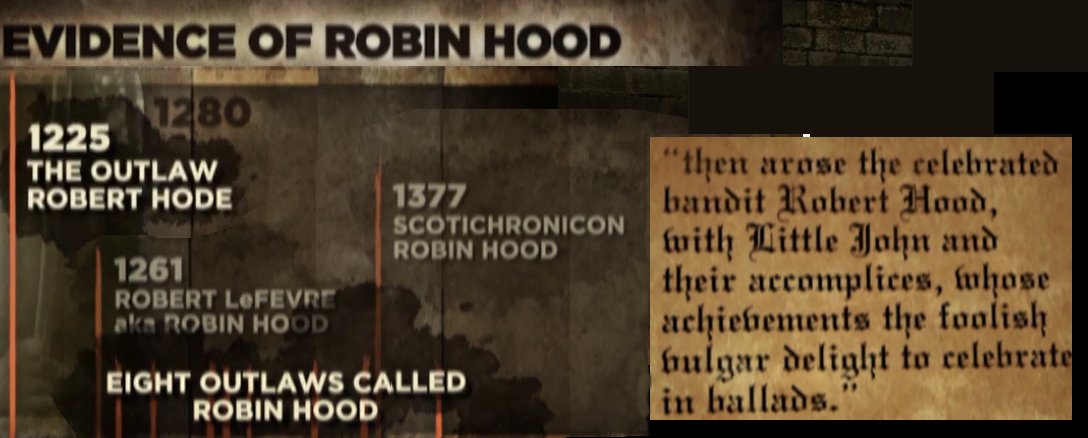Brevity and Brexity:
A Brief Look at English
History
Written by Rick Archer
rick@ssqq.com
Last Update: January 2017
|
Rick Archer's Note:
Due to my
2017 New Year's Resolution to become better known for my
Brevity, the following is an extremely brief article about Brexit and
Marla's upcoming 2017 cruise to Merry Old England... or, as
I prefer to say... the Texas Renaissance Festival on the other
side of the Pond.
Last October, Marla and I
visited Europe on our wonderful Greek Isles cruise.
During
our stay, we learned that Continental Europe is so mad at
England over Brexit, they don't want to have anything to do
with England anymore.
In their minds, England doesn't
belong in Europe. Go jump in the Pond.
|
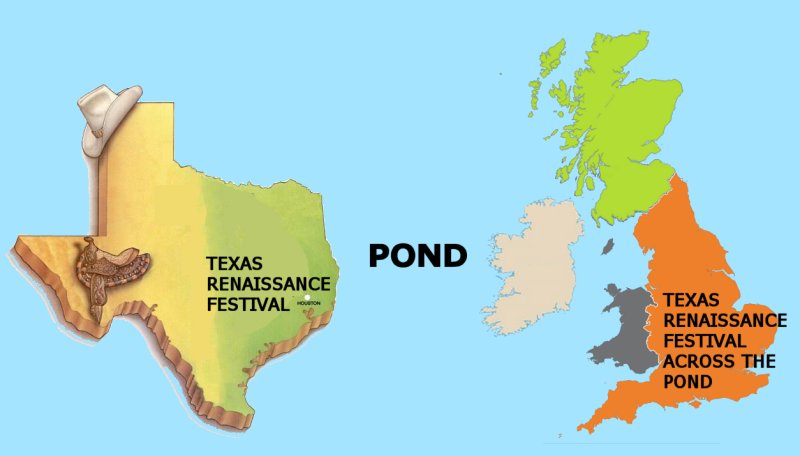 |
Ireland and Scotland don't
want England anymore either. They never liked England to
begin with and they still don't. Both countries wish
England would go away and leave them alone for good. Do you
blame them? Of course not!
Keep in mind that Ireland
and Scotland both voted to stay in the European Union.
Ireland and Scotland hold England responsible for the Brexit
Fiasco. Plain and simple, Brexit was England's fault
entirely.
Unlike Donald Trump who
wants to make America Great again, Ireland and Scotland
would prefer to take the 'Great' out of Great Britain
and tell England where to put it. I guess Scotland and
Ireland aren't feeling very Greatful anymore.
Understandably, England is
feeling lonely and isolated. She needs a friend. As always
whenever England is in trouble, the erstwhile Mother of
America begins to look longingly in the direction of her
former Colonies in North America. Both the United States
and Canada have responded with open arms, but the USA has
been the more enthusiastic of the two. And why is that?
Donald Trump.
Donald Trump wants to take
Great from Great Britain and bring it over here to help make
America Great again. That has been part of his plan all
along. I am completely serious... feel free to tell this to
any news channel and I have no doubt they will accept it as
fact.
| |
I may be a hermit
these days, but I
still know stuff. For one thing, I
know that Texas is really big. It is three
times bigger than the United Kingdom.
However, in the interests of
humility, size isn't everything. For example,
Great Britain once ruled the world and Texas was
once controlled by Mexico. Some say it still
is. Build the Wall.
Speaking of Donald Trump, I am privy to inside reports that Donald... no stranger himself to Brexit-style elections...
has invited England to forget about Europe and consider
becoming part of North America instead. England is said to
be very tempted, especially after Trump promised to unite
the countries with a series of floating Trans-Atlantic golf
courses known as 'Putting on the Pond.' No sand
traps, but I hear the water traps will be very deep.
This is pure synchronicity.
By amazing coincidence, my dear wife Mystic Marla predicted
closer ties between America and England when she decided to
schedule her 2017 British Isles cruise. Although I have
never visited England, this place is close to my heart. My
family roots on both sides are about as English as they
come. I am part Welsh and mostly English.
I have a question. How many
of you know where 'America' got its name?
Believe it or not, the name
can be traced back to Amerigo Vespucci, an Italian mapmaker
and navigator who followed in the footsteps of Columbus.
After drawing some of the early maps of the New World, his
name became associated with the two continents.
|
 |
| |
Sad to say, even though I am
English from top to bottom by heritage, I confess I do not
know much about English history. Curious, I decided to
start by figuring out where its name came from.
Was 'Eng-land' named
for some guy named Eng? Alas, I was disappointed. There
was no one named Eng.
The 'Britons' were to
the island as North America's Indians were to the Spanish,
French, and English. The Britons were the first occupants
of 'Britony' and 'Brittany'. The Britons
were there long before Christ. The Britons were the people
the Romans fought back in the days of the Roman Empire. It
was the Romans who named the island 'Britannia'.
During their 400
years of occupation, the Roman influence on England was profound. In
that time, the Romans built walls,
cities, forts and roads. They
set the laws and the customs that people lived by. The
Romans brought a sense of order to a land that had only
known chaos. Prior to the Romans, Britain was a disparate
set of peoples with no sense of national identity beyond
that of their local tribe. In the wake of the Roman
occupation, every 'Briton' became aware of their 'Briton-ish (British)' identity. In other words, 'everyone
who belongs here is British and everyone who doesn't belong
here is Roman'.
The Romans did the island a
real favor by civilizing the place somewhat. Interestingly,
the Romans did the same thing for Spain and France.
England, France, and Spain dominated Europe for centuries
simply because the Romans had been there to organize
things. Oddly enough, Germany remained disorganized. Did
you know that Germany did not become a country until 1871?
Can you guess why it took them so long?
I know the answer... Germany
was the only major European area that the Romans were never
able to conquer. Consequently 'Germania' as the
Romans called it remained divided into hundreds of small
territories until late into the 19th Century. Can you guess
who began the German Unification?
Napoleon. Once Napoleon
kicked the Catholic Church out of 'Germania' and
confiscated most of its lands, Germany was finally able to
begin unification. I am not a big fan of warfare, but it
obviously serves a purpose. I find that both disturbing and
fascinating.
Speaking of warfare, the
Romans left Britannia when they had to go back and defend
Rome against those nasty German barbarians who were swarming
all over Western Europe in the 4th century.
| |
 |
However, Rome would never be
forgotten.
Every generation of British
inhabitant that followed the Romans - be they Angles,
Saxons, Normans, Danes, Vikings - would strive to be the
next Romans. Each was trying to regain the glory of that
long-lost age when Britannia began the
long road towards being a unified island.
The Angles and the Saxons
were the Johnny-come-latelies. They were part of the barbarian
invasion of Europe that took out the Roman Empire. The
Angles and the Saxons were two separate tribes who occupied
adjacent territory in Southern Denmark and Northern
Germany.
For a while, the two tribes
were content to stay where they were. However, in the 5th
century, as more barbarians moved into
their area, they decided to
migrate. There are theories that
suggest the two tribes became aware of the vacuum created by
the departure of the Romans and moved west to take
advantage.
The Angles and the Saxons
carved out territory to call their own along the eastern and
southern coast of Britannia. Historically, the Anglo-Saxon
period denotes the period in Britain between about 450 and
1066, the dates of their initial settlement
all the way up
to the Norman
conquest.
The 'Angles' migrated
from Schleswig-Holstein, an area on the northern border of
Germany and the southern border of Denmark. The Angles
mostly settled in the easternmost part of the island. This
area became known as 'East Anglia'.
Just to the north was 'Northumbria',
another Angle-dominated area. The North Sea currents would
typically take any westward-bound ship leaving Denmark
directly to these two spots. The word 'Land' comes
from German. As one might guess, the 'Land of the Angles'
was eventually shortened to 'Angle-Land'
and then to 'England.'
The 'Saxons' were a
Germanic people who occupied the area in Schleswig-Holstein
just south of the Angles. Since they were used to occupying
land south of the Angles, the Saxons settled on
areas
to the south of East Anglia in places near to rivers or the
sea which could be easily reached by boat. The Saxons used
a river known as the Thames to occupy the settlement known
as 'Londonium' that had been abandoned by the Romans.
|
| |
 |
The Jutes did not play as
prominent a role in English history as the better
known Angles and Saxons.
That is because the Jutes were
so well-established in the geographically favorable
spot where Denmark lies today that they felt less
pressure to move.
That said, some of their
people migrated as well. These travelers
generally settled in an area known as Kent.
|
| |
|
The Anglo-Saxons would
eventually take control of most of Britain, although they
never managed to conquer Scotland, Wales and Cornwall.
The word 'Folk' comes
from 'Volk', the German word for 'people'.
Think 'Volkswagen'. As the Saxons moved into
southeastern, southern, and central parts of the island,
they gave German names to their regions.
NORFOLK
were the north
folk.
SUFFOLK were the south folk.
The ANGLE
SAXONS settled in ESSEX, home of the east
Saxons
SUSSEX were the
south Saxons
WESSEX
were the west Saxons.
There were so many
of these Angles running the place that the island became
known as ANGLIA, then ANGLE LAND,
then ENGLAND.
The stretch of water
between England and France was used so often by the Angles
that it came to be called the 'Channel of the Angles',
later shortened to the ENGLISH CHANNEL.
Although France used the
same waters, the Angles... or 'Anglish' or English if
you prefer... used these waters a lot more for an obvious
reason. The English were a seafaring people... or they
would not have gotten to this island in the first place.
|
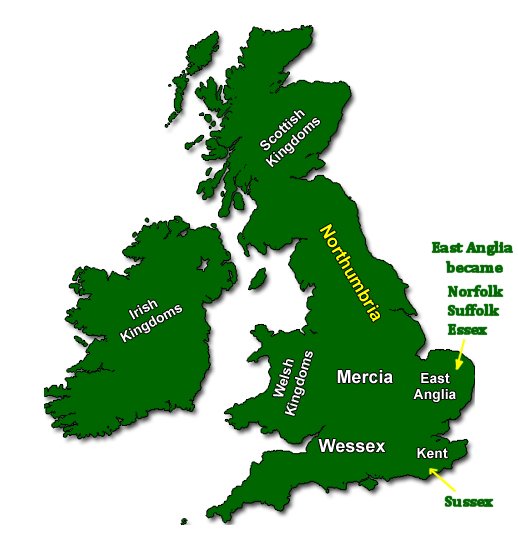 |
| |
|
One might ask if the word 'Angel'
and 'Angle' are related. Apparently not. 'Angel'
comes from the Latin word 'angelus' which comes from
the Greek word 'angelos'.
This makes complete sense
because the Angles were no Angels. In fact, the Angles were
a fierce, warlike people who would murder anyone who got in
their way. Sad to say, but the English were a cruel and
brutal people from the very start. Ask the Scots and the
Irish if you doubt my words. Or ask how many Indians were
massacred by English colonialism in India and North America.
France would no doubt also agree with
my assertion that the English were a rough bunch as well.
If ever there were two
countries that did not get along very well, that would be
England and France. Oh my gosh, those two have been going
at it for centuries. Did you know that France and England
are only 20 miles apart? At a spot near Dover (England)
and Calais (France), the distance is so short that people actually
swim across the English Channel. People with binoculars can
actually watch someone swim the entire distance.
This proximity has led to
many a battle between the two countries. At
one point France and England were
at war with each other for over 100 years. As a bit of
history, The Hundred Years' War was a long struggle
between England and France over who would succeed to the
French throne. The conflict lasted on and off from 1337 to
1453, so it might more accurately be called the '116
Years' War.' But that's not a very catchy
name, is it?
As it turns out, English
history is very interesting. So I
researched several of the highlights to include in this
article. However, before we begin, let's find out how
much you know about English history.
•
We will start with a
fun question. During the Hundred Years War, the most famous battle
in English-French history was won by England due primarily
to the Archers. Can you name the battle?
•
Do you know who the Black Prince
was?
•
Do you know what the Hundred Years
War was fought over?
•
Do you know what the War of
the Roses was about?
•
Who spoke 'A horse, a
horse, my kingdom for a horse?'
•
Why is the date 1066
important?
•
What English monarch
murdered the closest claimant to the throne only to later
name their child to be succeed them?
•
Who was the most over-rated
King in English history?
•
What
was the name of the battle that ended the War of the
Roses?
Are you curious to know the answers?
If so, read on!
William the Conqueror and the
1066 Battle of Hastings
One of the reasons English
history is so fascinating is that there was always so much
drama surrounding the King. There were certain periods when
there was no clear successor to the throne. Two, three,
maybe even four people might have a legitimate claim to the
throne. Consequently there were plots, rebellions and
assassination attempts galore. There was always someone new
scheming to get rid of the current King and put someone
else on the throne.
the Battle
of Hastings was a perfect example
of the chaos that ensued every time an English King or Queen
died. The English loved war so much that transitions were
basically an open invitation to renewed bloodshed. Sort of
like America today... just kidding.
So what was the Battle
of Hastings all about?
King Edward the Confessor
was childless. His death in January 1066 set up a
succession struggle between several claimants to his throne.
Harold was crowned king shortly after Edward's death, but
faced multiple threats. First came Tostig, his own brother
who had been exiled. Tostig persuaded Norwegian King Harald
Hardrada to join him in the fight. There were two battles
in September 1066. Tostig and Hardrada won the first round,
but Harold won the rematch, killing both Tostig and Hardrada
in the process.
| |
|
Now Harold had to face
William of Normandy. Normandy, of course, is where D-Day
took place in 1944. Normandy lies right across the English
Channel 100 miles to the south of England.
William wanted to be the
next King of England. William claimed that both Edward and
Harold had promised him the throne, but English supporters
of Harold challenged this. Basically, William had no real
claim to the throne, but that didn't matter. As always, 'Might
makes Right.'
While William was building ships
in Normandy, he also
assembled an invasion force. The
fleet sailed 60 miles
from the mouth of
France's Somme River in October 1066 and
landed on the English coast near Hastings, a town
50 miles southeast of London.
King Harold of England met William's
army just north of the coastal town of Hastings.
The two sides were evenly
matched. Consequently the battle lasted all day from
morning to sunset.
Early efforts of William's invaders to
break the English battle lines had little effect, so the
Normans tried a trick. They pretended to flee in panic and
led their pursuers into a trap.
Harold was one of the
victims. Legend says he was shot in
the eye with an arrow. His death near the end of the battle led to the
retreat and subsequent defeat of his army.
|
 |
| |
|
A little known fact is that
Harold's defeat at Hastings was attributed to his appalling
lack of Archers. Makes perfect sense to me.
Everybody knows how important Archers
are.
After a few cleanup
skirmishes, William was crowned as the
English king on Christmas Day
1066. And there you have it... a Frenchman sat on the
English throne. The world had turned upside down.
William spent his entire life dealing
with the shame of being born a bastard. Even to his
death, there were whispers about his ignoble birth.
Rumor has it that even his eventual wife snubbed him over
this issue.
When William
asked for the hand of Matilda of Flanders, a granddaughter
of France’s King Robert II, she demurred
due to his illegitimacy.
According to legend, the snubbed Duke
tackled Matilda in the street, pulling her off her horse by
her long braids. In any event, Matilda
consented to marry him. Matilda
would go to bear her Conquering husband 10 children.
Maybe there is something to be said for the Tarzan approach.
| |
|
The Anarchy,
1135-1154
|
| |
|
The Anarchy was
a lawless time in England more or less like
America's Wild West. No one was really in
charge. The problem began problem started 70
years earlier when William the Conqueror, a
Frenchman of sorts (Viking bloodline, birth on
French soil), became King of England following the
Norman Conquest in 1066.
The repercussions were
profound as the invasion created an Anglo-Norman
elite, i.e. French barons whose main interest was in
France, but used their money and power to obtain
territory in England. In other words, England
became something of a French colony. These
barons now had estates and holdings in France as
well as in England.
To understand medieval France
and England, realize that 'Kings' in both
countries had only limited power. The barons
all had smaller Kingdoms of their own complete with
armies and castles. Sometimes they obeyed the
King, sometimes they didn't.
The most powerful English
barons typically lived back in France and visited
England from time to time. France itself was a
loose collection of counties and smaller political
units that were under only the minimal control of
the French king. In other words, England was
very disorganized and France wasn't really all that
much better.
Therefore, the barons ran wild.
Like little piggies, these barons wanted to rule
over as much land as possible no matter what the
cost. The easiest way to get land was to pick
a fight.
William II and
Henry I were the sons of William the
Conqueror who took over after his death. They
were called 'Kings', but really they were
more like the biggest baron of all. They
called the shots, but rebellion was always a
problem. The Anarchy began
when Henry I died suddenly.
|
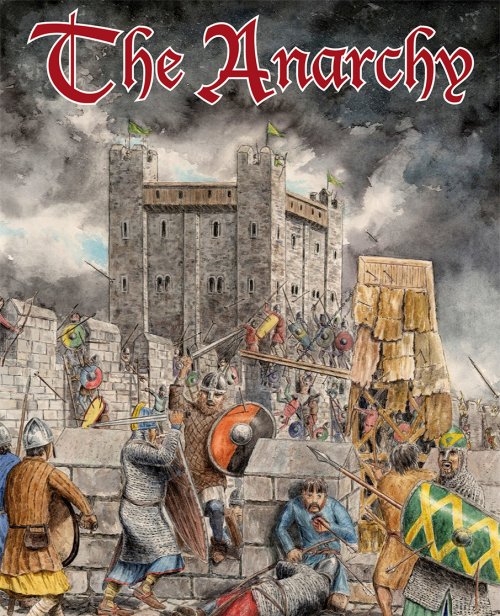 |
| |
Geoffrey
Plantagenet and Empress Matilda
|
| |
|
 |
The story of The Anarchy
begins with Empress Matilda.
One of real problems with
deciphering English history is that English Kings
were unimaginative when naming their heirs.
There were eight Henrys. There were eleven
Edwards. Henry
and Edward and Edward and Henry. On and on. Good grief, there
were more Edwards and Henrys than there are Star Wars episodes. If it wasn't for
Roman numerals, I don't know what the English would do.
Even the women got in the act.
William the Conqueror had four Matildas... his wife Matilda
of Flanders, his daughter Waltzing Matilda, his
daughter-in-law Matilda of Scotland, and his granddaughter
Empress Matilda.
|
| |
|
Here is the funny thing. For a
long time there, I
thought I was reading about the same woman. After all,
how many Matildas can there be in history? Then I got
suspicious when the stories didn't make any sense. It took me
20 minutes of
cross-checking to suddenly realize there were four of them!
Empress Matilda's father was Henry I,
the youngest son of William the Conqueror. Henry I
suffered a terrible misfortune when his two sons drowned.
This took place when the White Ship sank on its way
from France back to England.
Stripped of his two male heirs, Henry I broke tradition and
specifically named his daughter Empress Matilda to be his successor.
So why was Matilda an Empress?
Matilda had once been married to a
German king who was named ruler of the Holy Roman Empire.
This made her the Empress of the Holy Roman
Empire, an institution in continental Europe under the
jurisdiction of the Catholic Pope. However, her husband's death had sent Matilda back to
England as a widow at 23.
Matilda was eventually
forced to marry Geoffrey Plantagenet, the Count of Anjou,
a wealthy French landowner. Matilda was very unhappy
about this. For
starters, she was 25 and Geoffrey was only 13. She had
once been an Empress, now she was marrying down to a mere
Count. Boo hoo hoo.
Matilda's father pointed out that this
marriage would combine two of the most powerful Anglo-Franco
families ... the Normans and the Plantagenets. Henry I
chose Geoffrey to sire his grandchildren because his lands
were strategically placed on the Norman frontiers and he
required the support of Geoffrey's father, his erstwhile
enemy, Fulk of Anjou. He accordingly forced his highly
reluctant daughter to marry the fifteen year old Geoffrey.
Matilda wasn't happy about it, but she
got with the
program and married Geoffrey. The pair disliked each
other from the outset of their union and neither was of a
nature to pretend otherwise and so the scene was set for an
extremely stormy marriage. They were, however, finally
prevailed upon by the formidable Henry I to do their duty
and produce an heir to England. They had three sons, Henry
was the eldest of these and always the favourite of his
adoring mother.
Eight years after her 1127 marriage to
Geoffrey, things got interesting. Matilda's
father Henry fell ill and died suddenly in 1135. This meant Matilda
was now the heir to the English throne and the ruler of
Normandy. Unfortunately, the English barons who had vowed to support the accession of Matilda to
the throne reneged. Stephen of Blois was a well-known,
popular figure among the barons of Anglo-Norman society.
He also had the advantage of being right across the English
Channel when news of the king's death was spread.
Meanwhile Matilda was stuck in the center of France and
unable to press her case in person.
Stephen was attractive to the English
barons for two reasons. One, he was not only the
direct grandson of Henry I, the king had always treated
Stephen as a favorite. Second, these men were not too
keen on putting a woman on the throne. The English Council acted
like they were still stuck in the Dark Ages and denied Matilda the crown. They
stepped aside and allowed Stephen, Matilda's cousin, to
seize the throne instead. Matilda had been cheated of
her crown.
Matilda was royally
irritated. It did not help that
Matilda was haughty, disagreeable and
ill-tempered by nature. So naturally Matilda went to war
against Stephen.
That's what everyone did back in those days. It didn't
do her much good. She won a few battles, lost a few
battles, then got frustrated and gave up. The
Anarchy was not going in her favor
at all. By the late 1140s the active
phase of the civil war was over. In a huff,
she returned to France and fumed.
Stalemate.
Matilda was determined to have the last laugh.
As it turned out, Matilda had a strapping son at home.
Henry Plantagenet was her son by Geoffrey
Plantagenet. Born in 1133,
he was three years old when his mother was
cheated of her inheritance. By age
nine, Matilda had Henry fighting at her side. However,
they just couldn't seem to break though.
Then someone new appeared. Matilda
would receive help from an unexpected source... a woman her
husband had just had a fling with.
|
|
|
|
Geoffrey Plantagenet
of Anjou
|
| |
Geoffrey Plantagenet
was a powerful man who ruled over his ancestral domain of Anjou.
The House of Plantagenet had extensive land holdings
in France.
Through her birthright to
William the Conqueror, Matilda also had
extensive claims in Normandy which was neighbor
to
Anjou. Count Geoffrey had little
interest in England, but he was very
interested in Normandy. Geoffrey
initiated a war to obtain the duchy of
Normandy, but it was slow-going.
It became clear to Geoffrey that Stephen
would need to be challenged in England in
order to bring his own conflict to a
successful conclusion. So in 1139
Matilda invaded England. From the age of
nine, their son Henry was repeatedly sent to
England to be the male figurehead of the
campaigns. This made sense since Henry
would become king if England could be
conquered.
While his wife Matilda was off in England
fighting Stephen, Geoffrey invaded Normandy
on behalf of his wife. The Norman
barons initially opposed him, not through
loyalty to King Stephen, who had only
visited Normandy on but one occasion, but
from hatred of their traditional enemy,
Anjou.
While Geoffrey was attempting to conquer
Normandy, he was also forced to put down
three rebellions in Anjou created by his
younger brother. The threat of
rebellion not only slowed Geoffrey's
conquest of Normandy, it is the main reason
he could not intervene in England to aid his
wife.
|
 |
|
| |
Eleanor of Aquitaine
|
| |
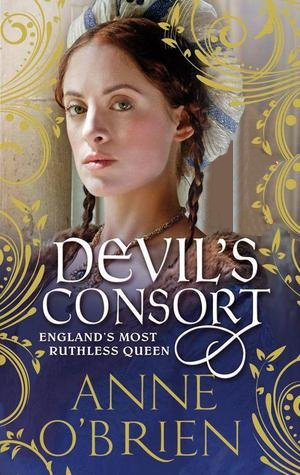 |
Eleanor
of Aquitaine
(1122-1204) appeared in the middle of Matilda's
fight in England and Geoffrey's fight in Normandy
and Anjou. Life would never be the same.
Eleanor, Duchess of Aquitaine, is a
determined woman who plots and schemes an astonishing
path between two equally powerful men in twelfth century
Europe.
This is a woman who can
maneuver and manipulate to
safeguard her own lands as effectively as any
power-grasping lord. Eleanor is single-minded in her
struggle to keep her inheritance intact, leading her to
reject one husband and take another who will fulfill her
desires.
Eleanor intends to reign as Queen and is
prepared to bring scandal down upon herself in pursuit
of her ultimate prize. Hers is a story of power,
political intrigue, passion and love.
This restless queen will sweep across the 12th
century, changing the face of Europe.
Eleanor's story is fascinating. She was the
daughter and heir of the imperious William X, Duke
of Aquitaine and Count of Poitiers. Her father
possessed the largest domains in northwest Europe,
indeed larger than those held by the king of France,
Louis VI from the House of Capet. When her father
died in 1137, Eleanor, 15, came into her
inheritance. Complying with the dictates of a
territorial agreement, she married Louis VII, heir
to the French throne. Barely a month after the
wedding, King Louis VI died, thrusting Eleanor’s
16-year-old groom to the throne of France.
Eleanor found court life as queen of France
stultifying. Her timid, sweet-tempered and devout
husband exasperated her. Formed during her
childhood at the court in Poitiers where she was
rarely disciplined and always admired, her strong
ego impelled Eleanor to create a lofty royal vision
for herself, one that did not encompass the
subordinate role as queen of France.
|
|
|
|
After a
decade of marriage to Louis, she was as beautiful
and capricious as ever, but even more headstrong and
domineering toward her husband. From 1147 to
1149 Eleanor insisted on accompanying him during the
Second Crusade. Apparently the adventure
carried a rude awakening... Crusading was no fun.
According to Simon Schama, “Eleanor was dismayed to
discover that crusading was an arduous, pious
business. She quickly developed an unhealthily warm
relationship with her uncle, the slightly impious
Raymond of Poitiers.” While her husband fought
battles in the Holy Land, Eleanor spent her time in
arms of Raymond in complete comfort for the duration
of the crusade. This understandably caused an
estrangement.
Though at one time Louis had adored his wife, after
15 years of marriage he was willing to let her go
for the sake of the Capetian royal line.
Eleanor had not borne him a son and heir, only two
daughters. Eleanor, on cue, illuminated her
predicament, explaining that her husband’s
infrequent visits to her bed accounted for the
fruitlessness of their union. In the end, the
marriage was annulled on the convenient grounds of
consanguinity: Eleanor and Louis were too closely
related for the church to tolerate.
|
|
|
 |
As Duchess of Aquitaine,
a massive duchy in
southwestern France, Eleanor was the most eligible bride in Europe.
Men came calling.
Following the dissolution of her marriage,
Eleanor regained possession of Aquitaine and
Poitou. This wealth combined with her
loveliness attracted suitors well before the
annulment was final, one of whom was Henry
of Anjou (a domain bordering Poitou), soon
to be known as Plantagenet.
One of the men who came calling was Geoffrey
of Anjou. Most historians agree that
Eleanor and Geoffrey were sexually intimate.
Historian Schama notes, “It was rumored that
Geoffrey of Anjou had personally verified
Eleanor’s appetite for passion before
recommending her to his son.”
Now Henry, Geoffrey's son, came calling as
well. The 30-year-old Eleanor and
18-year-old Henry felt passionately
attracted to one another. Henry’s
unsurpassed physical courage and keen
political acumen resonated with Eleanor’s
ambition for power. Another attractive
feature was that Henry, now the Duke of
Normandy and Anjou, could very likely become
the next King of England.
Asked some years before to assess Henry’s
chances of success of becoming King of
England, St Bernard of Clairvaux said of
Henry that ‘from the Devil he came, and
to the Devil he will surely go’.
It did not matter that Henry was reported to
be the spawn of Devil. That suited
Eleanor's tastes just fine. Not
exactly a shrinking violet herself, Eleanor
chose to be the Devil's consort.
Eight weeks after her annulment, Eleanor
married Henry in 1152. Instantly the marriage doubled
the land holdings of Europe's new power
couple.
Over in Paris, Eleanor's former husband
Louis VII flipped out. Louis not only
considered the marriage an insult to him, he
was also infuriated because Henry now
possessed a much larger proportion of France
than Louis did himself.
|
|
|
|
Henry Plantagenet
becomes King
|
| |
|
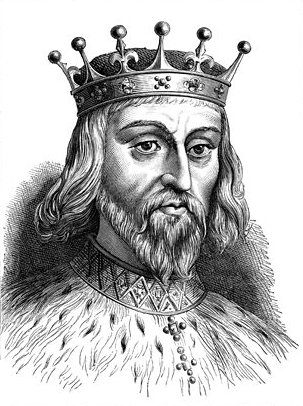 |
Strengthened by his
1152 marriage to Eleanor, Henry Plantagenet
wasted no time going back after Stephen.
Henry's mother Matilda was still seething
over her cousin Stephen's theft of her
crown. Based on Matilda's strong claim
to the English throne, Henry had a powerful
claim of his own. Indeed, his
grandfather Henry I had once called him the
future king of England.
Under the reign of the
usurper Stephen, for the previous twenty
years the Anglo-Norman realm had suffered
through a civil war fought out between the
adherents of Stephen and those of Henry’s
mother, the Empress Matilda. In this
time, lawlessness prevailed. It was
every man for himself. Northern
England had been seized by the Scots. The
Welsh had made substantial advances in the
West. England itself had been
partitioned between warring baronial
factions, each with its own competing and
still unresolved claims to land, castles and
local power.
The fighting between
Henry and Stephen continued, but no one
could
get the upper hand for long. Finally, the two armies
met at Wallingford to begin fighting the
battle to end all battles. Taking note
that neither side had an advantage and that
lots of men, barons included, were about to
die, cooler heads prevailed. The
Anarchy had been going on for 20
years. Enough was enough. Since
neither side's barons were keen to fight
another pitched battle, the barons had an idea... why not
ask the clergy to broker a peace?
So, much to the
annoyance of Henry and Stephen, the battle
was postponed. Stephen began to
examine a negotiated peace, a process
hastened by the sudden death of Eustace, his
son and heir. In the Treaty of
Winchester, Stephen recognized Henry as his
heir in exchange for peace. Stephen
conveniently died the following year in
1954. Henry was King; Matilda was
vindicated.
|
|
| |
|
Henry II and
the Plantagenet Dynasty
Ruling from 1154-1189,
King Henry II would emerge as one of
England’s, indeed as one of Europe’s,
greatest kings. The Plantagenet
dynasty founded by Henry II
would hold the English throne
for three and a half centuries (1154-1485), starting
with the 1154 accession of Henry II and
lasting until
1485 when Richard III died.
King Henry III was the
grandson of Henry II through King John.
Henry III had two sons... Edward I and
Edmund Crouchback. ANGEVIN KINGS
The House of
Lancaster was a branch of the royal
House of Plantagenet. The first house was
created when Henry III created the Earldom
of Lancaster—from which the house was
named—for his second son Edmund Crouchback
in 1267.
Over time, the House
of Lancaster subdivided into two wings.
The 1359 marriage of John of Gaunt from one
wing of the House of Lancaster to Blanche
from the other wing of the House Lancaster
reunited the two wings. Starting in
1399, the House of Lancaster would give
birth to three future kings.
Meanwhile, King Edward
III was the grandson of King Edward I.
As we shall see, Edward III was a pivotal
figure in English history.
•
Edward III named John
of Gaunt, one of his sons, the Duke of
Lancaster.
•
Edward III named
Edmund, another other son, the Duke
of York.
•
Edward III had yet
another son, Lionel, whose descendent
Richard, Duke of York, would
play a key role in English history.
Are you following all
this? If you haven't already guessed, English history
is very complicated. So let me simplify things
a bit.
The bottom line is
that the Angevin kings... Henry II, Richard
I, John I... were Plantagenets. The
Plantagenet kings... Henry III, Edward I,
Edward II, Edward III, and Richard II...
were Plantagenet kings. The Lancaster
kings... Henry IV, Henry V, and Henry VI...
were Plantagenet kings. The York
kings... Edward IV, Edward V, Richard III...
were Plantagenet kings. The Tudor
kings and Queen Elizabeth were Plantagenets
as well.
It all started with
Henry II and Eleanor of Aquitaine.
|
 |
|
| |
|
Henry II and the
Angevin Empire
|
| |
|
The term
'Angevin' is a reference to the duchy of 'Anjou',
birthplace of Henry II.
Thanks
to a perfect storm of good luck, Henry came to rule
over the most extensive collection of lands that had
ever been gathered together under an English king.
•
From his father, Geoffrey,
Henry succeeded to rule over Anjou, Maine and the
Touraine: the counties of the Loire valley that had
previously blocked Anglo-Norman ambitions in the
South.
•
From his mother, Matilda,
daughter and sole surviving legitimate child of the
last Anglo-Norman King, Henry inherited his claim to
rule as king in England and as duke in Normandy.
•
From his wife Eleanor, Henry
found himself in possession of a vast estate in
southwestern France, stretching from the Loire
southwards through Poitou and Gascony to the
frontiers of Spain.
This was
an empire in all but name. Henry's lands
stretched from the Cheviots to the Pyrenees, and
from Dublin in the west to the frontiers of Flanders
and Burgundy in the east. And this all just
for starters. Henry would acquire more lands
throughout his reign.
|
 |
| |
|
Henry II of Anjou was more French than he was
English. His native tongue was French. A
brilliant soldier, he extended his French lands
until he ruled most of France. With territory
stretching from sea to shining sea, by the late
1170s, Henry ruled an estate that eclipsed anything
that had been seen in France since the time of
Charlemagne and in Britain since the fall of Rome.
In its cultural and political sophistication,
Henry’s dominion badly outshone the Capetian kings
of France. Louise VII, struggling to maintain his
rule over the immediate vicinity of Paris, could
only look on in astonished but for the most part
impotent amazement. Henry had set England on a path
to becoming one of the world’s most dominant
nations.
So was Henry II a happy guy?
One can only wonder. Henry would prove to be a very
controversial king. Although he had succeeded
in wresting control of England from the barons who
had gotten too big for their britches, he quarreled
with everyone under sun including his wife, his
sons, the barons, Thomas Becket, and King Louis of
France.
Henry quarreled a lot his
wife. By temperament Eleanor was just as fiery
as Henry, and as determined to stake her own claims
to rule. Despite their
turbulent marriage, they did find the time to produce
eight children, mostly notably King Richard I the
Lionhearted, the son who would succeed his father.
Henry had one very bad habit.
He did not like to share his lands. He did not
share his inheritance with his brothers and he had
trouble sharing his estates with his sons.
Naturally his sons turned rebellious. And when
they did, his wife took their side. As a
result, Henry’s domestic life was far from tranquil.
Henry lost his temper with Eleanor and had her
imprisoned under house arrest for sixteen years.
She would not be freed until his death in 1189.
Henry is remembered for his
quarrel with Archbishop Thomas Becket. After
Becket's subsequent murder in Canterbury Cathedral
on 29th December 1170, his sons turned against him,
even his favorite son John. Henry II spent all
his later years fighting wars with his own sons.
Henry II died a bitter man, hated by practically
every noble on either side of the English Channel.
|
| |
The Legend of Eleanor
Lives On
|
| |
Eleanor was Queen of England
for 44 years (1154–1189).
Over the first
thirteen years, she bore Henry eight children: five
sons, three of whom would become kings; and three
daughters.
However,
over time Henry and Eleanor
became estranged. Henry imprisoned her in
1173 for supporting her son Henry's revolt against
her husband. In
1173, Eleanor’s son “Young Henry”
fled to France. He was
apparently plotting
against his father to
seize the English throne.
Eleanor
was rumored to be actively supporting her
son’s plans against her estranged husband,.
She was arrested and imprisoned for treason.
Once apprehended, she spent the next 16 years
shuttling between various castles and
strongholds in England. She
was constantly suspected of agitating against
her husband’s interests.
Some even say she played a role in the death
of Rosamund, Henry's
favorite mistress.
Eleanor was not released until 6 July 1189,
when Henry died and their son ascended the English
throne as Richard I.
|
 |
| |
After
Henry's death, Eleanor became a babysitter of sorts
for her son Richard who went off to play in the
Crusades.. Eleanor ruled the country as Regent
in Richard’s name while he led the Third Crusade.
Eleanor
lived to the remarkable age of 82. She was
able to see her youngest son John crowned king after
Richard’s death and was employed by John as an envoy
to France. Eleanor would eventually retire as
a nun to the abbey at Fontevraud, where she was
buried upon her death in 1204.
Endowed
with intelligence, creative energy and a remarkably
long life, Eleanor of Aquitaine played a major role
in the 12th century. This was an impressive
achievement given that medieval women were
considered nothing more than chattel. Her
intelligence and enterprise served her well in the
chaos of the time as she negotiated the unrelenting
hostilities between Plantagenets and Capets,
crusades and struggle between church and state.
In a ruthless era, Eleanor stood tall.
Too bad
her sons didn't inherit her cunning. It had to
be a terrible shame to see her sons, Richard the
Lionheart and King John turn on their father and
then later against each other. Together they
brought the Angevin dynasty to the edge of
annihilation.
|
| |
|
Who is the
Most
Over-Rated King in English History?
Let's start
this
question by playing the Name Game.
My full name is 'Richard
James Archer.' English names hang like ornaments
throughout my family tree.
'James'
is my father's name. James is the most common male first
name in all of Britain. James is a royal name associated
with the Scottish house of Stewart. James I of Scotland was
the man who succeed Queen Elizabeth I in 1603. King James
was a patron of the arts as well as a talented ruler.
'Mary'
is my mother's name. Mary is the most common female first
name in all of Britain. The name Mary is sprinkled
throughout English and Scottish history. Bloody Mary, Mary
Queen of Scots, William and Mary, and of course the beloved
Queen Mary III. Queen Mary and her husband King George V
ruled during World War II. Queen Mary was the mother of
the current Queen Elizabeth.
'William'
is the fifth most common male English name. William was the
name of my grandfather and one of my uncles. William is
everywhere in English history. For example, William the
Conqueror. Remember him? William changed the history of
the world thanks to his conquest of England in 1066 at
the Battle of Hastings.
'Richard'
is a name of Germanic origin, derived from 'ROC' which means
'power' and 'HARD' which means 'hardy'.
That's me all right, Rock Hard Richard!
So let's
see how the most famous Rock Hard English King of them all
fared. 'Richard'
has been the name of four
different English Kings, two of whom were rotten,
one of whom became Shakespeare's greatest villain and the
fourth is considered the most overrated
King in English history. By
the way, I was named for the over-rated
one.
| |
|
King Richard the Lionheart
|
| |
|
And that brings us to 'Richard
I', better known as King Richard the Lionheart, the
most famous Crusader of all!
(Let us pause
for the
trumpets to blare!)
According to my mother, King
Richard the Lionheart was the man I was named for. I was
very proud to be named after the illustrious English King.
According to my father, our
surname 'Archer' descended from Robin Hood and his
Merry Men.
Gullible little critter that
I was, wow, here I was... part Richard the Lionhearted and
part Robin Hood!!
Alas, if only we could have stopped with
the Adventures of Robin Hood starring Errol
Flynn as Robin and Olivia de Havilland as Maid Marian.
That was defining movie of
my childhood. 3 Oscars! Much acclaim!
|
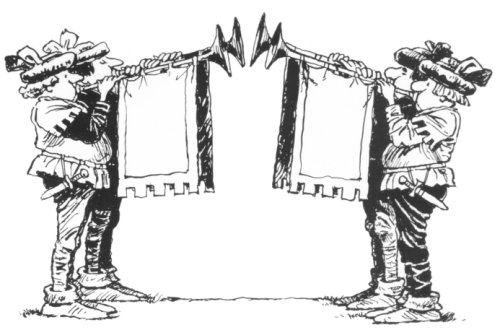 |
| |
|
 |
In
the movie, Robin Hood
becomes my hero. He
is depicted
as a heroic outlaw folklore who, according to
legend, is a highly skilled archer and swordsman.
Traditionally dressed in Lincoln green, he is
portrayed as a champion of the
downtrodden, "robbing from the rich and giving to the poor"
with the help of his loyal band of Merry Men.
He
fights off the bad guys, keeping the Sheriff of Nottingham and evil
Prince John at bay while
noble Richard is away at the Crusades.
Then
Robin Hood comes to the rescue of King Richard when he
returns. There is a joke in
Hollywood that King Richard had an amusing
nickname... ‘Richard of the Last
Reel’. Film buffs love
to make fun of the fact that Richard appears
at the end of every Robin Hood film as the heroic,
and supposedly victorious, crusader monarch
returning to punish treacherous Prince John and the
wicked Sherriff of Nottingham.
Action! Adventure! Courage!
Chivalry! History!... well, not so much history.
To begin with, there are
strong rumors that Richard did not even speak
English. In his whole reign, he spent no more
than six months north of the Channel. For that
matter,
imagine my pain when I discovered Robin Hood... the
man who was the most famous Archer in
English history... may not
have actually existed.
The
subject of ballads, books and films, Robin Hood has
proven to be one of popular culture’s most enduring
folk heroes. Over the course of 700 years, the
outlaw from Nottinghamshire who robs from the rich
to give to the poor has emerged as one of the most
enduring folk heroes in popular culture.
But did a real
Robin Hood inspire these classic tales?
|
|
|
|
|
|
|
|
What a shame it was I had to
grow up and learn the truth that the
greatest Archer of all time was probably a Hollywood
sham.
Robin
Hood, Fact or Fiction?
The History Channel suggests that Robin Hood
may have existed. In fact, research has turned
up mentions of eight different outlaws calling
themselves 'Robin Hood'. The problem is
that the first known mention took place in 1225.
'Richard of the Last Reel' died in 1189.
Whether Richard met the legendary
outlaw Robin Hood in Sherwood Forest, we do not
know, but it seems kind of
unlikely.
Personally I like the idea of
weaving legends together.
I think
this is a great idea. Davey Crockett can be
Abe Lincoln's best friend. Thomas
Jefferson can suggest improvements to Obamacare.
Vladimir Putin can
assassinate John F. Kennedy with a magic bullet
controlled by hackers. Donald Trump can grope
Pocahontas. Why let the truth get in the way
of a great yarn??
Alas, when I learned Robin
Hood was only a legend, I was fit to be tied. Half of my
gallant identity was gone. Well, no matter, I still had
Richard the Lionheart, brave Crusader, wonderful King. Yeah, well, then I
discovered that Richard the Lionheart was pretty much
useless as a King. During his ten years reign as King,
Richard spent at most six months of it in England. The rest
of the time he gallivanted across Europe and the Middle East
involved in the Crusades. Richard won a bunch of battles,
but he was unsuccessful in retaking Jerusalem from his
nemesis Saladin, the Muslim warlord.
Then Richard managed to get
captured in Austria on his return home. He spent nearly
three years of his reign in captivity until the ransom was
finally raised. Once he was free, Richard
returned for a couple of weeks, then left for France never even
bothered to set foot in England again.
Richard
spent his final years fighting battles to reclaim
territory in Normandy.
My loyalty to Richard was further
shaken when I discovered he was either gay or bisexual.
Despite being married, Richard did not have a child.
Nor did he bother to return to his wife following the
Crusades. In addition, there is a curious historical
quote involving King Philip II of France.
Richard
the Lionheart and Philip II of France “ate every day at
the same table and from the same dish, and at night their
beds did not separate them.” Uh oh. What could this
mean??
However, historian Dr. John
Gillingham discounted the idea that
Richard was gay.
"The idea wasn’t even mooted
until 1948 and it stems from an official record
announcing that, as a symbol of unity between the two
countries, the kings of France and England had slept the
night in the same bed. It was an accepted political act,
nothing sexual about it; just two politicians literally
getting into bed together, a bit like a modern-day photo
opportunity."
So what was the story on this
kidnapping?
I hate to say it, but Richard was not
the nicest guy. During the Crusades, Richard quarreled
constantly among the French, German and
English contingents. Irritated, they all went home,
leaving Richard to fight on alone. After a
year's stalemate, Richard made a truce with the famous
Saracen ruler Saladin and
decided to head home. However, there was one problem.
Towards the end of his Crusade adventure, Richard was stuck with over
three thousand Muslim prisoners. Tired of feeding them
and unable to ransom them, Richard had their throats slit.
Richard's bad karma soon caught up to
him. Bad weather drove him ashore near Venice. Now he
had to head home on foot. Having insulted and alienated most of his
Christian allies while on crusade against Saladin, Richard
was unable to return to his kingdom in broad daylight.
He was caught sneaking in
disguise through the territory of Leopold, Duke of Austria, one
of the many enemies he had made in the Holy Land.
Leopold handed Richard over to the German emperor Henry VI,
who ransomed him for the huge sum of 150,000 marks.
This was literally a King's Ransom.
The ransom asked was about 2 billion pounds in today’s
money. Its payment required 25 percent of each
Englishman’s income for a year.
Interestingly, while Richard's ransom
nearly bankrupted his country, he became famous and
much-loved in the process. How was this possible?
Now we recall that Richard was
the son of Europe's
most famous mothers, Eleanor of Aquitaine. Eleanor just
happened be in charge of running England while Richard was
out of the country. Queen Eleanor originated the enduring
legend of ‘Good King Richard’ as a PR campaign by to persuade the citizens of the Plantagenet
empire to fork over the crippling ransom.
The raising of the ransom was a remarkable achievement.
Negotiations for Richard’s release took the best part of a
year, and after strenuous diplomatic efforts by Queen
Eleanor of Aquitaine, the payment of 100,000 marks – an
enormous sum, perhaps twice the gross domestic product of
the whole of England at the time – and the handing over of
hostages, the King was released in early February 1194.
After his release, Richard briefly returned to England and
was crowned for a second time. One month later he went to
Normandy, never to return. His last five years were spent in
intermittent warfare against Philip II, his alleged former
boyfriend.
While besieging the
castle of Châlus in central France he was fatally wounded
and died on 6 April 1199. He was succeeded by his younger
brother John.
John? John who? Surely not
the same Prince John who was the villain in
the Adventures of Robin Hood??
Yup, same guy. After all those
years spent scheming during Richard's absence, John ended up
being the King after all. And why was John made King?
Because the guy historian Dr. John Gillingham claimed was
straight didn't bother to produce an heir!
So how did John turn out? Not
very well. John has been termed 'the worst king in
English history'.
Short and fat, John was jealous of his
dashing brother Richard I whom he succeeded. John was
cruel, self-indulgent, selfish and avaricious. The
raising of punitive taxes united all the elements of
society, clerical and lay, against him. The Pope
excommunicated him and the English barons ganged on him.
On 15th June 1215 at Runnymede the barons compelled John to
sign Magna Carta, the Great Charter, which
reinstated the rights of all his subjects. John died
from over-eating. He was in hiding at the time, a
fugitive from all his enemies.
Let's
face it, when all was said and done,
Richard the Lionheart didn't accomplish much.
Richard lived to the ripe old age of 42. For
ten of these years,
1189-1199,
he theoretically ruled England...
History
suggests Richard spent at most six months of his
life in England. So here are the facts:
Richard
didn't win Jerusalem, he didn't produce an
heir, he ignored his country, he nearly bankrupted it with
his Crusades and his ransom, and stuck England with the
worst ruler in history.
And yet, if people in the streets of any
European city today were asked to name one English king,
many would probably answer ‘Richard the Lionheart’!!
How utterly crazy is that?
Fortunately Richard had a
good press agent... his Mom! During his reign, all the people back in
England heard nothing but good things about their missing
Good King
Richard. Even today Richard retains a similar good fortune...
or at least it did for a while. Back in the early days of Hollywood,
Richard was portrayed as a stud warrior, a defender of God,
a mighty Crusader and a noble King.
Richard's
reputation definitely benefitted from appearing
at the end of every one of a half-dozen Robin Hood
movies. Richard's modern-day
legend was built on
Robin Hood's modern-day legend and Robin Hood's legend was built on
Richard's and if you ask anyone, they will tell you
both
men were real
and both were great heroes. That's
Hollywood for you.
Recently Hollywood has been
less kind. Revisionist history seems to have caught up with
Richard. His reputation has taken a few hits, notably in
the movie 'Lion in Winter' where Richard can
be seen frolicking in bed with Phillip of France. So much
for my role model.
Wikipedia sums Richard up as
'a bad son, a bad husband, a selfish ruler, and a vicious
man. During his ten years' reign, he was in England for no
more than six months, and was totally absent for the last
five years.'
And did Richard die a noble
death? Not exactly. Richard died rather ingloriously from
gangrene following a crossbow
bolt wound in his shoulder.
Was Richard shot in battle?
No, Richard was walking
along the walls of his castle without his armor on. Some
kid down below took a potshot and hit him. Now that I
think of it, an Archer killed King Richard. No wonder I
have identity issues... I am at war with myself.
For a kid who grew up
worshipping Robin Hood and King Richard, history has not
been kind to me. I thought I was
named for the finest King in English history only to realize
I was named for the most over-rated one. But you know, it could have been worse.
Think about all the
poor little German boys named 'Adolf'.
|
|

The Hundred Years War,
1337-1453
The Hundred Years War was fought over
ostensibly over the French Crown, but mostly it was
an excuse for English thugs and bandits to raid helpless
farmers and rape French girls. It was definitely
one of the most notable conflicts of the Middle Ages.
For 116 years, five generations of kings from two rival
dynasties fought to control the throne of the
largest kingdom in Western Europe.
If you ever wonder why the English
hate the French, think back to William the Conqueror who
imposed his French way of doing things onto England.
However, that resentment pales in comparison to the French
point of view. If you ever wonder why French hate
the English, start with
William the Conqueror and then follow the dots until you get
to the Hundred Years War. Virtually every English king
since William the
Conqueror brought havoc and misery to France
for centuries.
William the Conqueror was from Normandy, France.
Thanks to him, there was a succession of English Kings with
deep French ties that made them feel entitled to seek the
French crown as well as the English crown. That is what the
Hundred Years War was all about.
The Romantics like to point out that
armies of knights and archers battled for King and Country
on the field of glory. What utter nonsense. 'Chivalry'
may have the code word of the day, but little decency was shown.
At the end of many battles, helpless prisoners were
murdered in cold blood because the victors didn't feel like
feeding them. Unless a guy was worth some money in ransom,
it was easier just to slit his throat at the end of the day.
One time the English captured John II, the King of France,
in the 1356 Battle of Poitiers. The English set the
ransom price so high that the French had no choice but to
tell the English to go ahead keep him.
According to Stephen Clarke, author of
1000 Years of Annoying the French, the Hundred
Years War was basically used by the English as an excuse to
inflict 116 years of terror on French civilians. This
terror was conducted by out-of-control English bandits who
claimed to defend their king's rights. The truth was
they were actually hard at work enriching themselves and
having fun massacring as many helpless peasants as they
could.
As Clarke pointed out, for more than a
century, no town in the northern part of France was safe
from siege and plunder. Peasants could not work in
their fields without posting lookouts on hilltops, church
belfries, or up in trees. If a dust cloud was sighted,
the farmers would throw down their tools and run for their
lives. They knew that any man caught would either be
held to ransom if he was rich or put to death. Was the
death swift according to the prevailing sense of chivalry?
Are you out your mind? Chivalry? Absolutely not.
Each man was tortured hideously until he revealed where his
meager savings were hidden and where his wife and daughters
were hiding. Then the English would plunder the money
and rape the women. This was basically 100 years of
Genocide. Adding insult to injury, the Black Plague
took place and removed another 25% of the French population.
There's an old saying, 'Won the
battle, but lost the war.' In the French case, the
saying should go, 'Lost all the Battles, but won the war'.
Although it is true that the French eventually expelled the
English in 1453, the cost to France was beyond horrible.
In addition to one humiliating defeat after another in the
early stages of the war, the French saw their people
slaughtered, their towns destroyed, and their countryside
ravaged. The cost in human suffering was inestimable.
600 years have passed, but the memory is still there.
So what caused this brutal holocaust?
Don't worry, I will be brief, you can always count on that.
| |
|
 |
Henry II's successor was his son Richard I.
Like his father, Richard was 99% French. He
was born to French parents and was raised in France. We remember that King Richard the Lionheart spent
all of six months in England out of ten years of his reign.
When he wasn't off Crusading or being ransomed, he spent the
bulk of his time in France trying to extend his French
holdings. In other words, one of the most famous kings
in English history was 95% French and 1% English.
Sorry to say, Richard was a
bust and so was John, 'the worst king in English
history'. Henry III, John's son, wasn't
much better.
Edward I, also known as Edward
Longshanks, was perhaps the most successful of the
medieval monarchs. His reign marked a high point of
cooperation between crown and community.
However, we remember Edward the best as the villain
of Braveheart, the tragic movie about
Scotland's William Wallace.
Edward II was a waste of time.
Edward was a weak and incompetent king who spent
most of his time with his gay lovers. However,
he did marry and produced four children. The
eldest son, Edward III, would go down in history.
Edward III was a significant king in
English history. By my count, Edward was responsible for 150 years of war, 16 children,
and untold amounts of misery.
|
|
|
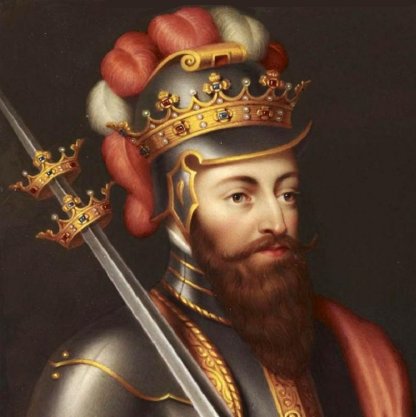 |
Edward III
Edward III ruled for 50 years,
(1327-1377), one of the longest reigns of any
European monarch. The sixth English King after
the renowned Henry II,
Edward was at heart a warrior. Edward III transformed
the Kingdom of England into one of the most
formidable military powers in Europe. His long
reign of fifty years was the second longest in
medieval England. Edward oversaw vital
developments in legislation and government, in
particular the evolution of the English parliament
Edward III was crowned at age fourteen after his weird
father was deposed by his mother, Isabella of
France, and her lover Roger Mortimer. At age
seventeen, Edward led a successful coup against
Mortimer, the de facto ruler of the country, and
began his personal reign. After a successful
campaign in Scotland, he turned his attention to France.
Edward declared himself rightful heir to the French throne
in 1337.
However, when his claim was denied,
he decided to attack France and press his claim. This started
he Hundred Years' War.
Edward's claim on the French throne was based on his descent
from King Philip IV of France, through his French mother
Isabella. His marriage to French princess Philippa
further reinforced his claim.
They always say make love, not war.
Well, Edward did both. Philippa and Edward had
thirteen children, including five sons who lived into
adulthood. The rivalry of those numerous descendants
would one day bring about the long-running and bloody
dynastic wars known as the War of the Roses.
|
As it turns out, Edward had a famous
mistress. Alice Perrers (1348–1400)
was a royal mistress whose lover and patron
was King Edward III of England. She met him
originally in her capacity as a
lady-in-waiting to Edward's consort,
Philippa of Hainault. Alice Perrers was despised
by many and was accused of taking advantage
of the far older king with her opportunistic
character, youth,
and beauty. Meanwhile, this mistress went on to become
the wealthiest woman in the land.
As we shall see, History is just as
fascinated by the women surrounding the
Kings as the Kings themselves. Anne
O'Brien is a former history teacher in
England who turned to historical fiction.
Let's see what she has to say about Alice
Perrers:
One marriage. Three
people. Proud king. Loving wife. Infamous
mistress. 1362.
Philippa of Hainault selects a young orphan
from a convent. Alice Perrers, a girl born
with nothing but ambition. The Queen has a
role waiting for her at court.
‘I have lifted you from nothing Alice. Now
you repay me.’ Led down the corridors of the
royal palace, the young virgin is secretly
delivered to King Edward III – to perform
the wifely duties of which ailing Philippa
is no longer capable. Power has a price, and
Alice Perrers will pay it. Mistress to the
King. Confidante of the Queen. Whore to the
court.
Her fate is double edged; loved by the
majesties, ostracized by her peers. Alice
must balance her future with care as her
star begins to rise – the despised concubine
is not untouchable. Politics and pillow talk
are dangerous bedfellows.
The fading great King wants her in his bed.
Her enemies want her banished. One mistake
and Alice will face a threat worse than any
malicious whispers of the past.
|
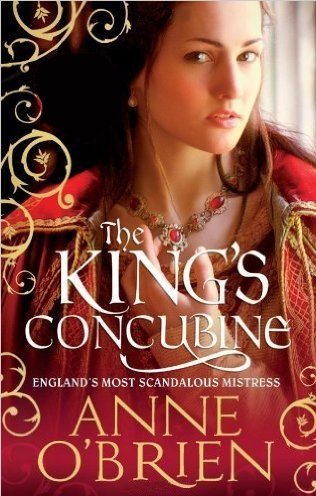 |
After his wife Philippa died, Edward had three
illegitimate children by his mistress Alice Perrers.
This brings our total to at least 16 children.
There might be more, but who has the patience? I found a website that drew a very unusual
statement
about Edward:
Conclusion: there is an extremely
high probability that a modern English person with
predominantly English ancestry descends from Edward III,
at a very minimum over 99%, and more likely very close
to 100%. The number of descendants of Edward III must
therefore include nearly all of the population of
England, and probably much of the populations of the
rest of the UK and Eire, as well as many millions in the
USA, former British colonies and Europe, so 100 million
seems a conservative estimate. Documenting one's own
descent from Edward III is, however, another matter!
There are two other footnotes to the
reign of Edward III.
First, England lost 33% of its population
due to
the Black Plague.
Second, France lost 33% of its
population to Edward's son, the infamous Black
Prince. No, France didn't really lose that
many, but it sure seemed that way.
|
The
Lineage of Edward III
|
I have
discovered the hard way that any American who
undertakes the task of sorting out English genealogy and
ancestry is an idiot. There are some
remarkable stories to be told, but unless I explain
the complicated politics, the upcoming stories will
not make much sense. Therefore, after much
frustration, I have concluded that at least a
superficial understanding of what King Edward III
did would help
explain the complex story behind the remarkable
events soon to unfold.
All four
of Edward III's sons contributed directly to English
history.
•
Edward III named John of
Gaunt, one of his sons, to become the Duke
of Lancaster.
•
Edward III named Edmund,
another other son, to become the Duke of
York.
•
Edward III had yet another
son, Lionel, whose descendent Richard,
Duke of York, would play a key role in
English history.
•
Edward III's son Edward,
also known as the Black Prince, would see his
son Richard II succeed Edward III as king.
Now that Edward III's four
boys have split off into different Houses, both
Houses had an equal right to promote one of their
members to the English throne. This splitting
would lead to brutal competition starting three
generations down the line.
|
| |
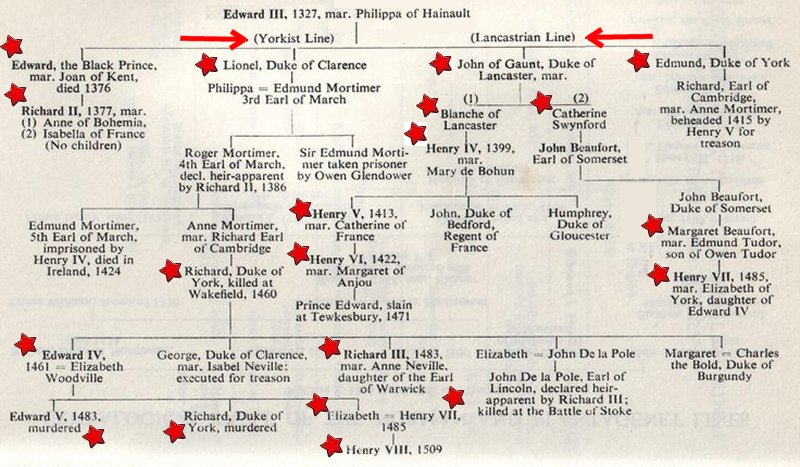 |
|
| |
|
Edward, The Black Prince
|
| |
The most hated man
in France was the Black Prince. Sorry to say, but the French
got the worst of it during the Hundred
Year's War because all the battles took place
on French soil. The Black Prince was quite a
warrior.
Like father, like
son.
Although
the Black Prince was the
eldest son of King Edward III and Philippa of Hainault,
Edward of Woodstock (1330 –1376)
never became
king. He died one year before his father's death
after fighting a prolonged ten-year battle with a
mysterious, debilitating disease.
Due to his premature death, the throne passed instead to his
son Richard II, a minor, upon the death of the Black
Prince's father Edward III.
Edward of Woodstock was an exceptional military leader. His victories over the
French at the Battle of Crécy and the Battle of Poitiers
against superior numbers during the Hundred Years War
made him very popular in
England.
Unfortunately, Edward was
not a man of mercy. In fact, he was the
Black Prince of Destruction
who laid
neverending waste to France during the Hundred Years War.
Although this was
considered the Age of Chivalry, Edward never got the email.
Edward had a well-deserved reputation for
cruelty. He earned his title based on his habit of burning
the fields of his French enemies, laying waste to the towns
that he conquered, and executing thousands
of
helpless, unarmed French prisoners after his
battles.
He was despised by the French and admired by the
English. Whatever your point of view, there can be no doubt
that Edward was a brute. Hence
the name 'Black
Prince'. The only favor Edward
ever did the French was to die young, thereby
putting one of England's worst rulers on the throne.
|
 |
|
| |
John of Gaunt,
House of Lancaster
#1 and House of Lancaster #2
|
Good old
King Edward III... remember him?
Edward III
was the king who started that awful Hundred Years
War and also found time to reproduce at a prolific
rate.
Edward's third male child by his wife Philippa was known as John of Gaunt.
John of Gaunt founded not one,
but two major wings on the House of Lancaster
family tree.
One wing
was
founded with Blanche of Lancaster, his first wife.
The second wing was founded with Katherine Swynford,
his mistress of 30 years.
Both
women were quite remarkable.
|
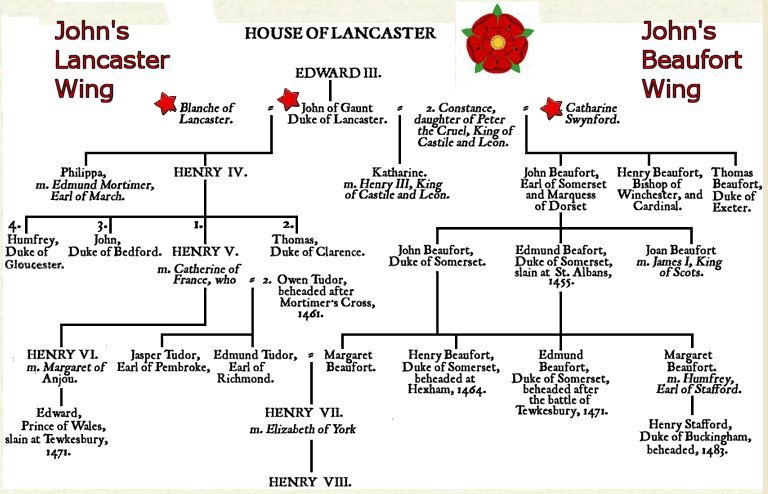 |
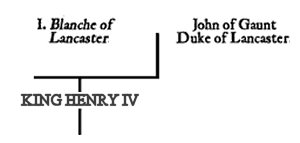 |
John of Gaunt and
Blanche of
Lancaster
King
Edward noticed that Blanche of Lancaster,
daughter of Henry Grosmont, head of the original
wing of Lancaster, was not only filthy rich, she was
available.
So John
of Gaunt married Blanche of Lancaster in 1359.
She was 14 at the time. Since John was a
Plantagenet and the Lancasters were also
Plantagenets, I suppose they were cousins of a sort.
|
Blanche
possessed considerable land holdings. After
John
combined the estates King Edward gave him plus Blanche's
estate, John of Gaunt was now the richest man in
England after his father King Edward III.
Blanche
was remarkable... marrying at age 14, she had seven
children in eight years. Then suddenly she
took ill from complications following the birth of
her seventh child. Blanche died in 1368 at age
22.
One of
Blanche's children was Henry Bolingbroke, destined
to become the first Lancaster King, Henry IV.
After
Blanche's death, John had pretensions of ruling a
Kingdom. He was too far removed from the Crown
of England to expect advancement, so he married Constance of Castille,
Spain, in 1371. John
of Gaunt huffed and puffed for the next 23 years or
so, but the Spanish Kingdom gig never worked out.
Constance died in 1394 still married to John. It would be
interesting to know what Constance thought of her
marriage. However,
for the sake of Brevity, I will do my best to look
away. On the other hand, John's next love
affair was more than I could resist.
|
| |
|
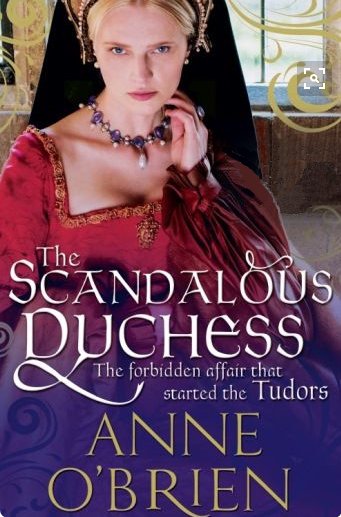 |
Katherine Swynford,
The Scandalous Duchess
|
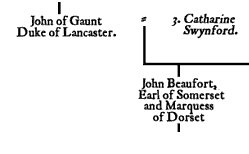 |
Widow Lady Katherine
Swynford presents herself for a role in the
household of merciless royal prince John of Gaunt,
Duke of Lancaster, hoping to end her destitution.
But the Duke’s scandalous
proposition leaves her life of pious integrity
reeling... Seduced by the glare of
royal adoration, Katherine becomes John’s mistress.
She will leave behind
everything she has stood for to play second fiddle
to his young wife and ruthless ambition.
She will live in the
shadows of the most powerful man in England in the
hope of a love greater than propriety.
But soon the court whispers
– whore, harlot, vile temptress – reach the ears of
not just John’s bride but his most dangerous
political enemies.
As the Plantagenet prince
is accused of bringing England to its knees, who
better to blame than shameless she-devil Katherine
Swynford?
Dragged from the shadows,
Katherine must answer for her sins.
|
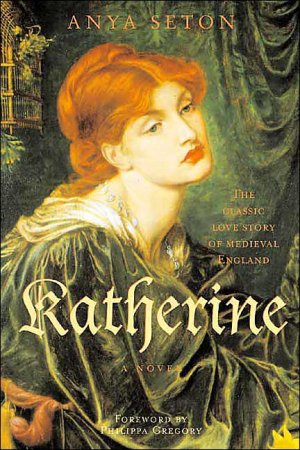 |
Katherine Swynford was a commoner who came to the
household of John of Gaunt as governess to his
daughters Philippa of Lancaster and Elizabeth of
Lancaster.
After
the death of his wife Blanche, John made Katherine
Swynford his mistress. She bore him four
children in the years between 1371 and 1379.
They were supposedly born in John’s castle in
Champagne, France, and given the name of the castle
as their surname; Beaufort. However it seems
just as likely that they were named after the
lordship of Beaufort, which had one belonged to
Gaunt and to which he still laid claim.
Katherine remained John's mistress for 30 years
during his marriage to Constance. How she put
up with this situation is anyone's guess.
That
said, for you hopeless romantics, I will share one
tidbit... John finally married Katherine in 1396 and made
her the Duchess of Lancaster. He then asked
King Richard II to legitimize their four children.
The
House of Beaufort had begun.
It is interesting to note that a descendant of
Katherine's previously illegitimate son John
Beaufort would on day produce a King
of England.
|
 |
|
| |
Richard II
Richard
II followed Edward III.
Richard was
not the son of Edward III, but rather the
son of the Black Prince. Richard II
was 10 when his controversial father died of a
mysterious ailment in 1377. No doubt the
French were thrilled to see this brutal man bite the dust.
|
 |
| |
In a move that would have far-reaching
consequences, Richard II bypassed three
able-bodied sons for succession to the
crown.
By the laws of primogeniture, this ten year
old boy, Richard II, succeeded to the throne
ahead of Edward's three surviving sons
This skipping of an entire generation left
lingering claims to the throne among their
various offspring, particularly among the
Lancasters, descended from Edwards third
son, John of Gaunt, and among the Yorks,
descended from the second son Lionel and the
fourth son Edmund.
|
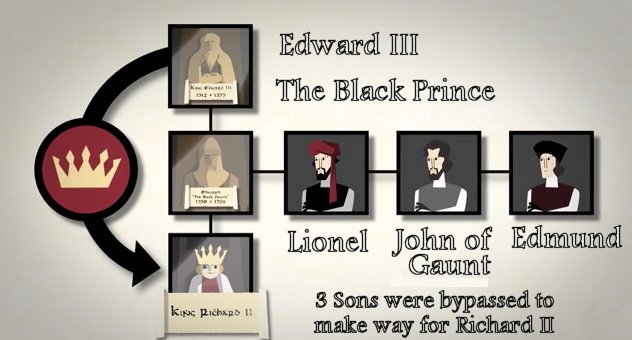 |
| |
|
| |
|
Richard spent the majority of his early years
wrestling to keep control of one peasant revolt
after another. We haven't spoken much about
the English peasants, but they had a rough life.
At that time, half of England was owned by a network
of 200 related Anglo-Norman families (and the rest
was owned by the crown and the church). In the
centuries since the Norman Conquest, followers of
William the Conqueror and his successors married
noble Anglo-Saxon women to form a new
French-speaking aristocracy. Their wealth and even
their food were supplied by the toil of their native
Anglo-Saxon serfs, few of whom rose to greatness.
Traces
of the racial and class divisions of this time still
exist in modern English. For the live animals
herded, tended, milked and slaughtered by the
natives we still use their Anglo-Saxon names like
sheep, calf, cow and swine. For the cooked meat on
the table, which only the French-speaking overlords
were allowed to eat, we use the French equivalents:
mutton, veal, beef and pork.
More cruelly still, the poor natives were not
allowed to hunt wild animals for food in the
forests, or even gather winter fuel there. Some
modern place names tell this story: Cannock
Chase in Staffordshire is so named because ‘chase’
comes from the French word ‘chasse’ meaning ‘hunt’.
It was originally enclosed land, where the game was
reserved for the exclusive pleasure of the
overlords. A peasant defying the “forest laws
for the protection of vert and venison” risked a
long term in prison – or even death. The
legend of Robin Hood was so enticing simply because
this folk hero brought forest justice to a land that
knew little justice for the lower classes. So
when an idiot like Richard Lionheart goes and gets
kidnapped, the smart thing to do would have been to
say keep him. Instead the peasants were forced
to fork over 25% of their earnings to pay Richard's
ransom. The English peasants were not a happy
people. This probably explains why they were
eager to go plunder their counterparts in France
during the Hundred Year's War.
When Richard was 36, he tried
to put an end to the Hundred Years War by
negotiating a permanent peace with France. A
proposal put forward in 1393 would have greatly
expanded the territory of Aquitaine possessed by the
English crown. However, the plan failed because it
included a requirement that the English king pay
homage to the King of France – a condition that
proved unacceptable to the English public. Instead,
in 1396, a truce was agreed to, a truce which was
supposed to last 28
years. It lasted 19 years.
Richard II was extravagant,
unjust and faithless. The sudden death of his wife
Anne of Bohemia left Richard
mentally unhinged.
He turned vindictive in 1397 and began taking cruel revenge on political
opponents, many of whom were executed or exiled.
The next two years have been described by historians
as Richard's Reign of Tyranny.
| |
|
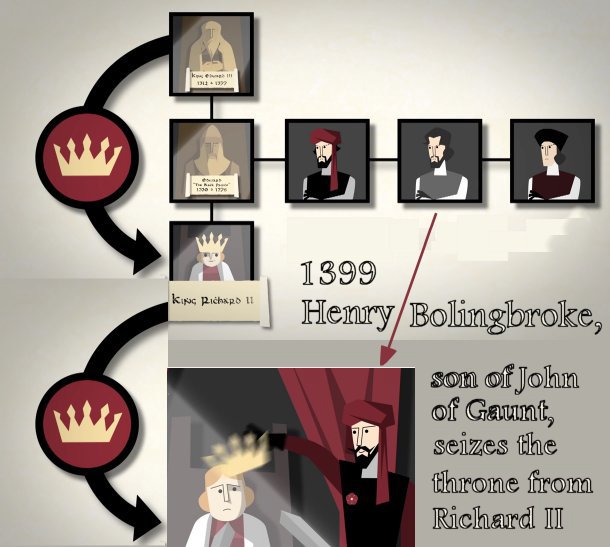 |
Henry IV
Unfortunately for
Richard II, one of the men he picked on had the
means to fight back. In 1399, Richard
II disinherited Henry Bolingbroke.
Determined to regain his estate, Henry,
returned
from exile and deposed Richard.
Richard picked on the
wrong enemy. Henry was not only his
direct cousin, he was the son of John of
Gaunt, the second wealthiest man in the
kingdom. It was a family feud,
Plantagenet versus Plantagenet.
John of
Gaunt's eldest son and heir, Henry Bolingbroke, Duke
of Hereford, had been exiled for ten years by King
Richard II in 1398 as resolution to a dispute
between Henry and Thomas de Mowbray, Duke of
Norfolk.
When John of Gaunt died in 1399, his
estates and titles were declared forfeit to the
crown. King Richard II saw fit to do this
because he had named Henry a traitor and changed his
sentence to exile for life. Henry Bolingbroke
returned from exile to reclaim his inheritance and
depose Richard.
Henry
invaded England in June 1399 with a small force that
quickly grew in numbers due to Richard II's
unpopularity. Claiming initially that his only
goal was to reclaim his lost estate, it soon became
clear that Henry intended to claim the throne for
himself.
|
|
| |
|
Meeting
little resistance, Bolingbroke deposed Richard and
had himself crowned as King Henry IV (1399-1413).
Richard
II died in captivity in February 1400; he is thought
to have been starved to death
in Pontefract Castle.
From
what the history books say, he deserved it.
Henry's
ascension to the throne marked a changing of the
guard. His father, John of Gaunt, was the
third son of Edward III. John of Gaunt
enjoyed a position of considerable political
influence during much of the reign of Henry's cousin
Richard II. Henry's mother Blanche was heiress
to the considerable Lancaster estates. Thus
Henry IV became the first King of England from the
Lancaster branch of the Plantagenets.
Significantly, Henry was the first King of England since the
Norman Conquest whose mother tongue was English
rather than French.
Although
England finally had an English king, Henry
did not enjoy a particularly auspicious reign. He
spent most of his 13 years defending himself against
plots, rebellions and assassination attempts.
Henry died exhausted, probably of leprosy, at the
age of 45.
Although
Henry IV did not accomplish much on his own other
than fend off all the attackers, his son Henry V
would become one of England's most famous rulers.
|
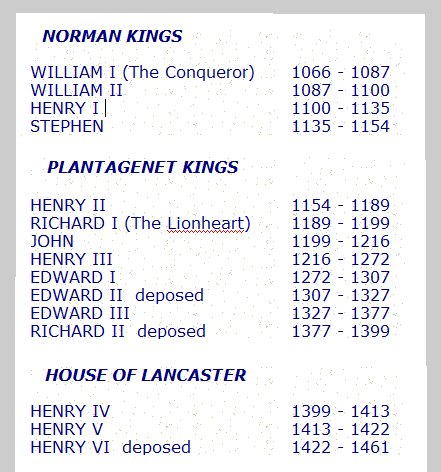 |
| |
|
Problem of
Succession
Henry IV had stepped out of line.
Literally.
The heir of the royal estate according to
common law was Edmund Mortimer,
5th Earl of March, who descended from the
daughter of Edward III's third son,
Lionel of Antwerp.
Basically, Edmund Mortimer had been cheated
out of the throne.
Bolingbroke's father, John of Gaunt, was
Edward's fourth son. In other
works, Bolingbroke had broken the line of
succession and opened a can of worms.
Henry thus had to overcome the superior
claim of the Mortimers in order to maintain
his inheritance. At the time, the
problem was solved by everyone looking the
other way and coming up with legal
goobledygook to explain why it was okay
after all.
|
 |
| |
|
Basically, Henry Bolingbroke had opened a
can of worms. If it was okay for him
to 'step out of line', then it was okay for
all his royal cousins to do the same at a
later date.
This difficulty compounded when the Mortimer
claim was merged with the Yorkist claim in
the person of Richard Plantagenet,
Duke of York. The Duke of York
was the heir-general of Edward III, and the
heir presumptive (due to agnatic descent) of
Henry's grandson Henry VI. We will
come back to this shortly.
|
|
| |
|
Henry V
|
|
| |
|
Henry V
was extremely pious and serious. He was also a
skillful soldier. Henry honed his military
skills by helping to put down the many rebellions
launched against his father. Henry was quite a
fighter. The boy had already been knighted
when aged just 12.
Ascending to the throne in 1413, Henry pleased his
nobles by renewing the Hundred Year's War with
France in 1415. More than likely, Henry V
spotted an opening. France was in complete
disorder. The French king, Charles VI of
France, was prone to mental illness; at times he
thought he was made of glass. Furthermore, his
eldest surviving son was an unpromising prospect.
Seeing that France was leaderless, Henry V decided
to strike.
Henry V
didn't need an excuse. He simply revived the
old dynastic claim to the throne of France that had
been earlier pursued by Edward III of England.
Henry's
campaign was at best a borderline success. He
laid siege to the port of Harfleur, modern day Le
Havre. During the long siege, Henry lost 33%
of his forces to dysentery. Ravaged by
disease, Henry decided to fold his tents and head
back to England.
Meanwhile, the French had other ideas.
|
 |
| |
|
Agincourt
|
| |
|
So how about the Archers?
Many Englishmen were known by their occupations in Old England. Here
is a simple list of occupations that turned into easily
recognizable names:
Archer, Baker, Brewer, Butcher, Butler, Carpenter, Carter,
Clark, Cooper, Cook, Dyer, Farmer, Faulkner, Field, Fisher,
Fuller, Gardener, Glover, Head, Hunt, Hunter, Judge, Knight,
Mason, Miller, Page, Parker, Potter, Sawyer, Slater, Smith,
Taylor, Thatcher, Turner, Weaver, Wood, Wright.
These names are all gentle
reminders that many Americans can trace their lineage back
to England and its surrounding areas.
Many of the English got
their names from their occupations. As one might gather,
since I am an 'Archer', my family traces its roots
back to the glory days of the Archers during the 'Hundred
Years War' between England and France.
Of course, I am very proud
of my Archer name. The Archers not only won the famous
battle of Agincourt on French soil in 1415,
they did so on my birthday!
|
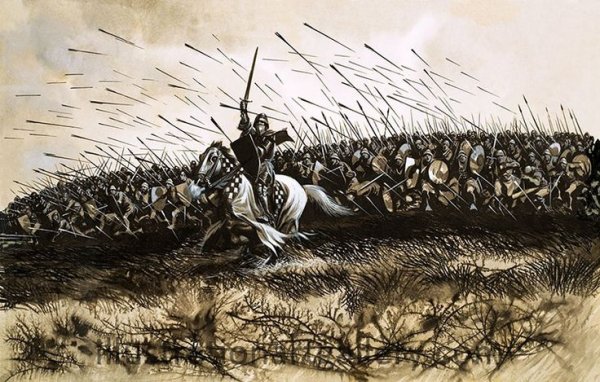 |
| |
|

The 1415 Battle of Agincourt was the most
famous battle during the long series of warfare between
England and France known as the Hundred Years War.
What makes the battle so remarkable was that
the army of Henry V
was apparently outnumbered 5 to 1.
But somehow the English managed to win.
Not only that, Henry was said to have only lost about 400
men.
Many accounts suggest it was 30,000 French
against 6,000 English. So how on earth did the
English beat an army five times larger
and incur so few losses in the process?
Well, the Mystics will say
Fate and the Realistics will say the English benefitted from
several factors, one being considerable luck.
Seriously, the French had no business losing this
battle. They didn't even have to fight!! They could have won just by sitting still and forcing the
outnumbered English to do the attacking... in which case the
larger French army would have enjoyed a serious advantage.
The English invasion of
France by King Henry V was cut short by a serious outbreak
of dysentery. Henry had already lost one-third
of his army to disease and was limping to Calais, an English
Channel port from which his pitiful army could sail home.
The army was low on provisions and exhausted from a previous
battle at Harfleur (modern day Le Havre).
The French pulled an
impressive trick on the English. In order to
reach Calais, the English had to cross the Somme River in
northern France. Heading
north along the French coastline, the English were met by a
small French army on the northern side of the Somme River.
The English army moved inland in search of a safe spot to
cross the river swollen by seasonal rains. The small French army shadowed the
English every step of the way to prevent it from crossing.
This maneuver forced the English to detour nearly one
hundred miles inland before it could find a place to cross.
The detour changed a 120 mile trip to Calais into a 260 mile
trip. In the process, the detour delayed the English reaching Calais by two
weeks.
During this two week delay,
the French used the extra time to assemble the largest army in
history. The word spread throughout France... head to
Calais and take place in the greatest
English arse kicking
in French history. Everyone wanted a piece of the action.
The English were just 30
miles from Calais when it crossed a hill. Surprise! There
in front of them stood an army of 30,000 men. This army
stretched as far as the eye could see.
Devastated from dysentery,
low on provisions, exhausted after a three-week march, the English army had a huge problem... the French
were in no hurry to fight. All the French had to do was sit
there for a week, drink wine and let the English starve to death.
| |
|
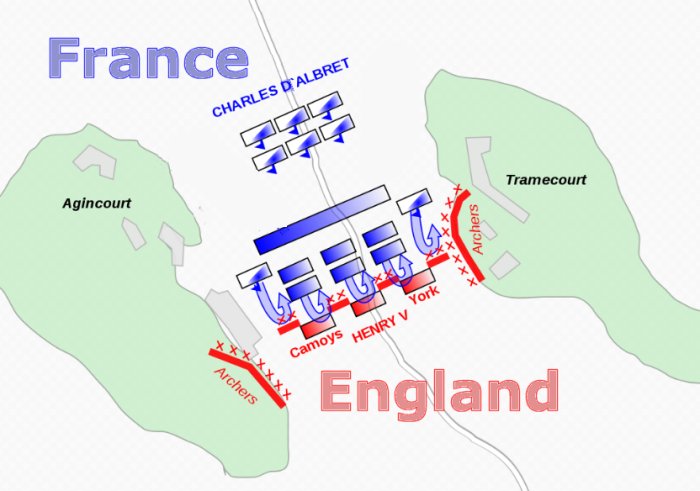 |
King Henry V had no choice.
He had to attack.
So how did the English
win? Rain, vain, terrain.
The
overnight 'rain' was a
huge
help. It turned the battlefield into a mud
pit. The field
had recently been ploughed and the upturned dirt became a
quagmire. Now the heavily armored French were at a
considerable disadvantage because their
heavy armor made them immobile
in the muck.
The 'terrain' was a
gentle slope with the English on the high ground. On either
side of the field were thick forests. This helped the
English because now the French were unable to flank them.
In addition, the vast majority of
the French forces were stuck at the back and unable
to join the fight.
Henry
used a narrow front channeled by woodland to give
his heavily outnumbered force a chance.
All the English had to do was keep the front line of the
French at bay while the countless thousands of Frenchmen
behind the lines twiddled their thumbs.
Even better, the English
archers went into the woods where they could attack the
French using the cover of the trees.
|
| |
|
As for 'vain', the English left themselves completely vulnerable
for an entire hour, but
the French just sat and
watched. They were so
certain of victory that they passed
on this delicious window of opportunity.
Every archer was told to
carry a giant wooden stake with a point
on the end to plant in the ground.
These stakes were to serve as a
defensive barrier to slow down the
French horses.
The English were in a
terrible position. They had no choice but to attack or
starve. The problem was that the French army was out of
arrow range. In order to
fight, first they had to move the archers
closer. Henry's decision to
move forward meant the archers had dig up their stakes, move
them 200 yards forward, then re-plant them.
Surely the French were amused.
It was a preposterous sight to see the English dig
up their stakes, move them forward, and then replant
them. The entire time, the
archers were vulnerable to attack by the mighty
French cavalry. The French cavalry force could
have devastated the English line if it had attacked
while they moved their stakes.
Instead they
did nothing while the English
came closer.
|
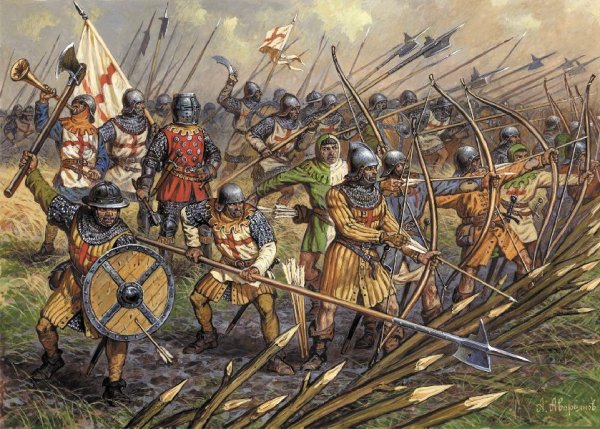 |
| |
|
French arrogance cost them a surefire triumph.
When Henry originally
decided to attack France, he had been right about
one thing... the French seriously lacked leadership.
Their generals did not seem to have a clue on this
day.
Now that the English archers
were within striking distance, they let loose an initial volley
of arrows. The initial deluge of arrows was so thick
legend has it that the sun disappeared.
This enraged the
French who decided to charge. That was exactly what Henry
wanted them to do. Now the English could fight a defensive
battle. The first line of French knights
attacked only to be repulsed by the English
longbowmen.
The French armor was sufficient to protect many of
the French from the arrows, but the horses were another
story. Every time a horse went down, so did the man
riding it. Once
a knight hit the dirt with
his heavy
armor, he got stuck in the thick mud.
The dead
horses now served as a
defensive wall for the
English, but the French showed great determination
by trudging forward.
|
 |
| |
|
Several days of torrential
rains had turned the recently tilled ground at
Agincourt into a soggy morass. Already weighed down
by their heavy metal armor, the French knights were
forced to slip and slide their way toward the
English line, often sinking down to their knees in
mud. The French attack
slowed to a crawl
and became a prelude to a slaughter in the mud.
The
French had become sitting ducks.
Many
died right where they fell off their horse.
They were caught in a human crush and were either
trampled or suffocated to death after they fell into
the mire. Can you imagine? The water was
so deep in places that a fallen Frenchman might get
his visor stuck underwater and drown.
Those lucky enough to survive
the slog arrived at the enemy position exhausted and
disorganized. Since most of the English weren’t
wearing armor, they were able to pounce on the weary
Frenchmen and inflict devastating casualties.
|
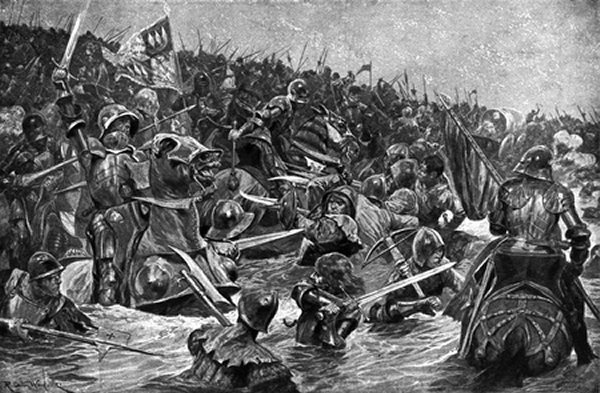 |
| |
|
The English archers put down their
bows and used their poleaxes to kill the immobilized French
knights who were stuck in the mud thanks
to to their heavy armor. The more mobile English
simply raised the visors of their enemy and stuck a knife in
their eye.
The
French viewed the day with mounting horror.
After seeing their first line repulsed, the
second line of French now attacked.
They too were
beaten back, their charge bogged down by the mud on
the field and the defensive wall
of dead Frenchmen.
Late in
the day, a third
line moved to engage but lost heart
as they
crossed the field covered with French dead.
Seeing the futility, they
retreated without giving
fight.
The
battle was over.
|
 |
| |
|
One of
the remarkable features of Agincourt was Henry V
fighting front and center throughout the battle.
The man possessed considerable courage.
It has
been written that a band of 18 French knights under
the banner of the Lord of Croy met before the battle
and vowed to kill Henry V and knock his crown from
his head.
Their
efforts were unsuccessful. One
member did manage to strike Henry’s helmeted head
with an axe and chip off a piece of his crown, but
that was only blow landed all day.
The
entire group of 18 died in their effort.
The
blow wasn’t the only brush with death the King had
while fighting on the front lines. When his
younger brother Humphrey was wounded in the groin,
Henry is said to have kept a group of French
attackers at bay until Humphrey could be carried to
safety.
Richard
the Lionheart may have had the reputation, but Henry
V was the real deal. The word 'hero' was
coined for guys like him.
Henry was
left with control of the battlefield and a decisive
victory.
The resulting massacre left
between 6,000 and 10,000 French troops dead. The English
only lost a few hundred men.
|
 |
| |
|
In 1599
Shakespeare wrote Henry V, including
the immortal St. Crispin’s
Day “band of brothers” speech by which the
king best remembered.
“From this day to the ending of the world,
But we in it shall be remembered-
We few, we happy few, we band of brothers;
For he today that sheds his blood with me
Shall be my brother; be he ne’er so vile,
This day shall gentle his condition;
And gentlemen in England now-a-bed
Shall think themselves accurs’d they were not
here,
And hold their manhoods cheap whiles any speaks
That fought with us upon Saint Crispin’s day.”
This battle is still
considered one of England's finest hours.
|
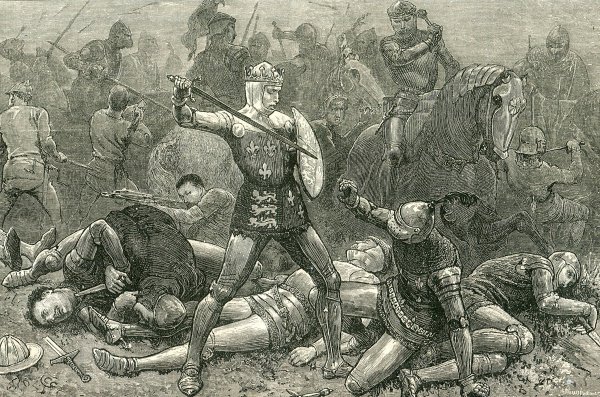 |
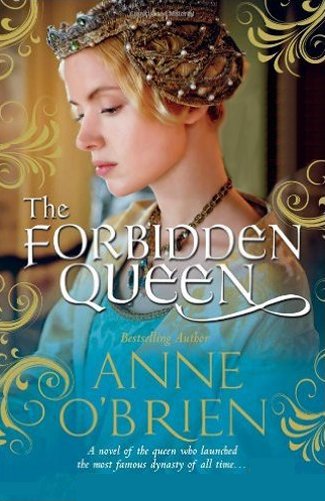 |
Catherine of
Valois
1415. The jewel in the French crown, Katherine de
Valois, is waiting under lock and key for King Henry
V.
While
the English superman is slaughtering her
kinsmen at Agincourt,
Catherine is praying for
marriage to save her from her misery. But the brutal
king wants her crown, not her innocent love.
For Catherine, England is a lion's den of greed,
avarice and mistrust.
And when she is widowed at
twenty-one, she becomes a prize ripe for the
taking—her young son the future monarch, her hand in
marriage worth a kingdom.
This is a deadly political game, one the dowager
queen must learn fast. She
is an innocent pawn in a
kingdom without a king.
The players—the Duke of Gloucester, Edmund
Beaufort and Owen Tudor—are circling.
Catherine de Valois... Who will have her?
Who will
ruin her? A new dynasty will reign…
|
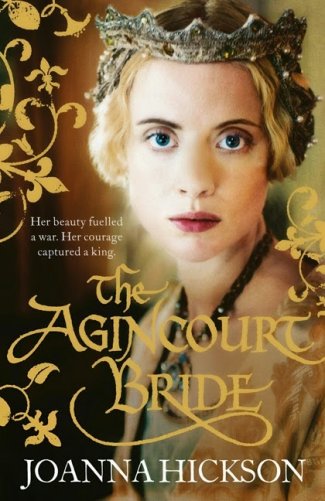 |
| |
|
 |
Catherine of Valois (1401 – 1437) was the daughter
of Charles VI of France. Catherine's older
sister Isabella was queen of England from 1396 until
1399, as the child bride of Richard II. Henry
V had been betrothed to Catherine even after the
great English victory at Agincourt. Despite the
French humiliation, plans for the marriage
continued. Catherine was very attractive.
When Henry finally met her at Meulan, he became
enamored. In 1420, after a peace agreement was made
between England and France, Catherine and Henry were
married.
Catherine went to England with her new husband and
was crowned queen in February 1421. Four months
later, Henry returned to France to continue his
military campaigns during the Hundred Year's War.
One would think being married to the daughter of the
French King would calm Henry down, but apparently
not. He was still determined to be the King of
France.
Catherine was several months pregnant when Henry
left. She gave birth to Henry VI. Her
husband never saw their child. During the siege of
Meaux, he became sick with dysentery and died on 31
August 1422. Catherine was not quite 21 and
was left a queen dowager. What would the
future hold in this foreign land?
|
| |
|
Acclaimed author Anne O’Brien
offers her thoughts on
the French woman who found
herself at the heart of
a royal power struggle...
Has there ever been a Queen of England less
acclaimed – so apparently unexceptional –
than Katherine de Valois?
True, she was a Valois princess, daughter of
Charles VI of France and Queen Isabeau; she
became the beautiful young bride of
England’s heroic King Henry V, victor at
Agincourt.
Shakespeare wrote for her a splendid love
scene in Henry V, where Henry declares: “There
is witchcraft on your lips, Kate.”
But Katherine’s early life was not
glamorous, being one of neglect and
starvation, running unwashed and wild
through the Hôtel St-Pol, her father
suffering from bouts of madness, her mother
unapproachable. When packed off to a
convent, Katherine’s education was minimal.
She learned to play the harp.
What she had was royal blood and so she
became a matrimonial prize in the diplomatic
maneuvering to bring peace between England
and France. Henry wanted the French crown
for his descendants, and that is what
Katherine brought as her dowry. Henry would
have wed her had she been the ugliest
princess in Christendom.
This was no
fairytale marriage, and Katherine of course
had no choice in the matter. Nor did life
improve for her as Henry’s
young wife. Out of
the 26 months of their marriage, she spent
only five of them with him in England, and
when left a young widow, she was allowed no
role in the education or upbringing of her
baby son, Henry VI.
Her position was ceremonial, standing beside
the young king when he was crowned or when
he opened parliament.
to be continued...
|
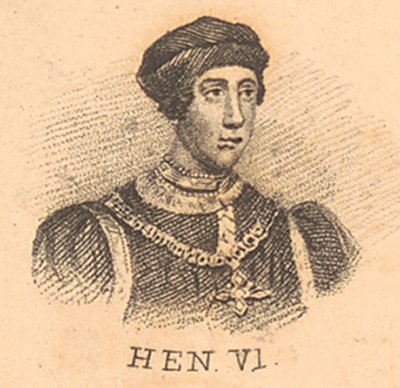 |
Henry VI
Poor Henry VI. Nice guy,
but gullible and easily manipulated by his powerful
wife Margaret of Anjou. Unlike
his warrior father Henry V, Henry VI was not suited for warfare.
Gentle, pious and retiring, he came to the throne as
a baby. In the process he inherited a losing
war with France. Under his watch, the Hundred
Years War ended in 1453 with the humiliating loss of
all French lands except for Calais.
All that
fighting and nothing to show for it. In August 1453, Henry VI
suffered a catastrophic mental breakdown brought on
by the news of the defeat at the Battle of Castillon
in Gascony, the defeat which finally drove English forces from
France.
Henry VI became completely unresponsive
and unable to
speak. He had to be led from room to room.
This had happened before. Mental illness was
hereditary in his mother's family. During these periods of
insanity, he was incompetent to rule.
Previously when this happened, Margaret of Anjou,
his wife, assumed control of his kingdom. But
this attack was far more severe. The Council tried
to carry on as though the king's disability would be
brief, but eventually was forced to admit something
had to be done.
Henry's ineffectual rule
encouraged the nobles to scheme for ways to
establish control over him. In 1454, Richard,
Duke of York, was made Protector of the Realm.
The House of York challenged Henry VI's right to the
throne and England was plunged into civil war.
The War of the Roses was
about to
begin.
|
| |
|
|
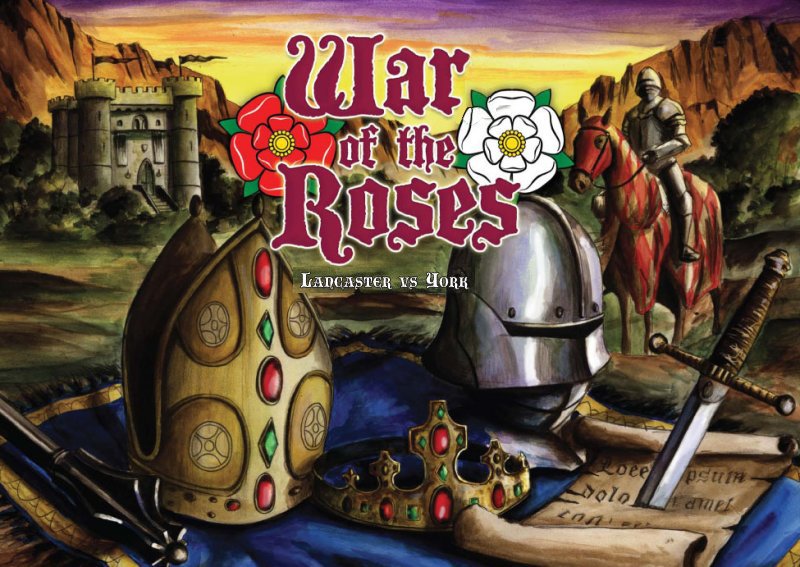 |
| |
|
The War of the Roses
ACT ONE:
The Man Who Would
Be King
|
|
|
The
War of
the Roses was a brutal
Civil War between two powerful families over who
would be the next English King.
After
the
Hundred Years War
(1337-1453) had fizzled out under Henry VI, the
weakling son of the great Henry V, the consensus was
the man had lost his mind. Henry VI was so
incompetent that
the English nobles appointed Richard Plantagenet,
Duke of York, to run the show. The House of
Lancaster had been in charge for the past 50 years.
They were not at all pleased to see a York man in
charge.
The competition to replace Henry VI
became the spark
that ignited The War of the Roses
(1455-1487),
32 year stretch when one man
after another took his best shot at obtaining the
throne. Four different wars were fought and
lots of people died in the process.
On one side was the
House of
Lancaster whose symbol was a red rose. Opposing them was
the House of York whose symbol was a white rose.
Hence the name.
One
unusual twist to the rivalry was the fact that many
of the participants were related to each other.
Since neither side had any better claim
to the throne than the other, they decided to fight
it out. The carnage was incredible.
In the end, only one person
came out smelling like Roses.
William Shakespeare wrote 8 plays.
|
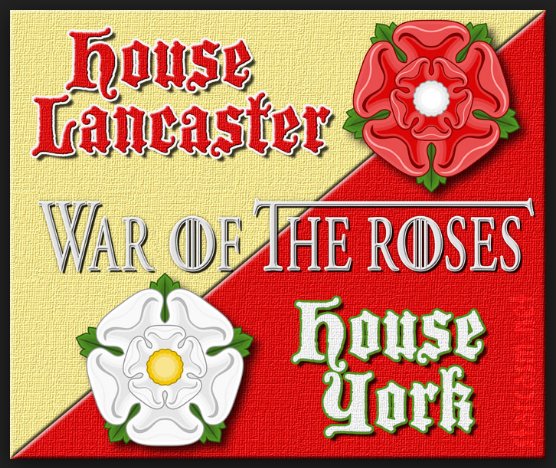 |
 |
The houses of Lancaster
and York correspond to
the modern counties of Lancashire
and Yorkshire.
The War of
the Roses saw the Yorks and
Lancasters play musical chairs with
the English throne. Starting with
Henry IV, the Lancasters had been in
charge for 50 years. Now the Yorks wanted their day in the sun.
Both
sides gained and lost power multiple
times. In total, the Wars
resulted in five different rulers in the span of
only 25 years, three of whom were killed or executed
by their rivals.
Have you
ever heard of the Lannisters? Have you
ever heard of the Starks? Lannisters =
Lancasters, Starks = Yorks.
The exciting HBO series
Game of Thrones was inspired by the
wildly improbable twists and turns seen
during the War of the Roses.
The War
of the Roses was so brutal it made Game of Thrones
look like kids fighting with wooden swords. It
even had dragons!!
Well,
maybe not. But it should have.
|
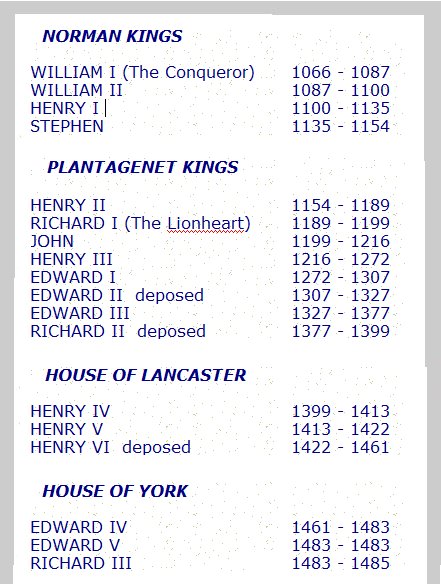 |

| |
Richard of York,
Man of Ambition
|
Richard
Plantagenet, 3rd Duke of York, was a leading English
noble who wanted to be King. Due to his vast
land holdings in Yorkshire, he was the wealthiest noble in England, second only to the king
himself.
Richard
believed his royal lineage was stronger
than any person in England, including the current
King Henry VI. He based his claim on the
lineage of his two parents.
Richard's grandfather Lionel
preceded John of Gaunt in the birth order of
Edward III. Lionel had only one
child, Philippa. In 1368 Philippa
married Edmund Mortimer, 3rd Earl of March.
Their son Roger Mortimer was the man Henry
IV had 'cheated' out of the throne 50
years earlier.
Lionel's granddaughter, Anne
Mortimer, married into the Yorkist branch of
the English royal family and gave birth to
Richard Plantagenet, 3rd Duke of York.
Richard of York based his claim to the
English throne on this line of descent from
Lionel, who was the eldest son of King
Edward III to establish a lasting blood
line.
|
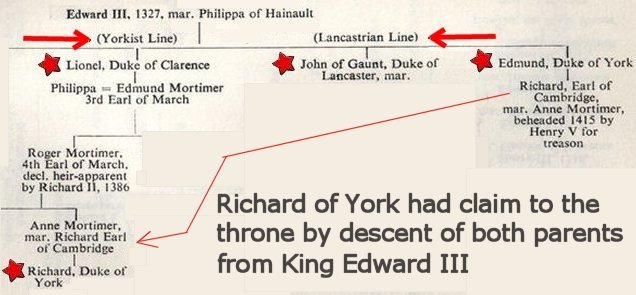 |
| |
|
Second, Richard's father was
Richard, Earl of Cambridge. This made Richard
of York the great-grandson of Edward III on his
mother's side and the grandson of Edward III on his
father's side. Descent from not one, but
two of Edward's sons made for a strong claim.
Richard also had a score to
settle. Henry V had beheaded his father
Richard, Earl of Cambridge, for treason in 1415.
Richard had no love for the House of Lancaster or
for Henry VI, son of the man who murdered his
father.
Richard was certain he had just
as much right to the throne as King Henry VI, the
bumbling Lancaster. Legal scholars agreed with
Richard. Unless Henry VI could produce an
heir, Richard was next in line.
1453 was
an important year in English history. In
January, Richard got the bad news: the Queen
was pregnant. If her child was a boy,
Richard's claims would be negated. Then came
more bad news: England had just lost the
Hundred Year's War. Then came the strange
news: The King had gone mad.
Henry
VI, a weak Lancastrian King, had overseen England's
defeat in the Hundred Years' War. This was the
least of England's problems. Due to poor
leadership, the country was beset with social,
political and economic problems. Popular
revolts were commonplace, triggered by the denial of
numerous freedoms. Lacking leadership, the
rich and powerful English nobles took matters into
their own hands. They raised private armies,
engaged in private feuds and openly defied Henry VI.
England was a land divided.
|
| |
With
Henry's mental breakdown in 1453, this was Richard's
big chance.
Richard
was desperate. Noting that Margaret was
pregnant, he needed to take power now. Even if
the newborn child was a boy, it would be 16 years
before the boy came of age. Richard was
willing to settle for that. A lot can happen
in 16 years. Richard told anyone who would
listen that Henry VI had to go sooner rather than
later.
The
barons and nobles agreed. They also agreed
Richard of York was the best qualified man to run
the state. Richard of York was appointed to
govern as Lord Protector during the madness of King
Henry VI. This move, of course, set in motion
dangerous and far-reaching energies.
The
House of Lancaster was not going sit by idly and let
Richard run roughshod over them. Henry VI was
not dead, he was catatonic. In the eyes of the
Lancasters, Henry was 'resting'. In
their opinion, Henry VI should decide who the next
king should be. Furthermore, wasn't Richard
overlooking something? By amazing timing,
Margaret of Anjou, wife of Henry VI, had just become
pregnant. If she were to have a son, the son's
claim would supersede Richard's claim.
Richard
would have none of it. He intended to pursue
the throne, Margaret's pregnancy be damned.
His unquenchable ambition would soon lead England to
the brink of war.
Matthew
Lewis, biographer of Richard, points out that the
enduring reputation of Richard as villain is unsympathetic and
largely unfair. To begin with, Richard had a
legal claim. Richard had every right to pursue
his claim through political means. He had served loyally as Henry VI’s
lieutenant in France on two occasions and then later
in Ireland. Richard performed his roles
solidly, though unspectacularly. The turmoil
of the 1450s
were largely caused by Lancastrian paranoia
and subsequent infighting to stop Richard.
No doubt
Richard, Duke of York, was a complex man capable of
good as well as evil. That said, there can be
no doubt that Richard would go down in history as
the man whose ambition for the crown sparked the
horrible civil war now known as the War of the
Roses. In the eyes of many people, Richard,
Duke of York, would go down in history as one of the
major
villains.
|
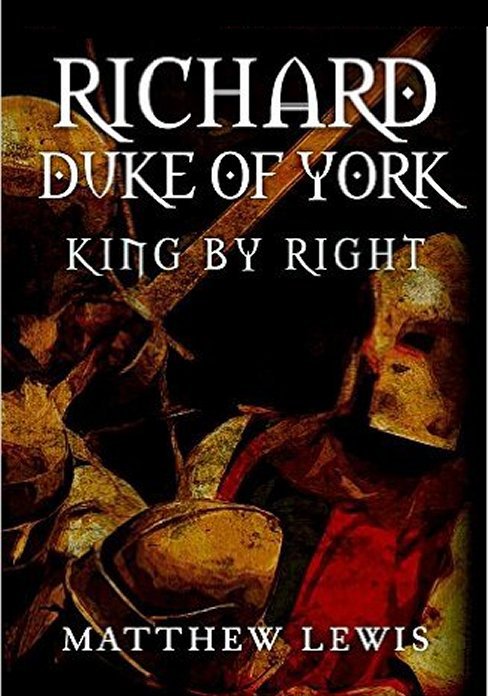 |
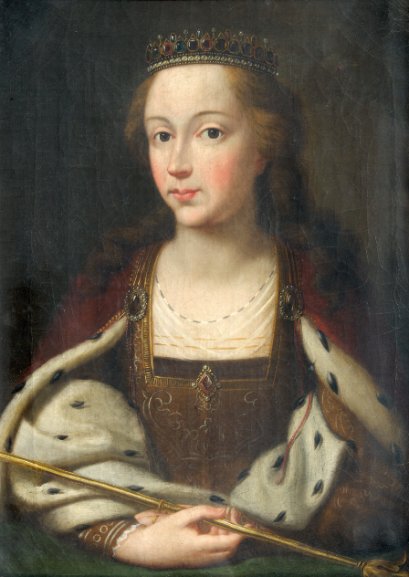 |
Margaret of Anjou was the Queen of England.
As the wife of incapacitated Henry VI, she
would be equally guilty of
provoking the onset of the War of the Roses.
Margaret was raised in France. She
married English King Henry VI at age 15.
Henry VI was not a successful king.
Henry was more interested in religion and
learning than in military matters.
When he married Margaret, his mental
condition was already unstable.
Margaret cursed Catherine of Valois.
As daughter to the mentally disturbed French
King Charles VI, now doubt Catherine had
passed on this hereditary condition to
Margaret's son Henry VI.
In
1452,
England was falling
apart. Richard, the Duke of
York was persuaded to return from Ireland,
claim his rightful place on the council and
put an end to bad government. His cause was
a popular one and he soon raised an army at
Shrewsbury. The
Lancaster group,
meanwhile, raised their own similar-sized
force in London.
Margaret took charge while Henry simply
wrung his hands.
1453 was much worse. First Henry
learned that England had lost the Hundred
Year's War with France. Then he
learned that Margaret was pregnant which was
fairly miraculous since Henry had not been
intimate. However, he was so out of it
that Margaret was able to persuade Henry
that he had merely forgotten their liaison.
Shortly after his son Edward was born in 1453, Henry
suffered a nervous breakdown.
Now rumors
were rife that the new Prince of
Wales was the result of an adulterous
affair. Perhaps it was this knowledge
that pushed Henry VI over the edge.
After his breakdown, Henry VI was judged
incapable of ruling. So Richard, Duke
of York, was appointed to run the Kingdom.
Richard immediately assumed control.
Not so fast. Margaret of Anjou, Queen
of England, refused to accept any
arrangement that deprived her newborn son - Edward
of Westminster - of his birthright.
Queen Margaret was determined to secure the
throne for her son Edward, but since he was
just a baby, she had no choice but to allow
the Duke of York to take over.
|
| |
|
Queen Margaret would stop at nothing.
Although the Lancasters were nominally aligned
behind King Henry VI, his ill health ensured that he
was never a major player in the coming War of the
Roses. The de facto leader of the Lancaster
faction was instead Henry's cunning wife Margaret.
As the most skilled strategist of the Lancasters,
Queen Margaret was hell bent on putting Richard
in his place.
|
| |
|
Edmund
Beaufort
|
| |
|
Edmund Beaufort, 2nd Duke of Somerset, was
Richard of York's main rival. Edmund was just
as ambitious to become King as Richard. Like
Richard, Edmund noted that Henry VI was still
childless after seven years of marriage. Were
Henry VI to remain without an heir, who would be the
next in line for the crown? Edmund assumed he
had a strong claim. If Henry VI could trace
his right to the throne by pointing to John of Gaunt
and Blanche, well, then Edmund could point to John
of Gaunt and Katherine Swynford.
|
| |
|
Unfortunately Richard of York could make a better
claim. Richard could point to his mother's
lineage from Lionel and his father's lineage from
Edmund. Therefore Richard's claim was stronger
than Edmund's. This explained why Richard was
named Henry's heir presumptive.
Edmund
was disgusted. To hell with Richard of York.
Edmund was going to get the crown by hook or crook.
One of his first moves was the 1427 seduction of
Catherine of Valois, the widowed mother of Henry VI,
age 5.
As the
daughter of French King Charles VI, Catherine was viewed
with considerable suspicion by English
nobles. Afraid she would implant
French sympathies into her son's gullible mind, they prevented
her from playing a full
role in her son's upbringing. Largely
cut off from her son and stuck in the court of a
foreign land that did not like her, Catherine was
pretty much bored, beautiful, and lonely.
Sensing easy pickings, Edmund Beaufort initiated a
torrid affair in 1427.
|
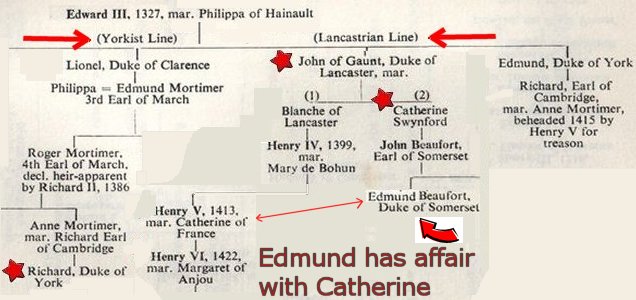 |
This
shook up the English Council. The last thing
they needed was a messy marriage and more heirs.
So they passed a law forbidding Catherine to marry
without the King's approval.
Although
the current king, Henry VI, was quite likely to give
his mother the necessary approval, there was a
catch. Henry was only 7 years old. Until
Henry came of age (16), he could not legally give
approval. Mom would have to stay single.
Very clever.
No
problem. Edmund used his position as
Catherine's one-time sweetheart to become closer to
Henry VI. He did his best to become a a
surrogate father to the boy.
Later,
Edmund would exploit his personal relationship by
persuading the King to promote Edmund to various
royal offices.
|
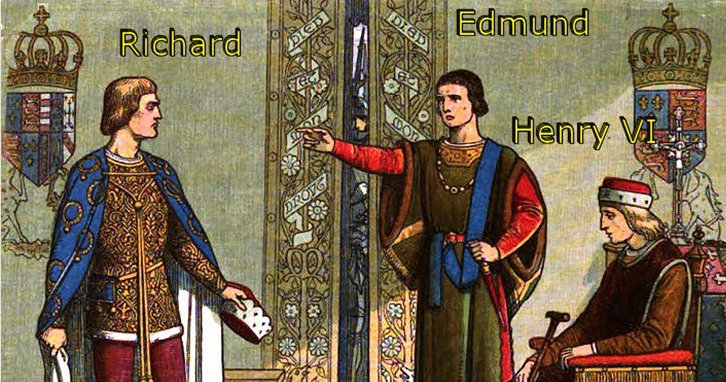 |
Richard had a
huge wealth advantage.
Although Edmund was the head of one of the
greatest families in England, his
inheritance was worth only 300 pounds.
By contrast his rival Richard had a net
worth of 5,800 pounds. Henry VI made
sure that Edmund was
compensated with offices worth 3,000
pounds. Not only did that bring Edmund
deep within Henry's inner circle, Edmund had
money to raise armies with.
This
patronage served to offend Richard of York
and many of the other nobles deeply. As Edmund's
quarrel with York grew personal, the
dynastic situation got worse, especially in
1451 when Edmund became Henry VI's right
hand man.
Edmund used his inside track in another way.
Edmund was not only Henry's right hand man,
he enjoyed the considerable advantage of
sleeping with the King's wife. When it
was announced in January 1453 that Queen
Margaret was pregnant after seven years of
no results, the matter seemed highly
suspicious.
Henry VI displayed qualities that would have
done credit to a monk, but not to a Medieval
King who was expected to produce an heir.
Henry was pious, naïve, chaste, and prudish.
In addition, Henry VI had a well-known
aversion to physical contact.
Seven years had passed without a pregnancy.
Therefore the pregnancy became seen as
either a miracle or the product of adultery.
Henry VI
himself did nothing to
squelch the rumors. When
asked about the
child's paternity,
Henry declared that Edward must have
been fathered by the Holy Ghost.
Nor did it help that Edmund was made the
child's godfather. The odds clearly
favor Edmund Beaufort as the father of this
child. However, what is more important
is that Henry VI was not the father.
Richard of York knew this and so did
everyone else. Margaret and Edmund
were trying to promote an illegitimate child
to the throne.
|
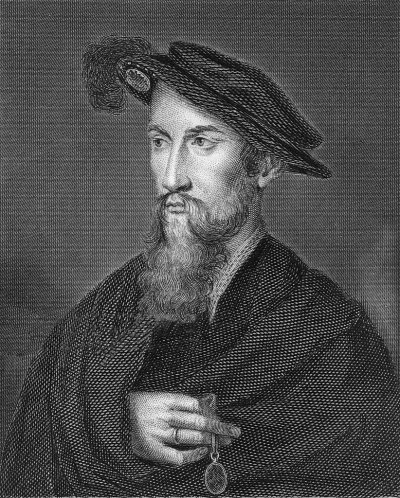 |
Despite
the objections of Margaret and Edmund, in 1454
Richard of York was named regent as Protector
of the Realm.
Richard
of York, meanwhile, had gained a very important
ally, Richard Neville, Earl of Warwick, one of the
most influential magnates of the
realm. Warwick was
an English nobleman, administrator, and military
commander. He was possibly richer than
Richard of York himself.
Richard Neville became
known as Warwick the Kingmaker due to his
considerable influence during the infighting to
replace Henry VI.
Warwick
was originally a supporter of King Henry VI.
However, a territorial dispute with Edmund Beaufort,
Duke of Somerset, led him to collaborate with
Richard, Duke of York, in opposing both Beaufort and
the king. The alliance between Richard and
Warwick was aided by the fact that Richard's wife
Cecily Neville was Warwick's aunt.
Once
Richard of York took power, the landscape changed
immediately. Queen
Margaret was excluded
from the Council
completely. Edmund Beaufort's fortunes changed
the moment his rival Richard
of York assumed power as Lord Protector. Richard had
Beaufort imprisoned in the Tower of London and began
looking for reasons to execute him.
Then Richard set about
destroying Beaufort's reputation. Richard's
York supporters spread rumors that the king's
child was illegitimate and that
Beaufort was the father.
Then Richard got to work.
His months as regent were spent tackling the
problem of government overspending.
|
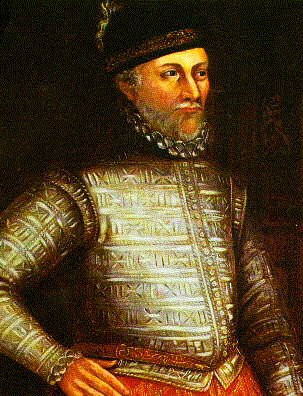 |
Still,
there was the curious issue of Margaret's pregnancy
for Richard to deal with. Margaret gave birth
to a son in October 1453. Margaret immediately
took great pains to quash rumors that Beaufort might
be his father. During her pregnancy, Henry had
suffered a mental breakdown, leaving him in a
withdrawn and unresponsive state that lasted for one
and a half years. This medical condition,
untreatable either by court physicians or by
exorcism, plagued him throughout his life.
Unfortunately for Richard
of York, the birth of baby
Edward removed him from the succession to the
throne. The child was baptized Edward, Prince
of Wales, with Edmund Beaufort listed as godfather.
If the King could return to consciousness, Margaret
intended to persuade Henry to make Edmund Beaufort legal heir to the throne
and protectorate of the Realm till the boy came of
age.
Unfortunately, the King was too far gone to do any
such thing, so Richard's dreams of being king were
still on track.
Then came the
worst surprise of all... Henry woke up.
After a
17-month bout with mental illness, Henry VI remarkably
recovered his reason in January 1455.
As historian Robin Storey
put it: "If Henry's
original insanity was a
tragedy, his recovery was a national disaster."
The
first
thing Henry did was demote
Richard back to the ranks of civilian. Then he
lost little time in reversing
most of Richard of York's actions.
This was a shame because Richard's decisions had
drawn praise for his
even-handedness and willingness to tackle
long-standing problems. Now his initiatives were cut short by
Henry's return. The reforms were
swiftly undone and Richard’s intentions were eyed
with suspicion by the court, members of whom were
the ones who had been disadvantaged by the changes.
Henry
then agreed to recognize baby Edward as his heir,
putting to rest any concerns about a successor.
Richard was out of luck.
Edmund
Beaufort's life was saved by the King's seeming
recovery. Edmund was freed from captivity and
restored to his former position of power.
Having reconvened the court at Westminster by
mid-April 1455, Henry and a select council of nobles
decided to hold a great council at Leicester.
York and his closest allies anticipated that Edmund
Beaufort would bring charges against them at this
assembly.
Seeing
Beaufort released and returned to favor was the last
insult that York would take from his nemesis.
Richard of York was beyond bitter. He was
determined to depose of Beaufort by one means or
another. In May 1455 he raised an army and
tracked down the Beaufort army headed to Leicester.
He confronted Somerset and the King in an engagement
known as the First Battle of St Albans which marked
the beginning of the Wars of the Roses. His son,
Henry, never forgave York and Warwick for his
father's death, and he spent the next nine years
attempting to restore his family's honour.
Facing
with being declared outlaws and traitors, the Yorks
gathered an armed retinue and marched to stop the
royal party from reaching Leicester, intercepting
them at St Albans.
|
|
First Battle of
St. Albans, 1455
On May
22, 1455, Richard, Duke of York engaged the forces
of King Henry VI of England at the First Battle of
St. Albans.
Richard's army outnumbered Henry's army 7,000 to
2,000. Richard attempted to negotiate.
He told Henry to hand over Edmund Beaufort and he
would walk away. Henry stuck by his closest
confidante and refused to give him up.
After
two hours, Richard lost his patience and ordered the
attack. Dividing his forces in two
parts, his first attack failed badly. Warwick
took the second unit through an unguarded part of
the town's defenses, through back lanes and gardens.
|
|
|
|
|
Suddenly
Warwick discovered the market square where the main
body of Henry's troops were talking and resting.
Henry's
men were not yet expecting to be involved in the
fighting. Many were not even wearing their
helmets. Warwick charged instantly with his
force, routing the Lancastrians. Edmund
Beaufort knew that Richard of York would never let
him live. When the Yorkists surrounded his
building, Beaufort was killed in a last wild charge
from the house where he had been sheltering.
Beaufort charged onto the main street and killed
four men before being struck down himself.
His son,
Henry, never forgave York and Warwick for his
father's death. He would spend the next nine
years attempting to restore his family's honor.
The
sudden attack and bravery shown by Warwick began his
famous military career. It would later help
form his nickname as 'The Kingmaker'.
After the battle, Richard of York escorted King
Henry back to London. Richard was appointed as
Protector of England by the parliament a few months
later. Henry VI sat in the Tower of London.
The War of the Roses had begun.
|
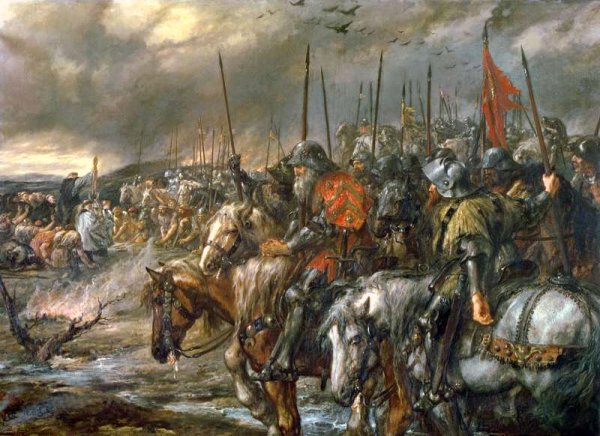 |
Battle of
Wakefield, 1460
|
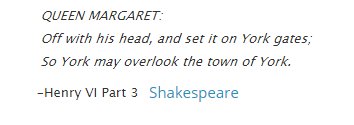 |
|
|
|
Over the
next five years, there were rises and falls in the
fortunes of both camps. The Lancasters won the
1459 Battle of Ludford Bridge. Warwick and
Richard both fled across the English Channel for
safety.
In
December 1459 York and Warwick suffered 'attainder', a
legal process that says their lives were forfeit and
their lands reverted to the king. Nor could
their heirs inherit the lost estate.
This was
the most extreme punishment a member of the nobility
could suffer. Now Richard of York was in the
same situation as Henry of Bolingbroke (the future
King Henry IV) in 1398. Only a successful
invasion of England would restore his fortune.
Assuming the invasion was successful, York had three
options: become Protector again; disinherit the king
so that York's son would succeed; or claim the
throne for himself.
It was finally
agreed upon that Richard would not
only rule, he would become king upon
Henry's death. Only one
problem. Within a few weeks of
securing this agreement, Richard
died in the 1460 Battle of Wakefield
(as did Richard Neville, Earl of Salisbury and
father of Warwick the Kingmaker).
Richard
of York and his forces convened at Sandal Castle, Richard's
stronghold. A small detachment of Lancastrians
were spotted nearly. Instead of awaiting
reinforcements, Richard led an impulsive charge on
the Lancastrians. It was a trap. Two
large forces of the Lancastrian army emerged from
nearby woods and quickly destroyed Richard's men. Richard, 49,
and his son Edmund,
17, died in the battle.
Why
Richard had exposed himself has never been clear.
One possibility is betrayal by some northern lords who
Richard mistakenly believed to be his allies.
Another explanation was overconfident rashness on York's part.
On the order of warrior queen Margart of Anjou, the heads of
Richard and his son Edmund were placed on pikes by
the victorious Lancastrian armies and displayed at
the Micklegate Bar
in York. Richard's head bore a paper crown. The insult was
clear... after all these years, Richard wore his
cherished crown.
Neither Warwick nor
Richard's eldest son Edward, 19, was at this
battle. When Edward learned that he had lost his father and
younger brother in the
fight, he vowed to avenge the
ambush.
|
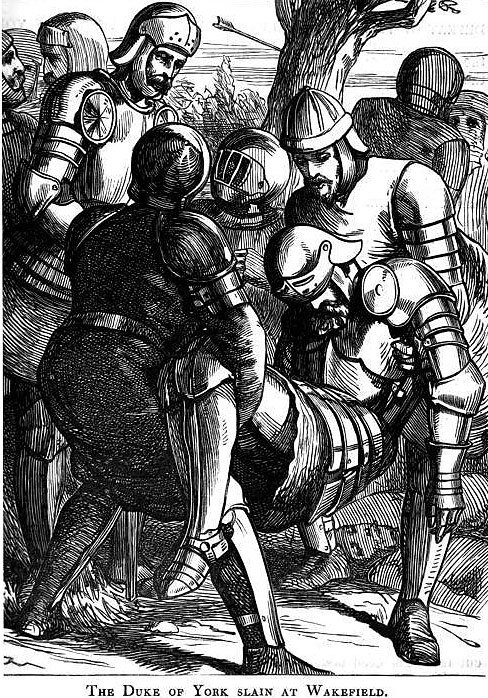 |
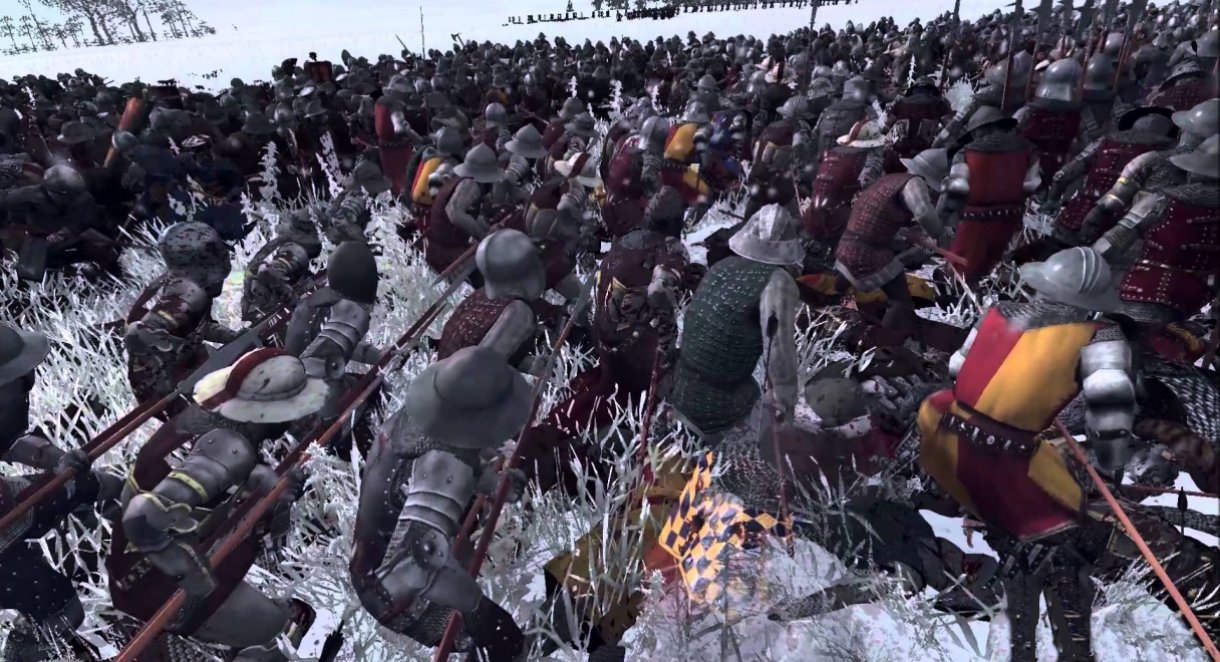
Battle of Towton,
1461
The
death of Richard of York shook a lot of people up.
In a sense, the Lancasters had killed the future
king. This was not viewed well by the majority
of people. Richard had the same opportunity to
murder Henry VI on two occasions, but had shown the
restraint and respect not to do so.
Instead,
after the Yorkists had
captured Henry in 1460, they had taken the political
route. Indeed, the English parliament
passed an Act of Accord which would
allow Henry to remain as king with the understanding
that Richard would be Regent and would take over
upon Henry's death.
The
Act of Accord was a legally binding
agreement. In a sense, Margaret had broken the
law. Margaret did not care. Margaret of
Anjou would never accept the
decision to remove her son's right to the throne
under any circumstances.
Might makes right. Along with fellow malcontents, she
raised a massive Lancaster army that far out-numbered the York
side.
|
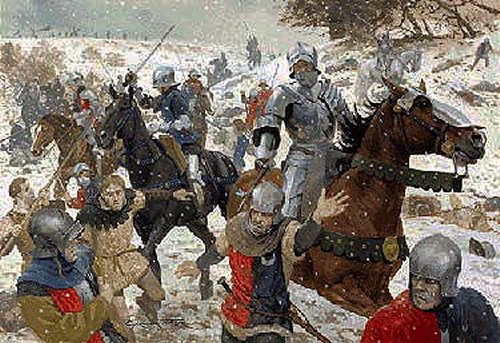 |
| |
After Richard of York was ambushed
and killed at the Battle of Wakefield, nobles who
were previously hesitant to support Richard's claim
to the throne considered the Lancastrians to have
reneged on the Act. Edward found enough
backing to denounce Henry and declare himself King.
The
Battle of Towton was to affirm the victor's
right to bypass the law and rule over England through force of arms.
The battle was
fought in the snow on 29
March 1461, near the village of Towton in Yorkshire.
This was
the grudge match, winner take all.
The York
side was commanded by William Neville, Lord
Fauconberg, a former Lancastrian who had changed
sides to join his nephew Warwick. Fauconberg
faced long odds. He was heavily outnumbered
and part of their
force under the Duke of Norfolk had not yet arrived.
The
initial fighting favored Lancaster, but Lord Fauconberg
saw a way to turn the tables.
Taking note of the powerful wind at their back,
Fauconberg ordered his archers to use the strong
wind to outrange their enemies.
|
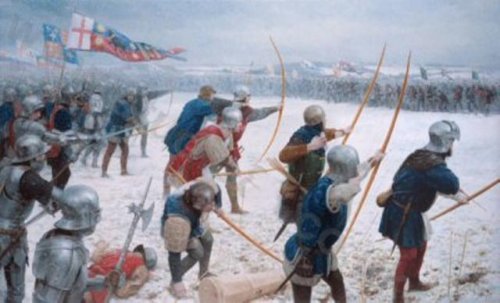 |
| |
This
began a
one-sided missile exchange. The Lancaster arrows
fell short of the Yorkist ranks while the York
arrows forced the
Lancastrians into abandon their defensive
positions and retreat to safety.
However,
now that the York side had exhausted their
ammunition, the stronger Lancaster army regrouped
and prepared to charge. Noticing the countless
Lancaster arrows on the ground that had fallen
short, the Yorkist archers plucked the fallen arrows in front of them and continued shooting.
The Lancaster side was hit with a crippling second
barrage.
The
ensuing hand-to-hand combat lasted hours, exhausting
the combatants. The 'better late than never'
arrival of Norfolk's men reinvigorated the Yorkists.
Now they surged forward and routed their foes.
The fighting lasted ten hours. Many
Lancastrians were killed while fleeing; some
trampled each other and others drowned in the
river and snow streams, said to have run red
with blood for several days.
Towton has
been described as the largest and bloodiest
battle ever fought on English soil.
According to chroniclers, more than 50,000
soldiers from the Houses of York and Lancaster
fought for hours amidst a snowstorm on that day,
which was Palm Sunday. A
newsletter circulated a week after the battle
reported that 28,000 died on the battlefield.
|
 |
Battle of Hexham,
1464
Following the 1461 Battle of Towton, Henry VI, Margaret,
and her son Edward fled to Scotland to lick
their wounds. It turns out that Towton was not
the end. Margaret of Anjou still had fight in
her. Margaret of Anjou was hated by the
English because she was so ruthless. That
said, did she have any choice?
Margaret's entire existence was wrapped around
restoring Henry VI to the throne and protecting her
son's birthright to be the future king. It was
up to her to fight her husband’s battles and her
son's battles.
After
the 1461 Towton battle, as acting head of the House
of Lancaster, Margaret was able to get the families
to regroup in the north, their base of power.
In 1463, Margaret instigated a rebellion to disrupt
a peace process Edward had initiated with Scotland
further to the north.
Edward
sent John Neville, Warwick's brother, to put down
the rebel force. John Neville was better known
as Montagu since he was the 1st Marquess of Montagu.
Montagu effortlessly put down the poorly organized
uprising. Showing none of King Edward's
conciliatory spirit, Montagu had thirty leading
Lancastrians executed in Hexham following the
battle. Maybe this cold-hearted treatment was
necessary. After all, showing mercy had not
solved the problem. Like zombies, the
Lancasters seemed to get back up and start fighting
again. The executions did the trick.
Lancaster resistance in the north of England
collapsed.
At the
end of the battle Henry VI was captured again.
Strange as it must seem, this was now the third time
the poor senile man was captured in battle.
Why they kept trotting this figurehead out on the
battlefield is a mystery.
There is
an interesting story attached to the Battle of
Hexham. Margaret insisted on viewing each
battle herself. She was a warrior Queen if
there ever was one. She also insisted Edward
always be at her side for fear as assassination.
Therefore young Edward’s life was spent hurrying
from battlefields to either triumph or exile.
|
| |
|
After
the Lancastrians were defeated at the Battle of
Hexham in 1463, Margaret, seized with mortal terror
for the life of her boy, fled with him on foot into
an adjacent forest. Driven by dread, she took
any path she could find just to get as far away from
her enemies as possible. Margaret and Edward,
10, were ambushed by robbers who took Margaret's
jewels and costly outer robes.
While
the outlaws quarreled over who got what, Margaret
snatched her son up in her arms and fled to a
distant thicket to hide. When the robbers
could not find them, they gave up and left.
After waiting hours to be sure the men were gone,
Margaret and Edward came out from hiding.
Wandering lost through the forest, they soon fell
into the hands of another outlaw later that night.
Queen Margaret led her boy up to him and said,
“Here, friend, save the son of your king.”
Surprisingly, the robber took pity on them and hid
them in a cave for two days. The outlaw
spotted one of Margaret’s captains who was searching
for them and told the man where the Queen could be
found them. The captain took Margaret and
Edward to Scotland, whence they finally escaped to
France where they would live with Margaret's
relatives as exiles.
Meanwhile, Edward IV, England's first Yorkist king,
took Henry’s crown. Edward
did a smart thing. By law, he could have
confiscated the estate of virtually every
Lancastrian noble. Most of
England's leading families had remained loyal to
Henry VI or remained uncommitted in the recent
conflict. Edward did indeed seize the estates of all the
Lancaster nobles who had died during the fighting,
but offered to let the rest keep their lands on
promise of loyalty. This worked like a charm.
Peace came to the land for the time being.
England was done fighting, but only for a while.
In the
aftermath, the new regime relied
heavily on the support of Warwick
and the Neville family who had been so instrumental in bringing Edward to the
throne.
Not long after Edward IV
began his reign, Warwick the Kingmaker turned into a
Queen maker. He began casting about for a
suitable Queen for the bachelor king. This
endeavor would lead to one of the strangest stories
in history.
|
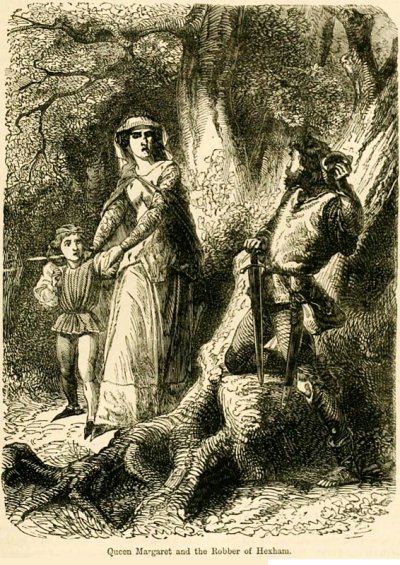 |
| |
|
| |
The War of the
Roses
ACT TWO:
Warwick's Betrayal
|
| |
The House of
Neville
Nothing
that takes place from here will make any sense
unless we first discuss the House of Neville.
There
are two things to know about the Nevilles.
First
and foremost, the Neville wives reproduced at an
unimaginable, unfathomable rate.
Second,
they were the richest family in England which is a
good thing because they had a lot of mouths to feed.
|
|
|
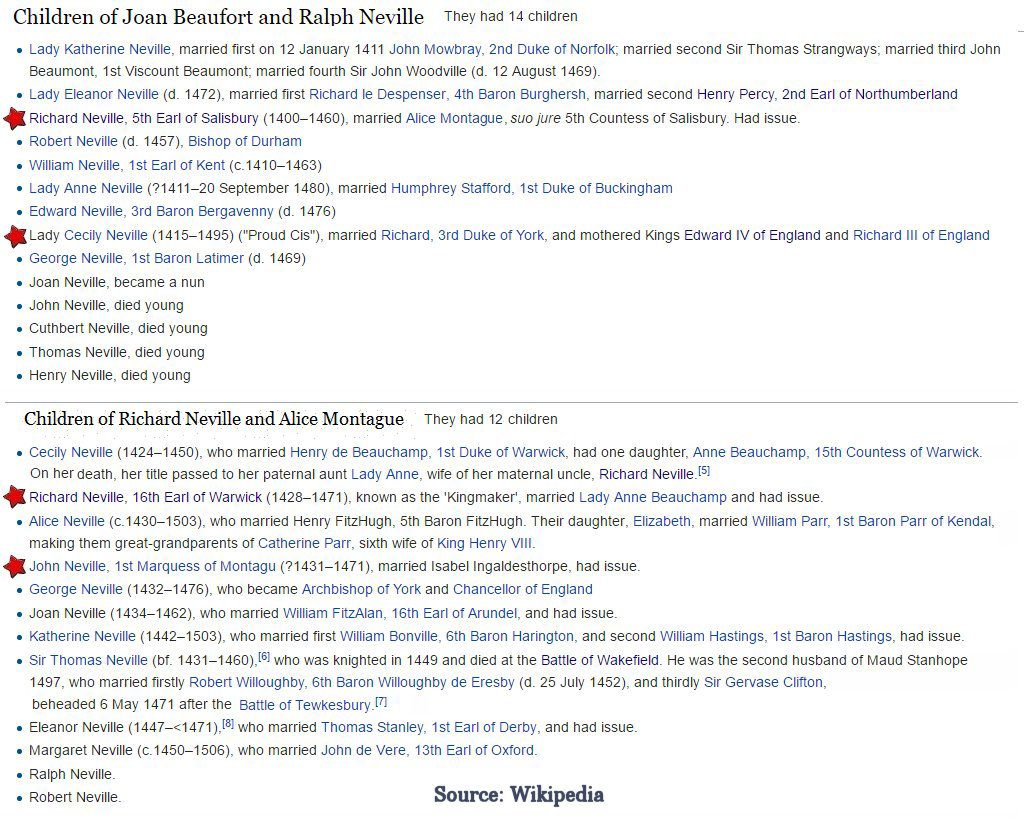 |
So far we have talked about
the Plantagenets, the Anjevins, the Lancasters, the
Beauforts, and the Yorks. Now it is time to
discuss the Nevilles.
Like everyone else in this story, John of Gaunt is
somewhere in the background of the House of
Neville. However, so is
Joan Beaufort. The House of Beaufort
will soon figure prominently in our story.
In
particular, Richard Neville, or 'Warwick' as
he was known, intermingled with the family of
Richard, Duke of York. For starters, Warwick's
Aunt, Cecily Neville, was Richard of York's wife.
Warwick
had two daughters. Isabella Neville married
George, son of Richard of York. Anne Neville
married Edward, Prince of Wales, but then later
married Richard III, son of Richard of York.
|
 |
Cecily Neville and
Richard of York
Cecily
Neville married Richard of York in 1429. Oddly
enough, they grew up together in the same household.
Richard's mother, Anne Mortimer, died giving birth
to him. Richard's father, the Earl of
Cambridge, was beheaded in 1415 for his part in the
Southampton Plot against the Lancastrian King Henry
V. Although the Earl's title was forfeited, he
was not 'attainted'. The four-year-old
orphan Richard became his father's heir.
Within a few months of his father's death, Richard's
childless uncle, Edward of Norwich, 2nd Duke of
York, was slain at the Battle of Agincourt on 25
October 1415. King Henry V allowed Richard to
inherit his uncle's title and the lands of the Duchy
of York. The lesser title of the Earldom of
March also descended to him on the death of his
maternal uncle Edmund Mortimer, 5th Earl of March.
Here is
what is interesting. Richard of York may have
been an orphan, but he was also to become the
wealthiest and most powerful noble in England,
second only to the king himself.
As he was an orphan, Richard's income was managed by
the Crown. The Wardship of such an orphan was
therefore a valuable gift of the crown. In
October 1417 this was granted to Ralph Neville, 1st
Earl of Westmorland, who adopted Richard probably
because Ralph Neville didn't have enough children of
his own. Mind you, I am telling a little joke
here. Ralph Neville had a problem... he had
lots of daughters and needed some suitable husbands
for them. Neville had fathered an enormous
family (twenty-three children, twenty of whom
survived infancy, through two wives). With so
many daughters needing husbands, Ralph Neville
basically went out and bought one for Cecily.
As was
his right, in 1424 Ralph Neville betrothed the
13-year-old Richard to his daughter Cecily Neville,
then aged 9. This was a bit on the weird side
since Cecily was growing up right beside Richard.
This was like Greg marrying Marcia on the
Brady Bunch. However, they obviously
overcame any reticence. Cecily and Richard
would have 13 children. Like I said, those
Neville girls knew how to reproduce.
The major point is that Richard of York grew up as a
Neville and maintained close ties with the family
throughout his life. Richard's wife Cecily was
a Neville and Richard Neville, Earl of Warwick, i.e.
The Kingmaker, was his closest advisor.
|
| |
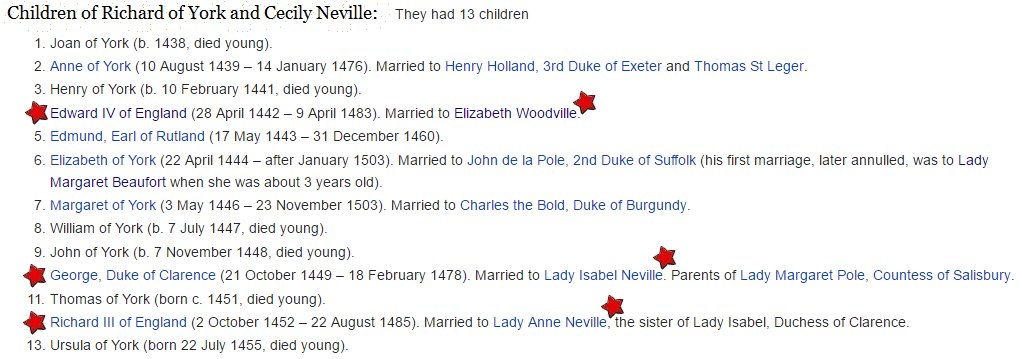 |
| |
|
|
|
Elizabeth Woodville
|
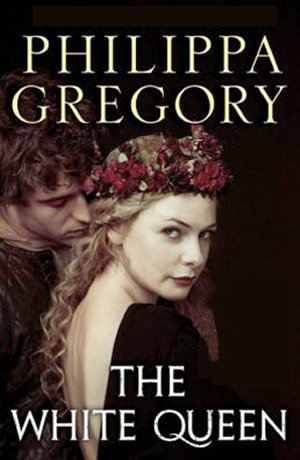 |
While the thirty year War of the Roses was
quite the bloody matter, it had the redeeming
quality of being centered around a very curious
romance. Believe it or not, Edward had
the nerve to marry an upstart. And get this...
Edward did for it love. Can you imagine that?
The
scandal was unbelievable. No one married for
love back in Old England. Strangely enough,
Edward's decision was so upsetting that it would
create Chapter Two of the War of the Roses.
Richard Neville, Earl of
Warwick, 'The Kingmaker', was the man who had
put Edward IV on the throne. Warwick and
Richard of York saw eye to eye on many things.
After Richard of York died at Wakefield, Edward IV,
depended greatly on the patronage of Warwick for
advice, for fighting men, and for political
influence.
Edward was 19 when he became
king and Warwick was 33. One can imagine
Warwick's relationship with Edward was that of an
older brother and a mentor. At this point, Earl of Warwick saw
himself as Edward's closest confidant and the power behind the throne.
One can also imagine that Warwick believed that
Edward 'owed him' for making him King in
1461. Three years had passed. At the
moment, Warwick was in France pursuing a suitable political
marriage on behalf of Edward.
Warwick had made preliminary
arrangements with King Louis XI of France.
Edward would either marry either Louis' daughter
Anne or his sister-in-law Bona of Savoy. Warwick
had done a good job... he
had the daughter of the King of France lined up.
Not bad.
But then Edward went and botched everything up.
Ordinarily an English King marries a suitable girl.
Then if by chance he met a hottie in the woods, he has the sense to
take the young lady to a convenient
cottage somewhere. That is exactly what Edward had in mind when
one day he just happened to meet
Elizabeth Woodville in the forest of all places.
Their meeting reads like a Fairy Tale. The
only way to make it any better would be to name the
forest 'Woodville' as well.
|
| |
|
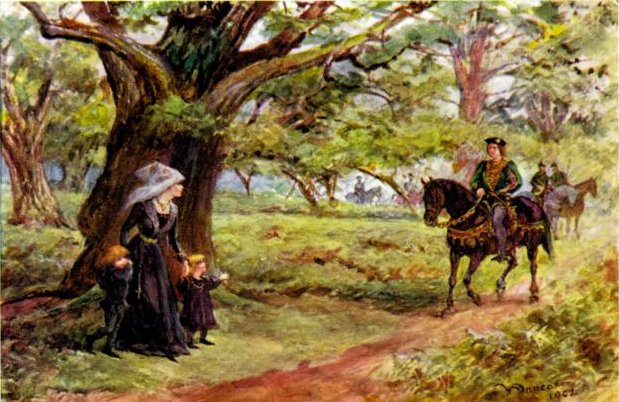 |
Who was
Elizabeth Woodville and what she doing here in
Woodville? Elizabeth was an impoverished widow with
two hungry sons to feed. In 1452 Elizabeth
had married Sir John Grey. John Grey was a
supporter of the Lancastrian cause who died fighting
at the Second Battle of St Albans in 1461 against
Edward, Duke of York.
Disastrously for Elizabeth, after Grey's death, her
mother-in-law refused to pay her dower from the
family estate. Only the king himself would be
able to enforce her rights.
As the
wife of a leader on the losing side, Elizabeth
Woodville was now a penniless outcast without an
estate. She was forced to return to
live with her parents in Grafton.
Three
years had passed since her husband's death.
One day in 1464, Elizabeth learned that Edward
was in the area to recruit new men for his army.
Even better, the king was hunting in a forest near Grafton. Elizabeth
deliberately
hid behind a tree and stepped out onto
the road with her two boys as young King Edward
passed by on his horse.
|
| |
|
 |
Edward was a known ladies man with a different
mistress stashed in virtually every shire of the
Kingdom. Noticing that Elizabeth was unusually
beautiful, the king stopped.
Edward climbed off his horse and began to chat.
Elizabeth used her opportunity to plead for the
return of her husband's estates. Edward
was smitten. He immediately suggested they
meet at a nearby cottage to further discuss the matter
of Elizabeth's lost estate, but
Elizabeth turned him down. Edward, a notorious
womanizer, was unaccustomed to rejection. He
continued to pursue Elizabeth and she continued to
keep him at arm's length.
Elizabeth may have been a commoner, but she knew how
to use her uncommon beauty to great effect.
Edward became very intrigued. Here
was a woman who had so much to lose if he failed to
grant her wishes. She maintained her virtue
nonetheless. Edward
began to admire Elizabeth not just for her beauty,
but for her determined refusal to be his mistress.
Finally
Edward couldn't take it any more. Edward was
full of desire for this fetching woman.
Elizabeth not only had the beauty he desired in a
wife, she possessed a strong, virtuous character.
Edward proposed and the two of them had a secret
marriage.
Soon
after, King Edward IV,
England's most eligible bachelor, shocked the nation
when he announced he had taken a
bride. Elizabeth Woodville, the impoverished
widow with two young sons, was the new Queen of
England.
|
| |
|
Angry Reaction
to the Edward's Surprise Marriage
|
|
|
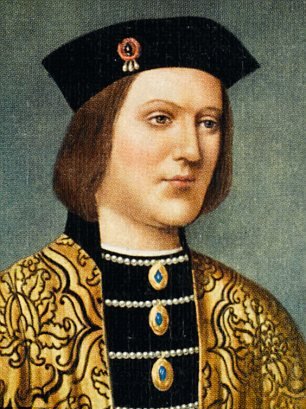 |
The
wealthy elite of England were aghast. The
match was badly received by the Privy Council.
"Surely, Edward, you must have known that this is
no wife for a prince such as yourself."
Yes,
Edward knew full well that he was in trouble.
He had knowingly backed out of an arranged marriage
without consulting Warwick, the man who had gone to
considerable trouble to arrange a suitable marriage
for Edward. Warwick was furious about Edward's
surprise marriage. Edward had
gone and done something stupid without even speaking
to him. Warwick was the one who would have to
apologize to the King of France. Warwick felt humiliated and
betrayed. After all he had done to help
Edward, he expected to see some respect and maybe
even a little gratitude.
Margaret
of Anjou was disgusted.
Margaret was
still determined to win
back her son's inheritance.
After the Battle of Towton, she fled with
her son
and husband to Scotland
and then on to France.
From there, Margaret fumed. As soon as Edward
had a male heir, it was all over for her son.
Edward's mother Cecily
Neville was unusually bitter at her oldest son. Cecily Neville was at
the very top of the social scale in late medieval
England, and held the highest status any woman could
enjoy. Cecily felt both Elizabeth and the
entire Woodville family were social upstarts
"I
think of this commoner
strumpet waiting for the King of England
under an oak tree, as if she just happened to be
by the roadside, a hedge-witch casting her
spells on a gullible fool
such as yourself. I did not raise you to
fall for the
amorous glance of a
slut strutting her well-worn wares
in the forest."
|
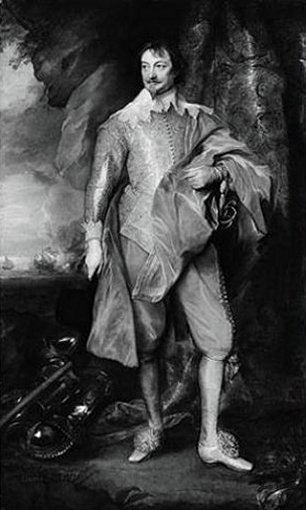 |
The Kingmaker
Warwick
became the central figure in the Second Chapter of
the War of the Roses. He bore a grudge towards
Edward that simply grew worse. In a sense, he
possessed the same burning ambition as his deceased
ally Richard of York. Warwick knew he could
not be king, but he was willing to settle for being
the man who decided who would be the king. And
for that matter, Warwick was determined to make one
of the two daughters, Isabella and Anne, the next
Queen.
Edward's
marriage to Elizabeth initiated the rift in 1464.
The animosity between the two men widened year by
year. Warwick was angry about everything to do
with Edward. And he hated Elizabeth just as
much. Elizabeth considered Warwick dangerous
to the extreme.
Elizabeth was right, but her husband constantly
sought to appease his former mentor. It did
not good. Warwick did not approve of anything
Elizabeth did. With the arrival on the scene
of the new queen came many of her relatives.
Elizabeth's twelve unmarried siblings suddenly
became very desirable matrimonial catches.
Warwick watched with disdain as Elizabeth's marriage
greatly enriched her siblings and children.
Some were appointed to royal offices, some married
into the most notable families in England, some did
both.
The
major reason for Warwick's hostility was his
increasing loss of political influence. These
people were upstarts, pretenders. These people were
getting in his way. Warwick's animosity grew
as the Woodvilles opposed policies favored by
Warwick. Seeing the upstarts successfully
exploit their influence with the king to defeat him
grated at Warwick no end. Warwick refused to
let his alliances with the most senior figures in
the English Council and the divided royal family be
compromised. When Elizabeth Woodville's
relatives, especially her brother Anthony Woodville,
2nd Earl Rivers, began to challenge Warwick's
pre-eminence in English society and political
circles, Warwick decided he had to do something.
Three
years had passed since Edward's marriage to
Elizabeth. During this time, Warwick had
become progressively more alienated from King
Edward. Now his intentions turned toward
treason.
|
Games of
Thrones Revisited
Rick's Note: Let's put our story on pause
for a moment while I remind everyone that
there are entire websites devoted to
comparing the real life characters in the
War of Roses to George RR Martin's fictional
Game of Thrones characters.
Margaret of Anjou is Cersei. Richard
of York is Ned Stark. Ned Stark had
his head on a pike. So did Richard of
York.
Lord Walder Frey is the equivalent of
Warwick. Lord Frey supported Robb
Stark’s military action by letting Robb's army
cross the bridge. However, Lord Frey
expected compensation for his indispensable
support. Robb Stark promised to
marry his daughter. When Robb Stark
reneged to marry for love, Walder Frey
arranged the infamous Red Wedding.
Game of Thrones is not a direct parallel of
War of the Roses. But there are times
when the similarities are uncanny.
Given my fascination with Game of
Thrones, it is easy to understand why
I am just as fascinated by the War of the
Roses. Look what ambition does to
people.
|

Click the picture or this link
War of Roses-Game of Thrones
to view a fabulous video which explains the
War of Roses in 6 minutes. You will
understand the whole story so much more
clearly.
|
|
 |
| |
Treachery
Warwick
bore a grudge towards Edward that had become
intolerable. Years of hostility and a battle
of wills had turned into open discord between King
Edward and Warwick. Warwick decided to switch
his allegiance to the Lancastrian cause. If a
Kingmaker can make a King, then a Kingmaker can
unmake a King.
In the
autumn of 1467, Warwick withdrew from the court to
his Yorkshire estates. Now out of sight,
Warwick covertly instigated a rebellion against the
king with the aid of Edward's disaffected younger
brother George, Duke of Clarence, as well as
encouragement from
Edward's bitter mother, Cecily. Keeping in
mind that Cecily Neville was Warwick's niece,
Warwick had little trouble gaining her support.
Cecily
had never forgiven Edward for marrying such a
low-life.
From the start, Cecily had refused to subordinate
herself to the new queen, styling herself as the
true Queen, or 'Queen
by right' as she put it. Cecily had never
quite gotten over the fact that she would have been
the queen had Richard of York not been murdered.
Now her son Edward expected Cecily to show respect
to this low-born woman. Cecily would have
nothing of it. This Elizabeth woman was
beneath her, so how could her son ever expect her to
bow to such a woman who was beneath her?
Edward
could see there was no love lost between Cecily and
her daughter-in-law Elizabeth. To lessen
tensions at court, Edward IV had new Queen’s
chambers built at Westminster for Elizabeth just so
Cecily could remain in her old chambers. He
had tried to mollify his mother, but it did no good.
Cecily had left for good in a show of disgust. She had
a meeting with Warwick to attend.
|
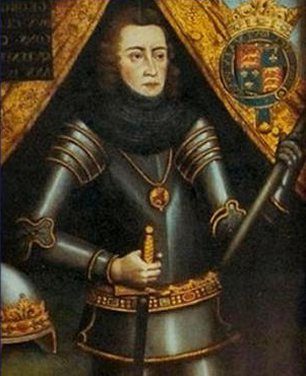 |
George
Plantagenet, Brother of Edward
If
someone was looking for a part to play in this
ongoing drama, George Plantagenet was one role to
avoid for sure. First a loser, then a winner,
then a loser again, this guy would eventually suffer a miserable
fate. The poor guy couldn't even get a decent
picture drawn.
George,
born 1449, was the middle brother between Edward,
born 1442 and Richard, born 1452. When Edward
became king, he treated both of his brothers well.
The new king was generous to his two younger
brothers. George, 11, was made the Duke of
Clarence in 1461 and the younger, Richard, 8, became
the Duke of Gloucester. From this point
forward, George became better known as 'Clarence'.
There
must be something very seductive about the idea of
becoming king. Rather than settle for the good
life he had, George was ambitious to become king
himself. Consequently George was easy prey for
the Kingmaker's promises in 1469. Not only could
George marry his daughter Isabel, Warwick would make
George the next King. How could George refuse
an offer like that? So what if his
generous brother Edward had to go? Tough luck,
bro. George allowed himself to be used
like a pawn in the ugly power struggle
between Warwick and King Edward.
|
| |
Meanwhile, Back at
the Ranch...
This excerpt
from the White Queen written by
best-selling author Philippa Gregory. Here Edward
is speaking to his wife
Elizabeth about rumors of Warwick's plot.
‘But now I have to go north and deal with this,’
Edward complains to me.
‘There are new rebellions
coming up like springs in a flood. I thought it was
one discontented squire but the whole of the north
seems to be taking up arms again. It is Warwick, it
must be Warwick, though he has said not a word to
me. But I asked him to come to me; and he has not
come. I thought that was odd – but I knew he was
angry with me – and now this very day I hear that he
and George have taken ship. They have gone to Calais
together.
God damn them, Elizabeth, I have been a
trusting fool. Warwick has fled from England, George
with him, they have gone to the strongest English
garrison, they are inseparable, and all the men who
say they are out for Robin of Redesdale are really
paid servants of George or Warwick.’
Elizabeth thinks to herself, 'I am aghast.
Suddenly the kingdom which had seemed quiet in our
hands is falling apart.'
"It must be Warwick's plan to use all
the tricks against me that he and I used
against Henry."
Edward hesitates, then begins thinking
aloud.
"He is backing George now, as he once
backed me. If he goes on with this, if
he uses the fortress of Calais as his
jumping point to invade England, it will
be a brothers' war as it once was a
cousins' war. This is damnable,
Elizabeth. And this is the man I thought
of as my brother. Warwick is my kinsman
and my first ally. For God's sakes, this
was my greatest friend. And now he has
turned on me! And turned my brother as
well. And now I hear even my
mother. My God, my own mother."
Philippa Gregory, The White Queen
|
| |
The Curious Blaybourne Allegation
| |
|
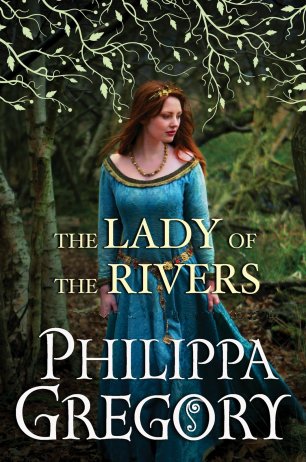

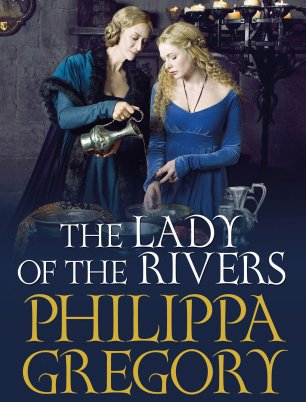 |
The following remarkable conversation takes
place in 1464 shortly after Edward has
finally revealed his secret marriage to his
mother Cecily Neville. This excerpt
was written by Philippa Gregory in her
best-selling novel The White Queen.
Jacquetta Woodville is known as the
Lady of the Rivers due to her
unusual gifts of second sight. She is
rumored to have remarkable powers of
divination. Cecily Neville is well
aware that the Woodvilles are Lancasters.
Not only that, Jacquetta became a close
confidante of none other than Margaret of
Anjou, the virago Queen herself, long before
all the fuss started.
As we know, the Duchess of York absolutely
hit the roof upon discovery of the marriage.
To her, Elizabeth is the enemy.
Desperate to calm his mother, Edward asked
Jacquetta to meet with Cecily, the Duchess,
and attempt to restore peace in the family.
Jacquetta is not welcome here. No
doubt it is Jacquetta's relationship with
Margaret of Anjou, sworn enemy of the
Neville family, that has raised Cecily
Neville's darkest suspicions about Elizabeth
Woodville. Furthermore, Jacquetta was
the only person in attendance at the secret
wedding of Edward and Elizabeth besides the
priest. It is upon Jacquetta's word
that Cecily Neville has to believe the
wedding even took place.
In attendance during this tension-filled
meeting are several of Cecily's daughters
including Margaret of York as well several
of Jacquetta's daughters including Anne
Woodville.
Anne Woodville, Jacquetta's second daughter,
narrates the story here.
Cecily Neville, Duchess of York, is
speaking to Jacquetta and the various
daughters in the room.
"Nonetheless, Elizabeth was not my
choice, nor the choice of Lord
Warwick."
Her Grace is upset, her voice
trembling with anger.
"It would mean nothing if Edward
were not king. I might overlook it
if he were a third or fourth son to
throw himself away..."
My mother (Jacquetta) replies,
"Perhaps you might. But it does not
concern us. King Edward is the king.
The king is the king. God knows, he
had fought enough battles to prove
his claim."
Cecily Neville retorts,
"I could prevent Edward from being
king," Cecily rushes in, temper
getting the better of her. "I could
disown him, I could deny him, I
could put George on the throne in
his place.
How would you like that as the
outcome of your so-called private
wedding, Lady Rivers?"
The duchess' ladies blanch and sway back
in horror. Margaret (Margaret of
York) who adores her brother Edward,
whispers, "Mother!" but dares say no
more.
Edward has never been their mother's
favorite. George, Edward's younger
brother, is his mother's darling, the
pet of the family. Richard, the
youngest of all, is the dark-haired runt
of the litter. It is incredible
that the Duchess speaks of putting one
son before another, out of order.
"How?" my mother says sharply,
calling the Duchess' bluff. "How
would you overthrow your own son?"
The Duchess replies,
"If he was not my husband's
child..."
"Mother!" Margaret wails.
"And how could that be?" demands my
mother, as sweet as poison.
"Would you call your own son a
bastard? Would you name yourself a
whore? Just for spite, just to throw
us down, would you destroy your own
reputation and put cuckold's horns
on your own dead husband? When they
put Richard's head on the gates of
York, they put a paper crown on him
to make mock. That would be nothing
compared to putting cuckold's horns
on him now. Would you dishonor your
husband? Would you dishonor your own
name? Would you dare shame your
husband worse than his enemies did?"
There is a little scream from the women,
and poor Margaret staggers as if to
faint. My sisters and I are half-fish,
not girls. We just goggle at our mother
and the king's mother go head to head.
It is like a pair of slugging battle-axe
men in the jousting ring, each saying
the unthinkable.
"There are many who would believe
me," the king's mother threatens.
Mother stares at the Duchess with
contempt.
"More
shame to you then,"
my mother says roundly.
"The rumors
about Edward's
fathering reached England.
Indeed.
I
was among the few who swore that a
lady of your house would never stoop
so low. But
I heard, we all heard, gossip of an
archer named – what was it –’
my mother
pretends to forget and taps her
forehead. ‘Ah, I have it: Blaybourne.
An archer named Blaybourne, who was
supposed to be your amour.
But
I said, and even Queen Margaret
d’Anjou, sworn
enemy of your husband, said
that a great lady like you would not
so demean herself as to lie with a
common archer and slip his
bastard into a nobleman’s cradle."
The name 'Blaybourne'
drops into the room with a thud like
a cannonball. You can almost hear it
roll to a standstill. My
mother is afraid of nothing.
Mother is not through yet.
‘And anyway, if you can make the
lords throw down King Edward, who is
going to support your new King
George? Could you
trust his brother Richard not to
have his own try at the throne in
his turn? Would
your kinsman Lord Warwick,
your great friend, not want the
throne on his own account?
Philippa Gregory, The White Queen
|
| |
|
Now we
fast-forward five years. It is 1469 and
Warwick is planning a revolt.
Warwick's
plan is to unseat Edward IV and replace him with
George, Duke of Clarence. Warwick thought it
useful to undermine Edward's legitimacy prior to
launching the battle campaign by spreading an ugly
rumor. Mind you, Cecily Neville, 54,
was Warwick's aunt and George's mother. One
has to assume that Warwick and George would not act
without her permission.
In 1469
both Warwick and George
began
to spread rumors that the king was a bastard.
People were asked to believe that his true father was not
Richard, Duke of York, but
rather an obscure archer named Blaybourne.
(Those Archers have always caused trouble!)
With Warwick pushing for the crown to
pass to her second son, George, Duke of Clarence,
there is evidence that Cecily cooperated with
the public shaming of her son. Although
Cecily said little about the matter in public,
she didn't deny it either.
After
all, this was a woman who lived for her high status
in the Royal Court.
This was not exactly the kind of information one
typically uses to advance their social standing in snooty circles...
'Hey,
girls, wanna hear some juicy gossip? Guess
what? I fucked some archer kid back in
1442 and got knocked up! Blimey,
we've got a bastard for a king! If that
doesn't beat everything...'
One
would assume a woman of Cecily Neville's importance would have
spoken up after being accused of adultery.
Instead... silence.
That speaks
volumes without saying a word.
So was
the Blaybourne rumor true or not? There are
four pieces
of circumstantial evidence to support the claim.
•
During
the critical time needed for
Edward's conception his father Richard,
Duke of York, was away
from his home base in Rouen,
France, for a period of five weeks.
He was busy
overseeing the Siege of Pontoise over a hundred miles
away, a distance which necessitated several days of marching.
In his absence, his wife
Cecily was (allegedly) having an
adulterous fling with an archer by the name of Blaybourne.
•
Further
evidence reveals that Edward's
ho-hum baptism
ceremony was held in a
side chapel in stark contrast to
the glorious baptism
of his next brother, Edmund.
•
Cecily Neville did not publicly recant.
•
Oh,
one more thing, Edward was tall and fair
and did not look
a bit like his
father, short and dark.
So was
Edward illegitimate? Maybe. Maybe
not. 650 years after the fact there are
lengthy blogs all over the Internet written by
people who claim to know the truth. Each
person offers compelling reasons why they are right
and why the next guy or gal is wrong.
If the
allegation was true, the assumption would
have meant that George was
the rightful king. Therefore
Warwick was using this as his rationale to put the
rightful king on the throne. Oh, how noble of
Warwick to spare England the shame of yet another illegitimate
king!!
What makes
all of this so hypocritical is that William the
Conqueror was illegitimate. No one
questioned his right to rule, so why should it
matter in the case of Edward? After all,
Edward's father never said a word. No doubt
Richard was able to count the weeks as well as
anyone. If anyone
should be upset, it should have been him.
Therefore, what difference did it make?
Here are
the facts.
Richard of York
loved his son Edward and the feeling was mutual.
Edward risked his
life in battle after battle trying to make his
father the next king. When Richard
fell, it was Edward who vowed to avenge his father.
Edward won the brutal Battle of Towton, the most
horrible skirmish in English history, despite being
badly outnumbered. It takes considerable guts
to stand up and fight against larger forces.
28,000 men died and now suddenly people are supposed
to care who his mother slept with? If
anything, the entire nation should have been up in
arms against his mother. This was her doing,
not Edward's. I guess one
has to be British to understand.
Why would
Cecily and Warwick stoop so low? Oh, forget
about Warwick. He had no more scruples than a
shyster lawyer.
To me, the
real story here is that Edward's mother would
cooperate with this mockery. Even if this
story was true, what did Edward ever do to his
mother to deserve her treachery? Okay, so Edward
married a sexy wood nymph instead of a proper French girl with a pedigree and a
big dowry. Get
over it!!
A normal mother would
have been proud out of her mind. Not Cecily.
Cecily allowed her contempt to dominate her sense of
decency.
Look at
Edward... a courageous man who had fought bravely to
become the King of England!!!! Whether
Edward was legitimate or illegitimate, for God's
sakes, why would a mother hurt her son like this?
Even if Edward was illegitimate, it wasn't his
fault. Cecily had abandoned her son.
What in the hell was wrong with
this woman?
|
 |
In 1469,
with his influence at
the
English court waning,
Warwick had
won over Edward's brother George. With full
approval of Warwick's aunt Cecily Neville, Warwick
pledged his daughter Isabel in matrimony and
promised to install George as the next king with
Isabel as queen. The nineteen-year-old George
had shown himself to share many of the abilities of
his older brother, but was also jealous and
overambitious. In July 1469, the two sailed
over to Calais where George was married to Isabel.
From there they returned to England, where they
gathered the men of Kent to join the rebellion in
the north.
Edward had taken his eye
off the ball. The main part of the King's army
(without Edward) was defeated at the Battle of Edgecote Moor on 26 July 1469. This defeat
would not have been decisive if Edward himself had
remained at liberty, but he walked right into a
trap. Heading north to meet up with his
retreating army, Archbishop Neville, brother to
Warwick, had been lying
in wait. Edward was subsequently captured at
Olney. Although treated with formal respect,
Edward was nonetheless imprisoned.
Sad to say, Edward was largely to
blame for the humiliating debacle of July 1469. His
complacency shows that he underestimated the extent
to which he had lost popular sympathy. In addition,
he seemed unable to accept the extent of treachery
within his own family. Denial was the only possible
explanation for his hopeful loitering for three
weeks while the rebels organized.
His blunder into captivity further
underscored his lack of appreciation for the danger
he was in. Above all, Edward had failed to
appreciate just how little his government had
succeeded in winning popular support when faced with
a rival of Warwick's considerable reputation.
However, strangely enough, Warwick
was unable to exploit his stunning victory. He
found himself politically isolated. The English
Council refused to cooperate. Warwick needed more
backing for his illegal usurpation,
especially he intended to shove George,
Duke of Clarence, down their throats.
The people of London took Warwick's
triumph as a license for violence. They began to
riot and pillage. There
were local revolts throughout the land when some of
the nobility seized the chance to settle their
private quarrels without interference from the
government. To his
dismay, Warwick discovered he could get no response
to his proclamations calling for troops as long as
the people believed the
king was a prisoner. Warwick shrugged his shoulders
in bewilderment and
resignation. The people of
England had spoken. Only the moral authority
of the king could command their
obedience.
In disgust, Warwick was forced
to release Edward on 10 September 1469.
By October Edward's power
was restored.
An
important lesson had been learned here. In
order to rule a Kingdom, even a powerful man like
Warwick could not succeed without the will of the
people. The coup d'état may have failed, but
this was a very close call.
One has to wonder.
Edward had been betrayed the man who had once been
like a father to him. He had been betrayed by
his brother. And he had been betrayed by his
own mother of all people.
Prior to reading this story,
the only place where people behaved this badly was
on the Game of Thrones. It is
shocking to discover what I thought was escapist
nonsense could be possible in the Real World.
|
| |
An Uneasy Peace
During Edward's capture, Elizabeth had been terrified
her husband would simply be murdered. Why Warwick didn't simply murder Edward is an
interesting question. Warwick was apparently
content with the overthrow of the Woodvilles.
Believing that he had secured Edward's submission,
perhaps Warwick . No doubt if Margaret of
Anjou had been involved, Edward would be dead now.
The one thing Elizabeth knew was that Edward would
never be safe as long as Warwick was around.
She was right.
Edward had been released
unharmed in October 1469. At this point,
Edward did not seek to destroy either Warwick or
Clarence. He allowed them to retain their
estates and sought reconciliation instead. In
retrospect, Edward should have listened to his wife
who had suggested destroying both of them for
treason.
Although the king
refrained from punishing the rebels,
he sought to reestablish a
northern counterweight to the Nevilles by restoring the
earldom of Northumberland to the dispossessed heir,
Henry Percy. This turned out to be a
fateful move because it meant depriving John Neville, who had
remained loyal to the king when his brothers rebelled,
of his title, lands and offices.
Edward sought to retain
John's allegiance by compensating him with estates in
the south-west, the new title of Marquess of Montagu,
and the betrothal of his young son George Neville to the
king's eldest daughter and current heir, Elizabeth of
York. George was made Duke of Bedford in recognition of
his future prospects. All this, however, evidently
failed to sufficiently mollify Montagu.
Soon after a private feud
broke out in Lincolnshire between Sir Thomas Burgh
of Gainesville and Lord Welles. Warwick saw
this as an opportunity to lure Edward up north into
a trap. In March 1470, Warwick and George
helped enflame this ongoing skirmish into a serious
problem. Now King Edward was certain to ride
up to the area and restore peace. Edward did
not suspect that Warwick and George would be waiting
for him. Their plan was to ambush Edward and
assassinate him during the ensuing battle, thereby
suffering the same fate as his father had at
Wakefield ten years earlier.
Warwick's plan had bad luck.
Sir Robert Welles, a co-conspirator, gave battle at
Losecoat Field prior to planned trap and was utterly
defeated. He was captured holding documents
that proved the complicity of Warwick and George.
Welles confessed his treason and named Warwick and
George as the 'partners and chief provokers'
of the rebellion. Welles was beheaded, but
Warwick and George were able to flee the country and
go to France.
Warwick was relentless.
He vowed to try again.
|
| |
The Unholy
Alliance
Now an
outlaw, Warwick turned
to Louis XI to see if the French king would help him
mount another rebellion.
Louis XI
had a suggestion for Warwick.
Why not go talk to
Margaret of Anjou??
Margaret
despised Warwick. They had been rivals for
twenty years. How could Margaret forget the
Second Battle of
St Albans? This was the day
she personally
defeated the Yorkist forces of Richard Neville, Earl
of Warwick. Her triumph
rescued her husband Henry
VI being held illegally by Warwick.
With
Louis XI acting as peacemaker, with some difficulty
Warwick showed rare humility and reconciled with
Margaret of Anjou. Both parties reached the
same conclusion... I don't like this person, but the
enemy of my main enemy is my friend.
In
return for the help of Margaret and Louis XI,
Warwick vowed to restore King Henry VI back to the
English throne. Warwick also agreed to marry
his second daughter Anne Neville, 14, to Margaret's
son Edward of Lancaster, 17, to seal the deal.
Louis
was so pleased, he offered to back the next
invasion. Warwick was heard to say, "Louis,
I think this is the start of a wonderful friendship."
Or was it someone else who said that?
|
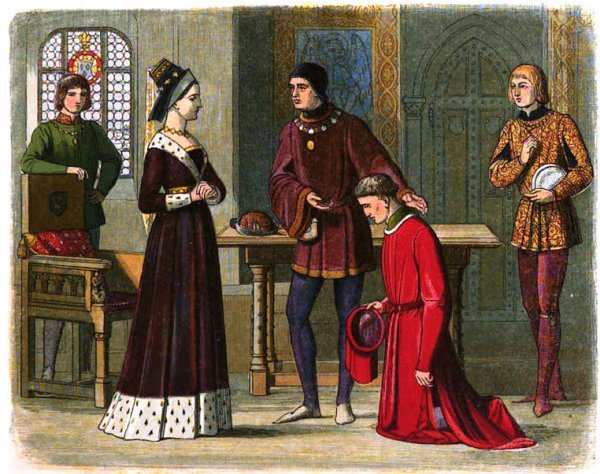 |
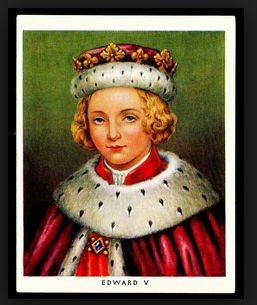 |
The Little Monster
Edward
of Lancaster or Edward of Westminster or Edward V,
whatever, was the only son of Margaret of Anjou.
If Margaret's counterpart on the Game of
Thrones is Cersei, can you guess who
Edward's counterpart on the show might be?
Think about it. I will answer in a moment.
As
presumptive heir to the throne, Edward was literally
Margaret's only reason to carry on. Margaret
had likely committed adultery to conceive him, she
had engaged in endless plots to restore his
birthright, and she now she had done the unthinkable
by accepting help from Warwick, the Devil himself.
Warwick was virtually Edward's last remaining hope
of becoming king of England.
Prince
Edward had been born right in the midst of Richard
of York's surge to power in 1453.
Consequently, Edward's entire life had operated as a
leitmotif for the War of Thrones, or Game of Wars,
whatever. Who could possibly count how many
men had already died so this little kid could keep
hoping to be king someday? Nor was it over.
It was now 1470 and Warwick planned to attack again.
|
|
|
Edward
is none other than Joffrey, definitely the most
hated character on the show (or at least he was
until Ramsey Bolton came along). There was an
incident in Season One where young Joffrey told a
horrible lie. This lie caused the death of an
innocent butcher boy as well as the execution of the
loyal direwolf that had protected Arya from being
stabbed by Joffrey's sword. Watching that
magnificent animal die broke my heart.
It turns
out that Edward was just as vile as his fictional
counterpart. Reports paint Edward of
Westminster as a bad seed, violent and obsessed with
war. There is a well-documented story
that took place at the 1461
Second Battle of
St Albans. In this battle,
Margaret clearly outfoxed Warwick and his brother
Montagu. Soundly beaten, Warwick and Montagu
had no choice but retreat. In the process,
Warwick left behind the bemused King Henry,
who had spent the battle
sitting under a tree, singing.
Two
Yorkists knights,
Lord Bonville and Sir Thomas Kyriell, had sworn to
let their prisoner come to
no harm during the battle.
Even now after the fighting had ended, they
remained beside him
to ensure a safe transfer.
King Henry had promised the two knights
immunity, but Margaret gainsaid him and ordered
their execution.
Margaret
wanted vengeance, so she put the men on trial at which her son presided.
"Fair son",
Margaret asked, "what death shall these
knights die?"
Despite
Henry's desperate
pleas for mercy, Prince
Edward, 8, replied that
their heads should be cut off.
The boy clapped
gleefully as the men suffered their cruel fate.
|
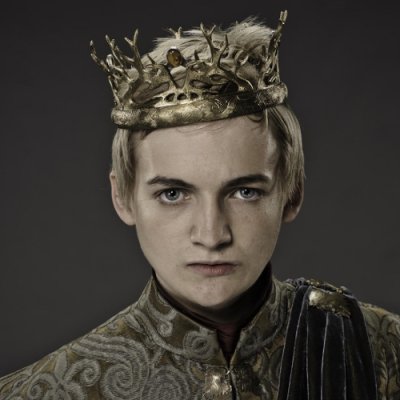 |
| |
|
There is
an interesting footnote to this story. As we
know, what goes around, comes around.
John Neville, aka Montagu,
was also captured
in this battle, but he had been spared
a similar execution.
It turned out he was saved by the Duke of
Somerset, Margaret's main
military advisor. Somerset feared that
his younger brother who was
currently in Yorkist hands might be executed
in reprisal.
Montagu
was forced to watch in horror as these two innocent
men were cruelly put to their death with Margaret
and Edward laughing in the background. This cruelty
left an indelible memory.
Two
years later, Montagu presided over the skirmish
known as the Battle of Hexham. Montagu was
handed thirty leading members of the Lancaster side
following the battle. Recalling Margaret's
vengeance, Montagu executed every one of the men
without hesitation.
|
| |
Third Time is the
Charm
Queen Margaret, our precious Queen
Margaret, in desperate exile in France, running out of money
and lost without soldiers, agreed to an alliance with the
snake Warwick, formerly her greatest
adversary. Amazingly, she let her precious son Edward,
Prince of Wales, marry Warwick’s younger daughter Anne.
The two parents agreed to invade England.
If they were successful, perhaps they could give the
newlyweds a bloodbath for a honeymoon
gift and put
Margaret's son and Warwick
daughter on the throne of England.
Warwick
was getting pretty good at this. First
Warwick staged an
uprising in the north to draw
Edward away from London. Then, with the King
totally fooled and headed north, Warwick and George
came in from behind. They landed at
Dartmouth and Plymouth on 13 September 1470,
picked up a large following in Kent, then headed to
London.
Among the many who flocked
to Warwick's side was his younger
brother John Neville,
known as Montagu.
Montagu had decided to betray Edward.
So what
was Montagu's beef? Montagu had been a
York loyalist for over ten years.
Montagu had fought with his father and brother
Thomas at the Battle of Blore Heath in 1459, and was
captured and imprisoned in Chester Castle by the
Lancastrians, for which he was attainted. That
problem was corrected a year later when John Neville
became Lord Montagu in 1460 thanks to Richard of
York's return to England. Montagu was captured
again at the Second Battle of St Albans in 1461.
Following his second release from imprisonment, he
led the Yorkist forces in the north of England,
defeating the Lancastrians at Hedgeley Moor and
again at Hexham (both 1464).
In reward for driving out the Lancastrians, in 1464,
King Edward IV made Montagu the Earl of
Northumberland, a title which had long been held by
the disgraced Percy family. Montagu was
awarded the Percy estates confiscated after the
Battle of Towton.
However,
when Henry Percy was rehabilitated in 1470, Montagu
was forced to give up the earldom and many important
offices in favor of his former foe. Edward had
felt compelled to do this for fear that troops from
Northumberland would not be loyal. Percy would
keep them in line better Montagu. Montagu was
compensated with other territories, but without
suitable estates or income to support such a
dignity.
Montagu had not taken part
in Warwick's first or second
last rebellion. He
was disappointed when his loyalty to the king had
not been rewarded with the restoration of his
earldom in Norhumberland.
Once a
Neville, always a Neville. Besides, what has
Edward done for me lately? Unbeknownst
to Edward, John Neville, 1st Marquess of
Montagu, decided to switch
to the Lancastrian side.
This time the trap set for
the king worked.
Edward was completely caught out
of position. Once he learned of Warwick's
sneak attack in London, he hurried
back south.
Edward saw Montagu's forces
waiting for him on the road and
let down his guard. Montagu was on his side.
Or was he? Something about the way Montagu's
army approached tipped him
off. Edward realized he would soon be
surrounded. Realizing he
had been betrayed again and that Warwick's
brother Montagu was against him,
Edward headed for the
English Channel as fast as he could. On
2 October Edward fled to
the Netherlands.
The
story of Montagu is interesting because it shows
that Warwick and Edward were so evenly matched that
even one defection could alter the balance of power
in the flicker of a moment.
Back in
England, King
Henry, now 49, was
released from the Tower of London
and restored to the
throne. Henry VI was just as doddering as
ever. He had to be led by the hand when he
paraded through London. He was so frail in
body and feeble of mind, it is unlikely Henry even
knew he was king again. No
matter. Warwick got
what he wanted. Now for the second time, he
acted as the de facto ruler of England in his
capacity as Henry's
lieutenant. At
parliament in November, Warwick
made sure Edward was attainted of his lands
and titles.
The
rebellion had forced the King to flee the country.
Right now things were
looking pretty good for Warwick. George too.
For his loyalty, George
was awarded the Duchy of York.
George was the new Duke of York, just like his
father and brother had once been.
As
anyone who has watched the Game of Thrones
will tell you, treachery can be very profitable.
Apparently it works in reality too.
|
| |
 |
Charles the Bold
Charles
the Bold was the mortal enemy of Louis XI, King of
France. Charles held vast amounts of territory
in France, more even than Louis himself.
Charles
was offered the hand of Louis XI's daughter Anne.
The wife he ultimately chose, however, was his
second cousin Margaret of York, sister to Edward IV.
Charles did this in order to ally himself with
Burgundy's old ally England.
Louis XI
had a fit and tried to prevent the marriage with
Margaret. He demanded the Pope refuse to allow
the marriage (the pair were cousins in the 4th
degree), he promised trade favors to the English,
and he undermined Edward's credit with international
bankers to prevent him from paying Margaret's dowry.
Louis
even sent French ships to waylay Margaret as she
sailed to France. Too late. In 1468,
Edward and Charles became good friends as they
celebrated their new alliance over French wine.
|
 |
Return of the Jedi
After
being exiled from England, Edward landed in
Flanders, the southern part of Holland, in early October 1470.
He had few men and little money. Edward made
his way to see Charles of Burgundy, his
brother-in-law. Charles greeted him
warmly. Edward was also delighted to
be reunited with Margaret of York, his
favorite sister.
|
|
|
Although Charles
was glad to see Edward, at first he refused to
assist him. Margaret pled Edward's case
to her husband.
She pointed out that Edward's overthrow had considerably
lessened
Margaret's dynastic worth.
This, together with her
regard for her brother who
been cheated of his throne made her plead
passionately that Charles support Edward
and make measures to restore him. It
did no good. Charles held his ground and
paid little attention to
Margaret's begging.
Then
something curious happened. You know how I am
about 'Fate'. Edward
caught a huge break when Louis XI suddenly declared
war on Charles the Bold. After Warwick
completed his overthrow, he sent a message to Louis XI, King of France,
that he would send men to help Louis XI overthrow
Charles of Burgundy,
the hated enemy of Louis.
Louis was really excited. Maybe this overthrow
lightning could strike twice!
Charles was more irritated than threatened.
On a whim, he decided it was in his best
interests to oppose the Lancastrian rule of England,
backed as it was by this
pipsqueak Louis XI. Wouldn't it be fun to give
Warwick and Louis the lesson they deserved?
On
4 January 1471, Charles agreed to
help the
King-in-exile
regain the English throne.
At
last furnished with money, on
14 March 1471, Edward and his youngest brother
Richard landed with a small force at Ravenspur.
Doing their best to avoid detection, Edward first returned
to city of York. Suspicious, York opened its
gates to Edward only after he promised that he had
just come to reclaim his dukedom. This was
literally the same scenario as Henry Bolingbroke had
taken seventy years earlier. Lightning would
indeed strike twice, just not the lightning Louis XI
had hoped for.
Edward
was not about to settle for regaining the Duchy of
York. His ambitions were much larger. As
he marched to London over the next month, Edward
picked up support. The first to join him
were Sir James Harrington and William Parr, who
brought 600 men-at-arms to Edward at Doncaster.
Then someone unexpected joined him.
|
 |
| |
|
Coventry
On the
way from York to London, Edward decided to make a
detour to Coventry and challenge Warwick who was
encamped there. Although Warwick's force had
more men than Edward, the earl refused the
challenge. He was waiting for the arrival of
Edward's brother George in order to use their
combined strength to overwhelm the Yorkists.
When
Edward IV learned what Warwick was waiting for,
Edward sent his brother Richard to speak to George.
Six
months earlier,
Edward's brother
George had opposed him during Warwick's successful
third rebellion. After sending Edward fleeing
to France in exile, George was awarded the
Duchy of York for his loyalty,
making him the new Duke of York. Surely that
made George happy. But it didn't. George
was beset with guilt and misgivings.
Previously Warwick
had promised to rebel specifically to put
George on the throne. That failed. The second plot also had
George headed to the throne. That also failed.
Then the objective had changed for the third
rebellion.
George first realized something
was wrong when Warwick had his younger
daughter, Anne Neville, marry Henry VI's son
Edward
of Lancaster
in December 1470.
Currently feeble old Henry VI
was on the
throne, not George. When feeble old Henry did
finally bite the
dust, that would be Margaret's nasty son
Edward taking Henry's place, not George.
Now that George was out of the loop, he realized
Warwick could not have cared less about him.
George
was starting to catch on. George was married
to Isabel Neville and Edward, 17, was recently
married to Anne Neville. If his daughter Anne became Queen
instead of his daughter Isabel, either way Warwick got what he wanted...
one of his two daughters would be the next Queen and the Kingmaker would
be in control.
|
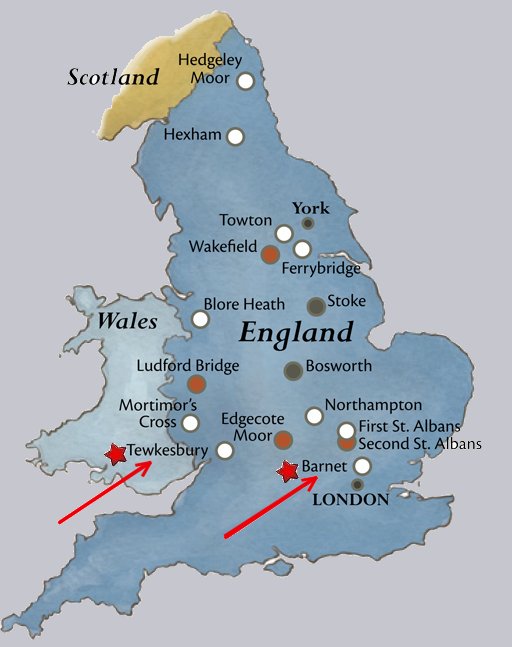 |
| |
|
At this
point, all Warwick wanted from George was more
fighting men. He
realized that his loyalty to
his father-in-law was misplaced.
Aware that his father-in-law was
a lot less interested in making
George
the king than in
serving his own interests,
George realized he had been played.
Meanwhile, Warwick was taking George for granted. Warwick assumed that
George would be satisfied to stay on the Lancaster team
because he was married to Isabel, Warwick's first
daughter, and because he had just been handed the
valuable Duchy of York. Furthermore, through
Isabel, George was currently co-heir to the vast Warwick
estate. Why would George jeopardize his
current land holdings, plus his future inheritance
from Warwick, the richest man in England?
Nevertheless, George felt cheated. There was
no way in hell Warwick would ever put him on the
throne. George had a startling realization...
his fortunes would be better off as brother to the
king than as a nobody under Henry VI and then
eventually Edward of
Lancaster, the new Prince of Wales.
Right
now his younger brother Richard had just asked to
speak to him. George knew what Richard wanted.
He suspected Richard had come to ask George to
return to the House of York. What should he
do? Shakespeare's 'false, fleeting,
perjured Clarence (George)', discontented to now
find himself fighting to maintain the Lancastrian
dynasty, wanted desperately to reinstate himself in
his brother Edward IV's favor. George deserted
his erstwhile ally Warwick, and rejoined his
brother's forces
Reconciled, the three royal brothers moved towards
Coventry. Now George urged Warwick to
surrender. Infuriated with his son-in-law's
treachery, Warwick refused to speak to George.
Edward
was not about to risk attacking Warwick with smaller
numbers, so he turned again towards London. Days
later, when Edward entered London unopposed, George
and Richard were at his side. The old king
greeted his usurper warmly and offered himself into
custody, saying that he trusted Edward. "My
life will be in no danger in Edward's hands."
And with
that, poor old King Henry VI was sent back to the
Tower of London.
|
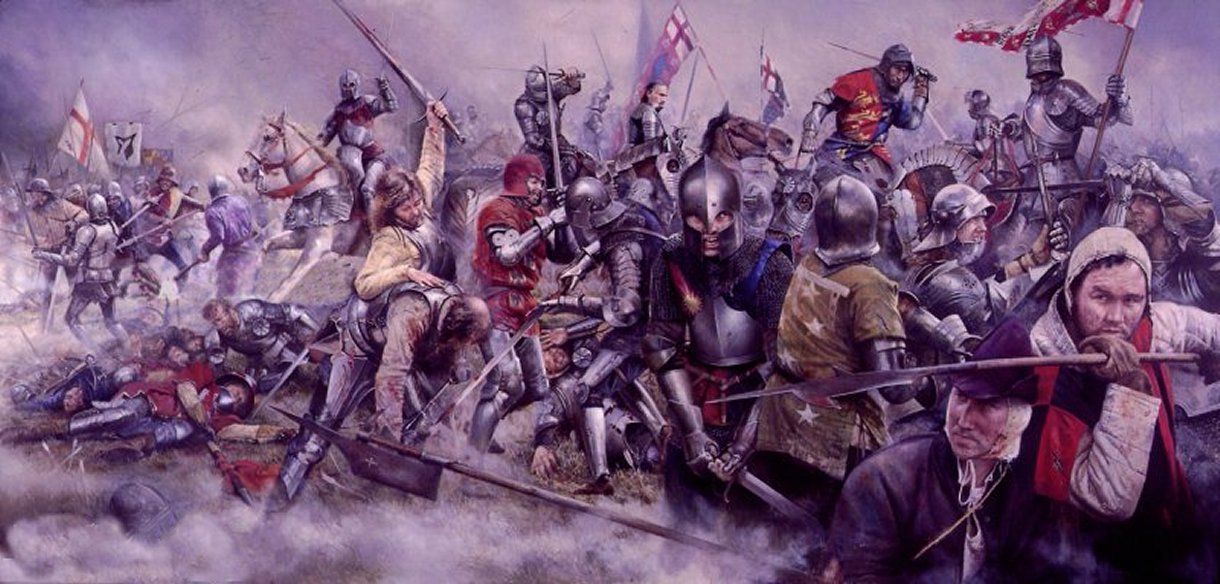
The Battle of Barnet
Warwick
was still fuming over George's last-minute defection
back his brother Edward. Was this a bad omen?
Montagu, Warwick's brother, had once been Edward's
best commander. It had been Montagu's
defection during Warwick's third rebellion that had
turned the tide against Edward in the first place.
Now George was defecting back to his brother's side.
Warwick
dismissed the thought. With George at his
side, Warwick's victory was a slam-dunk certainty.
However, even with the defection, Warwick knew
Edward faced long odds at Barnet, a small town about
12 miles northwest of London. Warwick's army
heavily outnumbered Edward's. Lancastrian
strength ranged around 15,000 men to 10,000 on the
Yorkist side. Furthermore, Warwick had the
advantage of choosing the battleground.
Warwick chose a valley with rolling hills on either
side. In so doing, Warwick wisely chose the
higher ground to the north.
Edward
hurried to meet the Lancastrians hoping to surprise
them. Warwick knew the enemy was near, but
since they arrived in the night was unsure of their
exact location. Edward deployed his trusted
friend Lord Hastings on the left and entrusted his
brother Richard (Gloucester) on the right flank.
Edward
asked George to fight at his side in the center.
He complimented George on his fighting ability as
the reason, but in truth it was easier to keep an
eye on their twice-defected prince there.
As night
fell, Edward put his plan for surprise morning
attack in motion. Under a strict order of silence,
the Yorkist army crept closer to the Lancastrians.
During the night, neither Warwick nor Edward spotted
the opposing army, an event that proved crucial in
the battle the next day.
|
 |
| |
|
During
the night, Montagu approached his brother Warwick to
advise him that he felt the troops were skittish.
Montagu suggested that, as the highest-ranking
commanders, he and his brother should fight on foot
throughout the battle instead of riding on horse.
Soldiers believed that mounted commanders tended to
abandon the men when the situation deteriorated.
By staying on foot, the two Nevilles would show
their men that they were prepared to fight to the
death, thus inspiring the troops to stand and fight
harder as well. Warwick agreed and told his aide to
go tether the horses to the rear near Wrotham Wood.
|
| |
|
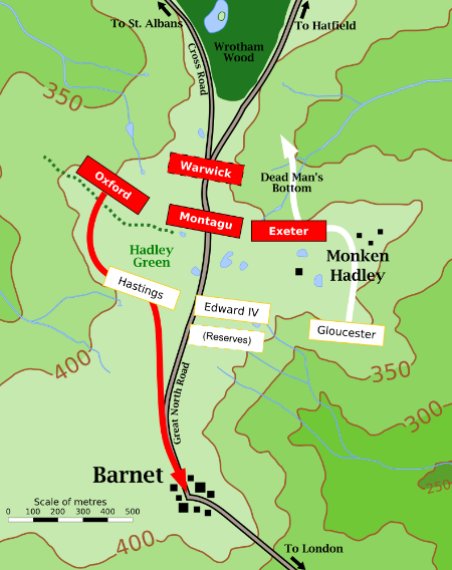 |
Offset Lines
Two key
things happened in the night.
Warwick
ordered his cannons to continually bombard the
estimated position of the Yorkists' encampment.
This gave Edward the advantage of guessing where the
enemy lie. The Yorkists were able to sneak in
so close that the Lancastrian artillery overshot
their enemies. Meanwhile the York side kept
their cannons quiet and lit no fires so as to avoid
betraying their location.
The
right wing of the Lancastrian army was commanded by
John de Vere, Earl of Oxford. Warwick and
Montagu would command the center which straddled the
road. The Lancastrian left wing was headed by
Henry Holland, Duke of Exeter.
Meanwhile, in the night,
Edward had his brother
Richard, the 18 year old
Duke of Gloucester,
extend his line hundreds
of yards too far to the East. Edward
was unaware that there was no enemy to his front,
just a muddy bog.
What
this meant was the opposing sides were not squared
up. On the western side, Lancaster's Lord
Oxford was up on a hill looking down at the left
flank of York's Lord Hastings. These uneven
lines would prove critical in determining the
outcome of tomorrow's battle.
As the
dawn gave light, the opposing sides realized they
were facing each other like a 3 on 3 basketball
game. Lord Oxford was on the hill opposite
Lord Hastings, the Neville brothers and the
Plantagenet brothers were in the center, but Richard
of Gloucester was way off to the right squared off
against a bog.
These
offset lines would create remarkable consequences
during the battle.
|
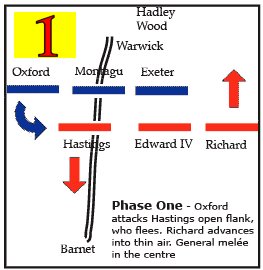 |
Phase One:
Lord Oxford of Lancaster has the
Upper Hand
|
|
|
|
|
The
moment John de Vere, Lord Oxford (Lancaster), discovered that he
was offset well to the outside of Lord Hastings
(York), he ordered his men to charge down the hill
before the York side could fully realign and defend
themselves properly.
In the
mist, Lord Hastings had no idea he was outflanked by
Oxford. His men were not expecting such a
strong force to attack them. Oxford's
group quickly overwhelmed the men under Lord
Hastings who were caught off guard.
Yorkist soldiers panicked and fled
towards Barnet, chased by the Lancastrians.
As it stood, some of the routed
Hastings' men were so certain of defeat that they
grabbed a horse and kept
fleeing all the way to London twelve miles away.
There they spread tales of the fall of York and a
Lancastrian victory.
The fog
would work a strange magic all day long. If
the skies had been clear, the battle would have
already been over. The horror of seeing
Edward's left line collapse would have caused the
rest of Edward's men to quit on the fight and run
for their lives. Instead, due to the fog,
visibility was low, so the two main forces failed to
notice Oxford's victory over Hastings. Unable
to see what was going on around them to the west,
the opposing center forces continued to fight.
Once
Oxford's group of men reached Barnet, they were now
an entire mile south of the main battle line.
Now this early success turned to disaster when
Oxford's forces began pillaging. Oxford's men lost interest in the battle and split off
in order to begin looting
the fallen enemies. Assuming the battle was
over, many of the men took the time to have a beer
in Barnet and celebrate their victory.
Lord
Oxford was furious at the lack of discipline.
Receiving word from Warwick that he was still
needed, Oxford began yelling and chasing after his men.
It took Oxford two hours to gather
800 men from the original 2,000 and lead them back
up to the battlefield. This unusual U-turn on
the part of Lord Oxford's men combined with the fog
and the offset lines would produce one of the
strangest outcomes ever seen on a battlefield.
|
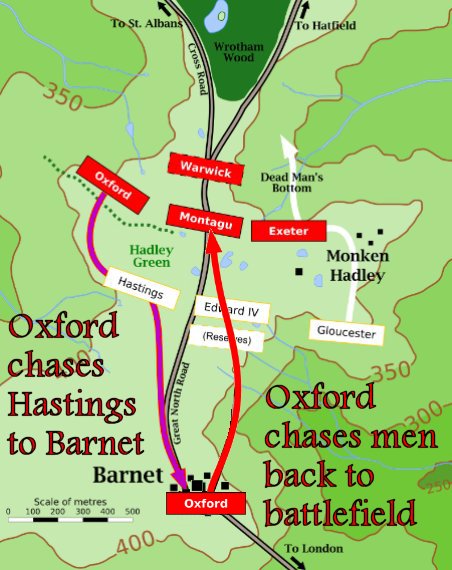 |
| |
|
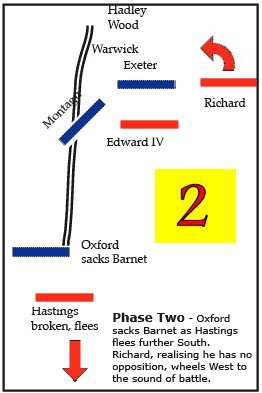 |
Phase Two: Where is the Enemy?
|
'Fog
of War' is a military term for the uncertainty
experienced by participants in military operations.
Medieval battles were notorious for confusion
because visibility and communication were often
limited.
In the
case of the Battle of Barnet, the Fog of War
took on a different meaning... the morning battlefield was totally
covered in thick mist and fog.
The fog created so much confusion that
the fighting would have appeared almost comical if
it weren't for the fact that brave men were dying on
this day.
|
 |
|
|
| |
|
At the
same time as Lord Oxford collapsed the left side of
Edward's line, over on the right, Richard, Duke of
Gloucester, discovered there was no one in front of
him. In the fog, he could not see the enemy in
front. Confused, Richard decided his best
option was to proceed forward and look for Lord
Exeter's forces.
And why
was there no one in front of Richard? On the
previous day, Warwick had the luxury of setting his
positions using the light of the day. Seeing
the swampy ground, Warwick correctly assumed no one
would be stupid enough to attack through the
wetlands. Any attack would be easily repelled
because the mud would bog down the enemy's momentum.
Warwick was pleased... this swamp would guard his
left flank for sure!
While
Oxford's men were busy in town having a beer,
Richard was moving cautiously over on the right near
the Hadley Woods. Although Richard saw the
ground was lowering, he continued forward.
When his men reached the boggy ground, Richard still
could not see the enemy, but he was close enough
that he could hear the sound of battle to the west.
Richard
suddenly realized the fog had given him a huge
advantage. His men could now attack Exeter
from the side coming out of the fog to surprise
them. Richard put his finger to his lips and
whispered... "Silence!"
The men
slowly crossed the boggy ground like invisible
ghosts. They used the sound of the clashing
steel to guide them. Richard's men finally
spotted Lord Exeter's Lancaster men at the edge of a
muddy bog known as Dead Man's Bottom.
For the
past hour, some of Exeter's men had helped fight in
the center, but the majority just stood there
looking for someone to fight. Incredibly,
because their enemy had lined up so far to the
right, the Lancaster wing had no idea Richard's men
were approaching. Suddenly out of the gloom
came 2,000 screaming maniacs running right at them!
The Lancaster men were terrified out of their minds.
|
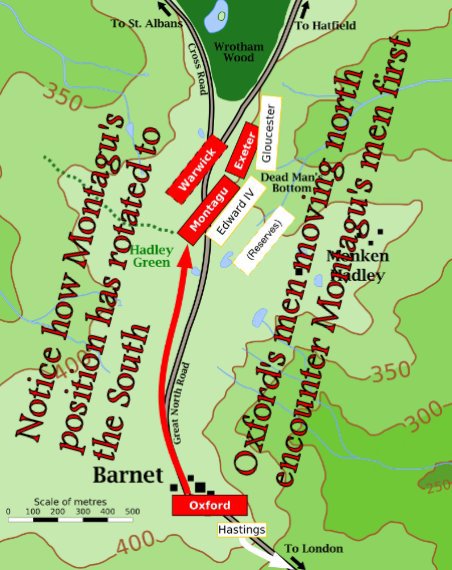 |
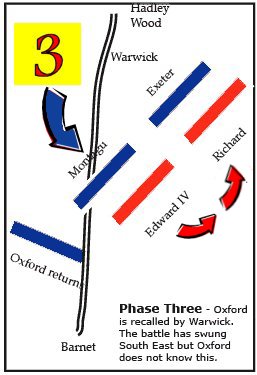 |
Phase
Three: The Sixty Degree Shift
Seeing Richard suddenly appear from the east
was Lord Exeter's worst nightmare.
Shocked by the mysterious sudden appearance
of the charging enemy, the Lancaster general
did his best to rotate his line sixty
degrees to face the east.
Lord Exeter's bizarre rotation affected the
center. On the York side, Edward was
forced to move to his men to the right to
avoid splitting his forces. The last
thing he wanted was a gap between his men
and Richard's. Edward's movement to
the right completely vacated the Great North
Road. Montagu had no choice but to
give chase to Edward's movement. As
Montagu adjusted his forces, his men
occupied the vacuum on the road. First
they moved to the south, then twisted
towards the east.
The ultimate result of this shift is that
now Montagu's forces occupied the same spot
on the Great North Road where Edward's
forces had once been.
Meanwhile, coming up from the south were
Lord Oxford's 800 reinforcements.
Naturally they used the Great North Road as
the fastest route back. They had been
ordered to attack Edward's men from the
rear, an attack which would have been
crippling under ordinary circumstances.
But these were not
ordinary circumstances.
It
was time for the Fog of War to change the
course of history.
|
|
| |
|
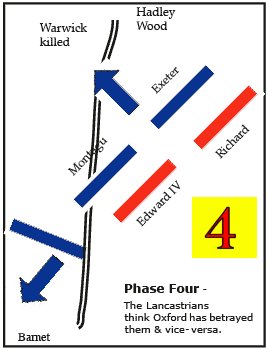 |
Phase Four:
Betrayal
Think
about this... who did Oxford's men expect to meet on
that road?
They
expected to meet Edwards's men who had started the
day occupying the southern part of that road.
But who
did Oxford's men meet on the road instead?
Montagu's men.
Indeed,
Oxford's ragged band of 800 men met Montagu's men
who had rotated over and taken complete possession
of the road. And did the two Lancaster units
merge to overwhelm Edward? No.
What
happened instead is that Montague's soldiers assumed
Edward's rear guard was coming in from the south to
attack them.
Obscured by the mist , Lord
Oxford's 'star with rays' banner was mistaken
for Edward's 'sun in splendor' banner by
Montagu's soldiers. Without hesitation,
Montagu's archers unleashed a deadly volley of
arrows at their Lancaster comrades.
|
Lord
Oxford's men quickly recognized that they were being
shot at by their own men. Oxford and his men
immediately cried 'Treason!' As staunch
Lancastrians, they knew that Montagu, Warwick's
brother, had previously fought for the York side.
Surely
this unprovoked attack was proof that Montagu had
defected back to the Yorkist cause. Oxford's
men briefly struck back, then decided the best thing
to do was withdraw from the battle. The damage
was done. The shouts of treason were taken up
and spread quickly throughout the Lancastrian line,
breaking it apart as men fled in anger, panic and
confusion.
As the
fog started to dissipate, once Edward saw the
Lancastrian center disintegrate, he sent in his
reserves to hasten the collapse. The Lancaster
leaders began to fall. Although not killed,
Lord Exeter fell first. Amidst the confusion,
Lord Montagu was struck in his back and killed by
one of Oxford's men bent on revenge for the supposed
treachery.
Witnessing the demise of his brother, Warwick fled.
The mighty Warwick was killed fleeing the field in a
desperate attempt to reach his horse. The
Devil was dead, the battle was over.
|
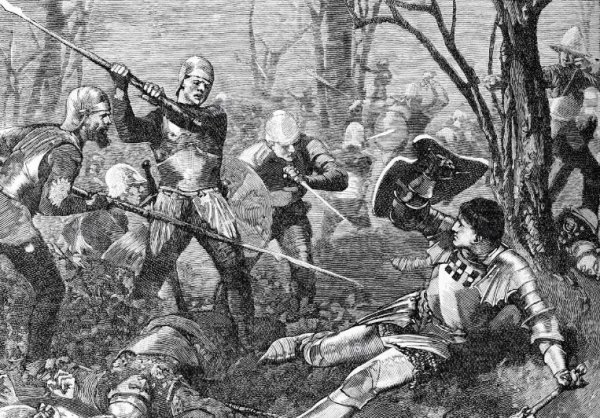 |
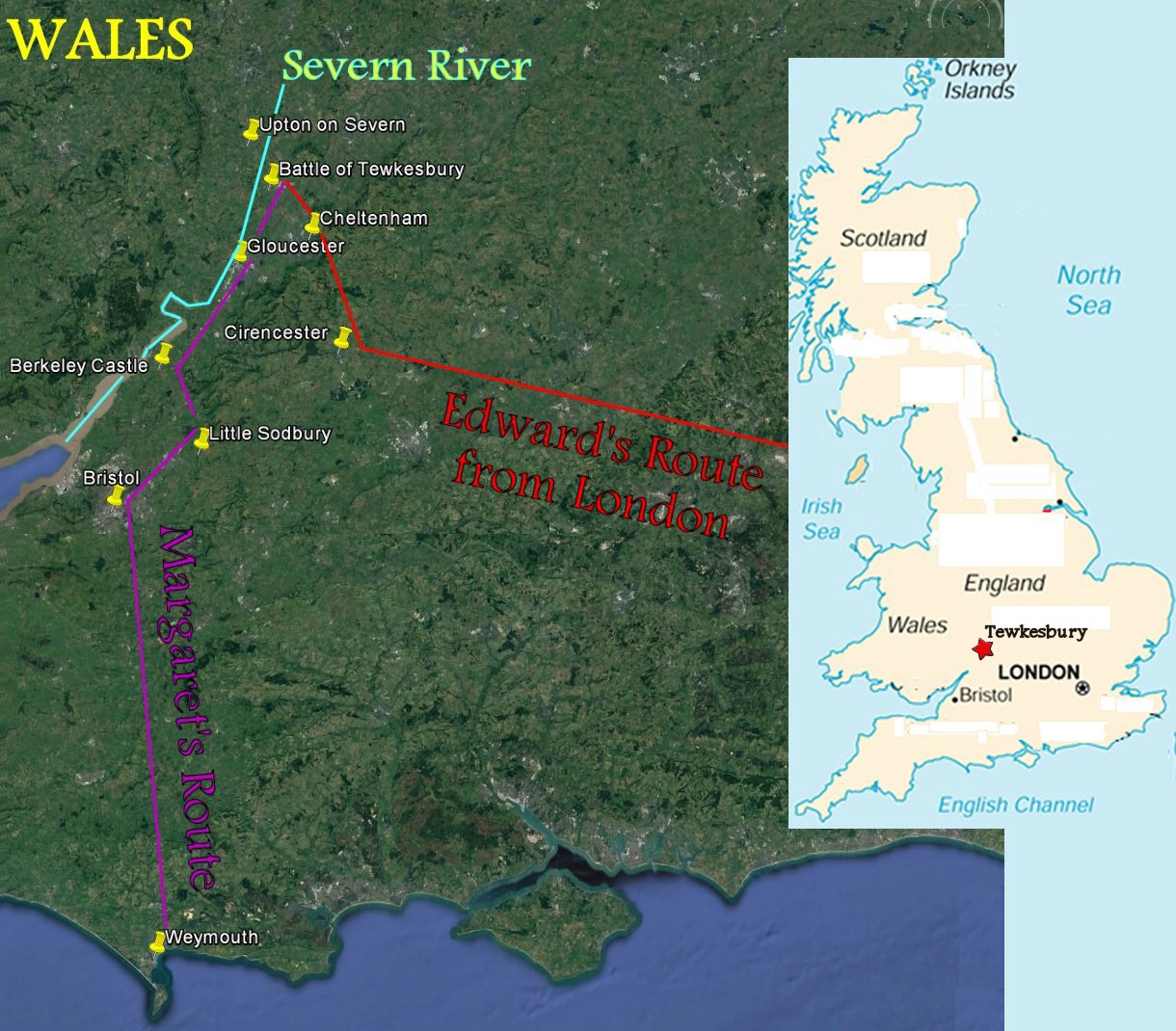 |
Margaret
of Anjou had never trusted Warwick. And who
could blame her? Margaret had adopted a wait
and see attitude about Warwick and his Grand
Alliance. Margaret had
been very slow to follow up on Warwick's expulsion
of Edward IV back in October 1470.
Despite
her eight year absence from England, Margaret was
strangely hesitant. She had been asked to
delay her return to England until Warwick had enough
control of the government to satisfy her patron and
backer Louis XI. Six months after Edward's
October overthrow, Margaret lost her patience and
finally got moving. She
sailed for England on 24 March. Uh oh. A
storm came up. Back to France for safety.
Then another storm came up. Back to France for
safety. Slowed by storms, Margaret and Prince
Edward were delayed by two weeks. They landed at Weymouth on 14 April,
Easter Sunday.
Ironically, this was same day that the disastrous Battle of
Barnet was being fought. Perhaps if Margaret's
forces had been at Warwick's side at Barnet, the
outcome would have been much different. Who
can say?
So why
wasn't Margaret at Warwick's side?
Keep in
mind that communication was very slow in those days.
Although Margaret had received the promising report
that Warwick was now running the government in
England, she had not received the reports that
Edward had landed on the English coast on 14 March.
Those same storms which prevented Margaret from
leaving France also prevented ships from landing in
France to give her the updated information on
Edward's new threat. If she had known of
Edward's threat to Warwick, she would have headed
directly for London with her army instead of landing
two hundred miles away in Weymouth.
While
Margaret sheltered at Cerne Abbey near Weymouth, the
Duke of Somerset, Edmund Beaufort, brought news of
the disaster at Barnet to her. What a blow it
must have been for Margaret to discover Warwick's
demise. Margaret
immediately wanted to leave and head back for the
safety of France. Edmund Beaufort suggested they stay
and fight. Now that Warwick had fallen,
Beaufort pointed out they might not get another
chance like this. This moment carried the
sense of 'Last Shot'.
Edmund
Beaufort, 33, was the new commander of Margaret's
army. Edmund was the son of Margaret's
one-time lover
Edmund Beaufort, the man who had died at the First
Battle of St. Albans back in 1955. Edmund was
also the
brother of Henry Beaufort who had commanded the
Lancastrian forces for nine years following his
father's death. Henry had died at the
Battle of Hexham in 1464. Now it was the
junior Edmund's turn to run the show along with his
younger brother John Beaufort. One can only
wonder if either son knew that their deceased father was
also the likely father of Margaret's son Edward.
In other words, Prince Edward was likely their
half-brother.
Sometimes the truth is stranger than fiction.
| |
|
So what
should Margaret do? Margaret
dearly wished to return to France, but her commander
said that if they could join up with the powerful army
waiting for them in Wales, they had an excellent
chance of unseating Edward IV themselves.
Margaret turned to her 17-year-old son Edward and
asked him what he wanted to do.
Prince Edward
persuaded his mother to gamble for victory.
They had landed in Lancaster country. Somerset
and the Earl of Devon had already raised an army for
Lancaster here in the countryside of west England.
Their best hope was to march northwards and join
forces with the Lancastrians in Wales. And
with that, Margaret was persuaded.
In
London, King Edward learned of Margaret's landing.
Realizing the She-devil was loose in the west, Edward moved swiftly to meet her. However he
was unsure of her destination. As it turns
out, Wales was equidistant for both parties 125
miles away. The advantage was on Margaret's
side because she knew where she was going and Edward
didn't. However, Edward's advantage was that
at first Margaret did not know he was chasing her,
so she took her sweet time getting there.
The race to
Wales was on.
|
 |
| |
|
By 30
April, Margaret's army had reached Bristol
on its way towards Wales. On the same
day, King Edward reached Cirencester,
just 30 miles northeast of Margaret's position.
On hearing that Margaret was at Bristol, he turned
south to meet her army. However, the Lancastrians
made a feint towards Little Sodbury,
halfway between Bristol and Cirencester.
Nearby was Sodbury Hill, an Iron Age hill fort which
was an obvious strategic point for the Lancastrians
to seize. When Yorkist scouts reached the hill,
there was a sharp fight in which they suffered heavy
casualties. Believing that the Lancastrians were
about to offer battle, Edward temporarily halted his
army while the stragglers caught up and the
remainder could rest after their rapid march from
Windsor.
And with
that, Margaret's trick had worked. With Edward
preoccupied with her Sodbury Hill diversion, she was
able to sneak away. The Lancastrians instead
made a swift move north by night, passing undetected
within 3 miles of Edward's army. By the
morning of 2 May, they had gained the safety of
Berkeley Castle and had a head start of
15 miles over Edward in the race to the bridge at
Gloucester.
Now King Edward guessed what Margaret was up to.
No doubt the Lancastrians were seeking to cross the
River Severn into Wales. The nearest
river crossing point they could use was at the city
of Gloucester. Edward sent his
horsemen to deliver an urgent message to Sir
Richard Beauchamp, the Governor, ordering him to bar
the gates to Margaret and man the city's defenses.
This was a critical move.
Beauchamp's father
had been a Lancaster. What should he do?
Defy his king and let Margaret through? If he
told Margaret 'no', then he risked having her
attack his city. Given the mood she was in,
this was a real possibility. Why not let her
through and avoid the bloodshed?
Then it
occurred to Beauchamp that he would
likely have to face Edward the next day. If he
wanted to keep his
head on his shoulders, he might want to follow
Edward's orders. Tough choice... risk the
lives of the citizens of Gloucester or risk his own
head?
Edward
was probably the better choice, so Beauchamp
cleverly decided to support Edward IV. On the
morning of Friday, 3 May 1471,
Beauchamp threw aside his father's Lancastrian ties
and held the gates of Gloucester closed against Queen
Margaret.
This prevented her army's use of the Severn Bridge
and her escape route into Wales. Beauchamp
wasn't done yet. As Margaret moved north, he
harried the Lancastrian rear and captured some guns
on the road to Tewkesbury. Beauchamp fought at
the battle of Tewkesbury and was knighted.
Quite likely, this one man changed the course of
English history.
When
Beauchamp refused Margaret's summons to let her army
pass, Margaret and Edmund Beaufort had enough men to
take the bridge by force... but they didn't have
enough time. Margaret realized she had
insufficient time to storm the city before Edward's
army arrived. Instead, her army made
another forced march of 10 miles along the river to
Tewkesbury. Margaret was racing Edward to beat
him to the next bridge at Upton-upon-Severn,
7 miles further up the river.
Edward
meanwhile was in a hurry. He had marched no
less than 31 miles, passing through Cheltenham
in the late afternoon. The day was very hot,
and both the Lancastrians and Edward's pursuing army
became exhausted from all the marching. The
Lancastrians were forced to abandon some of their
artillery, which was captured by Yorkist
reinforcements trailing Margaret from Gloucester.
This would prove significant.
At Tewkesbury, the tired Lancastrians
halted for the night. Most of their army were
footmen, and unable to continue further without
rest. Even the mounted troops were weary.
Hearing from his scouts of Margaret's position,
Edward drove his army to make another march of 6
miles from Cheltenham to a spot near Tewkesbury,
finally halting 3 miles from the Lancastrians. The
Lancastrians knew they could retreat no further
before Edward attacked their rear. Edward had
Margaret cornered. It was time to stop
running.
|

The Battle of
Tewkesbury
|
|
Margaret's
decision to stand and fight at Tewkesbury
was an all or nothing gamble, perhaps
the last desperate roll
of the dice for a queen robbed of a kingdom.
It is likely there were plans for
Prince Edward to take over from his ailing father
Henry if the Lancasters were
victorious today.
Prince Edward's reputation
was riding on the outcome. The Prince would need to
prove that he was greater
than his father, a weakling who
had allowed England to slide into
a crippling mess.
The Prince would need to prove that he was greater
than his opponent, the formidable King Edward IV.
That
would not be easy.
King Edward had
built his reputation on martial prowess and
had won his
throne in battle twice over...
Towton and Barnet.
It must
have been intimidating for Margaret and Prince
Edward to see the three brothers - Edward,
George, Richard - battle-tested, mounted on
horseback, united in arms. There was no escape
route
for Margaret and Edward. Nor would there be
any mercy. This was it. This was a fight
to the finish, Prince Edward versus King Edward.
|
| |
Unlike
the Battle of Barnet where Edward had won a fluke
victory against a superior army, this time he had
most of the advantages. The new Lancaster leader,
Edmund Beaufort, Duke of Somerset, had his back to
the river with no easy escape routes. Even if Beaufort's men
ran, they were on foot while Edward had mounted
men if necessary.
Based on
his experience at Barnet, Edward noted the Lancasters had
chosen the location again. Assuming there must be a
reason, Edward was concerned about a thickly wooded
park to the left of his army. Suspecting that
hidden Lancastrians might attack from this quarter,
he ordered 200 mounted spearmen to occupy a corner
of the woods and prevent the Lancastrians from
making use of this cover to ambush his left flank.
Edward told the horsemen to act on their own
initiative if they saw an opportunity.
Another
key move was to move Hastings to the right and
Richard to the left. Hastings, 40, was Edwards
best friend. Friendship aside, Edward put his
brother Richard on the
left next to those dangerous woods. Edward was
showing his experience. He had fought so many battles at
this point that he had become a superior general.
The Battle of Barnet had shown him that even though
Richard was only 18, he was a talented fighter.
|
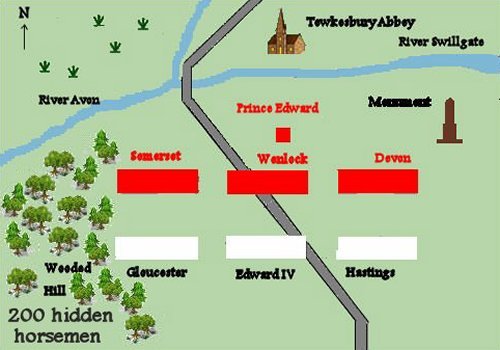 |
| |
|
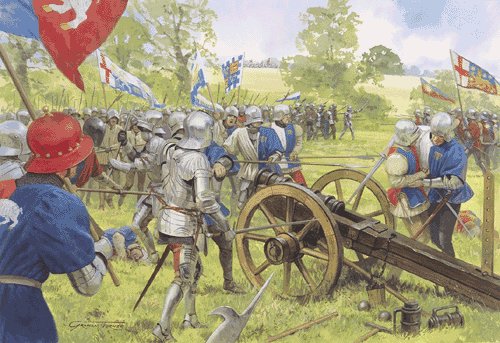 |
As
usual, the Lancasters had more men. Their
6,000 matched up well against the 5,000 Yorkists. Edward
soon discovered why Somerset had chosen this
location. The hilly terrain contained valleys,
disguised gullies and thick hedges, all of which made it
difficult for Edward to attack uphill. So
Edward was content to bombard the Lancasters with
arrows and cannon.
The War
of the Roses was now in its 20th year. The War had been going on for so long that
artillery had recently been introduced.
Understandably, there was great terror attached to
the horrible sound of the exploding cannons and
the whistling cannonballs. Beaufort could see his
men were terrified under the onslaught. The
barrage of arrows was frightening as well. Few of
the men had shields and there was nowhere to go for
protection. The psychological aspect of the
bombardment was devastating. Since Somerset had left
his artillery behind in order to pick up speed, he could not fire
back.
Although Commander Beaufort's
position was almost unassailable,
for some unknown reason, after the battle
began, he moved down from
the heights and attacked Edward IV's flank.
He
must have felt trapped and could not sit still any longer... his men were
dying without even fighting!
|
| |
|
|
Either to escape the arrows and cannonballs or
because he saw an opportunity to outflank King
Edward's isolated men near the woods, Beaufort
(Somerset) decided to be aggressive. He led
part of his men through a gulley that hid them from
sight to attack the York left flank defended by
Richard, Duke of Gloucester. Although taken by
surprise, Richard and his men resisted stoutly,
beating back Somerset's surprise attack among the
hedges, tree and embankments.
|
| |
|
At the
vital moment, the 200 spearmen Edward had posted
earlier in the woods attacked Somerset on his
exposed right flank and rear. This was the
'Kill Shot'. Somerset's desperate
gamble had failed.
Beaufort was assailed by both the king and
Richard, Duke of Gloucester, and was soon put to
flight. His
rash conduct had
decided the battle in favor of the Yorkists.
Now
badly out of position, the Lancaster army was easily
routed. The surviving
army tried to escape across the Severn River, but it did
little good. Most of them couldn't swim
anyway. Edward's horsemen gave easy
chase, cutting the enemy down as they fled.
Edmund
Beaufort was caught and beheaded. His younger
brother John Beaufort who had fought beside him was
executed as well.
With the death of John and
Edmund, the legitimate male line of the Beauforts
ended. This line which dated 120 years back to their forefathter John of Gaunt
was gone for good.
Edward,
the Prince of
Wales, was found
full of grief in a grove.
Richard and George were summoned. Edward tearfully
pleaded for his life to
George for mercy. He reminded
George that he had sworn
allegiance to Edward in France barely a year before.
Edward begged George to honor his oath and set
him free.
If
anything, that made George mad. The original plan had
been to make George king, not Edward. George
refused to listen
to the Prince’s whining.
With little fanfare, he had the lad
summarily executed on a makeshift block in the field.
|
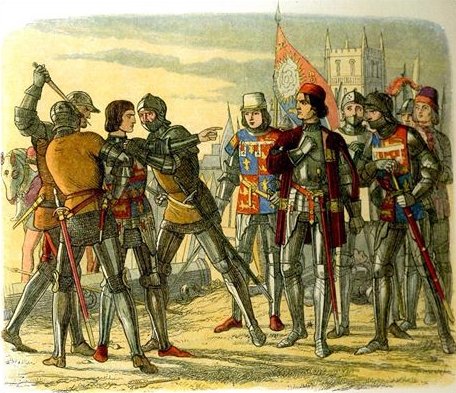 |
| |
|
 |
United we Stand, Divided we Fall
The
indomitable Queen Margaret
was defeated at
last. She was crushed
by the death of the son Edward
she had fought so long
and hard for. After she was taken captive by William Stanley, Margaret
and her senile husband Henry were
taken back to London with King Edward.
Henry died in the Tower of London, presumably
murdered during a midnight visit
from Edward and Richard. Henry was only
49, but seemed much older. One can only assume
his death was unannounced and that he was quickly forgotten.
What a sad epitaph.
Margaret
of Anjou stayed imprisoned in England for five years.
Those were
surely difficult years for her. Margaret was
understandably heartbroken by the loss of her only son,
her entire reason for existence. During
her imprisonment, she had plenty of opportunity to
reflect on her decision to trust her fortunes to
Richard Neville, the erstwhile Earl of Warwick
better known as the Kingmaker.
What
bothered Margaret was just how close she had come to
fulfilling her dream. Margaret had
never trusted Warwick, but cooperated anyway because
he offered her the best chance to put her son on the
throne. Unfortunately, her distrust ending up
costing her dearly.
Her problem was
deciding who she should listen to... Warwick or Louis XI.
|
| |
|
Warwick
was in a tough spot. After his overthrow of
Edward in October 1470, he had promised King Louis
XI to declare for France and against Charles in
Burgundy. Now to his consternation, Warwick's
hands were tied. He could not attack Charles
because the London merchants preferred to support
Charles the Bold of Burgundy for financial reasons.
Consequently the London bankers refused to loan
Warwick enough money to help guard against a
potential counterattack by Edward, much less attack
Charles. Louis XI lost his patience with
Warwick and declared war on Charles the Bold
himself. Big mistake. Charles had seen
Edward's presence as a refugee in Flanders as a
nuisance. However, once Louis XI irritated him
sufficiently, Charles decided to sponsor Edward's
return to England to overthrow Warwick. The
politics backfired for virtually everyone in this
story but Edward IV.
If
Margaret had ignored Louis XI's command to delay her
trip to England, the outcome would have likely been
different. There is one constant theme in
these stories... the two sides were evenly matched.
It always came down to who defected at the last
minute or who showed up at the last minute to shift
the balance. In Margaret's case, her delay
cost her dearly. By dawdling in France for six
months after Edward's October 1470 overthrow,
Margaret was unable to help Warwick thwart Edward's
miraculous comeback.
|
| |
|
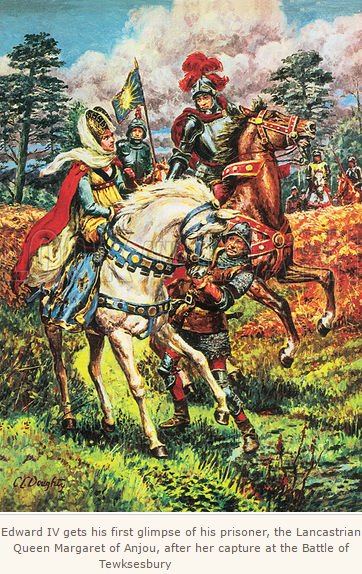 |
But then
again, perhaps some things are meant to be.
The Lancasters should never have lost the Battle of
Barnet. Never. If Margaret had been
there, they would have been too strong. If
George had not changed sides at the last minute,
they would have been too strong. If not for
the Fog of War, Montagu would never have mistaken
Lord Oxford for the enemy.
No doubt
the Weymouth decision also weighed upon Margaret's
thoughts. The moment she landed in Weymouth,
Margaret discovered that everything that could go
wrong had gone wrong so far... Edward IV had
returned, Warwick had been defeated at Barnet, and
George, the Duke of Clarence, had defected back
to his brother. Margaret's instinct
was to flee to safety while she still had ships
in the harbor, but she had let her son talk her out of
it. So much for the wisdom of a cocky teenager
with little military experience other than watching
battles while hiding behind a tree at his mother's
side.
The main upshot of the
Tewkesbury defeat is
that Edward and his brothers executed every last
Lancaster of note who had fought against them in
this battle. Once Prince Edward was killed and
Henry VI was executed, the noble House of Lancaster
was officially eliminated in the male line.
Margaret of Anjou was faced with the bitter fact that the
vast House of Lancaster had been exterminated trying
to put her son on the throne.
Margaret
had gone from being Queen of England to being a
childless widow. She remained in royal custody for
the five years until she was finally ransomed by
Louis XI in 1476 and returned to France. While
in France, she was practically disowned by her
elderly father and was forced by the king to
renounce any claim to her inheritance as a way of
paying for her large ransom.
In 1482
Margaret, the woman who had acted as king, died alone. She was a broken woman
with little to call her own. She was 52. This
was indeed a tragic end for the woman who had once
been so powerful in an age dominated by men.
|
This
picture depicts a group of men meeting to discuss
solutions to the animosity between the Lancasters
and the Yorks. In order to show where their
loyalties lay, they each picked a red rose or a
white rose ahead of time so that everyone in the
group knew where they stood.
Margaret
was not the only desolate one. Now that the
House of Lancaster had lost all their leaders,
the House
became extinct in the male
line. The
Lancastrian cause was lost
forever. Consequently,
the Battle of Tewkesbury marked the end of hostility between the
Houses of York and Lancaster.
One
would assumed the
Wars of the Roses ended at
Tewkesbury Abbey, where the final petal of the red
rose fell to the ground.
Nevertheless,
the War was not over. Although the War went dormant,
it awaited
another chance to erupt anew.
The new opponent would not be Lancasters.
That fight
was over.
Instead, a whole new set of faces would
appear to take up the ancient battle.
|
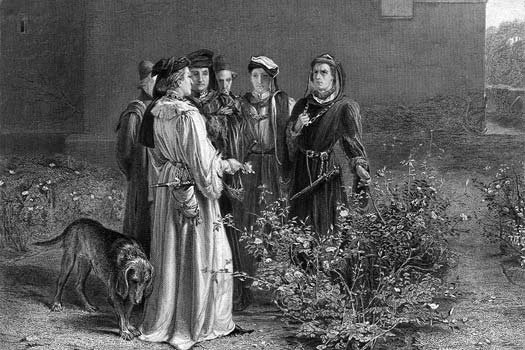 |

The War of the Roses
ACT THREE:
Richard III
|
| |
 |
The star
of Third Act in the War of the Roses is none other
than Richard III. And who might be Richard the
Third? We know
Richard better as Edward IV's younger brother
Richard, the Duke of Gloucester.
Richard
the Third made a lot of enemies, but his worst enemy
was William Shakespeare. William
Shakespeare had a field day at Richard's expense with
Richard III, considered one of The
Bard's ten
best plays.
Before
Shakespeare was finished, Richard had murdered Henry
VI, his brother George, his nephews, and even his
own wife during his well-plotted ascent to the
throne. In case these heinous murders were
insufficient clues, Shakespeare dressed Richard in
black and accentuated his a hunchback to emphasize
who the villain was.
|
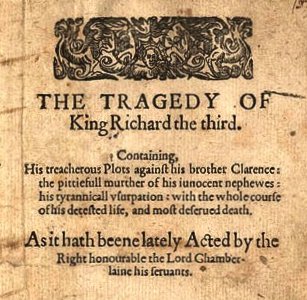 |
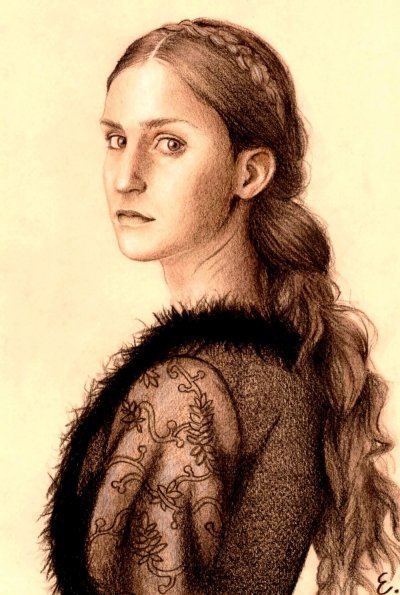 |
Anne Neville
Following Prince Edward's death at Tewkesbury, his
wife Anne Neville became the grand prize.
Anne
Neville was born into the wealthiest and most
politically powerful family in the kingdom. Youngest
daughter of the Earl of Warwick, Anne watched her
father make a king out of Edward of the House of
York, and then change his alliance to the House of
Lancaster. Anne, raised a York, was expected
to change her loyalties as well.
In 1470, Anne had been the trophy dangled by her
father Warwick to secure the backing of Margaret of
Anjou in the newest attempt to overthrow King Edward
IV. During the desperate race to reach Wales,
Anne chose to stay with the army. She marched
with them for more than a hundred miles, from
Weymouth to Tewkesbury where Edward’s pursuing army
caught them, killing Prince Edward and capturing
Margaret of Anjou.
Anne was a widow at 15, far too wealthy and powerful
to be left to chance. Her sister Isabel, now a loyal
supporter of the House of York thanks her
side-switching
husband George, scooped up the girl and took her
into their keeping. Isabel swore she was
protecting Anne, but in reality this was more likely a form of
house arrest.
Anne became the subject of
dispute between George, Duke
of Clarence, and his brother Richard,
Duke of Gloucester, who
had stated to George his desire to marry her.
Anne and her sister
Isabel, George's wife, were heiresses to
their parents' vast estates. George
was anxious to secure the
combined inheritance of
both sisters! George thereby treated
Anne as his ward and
opposed her getting married.
Strange stories ensued. One wild tale had
George hiding Anne in a London
diner, disguised as a
servant, so that his brother would not know where
she was.
Nonetheless, Richard
Gloucester tracked her down
and escorted her for safekeeping
at the Church of St Martin le Grand
out of George's reach. In order to win
the final consent of his brother George to the
marriage, Richard renounced most of Warwick’s land
and property, including the earldoms of Warwick
(which the earl had held in his wife’s right) and
Salisbury and surrendered to
George the office of Great Chamberlain of
England. It was a high
price to pay.
|
In this
passage from The Kingmaker's Daughter,
Anne Neville is talking to herself shortly after the
fall of Tewkesbury:
One of the
guards
has stumbled while mounting his horse.
Frightened, his horse shies
away, knocking the horseman
to the ground. Seeing
the horse rear, King Edward puts his arm
around his wife in an unconscious
gesture to protect her. Everyone
is looking that way.
I snatch off my glove
and, in one swift gesture, I throw it towards
Richard. He catches
it out of the air and tucks it in the breast of his
jacket. Nobody has
seen it. Nobody
knows.
The guardsman steadies
his horse, mounts it, and
nods his apology to his captain.
The royal family turns
and waves to us.
Richard looks at me,
buttoning the front of his jacket, and smiles at me
warmly, assuredly, to denote he
understands the meaning of my gesture.
Richard
has my glove, my favor. It is a pledge that I
have given in the full knowledge of what I am doing.
Because I
never want
to be anybody’s pawn again.
Philippa Gregory, The
Kingmaker's Daughter
|
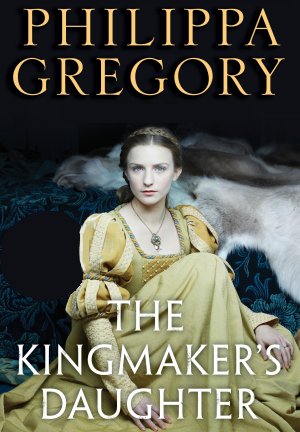 |
| |
|
The Strange Saga
of George
So what
exactly did Shakespeare mean by the immortal line 'false,
fleeting, perjur'd Clarence, that
stabbed me in the field by Tewksbury!'
Shakespeare was referring to the ghost of Edward,
Prince of Wales, stabbed to death in cold blood
following the Battle of Tewkesbury.
George, better known as 'Clarence',
is dreaming of
the evils he has
done
during his fitful sleep preceding
his imminent execution.
|
|
|
|
Following Warwick's death in
the 1471
Battle of Barnet, George, Duke of
Clarence, was consumed by
a serious overdose of greed. Married to
Isabel, one of Warwick's two daughters, George went
ahead and confiscated the vast estates of the
earl. George had been be a
very bad boy. He
had betrayed his brother Edward. Later
he betrayed Warwick, his father-in-law. In
George's case, cheating had been profitable.
In March 1472 by right of
his wife Isabel, George became the
Earl of Warwick and Salisbury.
George was now rich beyond his wildest imagination.
Nevertheless, he was greatly disturbed when
he heard that his younger brother Richard was
seeking to marry Warwick's younger daughter Anne,
Isabel's sister.
George was upset because Richard was
also claiming some part of Warwick's lands
as part of the wedding package.
George refused to part with
a single nickle, so a violent quarrel
between the brothers ensued.
After George failed to prevent
Richard from
marrying Anne, the quarrel grew
worse. Finally, in 1474
King Edward had to step in to
settle the dispute, dividing the estates between his
brothers. [It must be tough
being rich, but then I wouldn't know.]
In
December 1476, George's wife Isabel
died two months after
giving birth to a short-lived son named Richard.
Though Isabel's death was likely the result of
either consumption or childbed fever, George was
convinced she had been poisoned by Ankarette, one of
her ladies-in-waiting, operating in cahoots with his
enemy Elizabeth Woodville. George alleged that
King Edward’s wife was guilty of
witchcraft in this matter. Try to imagine how
well that sat with King Edward.
George bullied a
jury into convicting Ankarette of murder by
poisoning, then had her hanged immediately after
trial. Clarence's mental state, never stable
to begin with,
deteriorated from that point on.
|
 |
In 1477
George
became a
suitor for the hand of
Mary,
daughter of Charles the
Bold. Mary was
quite the catch, being
extremely beautiful and
possessing vast estates.
She was better known by
her nickname,
'Mary the Rich'.
George wanted to marry
the rich.
Unfortunately for
George, King
Edward
objected to the match.
Clarence,
assuming his jealous
brother Richard was
behind this slight,
left the court
fuming.
George was not getting
along with Edward well
at all. In
addition to
belligerently accusing
Edward's wife of
murdering Isabel, not
long after her death of
Isabel, men
who were in the employ
of George were caught
plotting against the
King. The timing
was very unfortunate.
It seemed like George
was trying to get
revenge of some sort.
There's an old saying, 'Once
a cheater, always a
cheater'.
George had crossed the
line one time too many.
Edward had forgiven the
man once before; he wasn't
going to make that
mistake again.
Edward had the
duke thrown into prison,
then
unfolded the
charges
to the
parliament...
George had
slandered the king; had
received oaths of
allegiance to himself;
and
was
preparing for a new
rebellion.
In short, George was
bad.
George was executed 'in
private'.
In his play, Shakespeare
gave Richard the blame,
but history suggests
Richard had nothing to
do with it.
Following George's
death, there
was a strong
rumor that
George had been
drowned in a
cask
of malmsey wine.
The headsman does
it, leaving his axe to
one side but wearing
his black mask over his
face. He is a big man
with strong big
hands and he takes his
apprentice with him.
The
two of them roll
a barrel of malmsey wine
into George’s room and
George the fool makes a
joke of it and laughs
with his mouth open wide
as if already gasping
for air, as his face
bleaches white with
fear.
Philippa Gregory, The
White Queen
|
 |
Long Live the
King... or maybe not
Following Tewkesbury, there were twelve years of
peace in the land. With the Lancastrian
line virtually extinguished, Edward faced
no more rebellions after his restoration.
Edward and
his wife Elizabeth had been through a lot.
Amazingly, Elizabeth had kept the children safe
while Edward was constantly fighting to keep his
throne or regain his throne. Three of his
children would figure prominently in Act Three.
•
Elizabeth
of York (1406-1503)
•
Mary
of York (1467-1482)
•
Cecily
of York (1469 – 1507)
•
Edward
V of England (1470 – 1483)
•
Margaret
of York (10 April 1472 – 11 December 1472).
•
Richard
of Shrewsbury
(1473 – 1483)
•
Anne
of York (1475 – 1511)
•
George
Plantagenet (1477 – 1479).
•
Catherine
of York (1479 – 1527)
•
Bridget
of York (1480 – 1517)
Tragically, Edward died
unexpectedly after a short illness on 9 April 1483.
Everyone was in shock.
There
would never have been an Act III to the War of the
Roses if Edward had reigned just a bit longer.
Unfortunately, Edward's untimely death in 1483 would
reignite the War of the Roses. In the
picture, dark-haired Richard stands at King Edward's
side. How fitting that Richard III would
become the villain of Act III.
|
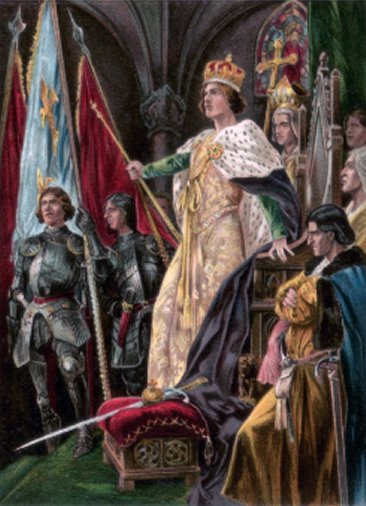 |
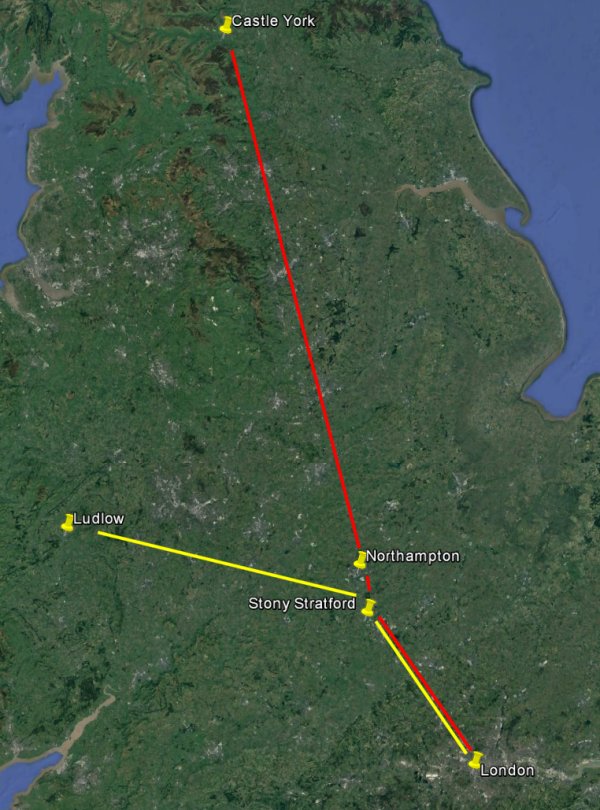 |
Richard's
Treachery
When
King Edward's health began to fail,
at least he had sufficient time to put his affairs
in order. Edward was comforted by the
knowledge that the ever-present issue of succession
was not a problem. Elizabeth had given birth
to two healthy, handsome, well-educated boys,
Edward, 12, and Richard, 10.
Edward
smartly named Richard, his trusted brother, as
protector of his two sons. On second thought,
maybe not so smart.
On the
death of Edward IV, on 9 April 1483, his
twelve-year-old son, Edward V, succeeded him while
Richard, the current Duke of Gloucester, was named Lord Protector of the Realm.
Richard moved swiftly and secretly to prevent the
Dowager Queen Elizabeth from exercising power.
Richard
left his base in Yorkshire for London. On 29
April, as previously agreed, Richard was joined on
the route by his cousin the Duke of Buckingham.
They met Anthony Woodville, the Dowager Queen
Elizabeth's brother at Northampton.
Anthony
Woodville was escorting young Edward at the Queen's
request to London with an armed escort of 2000 men.
Richard and Buckingham's joint escort was of 600
men. The
young king was not there. He had been sent further south to
Stony Stratford.
Richard
politely invited Anthony Woodville, his nephew
Richard Grey (son of Elizabeth by a prior marriage),
and Thomas Vaughan to dinner. After the meal,
they were suddenly arrested on the charge of treason
against the Lord Protector. On June 25, they
faced a tribunal led by Henry Percy, 4th Earl of
Northumberland. The three men were found
guilty and executed.
After having Lord Rivers (Woodville) arrested, the two dukes
moved to Stony Stratford where Richard falsely
informed the young king of a plot aimed at denying
him his role as Protector, adding that the 'perpetrators'
had been dealt with. Richard proceeded to
escort the young king to London on 4 May.
Richard
suggested to the boy that he would be the safest and
most comfortable in the Royal Apartments of the
Tower of London where kings customarily awaited
their coronation. The young Prince thought he
was a guest, but in reality he was a prisoner.
|
| |
Queen Elizabeth and
Lord Hastings
|
|
|
|
After
the unexpected death of Edward IV on 9 April 1483,
the dowager queen knew there could be trouble.
She sought to monopolize political power for her
family by appointing family members to key
positions. She also tried to circumvent
Richard, 31, Edward's younger brother, by rushing
the coronation of her young son Edward V, 12, as
king.
Lord
Hastings was probably the most loyal friend Edward
IV ever had. By all accounts, Hastings had
also been friendly with Richard. Conversely,
Lord Hastings was hostile to the Woodville family.
The Woodville family was not popular with many due
to their quest for wealth and power. Desiring
to frustrate the ambitions of the Woodvilles, Lord
Hastings turned to the new king's uncle - Richard,
Duke of Gloucester, brother of Edward IV.
Hastings
checked Elizabeth's maneuvers and kept Richard
informed of her actions. Alerted by Hastings,
Richard intercepted the young king and his Woodville
relatives as they made their way to London i April
1483.
Hastings
now supported Richard's formal installation as Lord
Protector and collaborated with him in the royal
council. In other words, Hastings had been
instrumental in helping Richard try to grab the
throne for himself. On the other hand, no one
knows how he felt about Edward V being held captive.
Affairs changed dramatically on 13 June 1483.
During a council meeting at the Tower of London,
Richard, supported by the Duke of Buckingham,
suddenly accused Hastings and two other council
members of having committed treason by conspiring
against his life with the Woodvilles. While
the other alleged conspirators were imprisoned, Lord
Hastings was immediately beheaded on Richard's
orders over a log in the courtyard of the Tower.
There was no trial.
The execution of the popular Hastings remains
controversial to this day. No strong evidence
of a 'Hastings conspiracy' has ever surfaced.
|
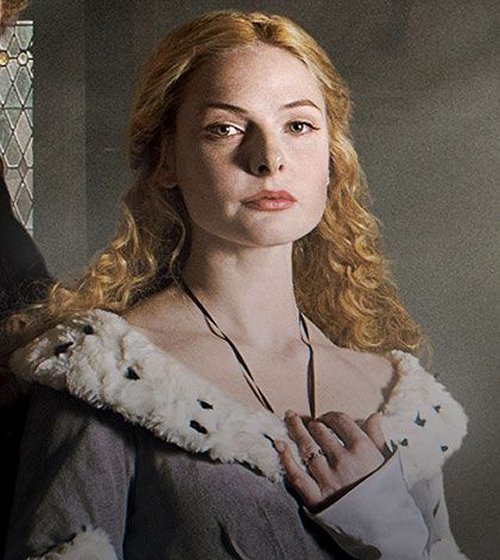 |
| |
|
Rick Archer's Note: Susan Higginbotham
(source)
is the author of five historical novels about
medieval England. I have taken excerpts from
her excellent article on Lord Hastings.
As with so much involving Richard III, there are
conflicting theories as to why William Hastings
met his death at the hands of Richard, Edward
IV’s supposedly devoted brother. Richard
himself claimed that Hastings had been plotting
against him, though he never produced any
proof to substantiate his claims.
Those defenders of Richard who have taken him at
his word suggest that Hastings was driven into
conspiracy by concerns that under the
protectorate, he would lose the power and
prestige he had enjoyed during Edward IV’s reign
or by his suspicion that Richard meant to take
the throne for himself.
The alternative explanation is that there was no
plot at all and that Richard, having planned to
seize the crown, ruthlessly eliminated Lord
Hastings as the man most likely to stand in his
way.
It is probably not a big surprise to readers of
this blog that I lean toward the second theory:
that of there being no plot by Hastings at all.
Richard had recently had three of the men
closest to Edward V—his uncle Anthony Woodville,
his half-brother Richard Grey, and his
chamberlain, Thomas Vaughan—arrested on equally
vague charges of conspiracy, which would never
be proven. They too would be executed
without trial.
Soon came the lies about the legitimacy of the
Woodville children. Richard and his
followers preached the story that Edward IV had
been pre-contracted to a woman named Eleanor
Butler before his marriage to Elizabeth
Woodville. This, in their opinion, made the latter marriage invalid
and the resulting children bastards.
Therefore Richard was the rightful king, not
Edward V (sitting in the Tower of London) or his
brother Richard (also sitting in the Tower).
The English Council agreed and Richard was
crowned King.
These
trumped-up allegations would never see the inside of an
ecclesiastical court, where they belonged.
In each case—Hastings, Woodville, Grey, Vaughan,
and the precontract—Richard would accuse, but
never prove. None of those involved were allowed
to defend themselves against Richard’s
allegations.
Woodville, Grey, and Vaughan were languishing in
prison at Pontrefact Castle when Hastings was
beheaded on 13 June. Their execution would
come 12 days later. Therefore, Hastings
was the first head to roll.
If Hastings could be assassinated in cold blood,
then anyone could be assassinated. Given
the immediate danger to the life of anyone who
spoke up, no one dared to press the point.
During Richard's coup d'état, the list was long and quite intimidating:
•
The
sudden, shocking execution of Hastings
•
The
trumped-up allegations concerning the illegitimacy of
Edward's children
•
The
arrests of others on June 13 and on June 14
(including the Archbishop of York, the Bishop of
Ely, Oliver King, secretary to Edward V, and
John Forster, an official of the queen)
•
The
previous arrests of Edward V’s associates
Woodville, Grey, and Vaughan and
their executions on June 25
•
The
large number of armed men sent to Westminster
Abbey to 'persuade' Elizabeth Woodville
to give up the Duke of York to Richard on June
16
•
The
rumors of massive numbers of troops headed from
the north, Richard's power base, to London
These were powerful incentives for those who
valued their heads to be docile, for the time
being at least. What must have made
Hastings’ execution all the more terrifying was
that he was no unpopular royal favorite, but
rather a
well liked, competent, and respected man who had
been associated with the Yorkist cause for
decades.
If Hastings could be assassinated in cold blood,
then anyone could be assassinated. Given
the immediate danger to the life of anyone who
spoke up, no one was safe. Consequently
there was little protest. Richard had
everyone cowered.
Susan Higginbotham
(original
source)
Two associated comments:
Laura says:
June 13, 2011 at 5:28 am
I find it heart-rending that Hastings' death
came at the hands of a man that he had eaten
and drank with, fought and bled beside.
Richard wanted Hastings out of the way
because he knew Hastings was the one person who
had the power and the strength of character
to stand up to his ambition. There is no
excuse for cold-blooded murder, yet that is
what Richard committed that day by refusing
Hastings the opportunity to exonerate
himself of those charges. Despite the fact
that Richard had other redeeming features,
that unjustified act stands out in my mind
as a defining moment for him. He preferred
the death of a loyal and trusted friend and
ally to his own greed and ambition.
Susan Higginbotham says:
June 13, 2011 at 7:43 am
Thanks, Laura! I quite agree. Even if
Hastings were actually plotting against
Richard, he could have been sent to the
Tower and given a trial. His hasty execution
suggests to me that Richard not only
regarded him as a threat to his ambitions,
but that he also knew that Hastings could
and would give evidence against the
existence of a precontract if left alive to
do so.
|
The Princes in the
Tower
|
|
|
|
Upon
hearing the news of her brother
Anthony's arrest, the Dowager Queen
knew Richard had betrayed her. Sensing she was
in great danger, Elizabeth fled to sanctuary
in Westminster Abbey together with her son by her
first marriage, her five
daughters, and her
other son Richard, Duke of
York.
On 16 June
s large number of armed
men were sent to 'persuade'
Elizabeth Woodville to give
up the Duke of York to Richard.
Elizabeth
Woodville was told to hand over the younger prince
Richard to the Archbishop of Canterbury so
that the
boy might attend his brother Edward's
coronation. She should have
never trusted these men. Richard was immediately
placed with his older brother Edward in the Tower of
London. After
that, things
went from very bad to much worse.
|
|
|
|
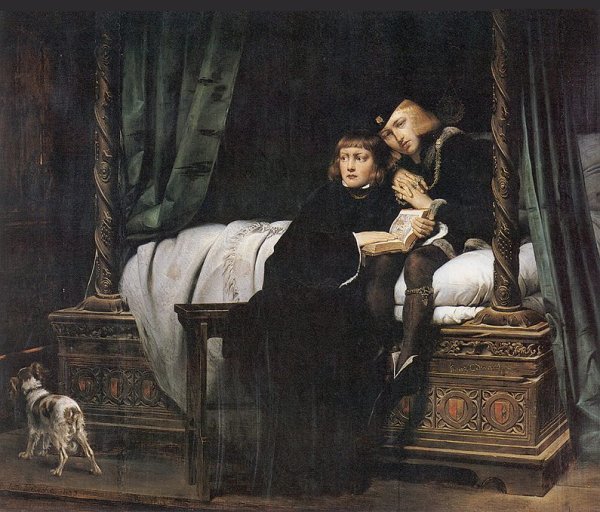 |
One day
before the scheduled coronation of young Edward,
Bishop Stillington of Bath and Wells announced that
the children of King Edward and his Queen, Elizabeth
Woodville, were illegitimate. Stillington
charged that before Edward IV married Elizabeth,
Edward had entered into a precontract for marriage
with another woman, Eleanor Butler.
This
action rendered the King’s marriage to Elizabeth
Woodville invalid. Thus, Prince Edward would
have been a bastard and ineligible to ascend to the
throne (and his brother as well).
On 22
June 1483, a sermon was preached outside Old St.
Paul's Cathedral declaring Edward's children
bastards and Richard the rightful king. Shortly
after, the citizens of London, both nobles and
commons, convened and drew up a petition asking
Richard to assume the throne.
This is
what Richard had hoped for. He was now legally
able to assume the crown. On 25 June, an
assembly of Lords and Commons declared Richard to be
the legitimate king.
Meanwhile, the two princes remained in the royal
apartments in the Tower of London. Sometime in late
summer or early fall of 1483, the boys disappeared
from view; there is no record of their having been
seen again. At the time the Princes vanished,
Richard and his new Queen were on “progress” in the
north of England, hundreds of miles from London.
|
A Footnote to History
Richard
was crowned as the new King of England on July 6.
The reign of King Richard the Third had begun.
Long live the King!! Or maybe not.
Two years later he would be dead.
Had
Richard not betrayed his nephews, there is every
possibility the York dynasty would have survived.
However, Richard’s own future would have been quite
difficult. Richard was despised by Elizabeth
Woodville and all of her relatives at court.
He would surely become the focus of Woodville
discontent. Edward V, the boy king, would have
followed his mother’s wishes when he came of age.
The boy had, after all, been raised and tutored by
his Woodville relations and hardly knew Richard.
No doubt Richard would have become a footnote to
history just like his brother George, the Duke of
Clarence. Richard was too ambitious to let
that happen. The boys had to go.
|
|
|
|
Indeed,
the two boys were never seen in public again.
The fate of Edward and his brother Richard remains
unknown to this day. The most widely accepted
theory is they were murdered on the orders of their
uncle, King Richard. Thomas More wrote the
princes were smothered to death with their pillows.
His account forms the basis of William Shakespeare's
Richard III, in which Richard orders
Tyrrell to murder the princes.
Since
there is no proof of what really happened, many
different theories have surfaced over the years.
However, these competing theories are nowhere near as
plausible as the straightforward one pointing to
Richard. Richard controlled access to the
boys, Richard was responsible for their welfare, and
Richard is the one who stood to gain the most by
their murder. Furthermore, if someone else was
responsible for their deaths, why didn't Richard cry
foul at the top of his lungs and conduct a public
investigation?
Guilty? Most people think
so, especially after seeing Shakespeare's Richard III.
Bones belonging to two children were discovered in
1674 by workmen rebuilding a stairway in the Tower.
On the orders of King Charles II, these were
subsequently placed in Westminster Abbey, in an urn
bearing the names of Edward and Richard. The
bones were reexamined in 1933 at which time it was
discovered the skeletons were incomplete and had
been interred with animal bones. It has never been
proven that the bones belonged to the princes, and
it is possible that they were buried before the
reconstruction of that part of the Tower of London.
Permission for a subsequent examination has been
refused.
In 1789, workmen carrying out repairs in St George's
Chapel, Windsor, rediscovered and accidentally broke
into the vault of Edward IV and Elizabeth Woodville.
Adjoining this was another vault, which was found to
contain the coffins of two children. This tomb was
inscribed with the names of two of Edward IV's
children: George, 1st Duke of Bedford, who had died
at the age of 2; and Mary of York who had died at
the age of 14. Both had died before the King.
However, the remains of these two children were
later found elsewhere in the chapel, leaving the
occupants of the children's coffins within the tomb
unknown.
|
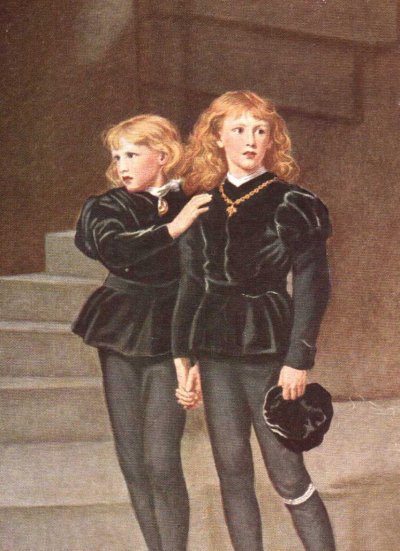 |
| |
Biographies
Transitions were
always perilous times in Medieval England.
Power-hungry people viewed transitions as
opportunities to exploit the leadership vacuum to
advance their own ambitions.
Keep in
mind that the War of the Roses spanned over thirty
years. Following the 1471 Battle of
Tewkesbury, King Edward IV ruled unopposed for
twelve years.
During
that time, an entire new generation of faces moved
into position. So let us detour from the
treachery of Richard and learn more about the
background stories that make Act III: Richard
III so compelling.
|
 |
The Madness of King
Charles
Charles
VI was better known as Mad King Charles.
The best
known story about Charles took place in 1392.
Charles was 24. In April, Charles suffered
from a mysterious illness which caused his hair and
nails to fall out. That summer, Charles was
hardly recovered. He still suffered from
occasional bouts of fever and behaved incoherently
at times. One day Charles and his men set out
on an expedition. One of his advisors had
barely survived an assassination attempt. Now
Charles went looking for the fugitive assassin.
On a hot
day in August, Charles was riding through the forest
at the head of a group of knights when a
wild-looking man ran up to his horse and spoke some
words of doom and betrayal.
The
soldiers chased the man away, but Charles' nerves
were clearly disturbed. Charles absolutely
freaked out.
|
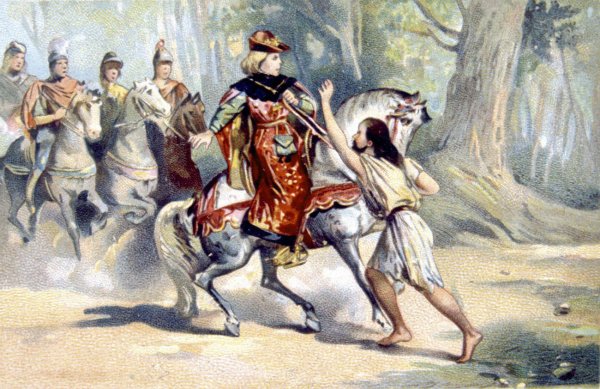 |
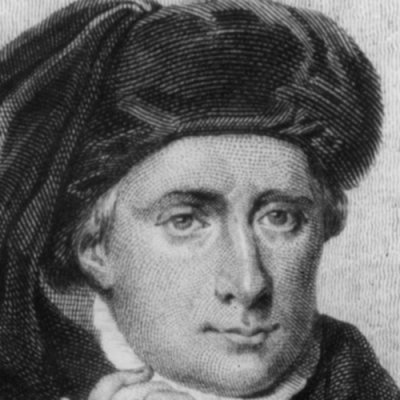 |
Leaving
the man behind,
the group continued their
journey. Soon after, a page accidentally
dropped a lance. Charles flipped out.
Without warning, he rushed forward with a drawn
sword and killed four of his men. The astonished
victims did not even defend themselves, assuming the
king had the right to kill them if he wanted to.
Finally
the others overcame their shock and overpowered the
king. Lifted from his horse, Charles lay flat
and speechless on the ground, his eyes rolling
wildly from side to side. His attendants found
an ox-cart to carry him. For two days Charles
was in a coma. When Charles heard that he had
killed four of his own men, he wept.
From
then on his mental health was seriously undermined.
Charles would go through
episodes of forgetting people's names, including his
own, and the fact that he was king. Occasionally he
would run through his castle howling at people; he
was pretending to be a wolf. When his spells
were upon him, he would sit in a room, motionless,
for hours. If he did move, he did so with extreme
caution. Questioned about this, he claimed
that he was made of glass, and one wrong move would
shatter him.
Charles
suffered from severe schizophrenia.
Mental illness ran
rampant in the family. Desperately ill, he was
delusional. At times he believed his enemies were
upon him and would be thrashing and fighting off the
invisible foes. But King Charles was not the only
one in the family who was mad. His
mother, Joan of Bourbon was unbalanced.
She became totally deranged after giving
birth to her seventh child. Her father, uncles, and
grandfather also suffered mental maladies.
|
| |
The
problem with having a Mad King is the fact that the
Kingdom of France depended on him.
Charles became king of France in 1380 when he was
12. He ruled for 42 years till his death in
1422. All 42 years took place during the worst
part of the Hundred Years' War with England. Yes, the same
hundred years when England plundered and humiliated
France time and time again. Was Charles was part of
the problem? Well, what do you think?
When
your country is fighting something called the 'Hundred
Years' War', it's really unfortunate if the man
sitting on the throne is nicknamed 'Mad King
Charles'... unless of course it means he's
really angry at someone. No, he was just nuts.
The
question the reader might be asking is why I am
discussing a French King who died 60 years before
Richard the Third became king of England.
There are two things the English people are very
squeamish about in regards to their kings... illegitimacy
and madness.
There
have definitely been English kings who were crazy.
Mad King George III comes to mind. His madness
led directly to a certain well-known war known as
the American Revolution. This madness stuff in
a king can be incredibly costly to a nation.
So now I
have question. This has
been a very long and quite complicated story, but can you remember
WHO was
most responsible for creating the War of the Roses?
Let's see if you
get it
right. Scroll down.
|
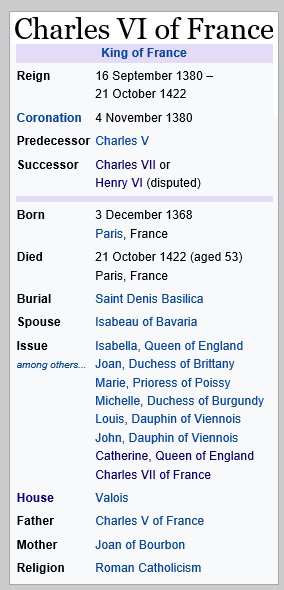 |
|
|
Keep
scrolling.
|
|
|
A Very
Naughty Girl
|
|
|
|
|
 |
Did you answer Richard, Duke of
York? Close, but he's not the best answer.
Did you
answer Margaret of Anjou? Closer, but she's
not the answer either.
Did you
answer French King Charles the Sixth?
You're getting warmer.
The
madness of Charles VI let England have its way with
France for half a century. Thanks in large
part to the cruelty of England's Black Prince, countless
men were murdered, women were raped, fields
were burned, and townships were pillaged and leveled.
Did you
answer Catherine of Valois? Considering her
picture is hard to miss, that would be a good guess,
but we are still not quite there yet.
The best
answer is Henry the Sixth.
Mad King Henry the Sixth was the direct
descendant of Mad
King Charles the Sixth. The
humiliating defeat of
Agincourt took place during the reign of Charles
VI. With Charles incapacitated at the time of
Agincourt, his wife Isabelle allowed King Henry V,
the enemy, to marry beautiful daughter Catherine
Valois (who just happened to be a little nutty
herself).
This
marriage inadvertently linked Catherine to one of
the greatest ironies in history. Catherine
would inadvertently carry out the revenge of French
King Charles VI on England. As we know,
Catherine passed on the seed of madness to her son, the sad, bewildered
King Henry VI. It seems almost karmic that by marrying his daughter Catherine
to Henry V, hero of Agincourt, Charles made
sure his family's hereditary madness crossed the English Channel.
|
Here is
a sad reality... England was absurdly dominant over
France during the reign of Charles VI.
With the
Hundred Years War lasting from 1337 to 1453, out of
those 116 years, France did not gain the upper hand
until the final days of the conflict. What can
explain the change in momentum? Henry VI.
The
historians will say Charles VI died in 1422 and
Charles VII, better known as 'Charles the
Victorious', took over. The historians
will also point out that Henry V, a fierce warrior,
died the exact same year.
And who
took his place? Henry VI.
England's king had gone from a stud to a simpleton.
The
course of the war changed instantly. But Henry
VI wasn't done yet. When the Hundred Years War
ended in 1453, a new war took its place. 1453
was the start date of a new conflict. Henry's
madness created the War of the Roses. Surely
in the French equivalent of Valhalla, Charles VI was
laughing.
|
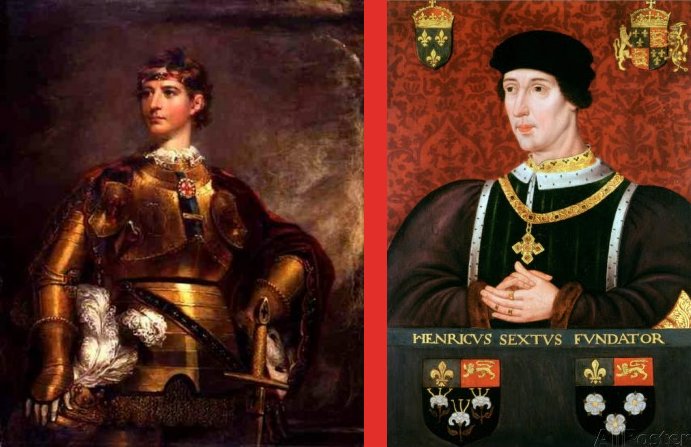 |
Illegitimacy and
the Throne
|
| |
|
A major
scourge of the 21st Century are computer viruses.
Charles VI had planted a time bomb virus of another
sort in the English bloodline. The mental illness of
Catherine's son King Henry VI was more responsible
for the War of the Roses than any other factor
because it encouraged the subsequent free for all
power grab. When a King goes mad, the country
goes to hell. And when the country goes to
hell, it is usually because there is a power vacuum
at the top. The madness of Charles had led to the devastation of
France during the Hundred Years War. Now that
same madness gave
England its equally destructive War of the Roses by
encouraging the power hungry nobles and relatives to
seize power for themselves.
Let us
review the damage caused by Henry VI.
•
His
incompetence led to England's humiliating collapse
at the end of the Hundred Years War.
•
His
weakness led to the enormous social and political
problems in England which led to the War of the
Roses.
•
His
inability to reproduce led his wife to have the
affair with Edmund Beaufort which led to Edward of
Westminster.
If not
for Edward's miracle victory at the Battle of
Barnet, England would have had its next illegitimate
king.
'Next'
illegitimate king? Uh oh.
Let's be
clear on something... there is current DNA evidence
that proves beyond a shadow of a doubt that
illegitimacy occurred somewhere in the English line
of kings, perhaps even several times. For
example, we might recall the story where King Edward
the Fourth's own mother, Duchess Cecily Neville,
claimed her son Edward was the illegitimate spawn of
her fling with an obscure archer. It is said
that Edward was very good with a bow and better
looking than his mother's husband. Surely that
is all the proof we need.
England
may have dodged the illegitimacy problem with Henry
VI, but his mother Catherine went out and made
things much worse. Yes, indeed, as it turned
out, Catherine of Valois was not through wreaking
her reproductive damage upon England.
Catherine was
the gift that kept on giving. England
mistreated her, so she mistreated England right
back. Not only did she give
England her father's madness, there is a strong possibility that
Catherine gave England
its next illegitimate king.
Personally, I have never understood why people make
such a big case out of illegitimate birth. I
hate the way people look down on a bastard child.
Why punish the child for the sins of the parents?
To me, the child should be judged on the quality of
his or her actions, not the parentage. For
example, England's William the Conqueror was born a
bastard and look what he accomplished.
However,
I also understand that various religions contend
that children born out of wedlock must carry a
stigma. This consideration may not be
important to me, but it is to some people. I
guess illegitimacy is one of those issues where one
has to make up their own mind.
One of
the interesting things about illegitimate kings is
the possibility that the bastard child may be a
much-needed 'upgrade'. For
example, Russia's Catherine the Great was married to
an idiot named Peter the Third. Her son Paul
was the likely product of Catherine's affair with
Sergei Saltykov, a talented Russian officer.
Paul very easily could have been one of Russia's
great rulers. Unfortunately he was
assassinated five years into his reign. And
why was that? Paul did something unforgivable.
Paul had the nerve to help the miserable serfs. In
fact, he was Russia's version of Robin Hood - steal
from the rich and give to the poor. That got
him killed.
Ah, but
I digress. Back to England. Margaret of
Anjou had spent seven years waiting for Henry VI to
impregnate her. Without an heir, Richard of
York threatened to claim the throne. So what
is a girl to do?
This
offers the perfect opportunity to tell a dirty joke.
So Mrs. Smith, pregnant with her first child
after such a long wait, visits her neighbor's
barn to buy some eggs.
Mrs. Smith, "Oh, Farmer John, look at all the
hens you have! Last time I was here, you
had only half as many. Where did you get
so many hens?"
Farmer John, "It wasn't that hard. The
previous rooster wasn't getting the job done, so
I switched cocks."
Mrs. Smith, "Interesting how that works."
More than likely, Margaret of Anjou's enduring love
affair with her favorite advisor produced Edward of
Westminster, the boy who died at Tewkesbury.
So was this child an upgrade? Tough question.
As the product of two ruthless, ambitious parents,
it is debatable how their reportedly cruel son would
have turned out as king. As it was, England
narrowly missed placing another illegitimate ruler
on throne. Oh, by the way, Joffrey on
Game of Thrones, Edward's Doppelgänger, was
also illegitimate.
When
looking for the break in the royal lineage, one
place the scholars always point to is Catherine of
Valois. Catherine's son Edmund Tudor was born
in 1431, nine years after the death of her husband
Henry V. Catherine was a widow at the time.
There
are two kinds of illegitimate children. There
are children born out of wedlock and there are
children born of adulterous affairs. To me,
the allegation that Edward IV was the product of his
mother's liaison with a lowly archer as opposed to
his brilliant father is far more serious than
Catherine giving birth to a child while she was
single and forbidden to marry.
'Forbidden
to marry'?? Surely there is a story here
and indeed there is.
| |
|
As
historic figures go, I would imagine very few people
today have the slightest clue who Catherine of
Valois is. Although she was immortalized by
Shakespeare as Henry V's 'Fair Catherine',
she has nevertheless remained an enigma with little
written about her. Long ago Catherine was
dismissed by historians as nothing
more than a perpetual footnote in the history of
this period. Through the centuries the story
of Catherine of Valois has largely been forgotten.
I find this surprising because my research shows
that Catherine unwittingly had a dramatic and
lasting impact on English history.
Perhaps
the key word here is 'unwitting'. By
reading between the lines of the narratives, I
gather that Catherine was pushed around her entire
life. Given the fact that she gave birth to a
simpleton (Henry VI) and showed no ambition for
politics suggests that Catherine herself
may not have been the sharpest knife in the drawer.
That said, her story dominated the 15th century
tabloids. Catherine's life was touched by
a cruel
childhood, mental illness, political mistreatment,
a clandestine
marriage, and secret
illegitimate children.
Catherine was
the youngest of eight
children born to King Charles VI of France and
Isabelle of Bavaria. We
already know that Catherine's father was a basket
case, but now we discover her mother was just as
bad in a different way. Her mother, Isabelle, was
haughty, callous, and shamelessly adulterous to
Catherine's
poor ailing father. Isabelle took advantage of
the king’s frailties and seized control of the
kingdom from usurpers. Isabelle was so busy
with politics, poor Catherine and her siblings were
neglected. As opposed to the pampered life of
a princess one would expect, Catherine and her
siblings would live like paupers in miserable
surroundings.
|
 |
| |
|
As
King Charles continued his
descent to madness, Isabelle decided to hide
the King from the public.
When Catherine was 3, her mother moved Charles from
the palace and placed him
in a royal Paris residence
known as Hotel de Saint Pol
along with his children. Catherine
was nowhere near the corridors of power as a
child... and that's the way her mother wanted it.
Out of sight, out of mind.
Isabelle's
mission completed, the wildly unpopular Queen
devoted her time to the pursuit of
pleasure, pilfering the treasury, and showering her
favorites with riches. In contrast, contemporary
chroniclers noted the 'piteous state' of the young
Princess Catherine and her siblings, 'nearly starved
and loathsome with dirt, having no change of
clothes, nor even of linen'. The Queen was so
negligent that she made no provision for her husband
and children. Content that they remain locked away
far from sight, she neglected to ensure that the
servants at Saint Pol were being paid for their
labor. Consequently, as time went on,
many were forced to find work elsewhere, leaving
the royal children and their ailing father wholly
dependent on the few faithful servants who remained.
There is
much more intrigue I could add about Catherine's
childhood, but let's just say that
Isabelle
invested little energy in her child's welfare.
Isabelle
was an ambitious woman with a cruel and ruthless
determination to advance her own affairs.
It was Isabelle who decided
to use her young daughter Catherine as a bargaining
chip with Henry V, the powerful king of England.
As we
know, the marriage ended in the tragic death of
Henry V to dysentery.
Catherine had the briefest of reigns as the queen
consort of England from 1420 until 1422. She
gave birth to crown heir Henry VI in December 1421.
With her husband over in France conducting yet
another war, it is said that Henry V died without
once seeing his son. Catherine's grief was
reported to be most violent.
Time
passed. Seemingly content to remain somewhat
aloof, Catherine made no strong alliances one way or
the other while in mourning. Some say the
Queen Dowager was in an incredibly powerful
position. Catherine was young, attractive and
wealthy as well as the mother of the King of France
and England. Unfortunately, she didn't act
very powerful. Thanks in large part to her
sad, pathetic childhood, Catherine had little
ambition of her own and virtually no instincts for
playing politics. In a sense, she was a
shy weakling just as her royal son would turn
out to be. Her English was poor and she had
few friends in high places on the English council.
But she was still Fair Catherine... men came to
visit.
The
Council did not know what to do with Catherine.
Another marriage involving Catherine could spell
disaster for internal English politics as well as
complicate their current standing with France.
Worried that Catherine would raise her child to have
French sympathies, in 1425 Catherine's regent
Humphrey decided that young King Henry VI, 4, should
be removed from his mother’s care and placed into a
separate household. Catherine's new role
became more like that of a favored aunt. She
could see the child from time to time, but was
removed on a daily basis. Reports say that
Catherine appeared to accept this and be content
with her role. If so, her passivity gives us a
major clue. What normal mother would accept
this arrangement? We certainly could never
imagine Margaret of Anjou letting a similar thing
happen to her beloved Joffrey, er, Edward.
With her
husband dead, once her
child was taken away, it seems like Catherine's remaining
purpose in life had been badly damaged.
Catherine of
Valois was
now a
25-year old widow with no children, living in the
wrong country, and nothing to do. Rich and
beautiful, it is no surprise that Catherine
fell in with the younger set at court.
At this time, Catherine was said to have
difficulty “curbing her carnal passions”.
Don't we all? Some handle
it better than others, but Catherine apparently let
her Scorpio nature get the better of her.
It was
only a matter of time before a girl looking for a
good time ran into a very bad boy.
|
If nothing
else, the War of the Roses is the story of ambition
gone mad.
In
particular, Catherine became infatuated with
the highly ambitious Edmund Beaufort,
an emerging political figure.
Edmund Beaufort...
where have we heard that name before? This is
the same Edmund Beaufort who was the major political
rival of Richard, Duke of York, back in Act One of
our narrative.
Edmund Beaufort was not just the
main advisor to Margaret of Anjou, he was also her
boyfriend. Edmund
Beaufort was likely responsible for
impregnating Margaret with her son Edward.
Sad to
say, Edmund Beaufort's ambition would cost him
dearly. His decision to back Margaret of Anjou
throughout the War of Roses would doom two
generations of his Lancaster-based family to death.
Thanks
in large part to Edmund Beaufort, the entire male
side of his Beaufort family was obliterated.
Can you even imagine? Six men died fighting!!
However,
perhaps Edmund Beaufort got the last laugh.
Back in his younger days, it is very likely Edmund
was the true father of Edmund Tudor, the man who
would in turn sire Henry VII, the future king
of England.
So was
it love or lust between Fair Catherine and Edmund
Beaufort? Or was it her untold wealth?
For that matter, the next boy to emerge from her
womb would have a claim to be the future King of
France.
In very
simple terms, Catherine was a good catch.
Maybe too good a catch... her Regents were very
alarmed at this romance, especially when Edmund, 22,
asked permission to marry Catherine, 27.
Enter
Humphrey, Duke of Gloucester, to the stage.
Humphrey was not only the current Regent of England,
but as the uncle of the child Henry VI, he was also the
child's Lord Protector.
When
Humphrey heard the rumor in 1428 that Edmund
Beaufort sought to marry
Henry's mother, Humphrey put his
foot down and said no.
With
Cardinal Henry Beaufort as his main political rival,
the last thing Humphrey wanted to do was to muddy
the waters by giving more power to yet another
Über-ambitious Beaufort.
|

 |
Humphrey feared that if this highly
desirable young widow decided to marry, her Beaufort husband
might gain undue influence over his young stepson
(Henry VI) and upset the balance of power.
Catherine's French nationality was never far from the
minds of the Council. If she should decide to
ally herself with a member of the French nobility,
the situation would be even more fraught with
difficulties.
Such was
the fear of remarriage that Parliament was persuaded
to pass a 1428 law prohibiting any person from
marrying the dowager queen without the consent of
the King and Council. They played a dirty
trick on Catherine... there was no king at the time
to give permission!! The country was being
ruled by Humphrey who was 'not a king'. If Catherine wanted to marry
Edmund, she would have to wait nine years until her
son Henry, 6, came of age in 1437. So
much for Catherine's hopes to remarry.
No doubt
Edmund gave up all hope of marrying Catherine.
A deeply ambitious man, Edmund wasn't about to
jeopardize his career by risking marriage to a
Forbidden Woman. On the other hand, there was
no law that prevented Edmund from continuing to see
Catherine under the radar and under the blankets.
England is a very chilly place and what better place
to seek warmth than the arms of a beautiful
woman?
No doubt
the Council thought itself clever to disempower the
Dowager Queen, but there is a real chance their
decision backfired in a very remarkable way. One can easily imagine the
intense bitterness Catherine felt at having her love
life so blatantly interfered with. No one
likes being unfairly pushed around. Therefore it comes as
no surprise that Catherine may have rebelled in a
very unusual way.
In 2013
historian John Ashdown-Hill published a book called
Royal Marriage Secrets. In his
book Ashdown-Hill said he had uncovered evidence
that Edmund Tudor, father of Henry VII, was not the
son of Owen Tudor but rather that of Edmund
Beaufort.
Needless
to say, this ignited considerable controversy.
Many erudite people wrote long rebuttals to
deny Ashdown-Hill's claims. Other people said this
proved what they had believed for a long time.
Still others read the book and decided they had a
better claim to be King or Queen of England than the
current royal family. Lord knows, we might
just have another War of the Roses right here in the
21st Century.
|
 |
| |
|
In the
meantime, I have one word of wisdom. Since the
English take these matters very seriously, if you
ever visit England, don't make any jokes about the
legitimacy of various kings. After all, due to
King Edward III siring dozens upon dozens of children, 99% of all
English citizens have at least a few drops of royal blood in them.
For that
matter, maybe I am related to that Archer who got
Cicely Neville pregnant with future king Edward the
Fourth. I think I will start a rebellion when
I visit England. What a shame it is that
Shakespeare isn't still around to write 'Richard the
Fourth'.
|
| |
|
 |
| |
|
Owen Tudor is the man who fathered Edmund
Tudor. Edmund Tudor in turn would go on to
father Henry Tudor, better known as Henry VII, the
first Tudor king of England. In other words,
Owen Tudor sired a dynasty.
It is
said that Queen Catherine of Valois found Owen to be
so irresistible that she gave her heart, soul... and
yes, body... to this handsome young man.
No big
deal until we realize that Owen was not an estate
owner with a pedigree and vast lands under his
control. No, not hardly. Owen Tudor was
not exactly high-born. In fact, he was the
lowly son of a Welsh rebel who became a servant in
Catherine's wardrobe department
This is
one of the most curious stories of parentage
imaginable. By favoring this particular
servant with her charms, some of England's most
famous kings.... Henry the Seventh, Henry the Eighth
and Elizabeth the First could point to a lowly
chamber boy as their forefather. Impressive,
yes?
Or maybe
not. Considering my own roots include a Welsh
undertaker gracing the family tree, finally I have a
story I can relate to! Oh, the shame of it
all.
Since
Owen Tudor is the newest member of our narrative,
let us introduce him properly. Born in 1400,
Owen was a nobody who worked in the household of the
Dowager Queen and somehow ended up in the Queen's
bed. It is said that their lovemaking produced
a boy named Edmund Tudor, the eventual
father of Henry VII, the king who
would begin the Tudor dynasty of England.
This is
a very curious story. We hear rumors of
powerful men who inveigle or coerce susceptible
chambermaids into their bed and then discard them
quickly. What we don't hear very often are
stories of a beautiful Queen, a woman coveted by
extraordinary men in high places, who chooses
instead to seduce the keeper of her wardrobe and
linen. But no, the story doesn't stop there.
The chamber boy impregnates. Oh, darn, well,
these things happen. Just ask Cecily Neville,
victim of that handsome Archer boy.
Big
deal. So, all Catherine has to do is find some
noble and ask him to be noble and cover it up.
Or have the child on the sly and hand it to some
peasant to raise. But no, the Queen keeps the
child!! And why? Because she has fallen
in love with Chamber Boy! She leaves the
palace with chamber boy and they live happily ever
after, having four children along the way.
What a
remarkable story!
In 1421
Owen is said to have gone to war in France.
However, he was not a warrior. Instead Owen
assisted Sir Walter Hungerford, a steward in the
service of Henry V (Agincourt). Following
Henry's death, Owen somehow ended up as a keeper of
the Queen's household or wardrobe back in England.
Virtually nothing is known about how the liaison
between Catherine and Owen took place.
Consequently there are all sorts of 'Legends'
about their meeting, which is another way of saying
that someone decided to make up stories.
For
example, one writer said that Owen came to the
queen's attention when she spied him bathing naked.
Another chronicler dwelt upon Owen's good looks
which the Queen Mother noticed, causing her to give
the handsome squire a post in her household.
And then there was the legend that Owen either
deliberately or accidentally fell onto the queen's
lap during a drunken dance.
My
favorite was the lap story. While on guard at
Windsor Castle during some festivities, Owen was
required to dance before the court. Queen
Catherine sat on a low seat surrounded by her
ladies. While making an elaborate pirouette, the
unfortunate man lost his balance and fell headfirst
into the Queen's lap. The Queen's manner of
excusing this was so awkward that her ladies in
waiting grew suspicious that the Queen had a thing
for this handsome Welshman.
Whatever
the true story, there can be no doubt that Catherine
and Owen were taking a huge risk. Catherine
lived in the king's household, presumably so she
could care for her young son when called upon, but
mostly so the councilors could watch over the Queen
herself. Knowing full well there were spies
everywhere, Owen and Catherine's mad love affair was
sheer madness.
Seriously, this story is so far-fetched it
absolutely stretches the imagination. We are
supposed to believe the man who won Catherine body
and soul, the man for whom she risked everything,
was her handsome Clerk of the Wardrobe! A trumpet
for the strumpet, please! If this were
fiction, I'd toss the book in the trash as rubbish.
But that is apparently more or less what happened.
Despite
all the risks, the Queen and the servant began their
affair right under the noses of people who were paid
to watch her. The queen was under suspicion.
She was a foreigner with few friends. Many
suspected Catherine of secretly supporting her
brother Louis VII's claim to the French crown over
her that of own son little Henry VI.
Personally, I think there has to be a more likely
explanation for this unlikely pairing. One
explanation would be rebellion. The assholes,
oops, I meant the dignitaries who ruled England in
the name of Catherine's son expected the queen to be
content to sleep with her fond memories of the great
Henry the Fifth. One can assume Catherine felt
considerable resentment.
One
might even conclude her affair with Owen was her way
of thumbing her nose at these men. Perhaps
this good-looking servant was the only option
available to a desperately lonely woman trapped in a
cold, unfriendly castle.
Thus
began the mad love affair between the widow of the
revered King Henry and her studly Clerk of the
Wardrobe. I say 'mad' because the two
risked a charge of treason. Based on that
crazy statute, one or both of them could easily end
up in jail... or worse. We've heard of men who
lose their head over a woman, but in this case, it
could really happen!
Then one
day Catherine realized she was pregnant. Uh
oh.
All the
history books point to Owen Tudor as the father.
Maybe the thing to do here is to read between the
Lies. First Owen risks his neck to impregnate
the Forbidden Queen and then Catherine turns around
and names her son 'Edmund'.
Huh?
Are we missing something here???
|
 |
|
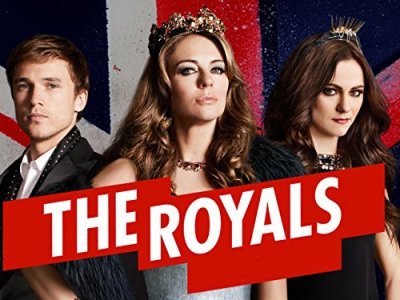 |
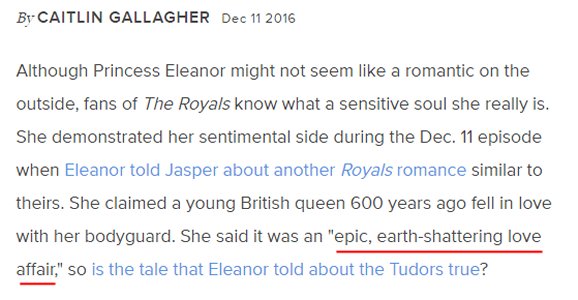 |
The 11
December 2016 episode of the TV show The
Royals revolved around the legendary story
of Owen and Catherine. As one can see, their
tale was an "epic, earth-shattering love
affair!"
Forgive
me, Father, for I am about to be catty.
As I
read further, I realized the writer of the 'earth-shattering
love affair' blog had basically accepted the
Owen-Catherine Fairy Tale hook, line, and
sinker. I doubt very seriously the writer dug
very deeply into the story. This is not
necessarily a good thing. After all, it is my
understanding that the motto of most TV shows is 'Why
let the truth get in the way of a good story?'
It is
scary to realize most of our history lessons these
days come from movies and television.
Currently our world is awash in a phenomenon known
as 'Fake News'. There has probably never been
a time when ignorance and superficial thinking has
been more prevalent. We base our decisions on
the words of people we don't know personally.
This may not be a very good idea. Rumor has it
our leaders deliberately tell fibs from time to
time.
I
suppose I am just as guilty as the rest of
superficial thought. I have based this entire
story about the War of the Roses on the ten
listings that appear on the First page of Google.
I pick a few a random and take a peek. If it
sounds intelligent, I borrow a few ideas. But
that doesn't mean they are correct. Most of
the time, I don't even know the name of the author.
Research
these days is little more than cut and paste.
It is shocking in a way how many websites simply
repeat what another website says VERBATIM. For
example, Wikipedia, the source for many of my
explanations, makes it effortless to cut and paste
passages into my stories. I love Wikipedia,
but I don't always trust it.
Every
now and then, I stop and think about it... I am
repeating the words of Wikipedia contributors who I
know nothing about. Here's another old
saying... you get what you pay for.
Wikipedia is free. The entire site was created
by volunteers. Who vets the Wikipedia writers?
I am
about to challenge the 'Owen-Catherine Fairy Tale'.
I believe this particular legend may not be what it
seems. In a sense, I will attempt to rewrite
history. If you find yourself agreeing with my
line of thinking, before you make up your mind,
please remember to ask yourself this question:
Do you really want to form your opinion based on
the words of a retired dance teacher who gets
his information from the Internet?
It all
boils down to Credibility. Question
everything, my friend.
|
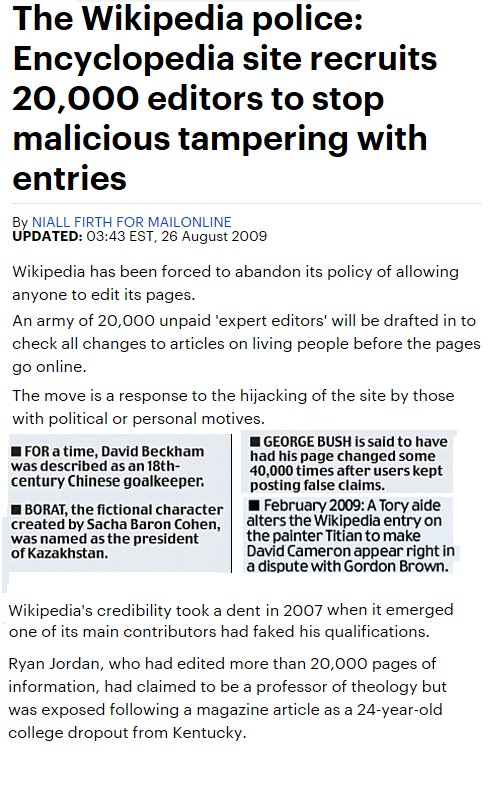 |
Scandal in the
Castle: Who's Your Daddy???
|
I
contend that the
weird circumstances surrounding Catherine's
pregnancy suggests an alternative explanation for
Catherine's risky behavior... Edmund Beaufort.
No one
is quite sure when Catherine's affair with Owen
Tudor began.
•
One
website suggested 'somewhere between 1427
and 1429'.
•
Another
website reported 'About 1428 or 1429'.
•
Another
website reported, 'Despite all of this, Catherine
did remarry in secret, sometime in 1431 or
1432'.
•
A
third website said, 'It is accepted that
Catherine and Owen were married sometime around
1429/30'.
I am not
making this up. In fact, I'm not making any of
this up. I just drift from website to website
compiling the information, then I try to sort it
out. Do you know what the words 'Somewhere', 'About',
'Sometime', and 'Around' mean to me?
These
words mean someone is guessing. It means no one
knows the truth about these dates because both the
affair between Catherine and Edmund and the affair
between Catherine and Owen were conducted in secret.
I would place a bet that there are no existing
written accounts of what took place in the castle.

The
passage above is another good example of the general
fuzziness surrounding Owen and Catherine's supposed
Love Story. I am starting to believe we have a
genuine mystery on our hands.
•
'many
tales, unsupported...'
In other words, no one knows
the true story of how Owen and Catherine hooked up.
•
'We
don't know for sure what position Owen held.'
This suggests that no
one ever wrote any history of this liaison.
•
'Despite
all the romantic embellishments by later writers.'
Someone makes stuff up
like the 'Lap Story' and the next person buys
it.
•
'It
seems that Owen and Catherine were attracted to one
another.'
Gee, can we possibly be less
certain about this?
I believe
the words above are the words of an ethical writer.
This person has taken a good look at the existing
data and realized this very well could be a fable of
some sort. Embarrassed at being forced to
regurgitate literary diatribe based on quicksand,
the writer has hedged his or her bet by qualifying
every single phrase for the simple reason that no
one has a clue what really happened.
So I
suggest we read between the lines... maybe there is
a cover-up going on here. Maybe this entire
love story is nothing more than putting lipstick on
a pig.
We
started this chapter by asking a question:
How did a lowly Welshman bed a Queen?
Six
centuries have passed since the Owen-Catherine Love
Story took place. Someone compared it to a 'Remarkable
Fairy Tale'. Every single writer focuses
on how incredible
it was that a highly desirable Queen could allow
herself to be seduced by
a lowly servant, a young man who actually risked
death to take this woman to bed.

Yes,
indeed, it all sounds very romantic, but at heart
the idea is preposterous when you stop and think
about. It is hard to believe the 'epic,
earth-shattering love affair' between Owen and
Catherine actually took place because it challenges
our reality-testing equipment to the extreme.
This story is absolutely begging for a better
explanation!!
I don't
deny something unusual took place between Owen and
Catherine. After all, while she was still
pregnant, Catherine left the comfort of the castle
with Owen and had four or five children by him over
the next few years while
living out in the country. The Queen
definitely built the final part of her life around
this man. That part is not in question.
| |
|
What I
am suggesting is that the Edmund Beaufort Rumor invites us to
reinterpret the initial stages
of the Love Story in a different
light. Since clearly no one really knows what
took place here, I have decided to offer my own
theory.
What would
Catherine do if Edmund Beaufort really was
the father?
The
truth is that a lowly Welshman does NOT bed a
Queen... but a Queen might bed a lowly Welshman
if she had a good reason.
Given
the general fuzziness regarding the time line, Catherine's
two affairs could very easily have overlapped in
some way.
Keep in mind that Edmund Beaufort was the
leader of the formidable House of Beaufort.
He had his entire career ahead of him.
He had possession of the vast lands known as
'Somerset' in southwest England.
Beaufort stood to lose everything.
Let us
return to that law forbidding Catherine to
marry. Some
highly vindictive men had made it a grave offense to
marry the Queen Dowager without their consent. That
law was passed in direct retaliation for Edmund
Beaufort's interest in Queen Catherine. Quite
likely, after the law was passed, extra scrutiny was
placed around the Queen just to be on the safe side.
Catherine began to look over her shoulder in case
spies lurked behind the curtains and under her bed.
Catherine had to do something to hide her
pregnancy before the spies figured it out.
If
Edmund was responsible for Catherine's pregnancy, is
it possible that Catherine would turn to Owen in order
to protect Edmund?
|
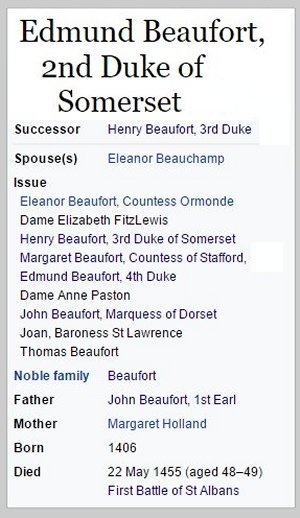 |
| |
|
 |
Gerald Harriss (1925-2014) was one of the
most distinguished English medievalists of
his generation. Harriss was an
eloquent interpreter of the workings of
English late-medieval political society,
illuminating not only its institutional
aspects but also the characters of its
leading actors, notably Cardinal Beaufort
(Edmund Beaufort's uncle).
As it turns out, I am not the only one with
a suspicious mind. In his book
Cardinal
Beaufort. A Study in Lancastrian Ascendency
and Decline,
Harriss
made
a strong case (pp.144,177-8)
for Edmund having
fathered one of
Catherine's later children.
Harriss had this to say about Edmund, Owen,
and Catherine:
Catherine may have
secretly married Owen Tudor to avoid the
penalties of breaking the statute of
1427–28. By its very nature the
evidence for Edmund 'Tudor's' parentage
is less than conclusive, but such facts
as can be assembled permit the agreeable
possibility that Edmund 'Tudor' and
Margaret Beaufort were first cousins and
that the royal house of 'Tudor' sprang
in fact from Beauforts on both sides.
(Harriss,
178 n.34)
|
| |
|
Take
note that the
findings of Gerald Harriss concur
with that of John Ashdown-Hill. This means
the only two recent historians to analyze
this story have
come to the same likely
conclusion. To date, no one
else with similar qualifications has stepped forward
to challenge them.
One can
imagine after that nasty law was passed, Catherine had the right to retain her
boyfriend Edmund. She just couldn't marry him.
Quite likely
this roughshod treatment aroused a sense of defiance in the
two young lovers. Perhaps they rebelled and
continued to conduct their relationship in a private
manner.
If so, who can guess how long they continued to see
one another? One year? Two years?
Various
website's suggest
Catherine's romance with Edmund Beaufort had started
in 1928. She became pregnant with her son
Edmund Tudor in October 1930. So
what was the punishment for getting her knocked up??
No doubt the ensuing scandal would bring holy hell
down upon the head of the sperm donor. And
there very well could be danger too.
Do you
know what kings don't like? They don't like
babies being born with potential claims to the
throne. Just watch the rate babies get
executed on Game of Thrones in an
attempt to eliminate heirs.
Babies being born the former Queen of England were
exactly the kind of babies that made people nervous.
So if you don't believe the father of Edmund Tudor
wasn't in danger, guess again.
Now
let's pretend to enter the mind of some vindictive
asshole on the English Council.
Oh my God, a baby is about to be born to the
former Queen of England! If it is a boy,
thanks to Catherine's lineage, the child will
have a legitimate claim to the crown of France.
The Frenchies will absolutely flip out!
Furthermore, this kid could cause a lot of
trouble when he gets older. Edmund
Beaufort is a leading member of the House of
Lancaster and the House of Beaufort, two
prominent families with money and powerful
political friends. Whoever is king at the
time will have his hands full. Something
needs to done.
On the
other hand, what if the child belonged to Owen
Tudor?
Oh my God, a baby is about to be born to the
former Queen of England! If it is a boy,
the child will have a legitimate claim to the
crown of France. The Frenchies will absolutely
flip out! What was this idiot woman
thinking? However, we caught a break.
This Owen Tudor fellow is a lowly Welshman.
By law, the Welsh do not have the right to
ascend to the throne. No child born to
this man has any birthright, so we dodged a real
bullet here. Whew! That was a close
call.
| |
|
 |
| |
|
Rick Archer's Note:
Before we continue, let me review the
mythology, er, rather the written history.
It has been reported
that Edmund Beaufort, Duke of Somerset,
sought to marry the Dowager Queen and it
may very well have been that Katherine
returned these feelings. In
response, Parliament set out a statue
which stated that no man was allowed to
marry a former queen of England without
a special licence and permission from
the King.
If a man dared to
marry a former queen then not only would
he forfeit his lands and tenements, he
would also forfeit his life.
Edmund Beaufort, the Duke of Somerset,
paid heed to this statue and reined back
his intentions.
However, Owen Tudor
was a completely different story.
Reported to be a squire in the service
of the dowager queen, Owen Tudor soon
caught the queen's attention. There are
various stories as to how this happened,
one being that while dancing Owen fell
into the queen's lap, another being that
she spied him while he was swimming
naked. Whatever the true story is,
the pair married in secret, going
against the statute of parliament.
Soon
Owen Tudor
impregnated Queen Catherine with a boy
to be named Edmund Tudor.
|
| |
|
But what happens if Edmund Beaufort was the
true father? That would give Catherine
a legitimate reason to deliberately wrap her
baby boy up in sheep's clothing. By
disguising the true identity of the father,
she could avoid having Beaufort incur the
wrath of the English Council.
So
is
John Ashdown-Hill correct about Edmund Beaufort
fathering Catherine's child? Or was
he just
making a fortune by spreading some ancient gossip around? Your
guess is as good as mine, but I will say Dr.
Ashdown-Hill does appear to have more a bit
more knowledge on the subject than your
average person (and maybe even more than
me!) Consequently, for the sake of
argument, let's go out on a limb and assume
Dr. Ashdown-Hill is correct.

I don't know about you, but I just can't
seem to get past the odd coincidence of the
matching names. Considering I am taking someone else's word for
every single thing that I write in this article, I am
hardly in any position to suggest I know what the truth is
here. Nevertheless, I will be bold and risk
muddying the waters a bit further.
I have a question...
Why on earth
would Catherine name her son 'Edmund' if her
lover Edmund Beaufort was not the father? Why
would she give nosey people the slightest reason
to draw undue attention to whom the father might be,
especially at a time when the father could be
imprisoned or executed for breaking the ridiculous law?
Before I start answering this curious
question myself, the history books say that
Catherine and Owen left the castle while
Catherine was still pregnant.
Catherine had her son at some estate out in
the country far beyond prying eyes. It
was there that she named her baby boy 'Edmund'.
1. Out in country,
Catherine might have felt safer about
taking a chance with the name.
2. Presumably her
champion
Owen
was at her side when she named the
child.
So I ask again:
Why on earth
would Catherine name her son 'Edmund'
if her lover Owen Tudor was the father?
|
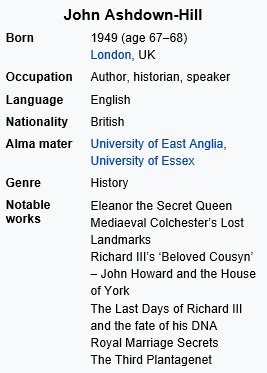
BA in History and French from University of
East Anglia
MA in Linguistics from University of Essex
PhD in medieval history from University of
Essex
|
| |
|
My
theory is that Catherine used Owen Tudor to protect
Edmund Beaufort.
Edmund
Beaufort had a considerable amount to lose. If
Catherine was pregnant and it was discovered that
Edmund Beaufort was the father, the ensuing scandal
would have cost Beaufort his political career at the
minimum, conceivably even his life or his estates. It
definitely would have guaranteed him a visit to the
Tower of London for violating that statute in some
way or another. So, if Edmund Beaufort was
indeed the father, surely he pleaded with
Catherine to protect his identity.
If so,
did this mean that Catherine needed to find another
suitor ASAP to give her pregnancy a cover story?
Given that Catherine didn't have a wide selection of
potential lovers given the tight security
surrounding her, perhaps Owen Tudor was her only
choice. Or quite possibly, she did have other
men around, but they all had money. Owen, on
the other hand, was poverty-stricken. Maybe
that worked in his favor.
|
|
|
As it
turned out, by the time Catherine gave birth to
Edmund Tudor on 11 June 1431 (a date some contest), she was heavily
involved with her new boyfriend Owen Tudor.
Catherine likely became pregnant in October 1930.
Was there a chance Catherine was still seeing Edmund
Beaufort at that time? Maybe. So let's
pretend we can read the mind of Catherine.
Call it Scenario One.
I, Catherine, am 30 years old. Recently I
broke up with my long-time boyfriend Edmund.
Been feeling kinda lonely lately and I met this
new guy Owen. He works here at the palace
keeping my wardrobe in order.
Owen is this really good-looking Welsh guy, you
know, a medieval hunk if I ever saw one. Lately
I have been distracting him from his job.
One day Owen caught me in one of those moods.
There was a spark and I lost it. Something happened.
Now I want it to happen
again and again.
But I have a big problem. I'm pregnant!!!
There is no way it could be Owen's child.
It has to be Edmund's child. I am sure of
it. In fact, I know when it happened.
Back in October, Edmund and I had been drifting apart, but
one night he came over for my birthday
party. Too much wine, not that awful
English stuff, but good French wine. You
know how it goes, he looked at me, I looked at
him and we had one more fling for old times sake.
Now look at me.
I am going to have to tell Owen about this. If the child is a boy, I
wonder if Owen would mind very much if I go
ahead and name my baby after Edmund. Are Welsh guys touchy about this sort of thing?
But you know, if I really and truly want to name
my son after my ex-boyfriend, surely Owen won't
doubt my love for him...
|
 |
| |
|
Catherine claimed the baby belonged to
Owen Tudor. Let's do another scenario and
assume she is telling the truth. Call it Scenario
Two.
This thing with Owen is so special. I am
wild about the guy. Unfortunately he is
taking a real chance by sneaking into my room at
night. People watch me all the time and I
know they are suspicious. My ladies in
waiting are already onto me, I am sure of it.
This is very dangerous. Owen is breaking the
law by sleeping with me. If the wrong
people discover our relationship, Owen could be
put in prison. I am surrounded with people like
that. Sometimes I really hate my life.
Now I have another problem.
I'm pregnant. It is Owen's
child, no doubt about it, but I want to name my
baby 'Edmund'. As the former Queen, that's
my right, isn't it? I'm sure it's a boy
and I so much want to name him in the memory of
my old boyfriend. I wonder if Owen would
mind? Are guys sensitive about these
things like this?
Owen said something about wanting to name the
child after him. You know, I get it. I really do see his
point. Every dude in France and England
names his first son after himself. So when Owen brings up
'Owen Junior' or 'Owen the Second', I guess I can see
where he is coming from. But you know
what? I get so tired of all these Louies and Edwards and Henrys I could just
scream sometimes! How does a girl tell
them all apart? Stamp a Roman numeral on
their forehead, that's what I say.
The way
I look at it, if I really and truly want to name
my son after my ex-boyfriend, surely Owen won't
doubt my love for him. I will make a deal
with him. The next boy will get his name
(Note: their third son was named Owen).
For the record, I was named 'Richard' because my
uncle Richard was my mother's favorite brother.
Most women name their sons after someone they like,
someone special. In Catherine's case, there
was only one Edmund in her life. Because
Catherine was French, there were no 'Edmunds' in
Catherine's family. So I ask again... why
would she name her son 'Edmund'?
Since I
am a guy, I feel at
least somewhat qualified to offer the male
perspective here. If I found out my wife or my
hot and heavy lover was going to name her child of suspect
parentage after her old boyfriend, I would
absolutely
raise the castle roof. This is why I suspect
there could be a third scenario... one that no
website that I have come across has suggested.
We
started this chapter by asking a question:
How did a lowly Welshman bed a Queen and start a
dynasty?
The
official Henry VII propaganda story is that Henry's
grandfather was the product of a magic love affair
between a servant and a Queen. Oh, how
wonderfully romantic!! But what if that is
complete hogwash?
What if Catherine decided that taking Owen as her
lover was her only way to protect Edmund Beaufort?
|
| |
|
Think
about it. If Catherine still cared for Edmund
Beaufort, she would have to disguise the nature of
her pregnancy. Edmund Beaufort had a lot to
lose, but what did a nobody like Owen Tudor have to
lose besides his head?
The only
question at this point is how would Catherine
approach the situation. Would she sit down and
strike up a bargain with Owen in a business-like way? Would she have
the guts to openly discuss the problem and ask Owen
what he thought about giving Edmund Beaufort a cover
story?
You
know, I have to say I doubt it. I find it very
difficult to imagine a Queen would humble herself by
politely asking a servant to get involved in a very
dangerous affair. I think any legitimate femme
fatale would do it the easy way. There is a
great movie called Body Heat.
That movie makes it very clear what a good-looking
woman can get a guy to do after she has had sex with
him a few times.
All
Catherine had to do was undress and knock the
poor boy's lights out. After all, no
self-respecting Welshman could possibly resist
hitting on a naked Queen who looks like Catherine.
That's where I would place my bet. So let us
try to read the mind of Owen Tudor. Call it
Scenario Three.
Good grief, the Queen must be out of her mind!
I was trying to hang up some of her dresses in
the royal closet last night. The Queen
snuck up from behind. First she put her
arms around me, then she turned me around and kissed me.
I was pretty fearful, but she dragged me into her
bed. I tried to resist, but you know how
it is. Once the Cat Lady dropped her cloak and
told me she wanted me, I was helpless to the
heat. That is one beautiful woman.
Not only that, the Queen is insatiable.
Every time we finished, she stroked me until I
was ready to start anew. Over and over and
over again.
On the spirits of my dead ancestors, I cannot
imagine what I did to deserve this. That
woman wore me out. I can barely move today!
Catherine said she had something she wanted to
talk to me about. I wonder what it could
be...
That led to Scenario Four. I imagine that once
Owen became Catherine's lover, at some point
Catherine came to him with a distraught look on her face.
"Owen,
oh no, I am in so much trouble. I have just discovered I am pregnant!
I am so sorry, but that it can't possibly be
your child. I wish it was your child, I
love you so much, but it has be Edmund's child.
Owen, I need your help..."
So was 'Love' involved or not? Not at
first. I think this Love Story started out as
deception on Catherine's part. While Owen
thought he was part of a magic romance, Catherine
was setting up her alibi. I think once
Catherine had Owen wrapped around her finger, maybe
she offered some candor about her problem, maybe
not. Drawing upon Owen's likely infatuation, I
think Catherine persuaded him to move out of the
castle with her, move to the country and claim her child as his.
This would
give Edmund Beaufort the protection he needed.
Once Owen agreed to the scheme, maybe he quietly
resigned his job and disappeared. A couple weeks
later, Catherine told the officials she had decided
to live away from court. They reunited at her
palace in Hertfordshire
30 miles north of London. Probably no one even
noticed the two events were connected.
Catherine had her baby out in the countryside away from
prying eyes. She said the child belonged to
Owen Tudor and no one bothered to dig deeper since
Catherine stayed out of politics from that point on. The
reports say that Catherine stayed off the radar for
several years. She came to visit her son
Henry VI from time to time, but always kept it
low-key.
What
about Owen? Look at it from Owen's
point of view. If he saw things in a practical
way, he had much to gain here... a relationship with a beautiful woman, the status of marrying
the former Queen, the very real possibility their
son could be a royal someday (French royal blood),
and the considerable estate that Catherine
possessed. In other words, Owen was in the
right place at the right time to luck into something
very good. His station in life was
dramatically elevated. All Owen had to do was
swallow his pride a little.
The
evidence suggests that Owen and Catherine did
develop something special once removed from public
scrutiny. The two of the lived in the country
away from the limelight, always doing their best to
keep a low profile. During this time, they had
five children. Edmund, Jasper and
Owen, the three sons born to the couple, were all
born away from court. Out of sight, out of
mind.
|
 |
| |
|
If my
fanciful 'alternative story' is correct, we
have a very plausible answer to the question of how
a lowly Welshman bedded a Queen and started a
dynasty. It was Catherine's idea all
along!
Personally, I believe
that Edmund Beaufort is the likely father of Edmund
Tudor. I say this simply because no woman in her right mind would
insult her new lover without a damn good reason.
Since he failed to object, I contend Owen had to
know exactly what was going on!!
My
opinion contradicts the history books.
Catherine publicly stated that Edmund was the son of
Owen Tudor, so maybe Owen Tudor was the father just
like Catherine said he was.
But I
doubt it. So does historian John Ashdown-Hill,
a man with a formidable reputation.
In
addition to his doctorate in history, John
Ashdown-Hill is a member of
the Most Excellent Order of the British Empire,
a Fellow of The Society of Antiquaries, a Fellow of
the Royal Historical Society, and a member of the
Society of Genealogists, the Richard III Society,
and the Centre Europeen d'Etudes Bourguignonnes.
I would guess that this gentleman is eminently
qualified to comment on this story.
As for
my own credentials, they are non-existent in the
field of history. I fully admit I have no
credibility which explains why I have chosen to ride the
coattails of this esteemed scholar.
The bottom
line is that neither Dr. Ashdown-Hill nor I believe
the Owen Tudor-Fair Catherine Fairy Tale took place
as reported.
|
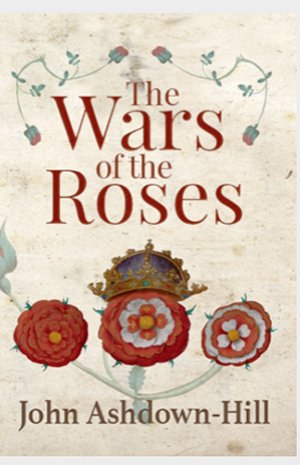 |
| |
Whatever
the truth, ultimately it doesn't make much
difference who the father was. Edmund Beaufort
or Owen Tudor, either way Edmund Tudor was
illegitimate. Harsh words, but let's get one
thing straight... there has never been any direct
evidence for the lawful marriage of Owen and
Catherine. No witness stepped forward nor did
any written record of their marriage exist.
Centuries have passed, but no one has yet to find a
time or a place of Owen's marriage to Catherine.
They were 'married' simply because Henry VI
said so when he legitimized the Catherine/Owen
children in 1452.
Ordinarily I wouldn't make such a fuss about
something as absurd as Edmund Tudor's parentage
except for the fact that we are talking about the
start of a royal dynasty here. Unsurprisingly, Henry the Seventh was
said to be extremely touchy about this
particular subject. There is a saying
that history is written by the
winners. I suspect that once
Henry VII finished rewriting the 15th century
history books, the English people were expected to
believe that his origins lie in a curious romance
that defied all common sense.
Faced
with accounts that are sprinkled with the words 'legend'
and 'about', we will never know the truth.
Catherine was
an isolated, lovelorn widow
who died without ambition
or accomplishment. She left us no
diaries, no recorded
personal thoughts, and no
interesting speeches. Her
only deeds of note were to give birth to a crazy
king, Henry VI, and an illegitimate son named
Edmund.
And that’s all history
would have known of her if not for the fact that
Henry VII's propaganda machine
worked so hard to make us believe an
astonishing tale that a Queen
would somehow stoop so low as to share her bed with
a servant based on 'love'. Yeah, nice
try, Henry.
|
Final Thoughts on Owen and
Catherine's Story
|
After I
finished writing my story about Owen and Catherine,
I found myself curious to know if there was a
different Edmund in Catherine's life that might
explain her choice of the name. I
decided to poke around a few websites and look for
another reason to explain the Edmund/Edmund name
coincidence. After a considerable amount of
time, I did find something interesting:
The name Edmund is believed to have been chosen
for Edmund Beaufort, Duke of Somerset, whom
recent unproven theories suggest was actually
his father. But a more likely explanation
is that Beaufort stood as the child's godfather
at his christening. It was a common
practice at the time to name a child after a
godparent. (source)
I was not at all satisfied with this explanation.
The explanation seemed unbearably convenient.
Edmund Beaufort would have been between 22 and 24 at
the time of Edmund Tudor's birth. Isn't that a
bit 'young' to be named as a godfather?
Would not the former queen of England be able to
find someone a bit older and more respectable to be
the child's godfather than her former boyfriend?
And how would Owen feel about her former boyfriend
being named as godfather? (Yes, we are back to
that again).
Nevertheless, I decided the explore the 'godfather'
explanation a bit further. So I went to Google and
typed in: edmund tudor godfather
Lo and
behold, I discovered a scholarly attempt to settle
the same question: Why would Catherine name her
son 'Edmund'?
The
following is an excerpt. You can read the
entire thread yourself
here.
From: "Tony Hoskins"
Subject: Edmund Tudor a (Beaufort-)
Plantagenet?
Date: Sat, 11 Aug 2007 10:54:28 -0700
I raise this matter again.
"Around 1424, rumours about her [Catherine
of France, Queen of England] connection with
Owen Tudor were heard."
The naming of their first child, Edmund
Tudor, has also led to serious speculation
on whether Henry VII, Edmund Tudor's son,
descended from Beauforts on both sides of
his pedigree."
Edmund Tudor's birth date seems vague.
Since arguably Edmund Tudor might just have
easily have been born from say about
1427-1432, his father might well have
been Edmund Beaufort, known to have
been a suitor for Queen Catherine at least
in 1427/8.
Jones also says:
"[Queen Catherine] may have taken
Tudor as her husband to prevent her true
love, Edmund Beaufort, suffering the
penalties of the statute of 1428, since Owen
had so few possessions to forfeit."
That the widowed Queen Catherine's eldest
son should be named Edmund - a
name appearing in neither the families of
Owen Tudor nor the Valois - taken in
conjunction with the chronology, the vague
dates, and the known attraction c.1427/8 (at
least) between Queen Catherine and Edmund
Beaufort is striking.
Does anyone have any thoughts or comments on
this?
Tony Hoskins
Anthony Hoskins
History, Genealogy and Archives Librarian
History and Genealogy Library
Santa Rosa, California 95404
Here are
excerpts of what Tony Hoskins' colleague
Brad Verity wrote in reply:
•
And
who else in the royal family should
stand as godfather to a son borne by the
queen as a result of a marriage to a man
of lesser social standing that was not
known to the public, or even to the
royal council? Conceivably a
number of others could be godfather.
But why Edmund Beaufort?
•
The
alternative explanation is that Queen
Catherine named her bastard son Edmund
because that was his father's name,
which seems the best way of any of
trumpeting the child's true paternity -
a stupid decision if the point was to
hide the fact.
•
The
Queen secretly marries a low-level chump
instead in order to prevent the real man
she loves from losing his lands?
•
There
is supposed to be evidence of the "hot
and heavy" relationship with Owen.
I know of none, save the abundant
mythology surrounding Catherine and
Owen. There *is* on the other hand
documentation of the Queen's passion for
Edmund Beaufort.
•
The
fact is that Catherine kept it well
hidden. Perhaps the "secret
marriage" to Owen Tudor was kept
purposely murky as to specifics because
it covered up the fact that her son
Edmund was born illegitimately to the
Queen and Edmund Beaufort, and that the
clandestine nature of her subsequent
marriage to Owen - after the fact of
Edmund "Tudor's" birth - allowed for
cover.
•
The
case for Edmund Tudor being Edmund
Beaufort's son is plausible on many
levels.
From: "D.
Spencer Hines"
Subject: Re: Edmund Tudor a (Beaufort-)
Plantagenet?
Date: Sun, 12 Aug 2007 09:40:01 +1000
Desperate, Rampant
Speculation.
Amusing...
Rick Archer's Note:
I have
mentioned this thread to show that I am not the only
one who finds the matching Edmund names to be
disturbing. The thread makes it clear that the
Edmund Tudor-Edmund Beaufort parentage question is
considered a very real possibility in scholarly
circles. And yet at the same time, D. Spencer
Hines readily dismissed the entire thought.
Hines later added that 'Tony [Hoskins] is living
in Fantasy Land'.
Whatever
the truth here, something remarkable did appear to
take place between Catherine and Owen after they
left the castle.
As a poignant
footnote to this story, Owen and Catherine had six happy years together
(1430-1436). Unfortunately,
their quiet life came to an end in 1436.
Catherine was pregnant with her fifth child by Owen
Tudor when rumors of the Queen's secret marriage
reached the ear of Humphrey, Duke of Gloucester, the
ever-present villain in this story.
Humphrey
immediately had Owen
imprisoned on a charge of treason. Deeply
distressed and traumatized at the forced separation
from her husband and children, Catherine went to
Bermondsey Abbey to have her child. Shortly
after giving birth to their daughter Margaret,
Catherine fell gravely ill and died quickly.
She was 35. There are reports that she died in
disgrace. No mention of her marriage to Owen
Tudor was made on her gravestone.
Upon Owen's
arrest, the queen believed there was no chance of
reuniting. Without hope, some say Catherine died
because she wanted to.
As it turned
out, the Queen was wrong. Several years later,
Owen Tudor was released. Sad to say, he became
an early casualty in the Wars of the Roses.
Owen joined his son Jasper's army in Wales in
January 1461, a force which was defeated at the
Battle of Mortimer's Cross by Edward of
York (Edward IV). Owen Tudor was captured and
beheaded following the battle.
Moments before
his execution, Owen murmured, "my head shalle ly on
the stocke that was wonte to ly on Quene Katheryns
lappe."
I have
suggested that Catherine may have exploited Owen in
the beginning to provide cover for Edmund Beaufort.
Whether this is true or not is anyone's guess.
What I am touched by is the evidence that these two
people went to their death loving each other
intensely.
The expression
'epic, earth-shattering love affair' may not
have missed the mark after all.
|
 |
Margaret Beaufort,
the Red Queen
Margaret Beaufort was the Red Queen of
Lancaster to
Elizabeth Woodville's White Queen of York
during the War
of the Roses. During Act One and Act
Two, the two women
were on opposite sides, but would become allies
late in the game to help bring down Richard
III, the villain of Act Three.
Margaret
would marry Edmund Tudor, the much-discussed
illegitimate son of Owen and Catherine.
Together they produced Henry Tudor, the
man who would one day become King Henry VII, the
first ruler in the Tudor Dynasty. In many ways,
Margaret Beaufort's passion to advance her son
Henry Tudor to the throne matched that of her predecessor Margaret of
Anjou in regards to her son Edward. Margaret
B. would stop at nothing.
Margaret
Beaufort was a direct descendant of King Edward III
through his son John of Gaunt. There is a
chart below to help follow my narrative.
John of
Gaunt had a wife, Blanche, and a
mistress, Katherine Swynford.
Through
Blanche, John was the forefather of three kings:
Henry IV (Bolingsbroke), Henry V
of Agincourt fame, and Henry VI whose
madness caused the War of the Roses. When
Edward, son of Margaret of Anjou, died at
Tewkesbury, this line died out.
John of
Gaunt produced a second line through
Katherine Swynford, his mistress whom he
married late in life. Her three children were
illegitimate, but later legitimized by King Richard
II in 1390.
John Beaufort, the First Earl of Somerset,
had two sons. His oldest son, John Beaufort,
the First Duke of Somerset, had only one child...
Margaret Beaufort. His second son,
Edmund Beaufort, the Second Duke of
Somerset, is the one who caused all the trouble.
Edmund had three sons, all of whom died fighting in
the War of the Roses. Edmund Beaufort also had
two illegitimate sons. One, Edward by Margaret
of Anjou, died fighting at Tewkesbury.
|
|
|
|
The other illegitimate son, Edmund
Tudor, married Edmund Beaufort's
niece Margaret Beaufort to
produce Henry Tudor. If one believes
that Edmund Beaufort was Edmund Tudor's
father, then Edmund Tudor was Margaret's
first cousin, in which case the royal house of ‘Tudor’
sprang in fact from Beauforts on both sides.
This would be very ironic. Edmund
Beaufort, the leader of the House of
Lancaster, was the big loser during the War
of the Roses. In addition to getting
himself killed, his three sons were killed,
his son-in-law was killed, his grandson was
killed, and one of his illegitimate sons was
killed. Through his family's pursuit
of the throne, the entire male line of the
Beauforts was extinguished.
Now only Edmund's niece Margaret Beaufort
was left, which explains how she became the
head of the House of Lancaster. Thanks
to Margaret, Edmund Beaufort's bastard son
Edmund Tudor found the Tudor Line. In
order words, Edmund Beaufort's ambition eradicated the
House of Beaufort, but he also secretly
started the House of Tudor. Very
curious.
As one can
see, the future Henry VII was born
with a claim to the English crown which was
threadbare and
ridiculously complicated.
So let me simplify things... his mother
Margaret Beaufort would
supply enough royal Plantagenet blood to allow
her son
Henry to become king in 1485.
In my
opinion, Margaret Beaufort was the most remarkable
woman of her era. She was blessed with talent
and tremendous wealth, yet had to overcome
unbelievable hardship to finally take control of her
life.
Despite being one of the
wealthiest women in England, Margaret
Beaufort (1443-1509) went from a position of
complete powerlessness to
one of almost total power.
We
already know that Margaret was a direct descendant
from the wealthy family of John of Gaunt. As
the first son of her grandfather John Beaufort,
Margaret's father John Beaufort inherited vast
estates as the Duke of Somerset.
John
Beaufort had endured 17 years as a prisoner of war,
the longest imprisonment of any English aristocrat
during the Hundred Years War. By the time of his
release, John was an embittered man, broken in both
body and spirit, heavily in debt. Beaufort
returned to England long enough to sire Margaret,
his only child, but then was immediately
ordered to return to France for more fighting.
|
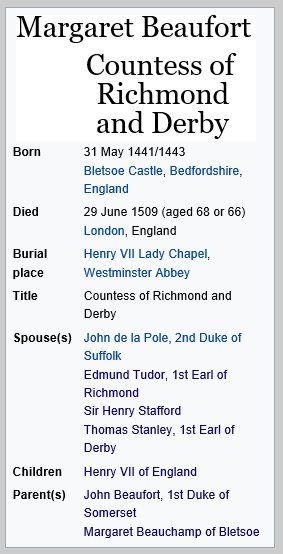 |
| |
|
|
Margaret
never knew her father. At the
moment of her birth, her father was preparing
to go to France to lead an important military
expedition for King Henry VI. Beaufort
negotiated with the king to ensure that in case of
his death the rights to Margaret's wardship and
marriage would be granted only to his wife Margaret
Beauchamp. (Under English law, as a
tenant-in-chief of the crown the wardship of
Beaufort's heir fell to the crown under the feudal
system.)
|
| |
Alas,
Margaret's father was a notable failure as a
military commander just about the time Margaret was
born. His blunders in France contributed
directly to the loss of many French territories
towards the end of the Hundred Year's War.
John Beaufort fell out with the king after coming
back from France and was banished from the royal
court pending a charge of treason against him.
He committed suicide shortly afterwards in 1444.
John
Beaufort was not the only failure. His brother
Edmund Beaufort had failed even worse. The
lasting effect of the two Beaufort failures was burning
resentment between the House of York and remaining
members of the Beaufort family. This would
create the intense rivalry between Edmund Beaufort
and Richard of York that led to the War of the Roses
in 1453.
Margaret, as an only child, was heiress to her
father's fortune. Upon her first birthday,
King Henry VI broke the arrangement with Margaret's
father and granted the wardship of her extensive
lands to William de la Pole, 1st Duke of Suffolk,
although Margaret herself remained in the custody of
her mother Margaret Beauchamp. Margaret knew
happiness in her mother's home for three years, but then
she was yanked away.
Apparently Margaret's mother Margaret Beauchamp did
not have much say-so in the matter of her own
daughter. Incredibly, at age 4, Margaret was
taken away to live with William de la Pole and his
wife. Two years later, Margaret was married.
Yes, you read that correctly. Before his
death, William de la Pole managed to arrange the
marriage of his young ward Margaret to his son, John
de la Pole. Margaret was six years old!!
Her groom was an older man, seven. The reason
for the marriage? De la Pole had been arrested
and was looking to secure his son's future.
Imagine being six and married.
In 1449,
Henry VI dissolved this sham marriage and granted
Margaret's wardship to his own half-brothers, Jasper
and Edmund Tudor. Margaret was 8. Her
two new 'parents' Edmund and Jasper were
teenagers only about 10-12 years older than she was.
|
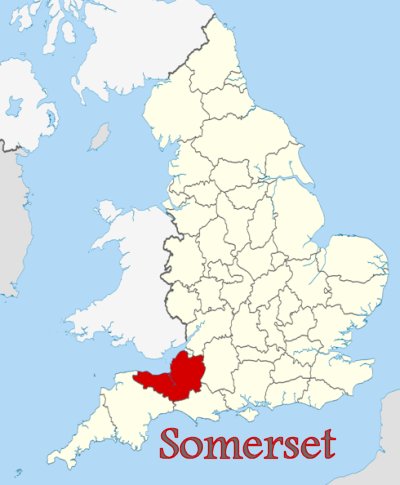 |
| |
|
 |
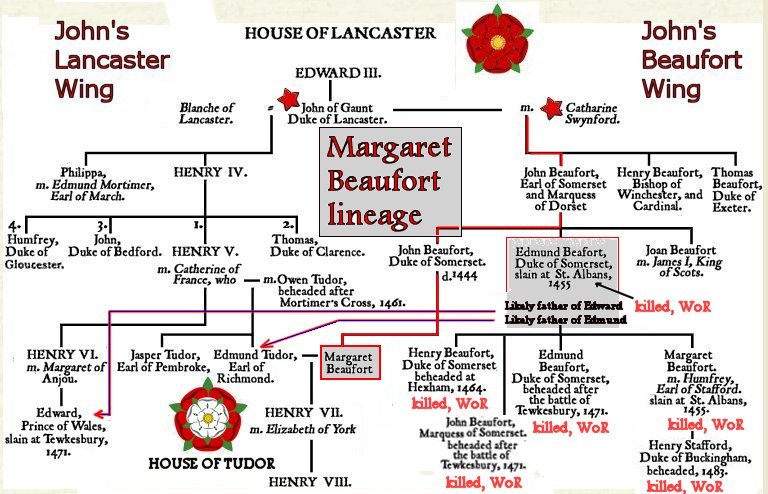 |
Edmund and Jasper
Tudor
Edmund
and Jasper Tudor were born five months apart in
1431. Or so Wikipedia says. Wikipedia
lists Edmund's birthday as June 1431 and lists
Jasper's birthday as November 1431. The truth
is that all these birthdays are guesses. If
indeed Edmund Beaufort was really Edmund Tudor's
father, Edmund could have been born anywhere from
three to four years earlier. No one really
knows.
Thanks
to their mother Catherine, Edmund and Jasper were
half-brothers to King Henry VI who was approximately
ten years older.
Henry had
no idea of their existence until 1436. There
was a good reason for that... Catherine kept the
existence of her family a secret to avoid
persecution. It didn't work. In 1436,
someone informed Humphrey, the Regent, about
Catherine's family.
Owen Tudor
was arrested and sent to Newgate prison.
Catherine died at Bermondsey Abbey a few months
later as a consequence of giving birth to her
daughter. On her death bed, Catherine told
Henry the whole story.
Owen
Tudor was released from prison in 1439 thanks to
Henry VI. Henry granted him a general pardon,
restoring his goods and lands
At his
mother's dying request, Henry would also begin to
care for the children. Jasper, Edmund, and
possibly their sister were put into the care of
Katherine de la Pole, a nun at Barking Abbey, in
Essex, from 1437 to 1442. The de la Pole
family was a great favorite of Henry VI.
Katherine was the sister of William de la Pole, 1st
Duke of Suffolk, the family that was caring for
Margaret Beaufort. As one can see, the de la
Poles were the connection that bound the fortunes of
the Tudor boys and the Beaufort girl together.
In 1442,
Henry VI, now 21, began to take a greater interest
in the boy's upbringing. Jasper and Edmund
were brought to live at court. Henry arranged for
the best priest to educate them intellectually and
morally. The brothers also received military
training; when they grew up they were given military
positions. During this time, Henry grew very
fond of the two boys and trusted them.
In 1445,
Henry VI married Margaret of Anjou. Margaret
was more or less the same age as the two boys.
The three of them got along just fine.
Margaret could see they had her husband's best
interests at heart. In addition, they had no
blood ties to the English throne, so they were not a
threat.
In 1452,
incredibly, Henry VI interfered with Margaret
Beaufort's life again. William de la Pole had
come into great disfavor with Henry, so Henry
decided to grant
custody of Margaret to his two half-brothers, Edmund,
21,
and Jasper Tudor, 20. Now that Henry VI had
come of age, he had the power to give earldoms to
both brothers. Jasper became Earl of Pembroke 1n
1452 and Edmund became the First Earl of Richmond.
In turn, Edmund, 23, and Jasper, 21, gave Henry
unwavering loyalty. They fought for the Lancasters and promoted Henry's
interests unwaveringly throughout their lives.
|
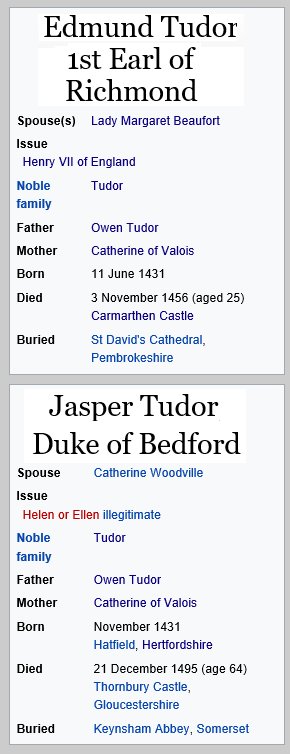 |
| |
1453 was
the year all hell would break loose in England.
England lost the Hundred Year's War, Margaret of
Anjou was pregnant with Edmund Beaufort's
illegitimate child, Henry VI collapsed into a
catatonic state, and Richard of York was pushing
hard to be named the heir presumptive of England.
In 1453
William de la Pole fell into disfavor. Shortly
before his 1453 descent into madness, Henry
VI dissolved Margaret Beaufort's first marriage and made her
a ward of Edmund and Jasper with the understanding
that Margaret, 9, would marry his half-brother
Edmund went she grew old enough at age 12.
In March 1453, Edmund and Jasper were given joint
custody of Margaret Beaufort, heiress of the Duke of
Somerset.
Two
years later England was now embroiled in civil war. Margaret
was 12 when she married the 24-year-old Edmund Tudor
on 1 November 1455. The Wars of the Roses
would cast a dark cloud over their
marriage. About four months after the wedding,
Edmund was sent to uphold the authority of the King
in South Wales. While he was there, Richard of York
was overthrown by the re-awakened King Henry.
In retaliation, Yorkist forces were sent to engage
those of Edmund Tudor in South Wales. Edmund
was captured at Carmarthen Castle. He would
die in captivity of bubonic plague on 3 November
1456.
Margaret
was seven months pregnant with their child when
Edmund died.
Taken into the care of her brother-in-law Jasper at
Pembroke Castle, the Countess gave birth on 28
January 1457 to her only child, Henry Tudor, the
future Henry VII of England. The birth was
particularly difficult due to
her young age and small size. At one point, both the
Countess and her child were close to death
Margaret would never give
birth again. In fact, sex was so painful that
Margaret could barely stand the thought. At
13, an age when some girls were still playing with
dolls, Margaret was widowed with a baby boy and
living in Wales, a rough and tumble world akin to
living in the Wild, Wild West.
|
Henry Stafford
Keep
these three dates in mind: 3 November 1456.
28 January 1457. 6 April 1457. Unless my
math is wrong, each date is about two months apart,
yes? Husband dies, child is born, next
husband begins.
Margaret
was forced to marry at age 6, a thought our modern
minds find inconceivable. Her next experience
was marriage at 12 to a man twice her age and twice
her size. That marriage was a nightmare.
First her new husband practically ruptured her
having sex at too young an age. Then she
discovered Edmund was dead one year after the
wedding. Two months later she gave birth, an
act that left her physically damaged in child birth
and psychologically scarred.
Margaret
was understandably terrified of being stuck with
another husband against her will. So Margaret
took matters into her own hands. Before her
child was even born, Margaret was already searching
for her next husband. Margaret set her eyes on
Henry Stafford, 32, the younger son of the Duke of
Buckingham. It was a shrewd choice, a political
transaction, not a personal one. It was also a
really gutsy move.
|
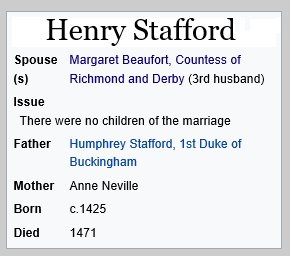 |
| |
|
To
request this marriage, Margaret was supposed to get
permission from Humphrey Stafford, Henry Stafford's
father. This meant a 13 year old girl went to
see a 54 year old man to ask if she could marry a 32
year old man. One can only wonder if she
waited till her child was born to go ask. Does
anyone besides me see the humor in this??
Humphrey
Stafford was not just the powerful Duke of
Buckingham, he was the most important member of the
Lancastrian court. This meant Margaret, age
13, 5 feet tall, 90 pounds, was meeting a 54
year-old peer of the realm to propose a marriage.
Mind you, these were the days when men ran the show.
Yet frail Margaret, a remarkable teenager to say the
least, was going toe to toe with one of England's
big shots. No doubt Margaret's confidence was
assisted by the fact that she was a wealthy heiress
of royal blood.
The Duke
of Buckingham approved her offer. However,
there was one problem... they were second cousins,
so they needed a special dispensation in order to be
married. The approval came through on 6 April
1457. This date took place just two months
after Margaret gave birth on 28 January 1457.
The Countess had endured a rough childbirth, being
close to death after childbirth. Nevertheless,
Margaret bounced back quickly. She got off her
death bed and immediately landed her next husband.
Impressive.
Incidentally, before I take this story any further,
let me warn the reader of an impending deluge of
identical names. It took me an hour just to
figure out there were two different Margaret
Beauforts existing side by side. Both
Margarets had Beauchamps for mothers and both
Margarets married Staffords. Talk about
confusing!
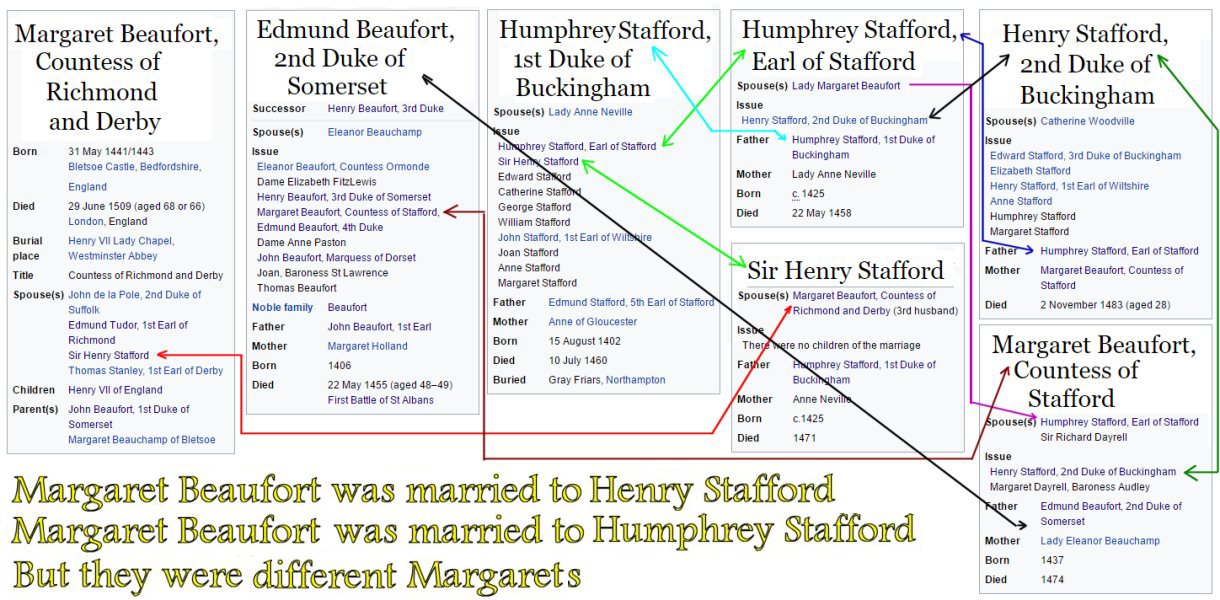
|
There
was quite a bit of irony in Margaret's marriage to
Henry Stafford... a special dispensation was
required for the marriage of Margaret Beaufort and
Henry Stafford because they were second cousins.
What was funny here is that previously Margaret Beaufort had unknowingly married
her first cousin Edmund Tudor.
Let us
not forget that Edmund Tudor potentially carried the
madness of French king Charles VI. With all
this inbreeding, no wonder there is so much madness
in the English line. Thank goodness for all
the illegitimate children. Otherwise there
would never be any fresh blood.
After the
dispensation was granted, Margaret and Henry were
free to marry. On 3
January 1458, Margaret married Sir
Henry Stafford (1425–1471), son of Humphrey
Stafford, 1st Duke of Buckingham.
However,
her new marriage caused Margaret great heartache.
Margaret was forced to leave her baby son Henry
behind at Pembroke Castle to go live with her new
husband. Jasper stayed behind to care for the
baby boy not quite one yet.
|
|
|
|
At the
time Margaret married in 1458, the War of the Roses
was at its most bitter stage. The eventual
York triumph in 1461 would bring changes to baby
Henry's life.
Control of Pembroke
Castle passed to Lord William Herbert which meant
Henry's Lancaster uncle Jasper was forced into exile
while baby Henry stayed behind. Since
the wardship of Henry Tudor had been given to Lord
Herbert, by law Henry was now living with a new family at
Pembroke Castle in Wales.
|
 |
|
|
|
No doubt the
little boy was
bewildered... no father, no mother, no uncle, raised
by strangers. Fortunately Henry was treated
well by his new family. In addition, Margaret was allowed to see him
occasionally. Still,
it broke her heart to know her
son was growing up without her care.
The War
of the Roses would cost the Stafford family
immensely.
Margaret's husband Henry lost his brother Humphrey to Richard of York in
the 1458 Battle of St. Albans. His father Humphrey
died in the pivotal 1460 Battle of
Northampton to Warwick.
In 1483,
Henry's namesake nephew would die in a lost cause
known as Buckingham's Rebellion. Henry himself
and his other brother John would both die in 1471 in
battles trying to help Edward IV regain his throne.
As one
can see, in a manner similar to America's Civil War,
the War of the Roses took an enormous toll of it
own.
|
 |
|
|
Edward
IV, a York, was the new king, so Margaret, a
Lancaster, had to adjust. Margaret had shown
that she was a pragmatic woman. In order to
safeguard her fortunes, she and her husband Henry
Stafford sought a rapprochement with Edward who
fortunately was in a forgiving mood. There
are mixed accounts of Margaret's 13-year marriage to
Henry Stafford. On the one hand, Margaret and
Henry were said to spend a great deal of time
together. The evidence of the Stafford household books shows
that the couple rarely left each other's company,
touring their estates and attending parliament
together.
Thanks
to Margaret's estate, money
was not a problem, but in a way it was.
Henry Stafford had no title, but he did have some
land. Henry was given 400 marks' worth of land
by the Duke of Buckingham. This paled in
comparison to Margaret's vast estates.
Strange
as it must seem, this 13 year old girl dominated her
32 year old husband from the very start.
Stafford was a passive, gentle man. Margaret
got her way in virtually every dispute.
Three
years after they were married, the Yorks came into
power. Margaret was a Lancaster by birth.
So was Henry Stafford. The couple did their
best to come to terms with the new Yorkist
dynasty. Henry
enjoyed close access to Edward IV, frequently
hunting with him in Windsor park. Henry
and Margaret took advantage of the proximity
of the King to entertain him at their hunting lodge
at Brookwood. Margaret had
risen
high enough in the King’s favor that they even
entertained him at their home, always a huge
undertaking. What
must have been going through Margaret’s head as she
wined and dined the man who was responsible for so
many deaths in her family?
Henry
Stafford seemed exasperated with Margaret much of
the time. To begin with, Margaret was
extremely pious. Her religious tendencies made
it difficult for Henry to deal with her sense of
righteousness. Every time he turned around,
Margaret was explaining why he had to do something
because it was 'God's Will'.
The real
strain in their marriage came when Margaret began to
talk fervently about the day her son would become
king. Margaret claimed to have had a vision
that her son would one day become king. With
no other children a possibility due to Margaret's earlier
childbirth injuries, Margaret began to obsess about
Henry.
Margaret, with her deep faith, believed that it was
always God’s plan that Henry should be king.
Unfortunately, this kind of talk was treasonous
in a time when mercy was in short supply.
Stafford was torn between his obvious concern for
his wife's well-being and his annoyance at her
fanatical nature, given that he supported the Yorkists despite his wife's
strong (and hidden) loyalty to the
Lancasters.
Fortunately, Margaret had the sense to keep her radical talk inside
the family walls. She wisely kept a low political profile during
her 13-year marriage to Henry Stafford.
In 1470,
Warwick and Margaret of Anjou had made their deal
with the Devil. Warwick's surprise rebellion
caught King Edward totally flat-footed. Edward
barely escaped to Flanders while his wife Elizabeth
Woodville took their children and fled to
Westminster Abbey for sanctuary. The
Lancasters were back in charge.
One year
later, in 1471 Edward staged his counter-attack.
Margaret's husband Henry Stafford suffered serious
wounds at the Battle of Barnet while fighting for
the victorious Yorkist side. Henry died of his wounds
shortly after. Margaret could not decide
whether she was sad or glad. Henry Stafford
had always been good to her, but she what she really
wanted to do was focus on her son's destiny.
|
There was a strange
consequence emanating from the 1471 Battle of
Barnet and subsequent Battle of Tewkesbury... the leading Lancaster
men were dead!!
The
secret pillow-smother execution of
Lancaster
King
Henry VI shortly thereafter
left
Margaret Beaufort and her son
Henry Tudor as the senior
representatives of the House of
Lancaster.
With the
male line of the House of Lancaster extinct,
Henry Tudor claimed to be the Lancastrian heir through his
mother Margaret Beaufort. In
addition, Margaret reminded everyone that her son's father
Edmund was the
maternal half-brother of Henry VI.
However,
at this
point (1471), Yorkist Edward IV was securely
established on the throne. Henry Tudor, now
14, and Jasper Tudor were Lancasters, so they wisely went to Brittany,
France, in
exile.
Meanwhile, back in England, Margaret prayed for her
son Henry. Someday Henry might
have an outside shot at the throne!
|
 |
|
Henry Tudor
The White Queen
was a ten-part
British television drama which
told the War of the Roses from the female
perspective.
The series
was based on Philippa Gregory's
historical novels The White Queen, The Red Queen,
and The Kingmaker's Daughter.
It explained how three relentless women - Elizabeth
Woodville, Margaret Beaufort, and Anne Neville -
vied to put their sons on the throne in 15th Century
England.
Margaret
Beaufort
left Pembroke Castle when she married
Henry Stafford in 1458. Her departure came just 28 days after giving
birth toher baby boy. This picture shows a scene in the TV series when young Henry
barely knew his own mother when Margaret came to
visit. Margaret was beside herself with misery
at being separated from Henry, but there was little she could do about
it.
I have
to say that the White Queen series
brought things to life in ways that
are far superior to reading the dry Wikipedia
accounts of the same events.
The
TV series was fascinating, but it was also
ridiculously confusing. There were so many
characters I could not keep track of them all...
sort of like my story, right?
I will say, however, I always knew who Margaret
Beaufort (Amanda Hale) was. Margaret
dominated every scene thanks to her religious zeal
and fanatic determination to
promote her son to the throne.
Young Henry had
to struggle his entire childhood. Like his
mother, Henry Tudor never knew his father. In 1456,
Henry's father Edmund Tudor was captured while
fighting for Henry VI in South Wales against the
Yorkists. He died in Carmarthen Castle,
three months before Henry was born. Edmund's
brother
Jasper Tudor, Earl of Pembroke, undertook to
protect the young widow Margaret, who was 13 years
old when she gave birth to Henry in 1457.
The
second picture is amusing because it reveals that
Margaret, 42, a child bride, was young enough for
her son, 28, to date. But let's not go there.
Henry
spent his youth
negotiating danger caused by the nightmare
politics of the unending Wars of the Roses.
Fortunately, Henry always seemed to have Jasper, his
loyal uncle, at his side
for protection. Jasper was a godsend.
When the
Lancasters were in power, Henry and Jasper were safe
because King Henry VI was Jasper's half-brother.
But when the Yorks were in charge, Jasper was in
danger. Therefore when Edward IV overthrew
Henry VI in 1461, Jasper Tudor went into exile
abroad, but Henry stayed behind at Pembroke Castle.
The Earldom of Pembroke was granted to the Yorkist William Herbert, who
now assumed the
guardianship of the young Henry, 4.
Talk about feeling orphaned!
Young Henry had never known a father and had been
parted from his uncle and mother as well.
Fortunately, the Herberts seem to
have treated the boy kindly and had given
him gentleman's
education.
Henry lived in the Herbert household for 8 years.
In 1469 Richard Neville, Earl of Warwick, the
Kingmaker, double-crossed and went over to the Lancaster side.
Lord Herbert was captured fighting for the Yorkists
and executed by Warwick. There was a terrible
scene where young Henry had to watch his guardian
Herbert beheaded. Fortunately the boy himself was safe
because Warwick was fighting for the Lancasters.
When Warwick restored Henry VI to the throne
a year later
in 1470, Jasper Tudor returned from exile and
brought Henry Tudor to royal court. However,
Henry VI's reinstatement lasted only a year until Edward
IV's comeback.
During
Edward's comeback, following the Battle of Barnet,
Henry
had returned
with his Uncle Jasper
to Pembroke Castle. It was Jasper that
Margaret of Anjou had been so desperately trying to
reach when Edward chased her down at Tewkesbury.
This battle affected Henry Tudor in a strange way.
John Beaufort died in
the fighting at the 1471 Battle of Tewkesbury.
John's older brother Edmund Beaufort II
took refuge in
Tewkesbury Abbey. He was soon forced from
sanctuary and executed. Since the
Beaufort brothers died unmarried, "the house of Beaufort
and all the honors to which they were entitled
became extinct".
In other
words, Tewkesbury was the 'end of the line'
for the House of
Beaufort, at least on the legitimate male side.
Margaret Beaufort and her son
Henry were now the senior representatives of
the House of Lancaster.
The secret execution of King Henry VI
came a week later in the Tower of London. His
death left Henry
as the main threat to Edward IV. Henry did not have much of a claim to
the throne, but his pedigree... son of a woman who
descended from royalty, son of a man who descended
from the former
queen... was upsetting to the Yorkists.
This explains why Henry, 14, was forced to begin living in exile in France for
his own safety. Sensing
Edward would come after them,
Jasper and Henry narrowly escaped a forming
siege by the Yorkist army
at Pembroke
Castle. They managed to
sail to Brittany in
1471.
With Yorkist King
Edward IV back on the throne, Henry Tudor was now a
marked man. Since it was not safe for him to
return to England, Henry would not see his mother
again for 14 years. During this period, the relationship between mother
and her only son was sustained by letters.
Brittany
had become something of a Lancastrian refuge.
Henry, Jasper, and a band of Lancaster loyalists
spent the next 14 years under the protection of
Francis II, Duke of Brittany, while Henry waited for
an opening.
Duke
Francis protected
Henry from England's Yorkist king, Edward IV, who wanted
him in his own hands. Louis XI of France also tried to
get Henry into his clutches. It was
such a desperately
insecure situation that Henry
developed sharp instincts to survive. The
young Tudor grew to manhood cautious, prudent and deeply
reserved. This was good because
Henry would need his wits to save him from danger three
times in the coming
years.
The
first escape came in
November 1476.
When Francis, Henry's protector, fell ill, his principal advisers
negotiated with the English king. Henry was handed over and escorted to the Breton
port of Saint-Malo.
While
there, Henry feigned stomach cramps. In the
confusion, Henry fled into a monastery. Edward
IV ordered his extraction with the intention of
executing the lad, 19. However, the
townspeople took exception to this strong-arm
behavior and alerted Duke Francis. He
recovered from his illness long enough to send a
small band of scouts to rescue Henry.
This had
been a close call. There would be others.
|
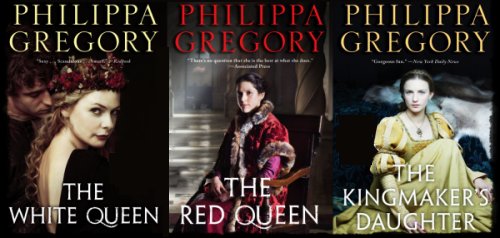
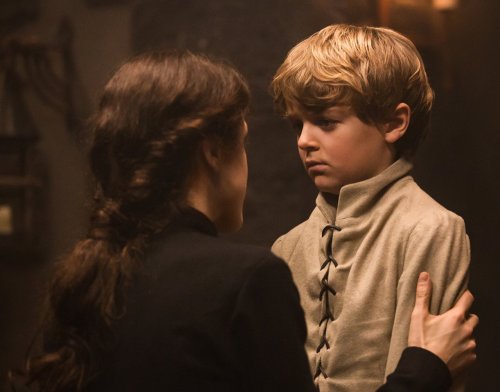
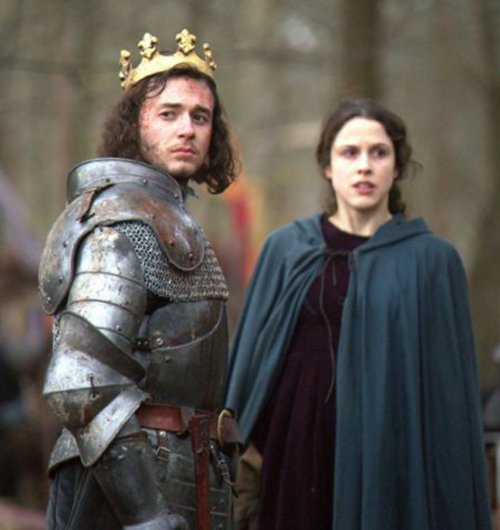
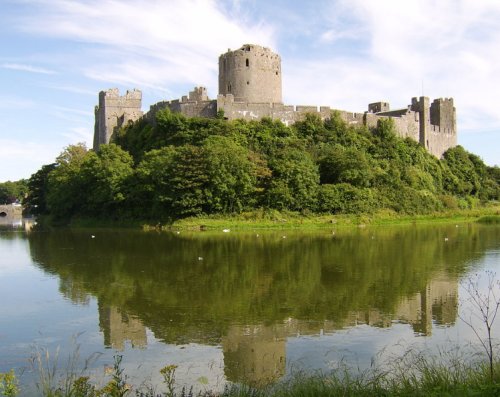
 |
Following Henry Stafford's death,
Margaret, 28, was a widow again, but not for long. One year
later she remarried. Margaret wanted to begin
playing politics, but she needed a ticket to enter
the rarified circles of the Royal Court.
She set her sights
on
Lord
Thomas Stanley. Stanley, 36, was a landed
magnate of immense power, particularly across the
northwest of England where his authority went almost
unchallenged, even by the Crown.
Stanley was one of the
most successful power-brokers of his age. As
testament to his gift for negotiating the
treacherous climate, Stanley managed to remain
in favor with successive kings throughout the Wars
of the Roses. That in itself speaks to
Stanley's considerable wisdom.
Stanley's first wife was Eleanor Neville, sister of
Richard Neville, the Kingmaker. This marriage
in the late 1450s constituted a powerful alliance
with the House of York. Then tragedy struck.
Eleanor died of natural causes in
1471, the same year Margaret lost her husband.
Margaret
made a shrewd political move when she decided to
chase Lord Stanley. Margaret had just targeted
the most powerful and trusted supporter of the
ruling Yorks to be Husband number three.
She wanted a man who was clever enough to see that
her son might have a chance at the throne one day
and duplicitous enough to serve two sides at once.
She
found her perfect partner in Thomas Lord Stanley.
But why would he be interested in her??
As it
turned out, Thomas Stanley, 36, was a businessman
who loved to explore opportunities. Stanley
was very intrigued by this small, intense woman from
the opposing side of the fence.
|
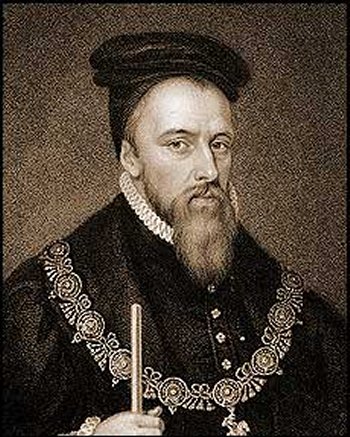 |
| |
|
Stanley,
a man of considerable acumen, was a game player of
sorts. He had a theory that the only way to
win all the time was to place a bet on both sides.
In this case, Stanley, a Yorkist through and
through, had just been offered the chance to team up
with a wealthy, well-connected member of the
Lancaster family. In a country where political
change took place with mercurial speed, no doubt
Margaret would come in handy because she would
provide protection from any Lancaster developments.
In addition, she had this kid of hers as a Wild
Card. The birthright of her fugitive son might
just prove useful as well.
|
| |
|
Stanley
lacked for nothing... he had three male heirs,
plenty of land, and a strong relationship with the
crown. What Stanley lacked was a challenge.
When Margaret pointed out her son had a shot at
becoming king, Stanley just laughed.
"Margaret, there are five men between your son and
the crown - Edward, George, Richard, and Edward's
two sons. More heirs could be born. The
chances of your Henry getting a chance are very
remote."
"Yes, Lord Stanley, but I have been given a
vision. Don't ask me to explain it, but I
have a strong belief in my heart that Henry is
meant to be king. I want you to help me."
Stanley
was amused. A marriage to this unusual woman
might prove interesting.
Stanley was
not interested in a wife for romantic reasons, but
rather for political reasons.
The marriage settlement, drawn
up in June 1472, was a careful
business arrangement of mutual
benefit.
The risk
was low and the potential benefits were high. Two of
England's
wealthiest figures had just teamed up.
Stanley got to work immediately.
With Stanley's assistance,
Margaret was able to consolidate her landed estates.
In addition,
Stanley introduced Margaret to
the
enemy. Lord Stanley's influence enabled her to
enter the royal court of Edward IV and Elizabeth
Woodville. To Stanley's surprise and further amusement, Margaret
blended in and became very well liked.
Margaret was so liked
in fact that Queen Elizabeth chose her as a
godmother for Bridget of York, one of the princesses.
The War
of Roses had taken its toll. After the death
of so many leading Lancaster men, Margaret was now
the most powerful Lancaster woman in England.
Her
new Yorkist connections might seem to contradict Margaret as a committed Lancastrian,
but Margaret was deliberately courting favor on both
sides. Margaret was
building a power base.
Warwick
the Kingmaker had once been Lord Stanley's
brother-in-law. Margaret wanted to be the next
Kingmaker. Her first step had been to gain
this alliance with a powerful man. To her
delight, Lord Stanley got a kick out of watching her
go to town.
|
 |
| |
During
the twelve year lull in fighting between Edward IV's 1471 victories
and his death in 1483, Margaret used this
time to learn how to negotiate the world of political affairs.
Her dominant
characteristic was her political astuteness rather than
blindly partisan allegiance. Margaret's
way was to make friends and gain consensus through
contacts and favors. If the day ever came for
her son Henry to make his move, these alliances
would come in handy. Stanley approved.
As he had guessed, watching this tiny, absurdly
pious woman in action was like looking at himself in
a mirror in oh so many ways. Margaret was a
woman after his own heart.
|
| |
|
When
King Henry VI briefly returned to the throne in 1470,
Margaret was there to welcome him. When Edward
IV regained the throne in 1471, Margaret changed
stripes and was there to welcome him.
Margaret
deliberately avoided controversy. In fact, Margaret
went out of her way to make peace with the Yorks.
She struck up a cordial relationship with none other
than Queen Elizabeth. Considering the Queen
had a considerable number of enemies, to see
Elizabeth let down her guard a bit spoke well of
Margaret. Elizabeth seemed to appreciate
Margaret's sharp eye and humility.
By 1480,
Margaret was cozy enough with Queen Elizabeth to be
named god mother to Bridget of York. Margaret
had gained enough trust that she felt safe negotiating with Edward for a pardon
for her son so that he could return from exile.
However,
Edward died suddenly in April of 1483. So much
for the pardon. The Wheel of Fortune had turned
again.
|
 |
| |
|
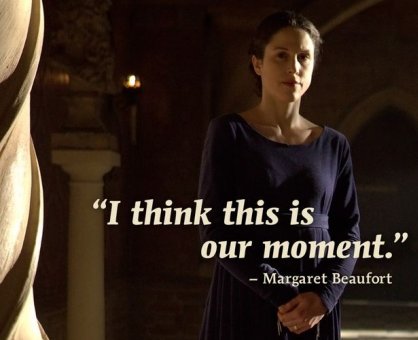 |
Following Edward IV's untimely death and the
subsequent seizure of the throne by Richard III,
both Stanley and Margaret changed their spots
brilliantly. Lord Stanley, a cynical man, made
sure to be one of the first to shake Richard's hand.
Later Lord Stanley bore the great mace at Richard's
coronation.
In turn,
Margaret played her part to perfection. She
too was full of smiles and
congratulations. Indeed, Margaret
played a leading part
in the coronation of Richard III
by
being the first to offer to
serve Anne Neville. Smart move. Margaret
was given the honor of carrying Anne's
train at Richard's coronation.
However this
time Margaret's friendship was two-faced. She
knew her moment had come. Stanley did too.
"Well,
Margaret, I never should have doubted you about your
son.
Indeed, the game is afoot. Let's see what
happens."
Sure enough, while appearing
to loyally serve Richard and Anne, the new king and
queen, Margaret was secretly plotting with the
dowager queen, Elizabeth Woodville.
|
| |
|
Mainstream Versus
Creativity
|
|
|
|
Rick Archer's Note:
Few subjects hold more
interest to the English people than the question of
what happened to the Princes in the Tower.
For American citizens, the question of who
assassinated President Kennedy is a close
approximation to the amount of mystery surrounding
this event.
Keep in
mind that we don't know if the princes were murdered
or simply whisked away to Transylvania and never
heard of again. It is also important to note
that few documents exist to offer clear-cut clues as
to the fate of these two boys. Therefore the
historians have worked overtime trying to come up
the answer.
The
Mainstream theory is that Richard disposed of the
boys. I have found an excellent author named
Matthew Lewis to defend this point of view.
The Creative theory is that Margaret Beaufort did
it, a point of view best defended by an excellent
author named Philippa Gregory espouses this point of
view.
Please
understand that I respect the thoughts of both.
I present the ideas of both authors simply to allow
the reader to join the interesting debate.
|
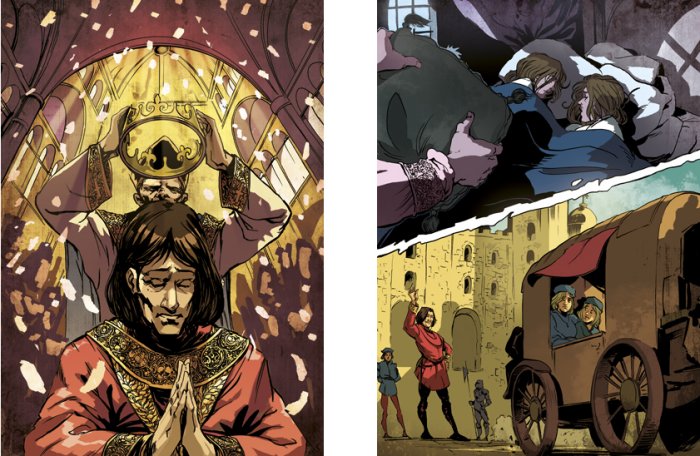 |
| |
|
Matthew Lewis
The
importance of the vanished Princes in the Tower
cannot be emphasized enough. Back in the 15th
century, in the court of
public opinion, it was judged to be an unusually
cruel move for Richard III to usurp the throne by
murdering his dead brother's innocent and quite
helpless sons.
But did
Richard really murder those boys? The question
has been heavily debated for six centuries. In
fact, I am surprised that an English version of a
the board game Clue has not been
invented with a Princes in the Tower theme.
In
addition to Richard, other murder suspects include a
low-life agent hired by Margaret Beaufort, Lord
Stanley himself, the Duke of Buckingham, a low-life
agent hired by Anne Neville, and even Henry Tudor
after he took the throne.
|
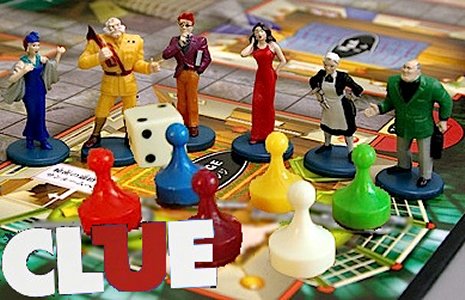 |
| |
|
What we
do
know is that the disappearance
of the Princes in the Tower was seemingly a glaring political
mistake on Richard's part because it was an
unforgivable act. History shows that the
disappearance of these boys was the break of a
lifetime for Margaret. She was able to muster
considerable support for the overthrow of Richard
III based on what people believed was the blatant
cold-blooded murder of the two boys.
What is
interesting, however, is just how much Margaret stood to gain
from Richard's blunder. In fact, Margaret
stood to gain so much that people have long wondered
if Margaret did the deed herself, then turned around
and pointed her
finger at Richard.
Was it even possible?
Yes,
according to author Matthew Lewis, it
was.
In his
book Wars of the Roses, Mr. Lewis
supports the mainstream idea that Richard was the
likely culprit. However, in his blog, Mr.
Lewis also agrees the possibility that Margaret did
the crime is not entirely implausible. Those
who automatically eliminate Margaret from suspicion
are being ridiculous. I have synthesized Mr.
Lewis' ideas below, but you are welcome to read for
yourself what Mr. Lewis has to say online:
Matt's History Blog
~ Hopefully interesting snippets and
thoughts regarding Margaret Beaufort and the
Princes in the Tower
"The White Queen series (based on books
by Philippa Gregory) stirred up the latent and
under-examined but long-standing theory linking
Margaret Beaufort to the disappearance and
murder of the Princes in the Tower. In
short order, the increased attention drew an
onslaught of opinion denouncing the theory as
impossible, implausible nonsense.
My point here is that all of those who sneer at
the notion that Margaret Beaufort could have
been involved are, in my opinion, wrong.
Margaret had motive, means and opportunity, and
that makes her a suspect."
|
| |
|
Here is
my summary of what Mr. Lewis proceed to say about
Margaret's possible involvement.
In the summer of 1483 Lord and Lady Stanley
were riding high in royal favor. Since they
had done nothing to
attract suspicion, they had easy access
to the Tower. We think of the Tower of London as a
prison, but it was more like a royal office building back in those
days. The boys were not in some dungeon, but
rather a comfortable royal suite (with locked
doors). Since the Tower was a very busy place, regular comings and goings for people of such
influence as Lady Stanley or Lord Stanley would not necessarily be
noticed. Therefore, 'Opportunity' was
surely within their reach.
Considering Margaret had the reputation as the most
pious woman in England, a cold-blooded assassination would certainly be
considered a major departure from character. That
said, Margaret had Motive (her son's
advancement),
Means (Lord Stanley), and Opportunity.
This
doesn't mean Margaret committed the crime, but
it does mean that
Margaret was a viable suspect. Therefore
Ms. Gregory's alternative scenario with Margaret
as the villain to Richard as the villain is not
as far-fetched as people believe.
There is a clear
evidence that Margaret
Beaufort immediately went to
work plotting Richard's
downfall shortly after
his coronation. The moment people began
to openly wonder why the boys had not been seen in a
while, it seems likely that Margaret opened up a clandestine
line of communication to Elizabeth Woodville
holed up in sanctuary at
Westminster Abbey.
Margaret
used her physician Lewis Caerleon, who posed as
Elizabeth’s physician, to pass messages between the
two women.
Most
historians agree that at this time Margaret
proposed that her son, Henry Tudor, be betrothed to
Elizabeth of York, eldest daughter of Queen
Elizabeth and Edward IV. On the surface, this was brilliant
politics because it had to potential to create a
marriage alliance which would attract both Yorkist
and Lancastrian support.
Where is
Sherlock Holmes when we need him??
|
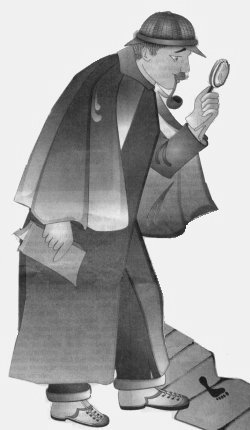 |
| |
|
While
Mr. Lewis agrees with Ms. Gregory that Margaret may
indeed have been far more complicit in the crime
than most historians believe, in his book War
of the Roses, he accepts the Mainstream
Scenario that Richard was the culprit.
Mr.
Lewis makes the following points:
•
The idea that Margaret
spent her whole life dreaming of putting Henry
on the throne was far-fetched. More likely
her ambition took hold thanks to the curious
events of Edward the King dying young and his
unscrupulous brother Richard taking over.
•
Elizabeth would never
have agreed to marry her daughter to Henry Tudor
unless she was convinced her two boys
had been murdered. The likelihood that her
sons were indeed dead is what persuaded
Elizabeth to agree to marry her daughter
Elizabeth of York to Henry Tudor.
•
Therefore, Margaret
must have somehow convinced Elizabeth that the
boys were gone. If this is the case,
then how did
Margaret know the boys were dead?
•
Mr. Lewis answered
his own question by saying that Margaret did not
know, but had the sense to gamble and lie to
Elizabeth about it.
Please
read the excerpt below written by Matthew Lewis.
|
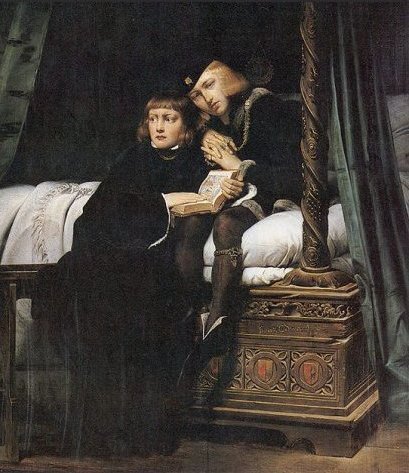 |
| |
|
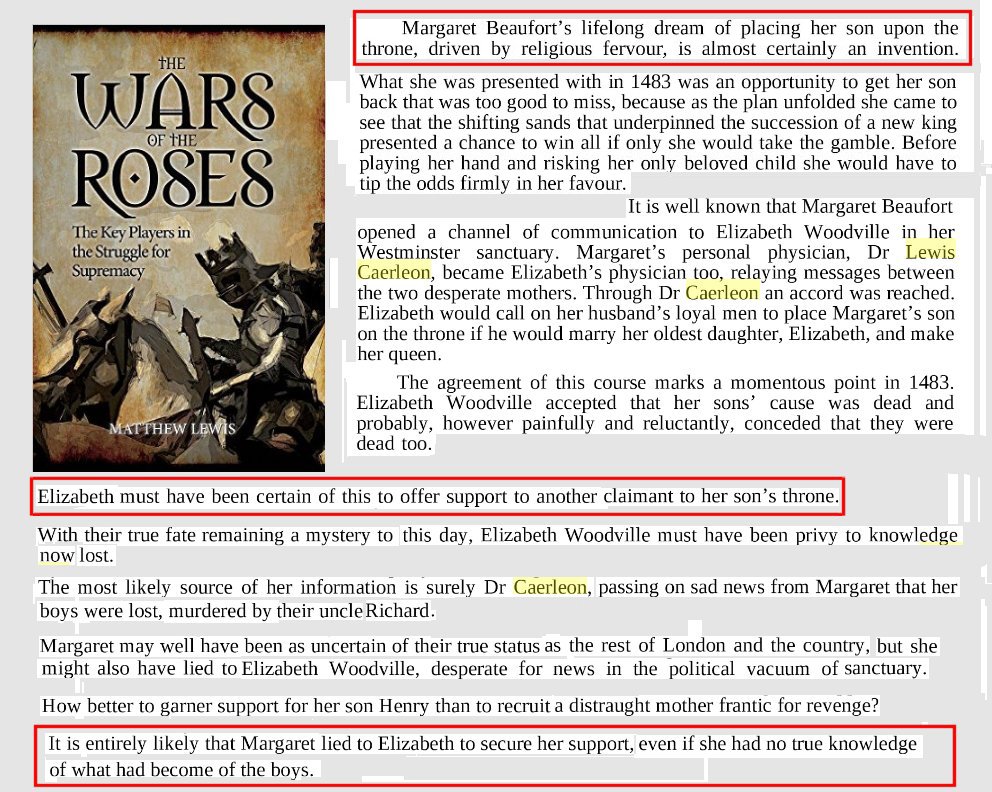 |
 |
| |
The Creativity
of Philippa Gregory
|
| |
 |
| |
The
White Queen mini-series was
adapted from a trilogy titled The Cousin's War.
In Episode 9,
author Philippa Gregory made it clear she believed
Margaret, not Richard, was responsible for the death of
Elizabeth Woodville's two princes in the Tower.
In an
early scene, Lord Stanley confronts Margaret
Beaufort, his wife. Stanley gets right to the
point.
“What do you want to do
about the two boys? Save or slaughter?”
When
Margaret gets a pained, doubtful look on her face,
Stanley is not delicate about it. He
points out the necessity of their deaths.
However he also leaves the final decision up to his
wife.
When
Margaret continues to hesitate, Lord Stanley demands
of her harshly. “As I said, save or slaughter?”
With a
nod, Margaret
finally agrees the two boys have to go.
Soon we
see a hooded figure creep into the boy's room in the
Tower and smother them to death with a pillow.
This was not Richard's idea after all, but rather an
idea shared by Margaret, Stanley, and Buckingham as
part of their rebellion plot.
|
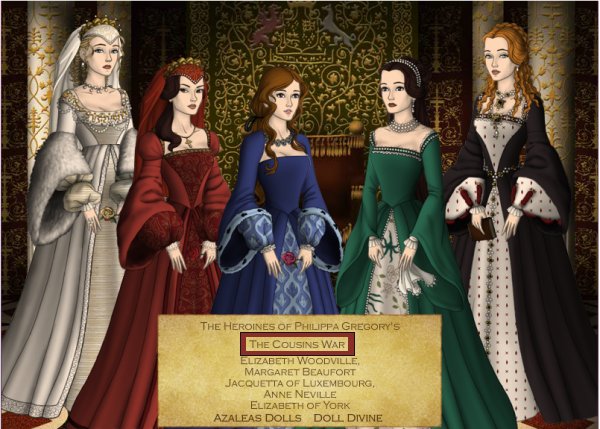 |
| |
 |
| |
First
Margaret sends her doctor to explain to Elizabeth
that the two boys are in great danger.
Elizabeth, fearing for the boys' safety, accepts an
offer of help to rescue them by Margaret, whose son
Henry is now betrothed to Elizabeth's daughter
Lizzie.
However
something goes badly awry with the rescue/murder
attempt. Somehow the boys end up dead on a
further try. Margaret sends the doctor back
over with the bad news. Learning that her boys
are dead, Elizabeth believes that she was
double-crossed by Margaret in the Red Queen's
ambition to see Henry crowned king.
When
Elizabeth hears the news of her sons' death, she is
overcome with grief. And not just ordinary
grief, but rather the profound grief of a mother who
truly cares about her children. Suspecting that Margaret is behind this,
Elizabeth vows to get even.
A week
or so passes when Elizabeth hears there is
rebellion about to take place against Richard.
This entire operation is being planned and funded by
Margaret. Elizabeth also learns that a major
part of the plan involves Henry's return to England
by crossing the English Channel. Margaret's son Henry is supposed to sail with seven
ships from France over to England to participate in
the wide-spread uprising. If the plot
succeeds, Henry will take the throne.
Elizabeth is determined to foil this rebellion, but
she has a problem... she is still stuck inside the sanctuary at
Westminster Abbey with her twenty daughters (or
maybe it was just seven; I lost count).
So here
is the question: How does a mother tyically foil a rebellion while stuck in a
virtual prison of sorts?
C'mon,
now, I know a lot of you out there are mothers.
Surely this qualifies you to know exactly what the
average mother would do to seek vengeance in a
situation like this. Well, just in case you
come up empty, I will share with you what
author Philippa Gregory suggested
Elizabeth did.
Ms. Gregory
had previously told us that Elizabeth inherited the
power of sorcery from her mother Jacquetta.
Furthermore, while trapped in the Abbey, Elizabeth
had just viewed Walt Disney's Fantasia.
Think about it... what does a mother with twenty
daughters do when everyone is cooped up at home?
She gets out a video and the family watches the
telly, of course.
Fantasia gave Elizabeth an idea.
The next thing we see is that Margaret and her
kinsman Buckingham have instigated a large-scale
rebellion against Richard, but rebellion fails
miserably. And why does the Rebellion fail?
There is
a storm. And not a natural storm either, but
rather the storm of all storms.
|
 |
It
is almost as if 'Fate' or God has intervened
to foil the rebellion. The storm completely
ruined the rebellion, but then we discover this is
Elizabeth's doing.
Using
the magic words 'Mickey Mouse',
Elizabeth has created the
biggest, baddest damn storm in human history.
Birmingham was unable to cross rivers because the
bridges are washed out. Henry was unable to
leave France because the storm is too great.
The rebellion collapsed.
|
 |
Indeed,
Elizabeth's sorcery ruined Margaret's grandiose
scheme. Elizabeth had her vengeance.
So did
it really happen this way? Uh, maybe not.
I have a confession to make... I did some fibbing involved in the retelling of
Episode Nine. That part about Mickey Mouse was just some
nonsense I made up. But you already
guessed that, didn't you?
And what
about that big storm? No, I didn't make that
one up. That was Ms. Gregory's idea. She had
Elizabeth Woodville wrinkle her nose a couple times
and magically create the mother of all storms to
frustrate Buckingham's rebellion and foil Margaret's
dreams.
|
| |
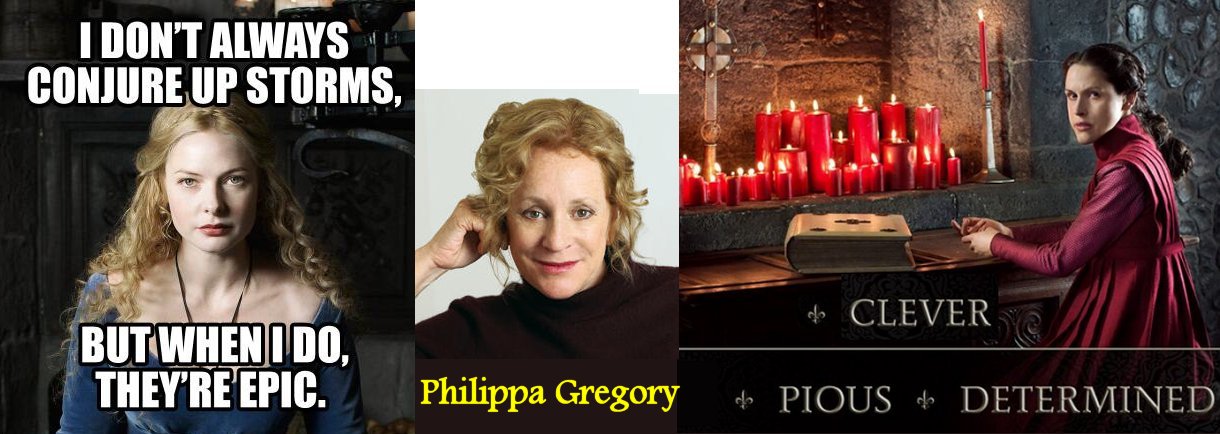 |
One
reviewer of the White Queen had this to say about
White Queen Episode Nine:
"Philippa
Gregory’s project - and so that of her White
Queen series - was to tell a ripping yarn whilst
refocusing history’s lens on the women whose
political and emotional lives were buried
beneath their official portraits and lists of
issue."
Ripping
yarn?? That may be a bit of an understatemnt.
I do not
know Ms. Gregory personally, but I suspect she has
used her imagination a bit in this retelling.
My hunch
is this prolific, best-selling author did not
achieve her phenomenal success by playing it safe. In fact, I believe
when given the choice, Ms. Gregory has made a habit
of deliberately choosing the most entertaining
option over the more mundane possibilities.
And why not? No one really knows what happened
six hundred years ago.
As we
know,
England has an impressive legacy of stretching
things a bit. Witness the King Arthur
mythology... Camelot, Holy Grail, Sword in the
Stone, Guinevere, Lancelot, Galahad, Merlin... you
name it. But guess what? (WARNING-
SPOILER ALERT!!)
(Did you
know some people believe all that King
Arthur stuff was made up? Have you ever heard
anything more ridiculous?)
And then there was that
nonsense about what a great king Richard the
Lionheart was... And then there was that crazy
story about Robin Hood and Maid Maiden, etc, etc,
etc.
And... get
this... some people have the nerve to say that William Shakespeare made
some things up. Yes, it's true! In a
manner similar to William Shakespeare, I think there
are moments when a master yarn-teller such as Ms.
Gregory would not dream of letting the truth get in
the way of a good story. If
perchance Ms. Gregory used her imagination from time
to time in telling the White Queen story, then who
am I to quibble? I daresay Ms. Gregory did not
become a best-selling author by accident.
|
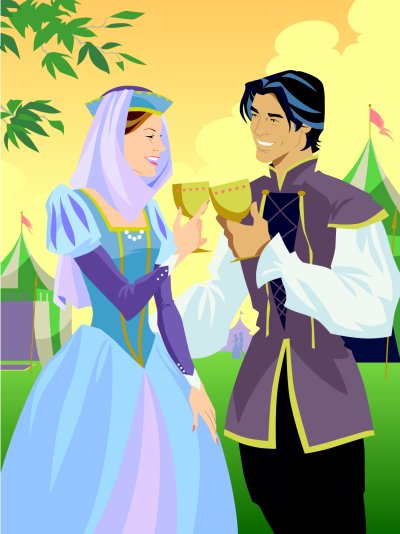 |
 |
For
example, Ms. Gregory makes frequent use of
Elizabeth's knack for sorcery. The fact of the
matter is that I would be perfectly happy to let the
sorcery of the White Queen explain all sorts of
weird phenomena such as the Bermuda Triangle and the
Lost Continent of Atlantis. I can be very
open-minded. In fact, maybe this would be a
good time to confess I have written
two books explaining why I believe in Fate. (A
Simple Act of Kindness,
Destiny)
Unfortunately, despite my unapologetic embrace of
all things Occult, the story of Hurricane Elizabeth
was too implausible for even me to accept. My
built-in bullshit detector was having fits.
On the
other hand, I would prefer not to cross literary
swords with the brilliant Philippa Gregory.
Since Ms. Gregory clearly knows more about this
story than I can ever hope to know, I hope she
doesn't take umbrage at my temerity to suggest a
potential over-reach.
Let's
put the debate over the big storm aside and
concentrate instead on Ms. Gregory's claim that Margaret
was responsible for the death of the two
boys.
According to Philippa
Gregory, Margaret Beaufort had the
strongest motive
to eliminate the two boys.
Ms. Gregory pointed out that the death
of the two boys allowed her son Henry
Tudor to advance Two
Steps closer to the throne.
Two steps, eh?? Aha, now
this is a subject I am qualified to comment on!
Being a
dance teacher from Texas, I happen to be an expert at the Texas
Two Step. I say that gives me the right to offer my opinion on the Tower
Two Step as well. Personally, considering how religious Margaret was,
my gut feeling is a murder of this nature would
go too far against her conscience.
When it
came to religion, Margaret was on par with the Pope
for intensity. Although it is true that Margaret was
at times fanatical in
her support of Henry, based on the woman I saw
portrayed on the White Queen and in
the journals, I think Margaret deserves the benefit of the
doubt on this one.
I am
with Gareth Streeter of
Royal History Geeks on this one:
Margaret was not a sinister child killer. I am
not saying Margaret was perfect, but she was more
likely to pray for something to happen than to
sanction a hit.
To me,
Richard III makes a heck of a lot more sense.
Shakespeare thought so too.
"
|
Richard was the one with the reputation for
ruthlessness, not Margaret. He had ordered
several battlefield executions such as the beheading of Edward of
Westminster at Tewkesbury. He was likely
present in the Tower to help his brother Edward suffocate old
King Henry VI. Richard had persuaded his
brother Edward to put George to death. Richard
had sanctioned the cold-blooded murder of Elizabeth
Woodville's beloved brother Anthony Woodville and
her son Richard Grey.
Richard had assassinated Lord Hastings, the man who
had been the most loyal supporter of the York cause
imaginable. Richard had blatantly kidnapped
two boys and held them against their will.
How much
more evidence of Richard's cold-blooded nature do we
need? Richard
was past the point of rescue. Since Richard had already murdered
several innocent men to eliminate threats to his
rule, what difference would it make to murder two
boys if it would clear the way for his crown??
After all, Richard's place in Hell was already
assured.
Yes, the
history is very murky here. How did Margaret
manage to persuade Elizabeth to the union of Henry
Tudor to Elizabeth of York? My guess is that
both women independently reached the
same
conclusion as the other.
So when
Margaret's doctor brought up the possibility of foul
pay, Elizabeth was already in agreement. If
Elizabeth did have a gift of sorts, no doubt her
sixth sense had told her to brace for the worst.
Here is
the bottom line: Elizabeth agreed to
collaborate with Margaret and let her daughter marry
Henry Tudor. Give this cooperation,
it makes little sense that Elizabeth would create a
storm designed to destroy Henry Tudor, then turn
around and agree to let him marry her daughter.
It makes much more sense that Elizabeth agreed with
Margaret that Richard was guilty of foul play in the
first place.
Richard
had kidnapped Edward and Richard to begin with and
refused to allow them to be freed or be visited.
That put the blame squarely on Richard.
Therefore it makes complete sense for the two women
to team up against a common enemy.
Unless the boys made a miraculous reappearance, the
women
would work together to promote Henry Tudor’s
prospects of taking the throne.
The two
women had made an unbelievable bargain.
|
 |
| |
Postscript: After giving it some more
thought, no, I still don't think Margaret did it.
But I wouldn't put it past Lord Stanley to do it
behind Margaret's back. That said, I have yet
to find a credible source that points the finger at
him.
In
addition, Mr. Streeter had this to say about Lord
Stanley:
"The Croyland Chronicle (c. 1486) and the
account of Dominic Mancini (the only
contemporary account) are important.
Collectively these documents give us a fair bit
of information about how the Princes were drawn
further deeper into the tower. They make
the case that all but Richard's closest and most
trusted servants were dismissed and denied
access to them.
It is this knowledge that is at the heart of the
compelling - although circumstantial - evidence
that the poor lads could only have been killed
on Richard's orders or at the very least, he
would soon have found out about it.
To me, it seems strange that if Stanley had done
the deed, that Richard would not have been able
to trace it back to him. Exposing the killer
would have done Richard a favour - he could make
it clear that the boys were dead but also that
he was blameless. Such a scenario would probably
have meant the Tudors never came to power."
Concerning the mystery of the Princes in the Tower,
I also found a remarkable web site that helps clarify
the murder case. A man by the name of Mick
Baker has synthesized an incredible
amount of research into a remarkably comprehensible
flow chart. I am in awe of Mr. Baker's work.
(Source:
History Files)
|
| |

|
| |
Henry
Stafford, the 2nd Duke of Buckingham, led a
rebellion in mid
October 1483, just four months after Richard's coronation.
Stafford had been Richard’s closest ally over the
last few months, so no one is quite sure why
Stafford turned against his partner in crime.
Stafford
was one of the primary suspects in the disappearance
(and presumed murder) of the Princes in the Tower.
Most people assume that Buckingham and Richard acted
together in the death of the boys.
Considering Buckingham was basically the 'Vice-President',
or 'president of vice' if you prefer, it is
surprising that he turned around and led a
rebellion. Perhaps the death of the two boys
triggered Stafford's rebellion. In the
same manner as all the male Lancasters had been
eliminated, now that the two princes were gone,
Stafford (Buckingham), Richard III
and Henry Tudor were the only surviving male heirs
to the House of Plantagenet.
The reasons why
Buckingham led a rebellion against Richard are not
clear but several possibilities can be considered.
First, Buckingham had just as legitimate a claim to the throne as
Richard. Gauging by popular dissatisfaction with
the new king, Buckingham might feel he should take his
chances and set himself up as the rival claimant
(particularly since Edward V and Richard of York
were supposedly murdered). Second, as a rival
claimant, Buckingham undoubtedly felt uneasy about
his own safety. Knowing Richard's penchant for
murder and that he was a potential rival, it was
possible he would decide to murder Buckingham as
well. As in all the gangster movies, the thug
who hits first usually comes out on top.
Assuming that Buckingham suspected his own life
was forfeit with Richard III, he decided to team up
with Henry Tudor to eliminate Richard. He and
Tudor
could sort out things once Richard was defeated.
This
particular explanation is explained well in
William Shakespeare's Richard III.
|
| |
|
Synopsis of Shakespeare's
Richard III:
Act IV, scene 2
Back in the palace, the gloating Richard, the
recently crowned king of England, enters in triumph
with Buckingham and Catesby.
Richard announces that he does not yet feel secure in his
position of power. He tells Buckingham that he wants
the two young princes, the rightful heirs to the
throne, to be murdered in the tower.
To murder innocent children is a serious crime.
For the first time, Buckingham does not obey Richard
immediately. He hesitates and says he needs
more time to think about the request.
Disgusted, Richard murmurs to himself that
Buckingham is too weak to continue to be his
right-hand man. Instead he summons a lowlife
named Tyrrell who is more than willing to accept the
mission.
In almost the same breath, Richard instructs Catesby
to begin spreading the rumor that Queen Anne Neville is sick.
Tell everyone she is likely to die. Then
Richard gives orders to keep the
queen confined. That accomplished, Richard
turns to the
audience and announces his intention to marry the
fetching Elizabeth of York, daughter of the late King
Edward. The
implication is that Richard plans to murder Queen Anne at
the first convenient moment.
Buckingham, uneasy about his future, suggests it is
time for Richard to give him earldom of Hereford as
Richard has promised earlier. Richard angrily
rejects Buckingham’s demands and walks out on him.
Buckingham, left alone, realizes he has fallen
out of Richard’s favor. He decides to flee to
his family home in Wales before he meets the same ill
fate of Richard’s other enemies...
|
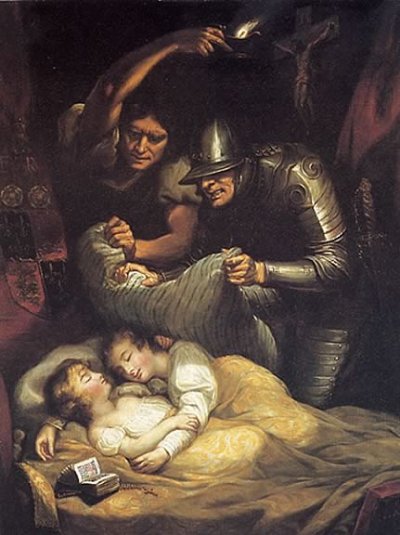 |
|
|
|
If we
can believe Shakespeare's explanation (and many do),
after leaving London, the Duke of Buckingham paid
Margaret Beaufort a visit. Keep in mind there
were two 'Henry Staffords' in Margaret's
life. One was her deceased husband Henry
Stafford who died in 1471 of injuries suffered at
Tewkesbury. The other was her nephew Henry
Stafford, the son of Humphrey Stafford, brother to
her deceased husband. This is who came to
visit.
Margaret's sense of opportunism led
her to support Buckingham's
daring autumn rebellion of 1483.
Here
she plotted to unite York and Lancaster factions in
a risky scheme to bring her son to the throne.
One part of the plan
had the exiled Henry Tudor
bring seven ships over from Brittany carrying 500
well-armed Breton soldiers
and Lancastrian followers.
In
retrospect, the timing was probably premature.
Although Richard was unpopular, the rumors of his
treacherous deeds had not quite spread to the
population at large. Consequently this
rebellion did not have strong support. Nor did
it have good luck.
Right from the start there
was trouble. Buckingham was not exactly a
charmer. His Welsh army decided they
liked him less than Richard III. Loyalty was
an immediate problem.
Then a
ten-day gale ended their dream
completely.
Due to a tremendous storm which battered England,
the Severn River became swollen and
ferocious, bursting its banks at many points. With
bridges unusable, Buckingham could find no crossing.
Seeing this fight had no chance of working,
Buckingham's men men deserted him.
Meanwhile, out in the English,
Channel,
Henry Tudor’s fleet had been scattered by the same
storm. However
Henry's
ship managed to get close enough to land.
Henry decided to risk coming ashore alone
and have a look around. As he rowed to shore,
Henry was hailed by a
group of soldiers on the beach as a victorious conqueror.
Henry stopped rowing so he could discuss his 'Victory'. The
men on shore assured Henry that
Buckingham had succeeded.
Henry
sensed a trap.
In the driving rain, it was too difficult for Henry to believe
this attack had any chance of success. Henry turned his
boat around and went back to the
ship, then went back to Brittany. His
caution doubtless saved his life.
Henry Stafford did not fare as well. A reward
was posted and someone turned him in. Stafford
was beheaded in a well-attended public execution.
The rebellion was over.
Margaret
Beaufort was cornered.
Always the schemer, Margaret had stayed above board
till now. This time her fingerprints were all over
this plot. It was clear she had bankrolled
this rebellion using her vast wealth. Richard
strongly considered executing her for treason.
Lord
Stanley's odd role in the rebellion is probably what
saved his wife's life. Curiously, when Richard
learned of the rebellion, Lord Stanley and his brother
William answered the call immediately and remained at the King's side throughout.
The
brothers were richly rewarded from the forfeited estates
of the rebels. Lord Stanley was appointed to
Buckingham’s former position as Lord High Constable
of England and William Stanley was made Chief
Justice of North Wales.
No one is quite sure why Stanley
remained loyal to Richard in these circumstances.
After all, months earlier Richard had killed Stanley's
friend Lord Hastings and threatened to do the same
to Stanley. Considering Stanley's wife had
planned this uprising, why did Stanley's loyalty lie
with his king over his own wife?
In the
end, Thomas Stanley's loyalty was a huge break for
Margaret. It was only by Stanley giving a solemn vow to Richard
to keep his wife in custody and put an end to her intrigues
that saved her from attainder, disgrace, and quite
possibly imprisonment... or worse.
Although Richard did confiscate her holdings, he turned
around and gave them to her husband Stanley instead.
In other words, the money was still in the family.
Richard’s lenient response was surprising.
Considering Richard was said to be a merciless,
ruthless tyrant, Margaret was in effect let off
with a wrist slap. Yes, her lands were forfeited,
but as long they remained in the household, big deal. Margaret was placed under
house arrest in her husband’s care. Stanley
promised to make sure that she made no contact with her
son, but this arrangement, of course, was sheer
nonsense.
Richard counted on Stanley
being more loyal to him than to his own determined
wife. If he knew just how passionate Margaret
was about putting her son on the throne, he should
have executed her just like he did Henry Stafford. Richard’s mercy, and perhaps naivety, would come
back to haunt him. Beheading women would have
to wait for the Tudor era.
|
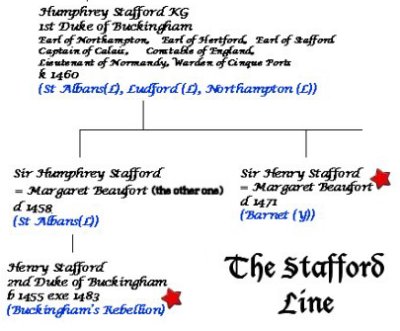
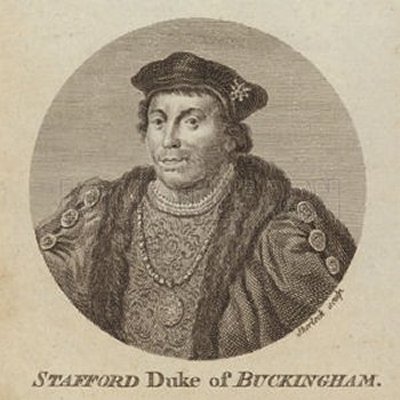
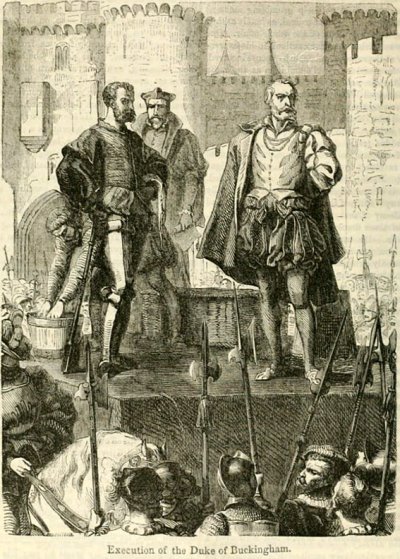 |
Death in the Royal
Family
|
This was an
age when there was great interest in the occult. Witches were
real and women
were often accused of sorcery. Anything out of
the ordinary was instantly assumed to be an omen of
some sort.
As omens
go, Richard
III had pointed to his successful suppression of the
Buckingham Rebellion as clear evidence that God really did want
him to be King. But then something happened that
shook Richard to his core.
Edward
of Middleham was born to King Richard and Anne
Neville in 1474.
Edward was created Prince of Wales in September
1483, then was formally declared heir apparent
in February 1484. Two months later the boy was
dead. Edward had been a sickly boy his entire
life. Nevertheless, the
swiftness of his death
was
very upsetting. There was no obvious reason.
It was a
bad omen to be sure.
Richard's enemies spread rumors saying
that Edward's sudden death was divine retribution.
This was surely God's payback for Richard's alleged involvement
in the evil disappearance of
the sons of Edward IV, the erstwhile Princes in the
Tower. If
Richard was feeling guilty about their death, this incident
with his own son did
not help.
|
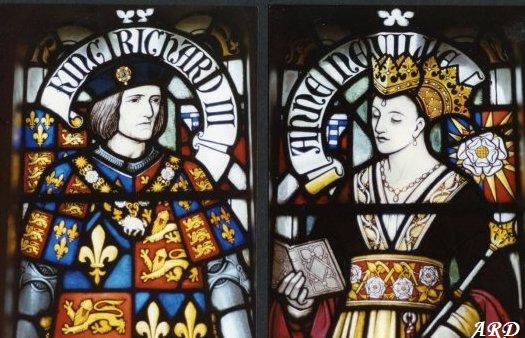 |
Anne
Neville, the boy's mother, fell gravely ill only a
few months after her son's death. She died on
16 March 1485, 11 months after her child. The
official reason is listed as tuberculosis.
Others say it was a broken heart at the loss of her
child.
And then
of course there were the rumors. On the day
Anne died, there was a solar eclipse. This was
taken to be an omen of her husband's fall from
heavenly grace. Another rumor circulated
that Richard III had poisoned his wife in order to
marry his beautiful niece Elizabeth of York.
Shakespeare particularly liked this rumor. If
anyone has ever seen Richard III,
Shakespeare did not waste a single chance to paint
the darkest picture of Richard possible.
The
death of Richard's sad little boy put an exclamation point
on a strange coincidence. The War of the Roses
had been complicated by the death of King Edward.
During his reign,
three unhappy princes
named Edward had died. All three
had been the Prince of Wales,
all three were called Edward
and all three died young
before becoming King.
The
first Edward to die was Edward of Westminster, 'Joffrey'
so to speak. This Edward had died by execution
following the bitter defeat at Tewkesbury in 1471.
He was 17.
The
second Edward to die was Edward V, oldest son of
King Edward IV.
This Edward was one of the Princes in the Tower.
He disappeared at age 12 never to be seen again.
Most historians assume Edward was murdered by his
uncle Richard in pursuit of Edward V's birthright.
And now
Edward of Middleham, 10, was the third Prince to
die. Upon hearing the news,
Richard and Anne were seen convulsed in grief so
powerful it
bordered on madness.
Not that
it matters, but one hundred years earlier the Black
Prince became the first Prince of Wales not
to become King of England. The Black Prince died of a
mysterious lingering disease that was said to be his
punishment for murdering countless French victims
during the Hundred Year's War.
Upon his
death,
the throne passed to his son Richard II, considered
to be one of the worst kings in English history.
The reign of Richard II was so inept that he was
easily overthrown in the 1399
rebellion led by Henry Bolingbroke (Henry IV).
It was this 'Crown by right of might, not law'
that was said
to have set the stage for the subsequent War of the
Roses. From this point on, an ounce of royal
blood and a ton of cannons was all it took to be
English King, a scenario played out time and again
during the War of the Roses.
By the
way, does anyone remember the first name of the Black
Prince?
If
memory serves, it might have been Edward.
By the
way, the Black Prince had a son named Edward.
Whatever happened to him? Edward should have
been the next king but he died at the age of five,
leaving his three-year-old brother Richard II to
take his place. Weird.
|
|
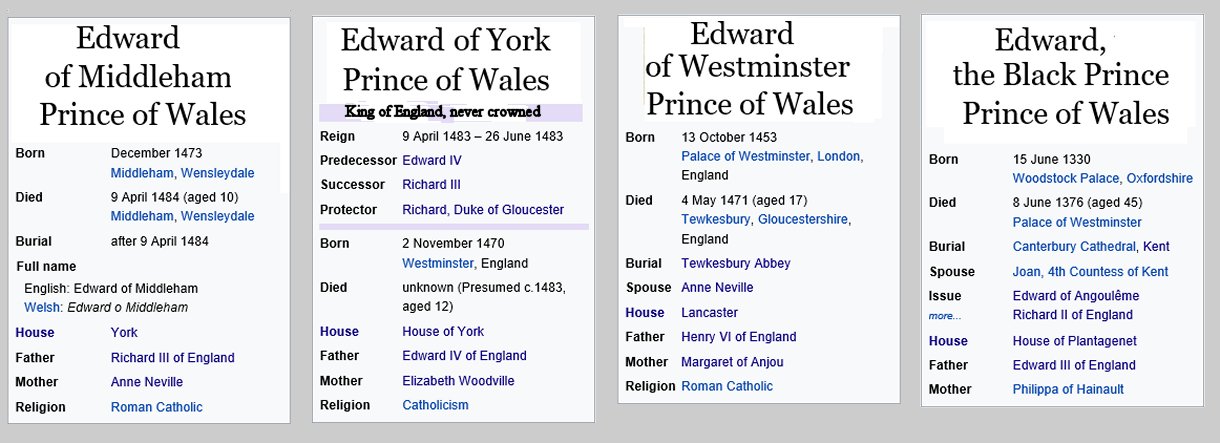 |
The Failed Invasion
Edward IV
had died of natural causes after a short illness in
1483. His brother Richard was supposed to
guard the throne till his nephew Edward V was old
enough to take over. Instead Richard took the
throne for himself. There was great anger in
the land at Richard over his likely murder of two
innocent, helpless boys. This was seen as a
heinous crime.
Margaret
Beaufort knew this foul deed was the opening she had
prayed for. She actively promoted her son as an
alternative to Richard III, despite being
married to a Yorkist, Lord Stanley.
Unfortunately, her first attempt at overthrowing
Richard, Buckingham's Rebellion in late 1483, had
failed miserably. Richard III claimed this was
proof that God wanted him to reign supreme.
Perhaps this belief made him over-confident because
he failed to execute Margaret when he had every
right do do so. That was a mistake that would
come back to haunt Richard.
Following the accession of Richard III, English
privateers were continually attacking Breton ships.
With
Duke Francis of Brittany fighting a prolonged illness,
in his
place stood Prime Minister and treasurer Pierre Landais. Irritated by the
loss of shipping, Pierre Landais initially attempted to appease
Richard III, but that didn't work.
So
Landais switched his support to Henry Tudor in
the hope that he would overthrow Richard. With
money and supplies borrowed from his host, Francis
II, Duke of Brittany, Henry had tried to land in
England, but the great storm caused his rebellion
to unravel. This resulted in
the 1483 execution of the Duke of Buckingham, nephew of
his mother and co-conspirator of Henry.
The Coming Storm
Two
years had passed since Henry had
escaped
back to Brittany.
It was now
1485. Unbeknownst to Henry Tudor, Richard III
had agreed to some skullduggery with Pierre Landais.
Still fuming over the aborted Buckingham Rebellion, Landais
strove to defend the independence of Brittany
against the machinations of Louis XI, the King of
France. He opened secret negotiations with
Richard III of England. As the main threat to
the rule of Richard, Henry Tudor was a powerful
bargaining chip.
Richard
III offered to send 4,000 English and
Welsh archers to help secure the power
of Landais against the rebel Breton nobility. In return, Landais
would arrange the capture and extradition
of Henry, Jasper Tudor, and the other
exiled Lancastrians. Landais readily agreed to
sell them out.
|
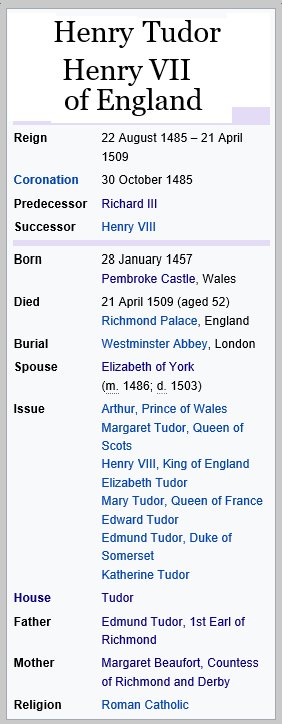 |
Landais assembled an
armed force in Rennes to march to Vannes and
capture all of the Lancastrians, 300 experienced
soldiers in all. At the last minute, someone
leaked news of the plot to Henry... quite possibly a
message from Lord Stanley. Facing
arrest and extradition to England, Henry and Jasper
found two horses and
fled across the nearby border into Anjou.
They crossed
only hours ahead of Landais' troops. The men
left behind were captured.
Henry
had escaped his third trap. As Henry rode
towards the French Royal Court, little did he know the treachery of Pierre Landais
would
backfire in his favor. Henry was welcomed by the French who
viewed both Richard III and Pierre Landais as their
enemy. The French were more than happy to supply
Henry with troops and equipment for a
second invasion of England. Better to have
un ami, a friend, on the English throne!
Where
have we heard this story before? Indeed, back
in 1471 Warwick and Margaret of Anjou had teamed up
to send Edward IV into exile and place Henry VI back
on the throne. Just when Margaret of Anjou
thought everything was secure, the Wheel of Fortune
swung back in the York's favor when the Earl
of Warwick made a serious blunder. Warwick was
pressured by the King of France to wage war against
France’s enemy the Duke of Burgundy, in exchange for
Marguerite of Anjou and her forces to be allowed to
journey to England. Once Warwick declared war
on the Duke of Burgundy, two bad things happened.
First, in retaliation, Burgundy
decided to supply his brother-in-law Edward IV with
ships, men, and money to jump-start his comeback.
Second, Margaret's delay prevented her from
reinforcing Warwick at Barnet. After Warwick's
death at Barnet, Margaret was vulnerable at
Tewkesbury. Had Warwick and Margaret of Anjou
been together, Edward would have never stood a
chance.
United
we stand, divided we fall.
Too bad Edward
had to die young. C'est la vie.
It was now 1485 and the French were ready to meddle again.
During
his two-year reign, Richard III had made many
enemies. That included the
French who were dying to strike back.
Henry was the lucky recipient. His close call with
Pierre Landais was a different kind of omen.
It suggested his mother's dream was coming to pass. Henry
was gaining support from many other corners as well. Henry
knew he had solid Lancastrian backing
at home. Indeed, the remnants of the
Lancaster court
were more than ready to support Henry.
Previously he had been a relatively unknown scion
of the Beaufort family, but given a second
chance after Buckingham's Rebellion, the Lancasters
knew Henry was a bold outlaw who deserved their
backing against Richard.
In
addition to the much-needed backing of the French,
Henry enjoyed another wonderful gift when he was reunited
with John de Vere. John de Vere, also known as the Lord of Oxford,
had almost been the Lancaster hero of the 1471 Battle of
Barnet, but became the goat instead.
After losing control of his men who stopped fighting
to pillage the town of Barnet after routing the men
of Lord Hastings, Oxford had the misfortune of being
mistaken for the enemy when he and 800 men returned
to the battlefront.
Imagine
how Oxford felt. The mistaken identity was not
really his fault, but many blamed him nevertheless.
His mistake had been costly. Warwick was dead.
Margaret of Anjou was gone and her nasty son Edward
was dead. All the Lancaster men were dead and
the cause had been in suspended animation for the
past fourteen years.
Life had
not gone well for Oxford since. In the years
following, his lands had been confiscated. As
an outlaw,
Oxford had gone to France. He had spent over
ten years fighting as a mercenary in France
and studying French military tactics. Making
matters worse, Oxford had gotten himself caught.
Imprisoned
at Hammes Castle near Calais, Richard
had just sent the order to bring Oxford back to England for execution.
However,
before the transfer could be effected, Oxford was
able to persuade Sir James Blount, captain of the
prison, to change sides and oppose Richard instead.
Oxford escaped along with Blount to join
Henry Tudor in Paris. Understandably, this upset
Richard no end. The
Oxford episode was indicative of the growing lack of loyalty to
his
regime.
Lost in
the shuffle were the footprints of Lord Stanley.
A writer named Jean Molinet claims Lord Stanley
worked behind the scenes to engineer the defection
of the Hammes captain.
|
| |
|
Blount and
Oxford immediately left Calais to reunite with Henry
Tudor. Henry was said to be "ravished with
joy incredible" at this surprise. Oxford
immediately returned to Hammes Castle to liberate
the garrison there. A hundred imprisoned
Lancastrians were freed to come join Henry's fight.
Blount's
defection was a good sign indeed. It suggested
Henry had a great deal of support came from the Yorkists themselves. Richard III
was a
York, but he was the wrong York. Everyone
preferred the Old York over the New York.
Legions of disgruntled
supporters of dead King Edward were still
furious about Richard's unlawful seizure of the
throne.
Here is where Margaret's master stroke
had paid off.
Thanks to
the secret negotiations between Margaret and
Elizabeth Woodville, the two mothers had made the
deal of a lifetime. Elizabeth's daughter,
Elizabeth of York, was quite the prize. She
was not only beautiful, Elizabeth had royal blood in
her.
Indeed,
at Rennes Cathedral
in France on Christmas Day 1483, Henry publicly pledged to marry Elizabeth
of York, the eldest daughter of Edward IV.
Elizabeth
of York was the heir of King Edward IV due to the presumed death of her
brothers in the Tower. Elizabeth served as a
powerful reminder of the good old days of her father to many
people.
By
pledging Elizabeth, dowager queen Elizabeth
Woodville's lovely daughter, to Margaret
Beaufort's strapping Henry Tudor, this unusual
alliance of a York Princess to a Lancaster Prince
held great promise for peace.
Now all they had to
do was get rid of their unpopular king.
|
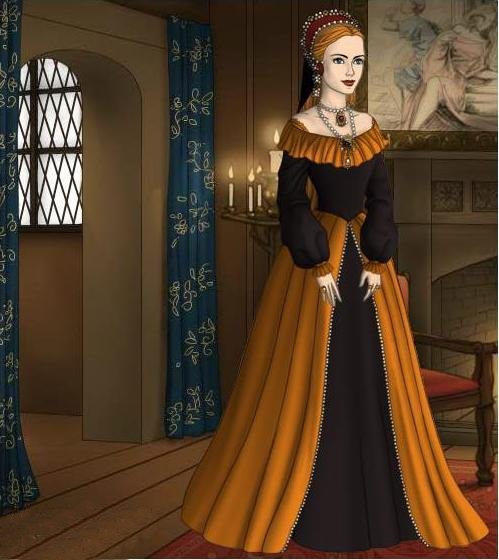 |
| |
|
| |
|
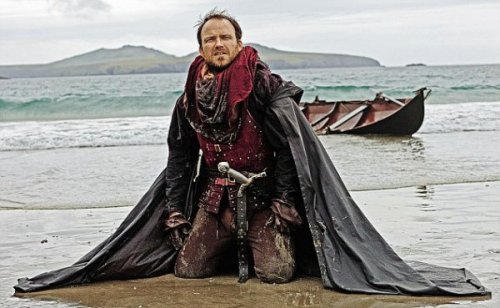 |
In 1399, Henry
Bolingbroke had returned from exile to depose unpopular King
Richard II.
In 1471, Edward IV had returned from exile to
reclaim his throne from the usurper Warwick.
In 1485,
it was up to Henry Tudor. The day had come for
Henry's return from exile to claim the English
throne.
On
August 1, Henry left Honfleur, France. He
sailed with a contingent of French mercenaries and
English exiles. The last time Henry had left
France, the Wheel of Fortune had frowned. What
would happen this time??
Henry
landed in Mill Bay, Pembrokeshire, a spot in Wales
close to his birthplace. It was the first time
in 14 years since he had been on English soil. Upon landing, Henry
knelt down and whispered, ‘Judge me, Lord, and
fight my cause.’
|
|
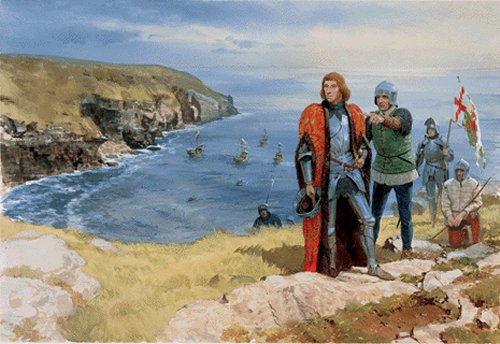
|
Jasper
suggested Wales was the perfect place for invasion
since it was always hostile to the English monarchy.
Indeed, Henry's
Welsh parentage stood him in good stead.
Through his father Edmund Tudor, Henry was a direct
descendant from Lord Rhys, a famous Welsh ruler.
Henry's firm relationship with the popular Jasper
Tudor helped as well. Jasper was a national
hero – a Welshman who had succeeded at the English
court and could be counted upon to support their
rights. The Welsh were understandably
sympathetic to any cause which involved this
high-ranking Welshman. Henry Tudor amassed an
army of around 5,000 soldiers
Henry marched towards England accompanied by his
uncle Jasper and John de Vere, the Earl of Oxford.
Richard was waiting for them in the center of the
country. Reports came to Henry that Richard
was very well prepared. Things did not
look good for Henry Tudor. Not only was he
outnumbered 2 to 1, his opponent was a very experienced
commander.
Henry? He had never fought a battle.
Fortunately, he had Jasper and Lord Oxford at his
side.
The Wheel of Fortune was spinning.
|
The Man Who Lived
on the Fence
|
A
remarkable drama took place in the days preceding the coming battle. There was great
concern over which side the Stanley brothers would fight
on. Considering Thomas Stanley was on
Richard's English Council, it was assumed Lord
Stanley would fight for Richard. If this was
the case, then Richard had nothing to worry about.
And yet Lord Stanley was married to Henry's mother.
Surely Henry had nothing to worry about. But
then again, Lord Stanley had fought on the side of
Richard during Buckingham's Rebellion. Surely
Richard had nothing to worry about. What was
it going to be?
The
problem was that Lord Stanley and his brother
William had well-deserved reputations for being
sneaky. There had been occasions when both men
showed up at the battle with separate armies, but
only one Stanley army fought while the other army
just stood there and watched.
Lord
Stanley is a fascinating figure because he took many
calculated risks throughout the entire 32-year War
of the Roses, yet emerged completely unscathed.
If someone wished to bypass the romantic mush of the
Red Queen and the White Queen
sagas, they could just as easily tell the entire
story of the War of the Roses through the eyes of
Thomas Lord Stanley.
|
| |
|
The War
of the Roses can be divided into three parts...
Richard Duke of York, Warwick's
Betrayal, and Richard III.
To
understand Thomas Stanley, one needs to understand
the close relationship of the Neville family to the
York family.
Joan
Beaufort was the daughter of John of Gaunt (who
else?). Joan's son Richard Neville, the Earl
of Salisbury, could trace his lineage straight to
King Edward III. Richard Neville became the
Earl of Salisbury.
Joan
Beaufort's daughter Cicely Neville married Richard,
Duke of York. She too could trace her lineage
to Edward III.
Richard
of York and Richard of Salisbury were not only
brother-in-laws, they were best friends.
Once
Thomas Stanley married Eleanor Neville, he became
part of the Neville family. This marriage made
Stanley brother-in-law to Richard, Earl of
Warwick... the Kingmaker.
|
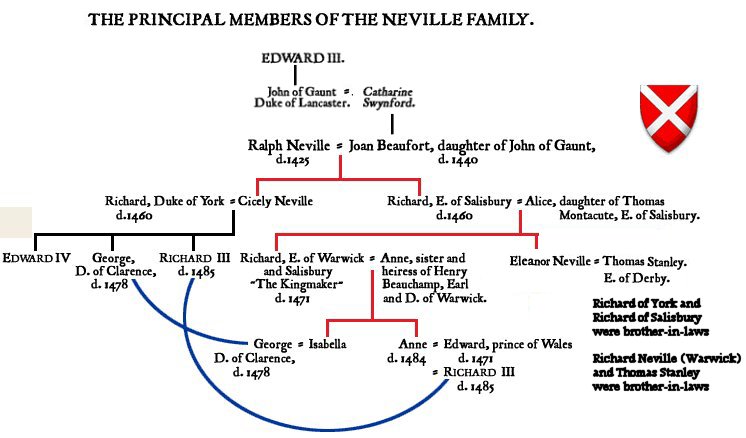 |
| |
|
15th
Century Medieval England was a period similar to
America's Wild West. Just as the Wild West
cattle barons squared off with complete disregard
for the law, wealthy landowners in England also
squared off with little regard for the law.
Richard Neville, the Earl of Salisbury, was a very
powerful man who had a long-standing grudge with the
neighboring Percy family. 1453 was the year
Henry VI descended into madness.
Simultaneously Henry Percy tried to ambush the
Salisbury family on their way to a wedding.
Although Salisbury's group emerged intact, the
rivalry was reignited.
At this
same time, Richard of York was having his issues
with Edmund Beaufort, the dandy of Margaret of Anjou
and the father of two illegitimate sons related to
our story.
Two
years passed and suddenly the King woke up from
catatonia. Now all hell broke loose.
Richard of Salisbury and Richard of York decided to
team up and confront the Beaufort-Percy combination
at the 1455 Battle of St. Albans, the English
version of OK Corral. The York-Neville team
won handily and killed Edmund Beaufort in the
process, thereby guaranteeing a Round II... and
III... and IV... and....
The Cold
War of the Roses had just gone Hot.
Thomas
Stanley had grown up in a family loyal to Henry VI
and the house of Lancaster. However, in 1457
Thomas formed an alliance with the powerful Neville
family by marrying Eleanor Neville, daughter of
Richard Neville, Earl of Salisbury.
This marriage marked the start of Stanley's long
acquaintance with Salisbury's son Richard Neville,
better known as Warwick, the man who would come to
be known as the Kingmaker. As we remember,
Warwick was not only the man who put Edward IV on
the throne, he was also the man who took Edward off
the throne. Hence the nickname.
So here
we have Lord Stanley, a Lancaster, developing a
potential alliance with the leading members of the
House of York. This 1457 marriage to Lady
Eleanor meant Thomas had one foot in the door of the
York-Neville alliance and one foot in service to the
crown. Interesting, yes?? What makes it
even more interesting is that marrying Eleanor put
Stanley in the thick of things, something he had to
know.
Lord
Stanley minded his own business as long as could,
but two years later the War of the Roses paid a
visit to Stanley's back yard. In 1459 Stanley
got news that Queen Margaret of Anjou was recruiting
heavily in Cheshire, his home base. Stanley
knew he could not ignore the civil war much longer.
Making
matters worse, Stanley's father had just died,
making Stanley the new head of the family. As
far as Margaret of Anjou was concerned, the Stanleys
had always been loyal to the crown. So
naturally the Queen came calling to ask for
Stanley's pledge of men. Stanley said he would
send men.
Meanwhile, the Yorkists under Salisbury, father to
Warwick, were mobilizing to neutralize the threat.
Entering Cheshire, naturally they sought assistance
from Stanley, Salisbury's son-in-law, Warwick's
brother-in-law. Stanley said he would send
men.
What a
way to begin one's new role as head of the family!
Caught between a rock and a hard spot, Stanley was
faced with quite a dilemma. Shortly Stanley
got news of a major fight.
Salisbury was commanding the Yorks. He had
just managed to elude the warrior Queen when he was
intercepted by Lord Audley's army at Blore
Heath, a location about 30 miles down the
country road from Lord Stanley's estate in Cheshire.
The battle started as a trap to catch York forces on
the move. Sure enough, the Yorks walked right
into it and suddenly found themselves outnumbered
10,000 to 5,000 (the Yorks were seemingly
outnumbered by the Lancasters in practically every
battle).
Although
Salisbury was outnumbered, through a series of
feints using a small stream that divided the armies,
he provoked the Lancasters into attacking him.
Salisbury's counter-attack proved deadly.
And what
about Lord Stanley? The Royal army under
Margaret of Anjou expected support from Stanley, but
didn’t get it. Although Lord Stanley claimed
to be a loyal royal, he never actually joined Queen
Margaret's army. Furthermore Warwick and
Salisbury expected Stanley would come to their
rescue. Indeed, Stanley showed up, but then he
failed to participate. Warwick was
flabbergasted.
Through
audacious brinkmanship, the young lord faked the
entry of his army into the battle, then suddenly
stopped just a mile away. Lord Stanley sat on
the sideline with 2,000 men and watched.
Meanwhile Sir William Stanley, his younger brother,
did actually fight for the Yorkists at Blore Heath.
William Stanley paid a stiff price as he would later
be attainted for his participation by the Queen.
In the
immediate aftermath of the battle, Lord Stanley had
the nerve to ride up and congratulate Salisbury on
his splendid escape from the trap. However,
just when Stanley came close to committing himself
further, he decided to withdraw his forces back into
Cheshire. Salisbury stood there perplexed.
This was
the start of the Stanley legend. No one could
figure Lord Stanley out. Why did he sit out
that battle? After all, at the time, his
brother-in-law was Warwick the Kingmaker, leader of
the Yorks.
After
the battle Lord Stanley wrote to the Queen to offer
his apologies and offer excuses for why he had not
seen fit to commit his men to battle. Margaret
of Anjou could not have been too convinced by his
explanations. Nevertheless when Parliament
petitioned for his attainder later that year they
were not successful because Margaret intervened.
During the fluctuations of the Wars of the Roses she
needed all the friends she could get, including
unreliable, slippery Lord Stanley.
This was
a close call. The wrong move here could have
meant disaster for the House of Stanley. Lord
Stanley's sympathies were 'York', but Stanley
did not wish to show his true colors till he was
more certain. This set the pattern for Lord
Stanley's career, a man always reticent to commit.
One year
later, the Yorkists had possession of the King and
ruled in his name. Now Lord Stanley decided it was
safe to begin cooperating with the Yorkist lords,
but only when it suited him. Stanley made sure
to stay away from the particularly bloody battles of
Wakefield (where both Salisbury and
the Duke of York, father and son, were killed) and
Towton (where York's eldest son Edward
defeated the Lancastrians and had himself crowned as
Edward IV).
Although
Stanley got no credit for his lack of participation,
he proved valuable to new king Edward by aiding his
brother-in-law, the Earl of Warwick, in mopping up
the remaining Lancastrians. Stanley played a
major part in the capture of Henry VI (1465) in the
Stanley stronghold of Lancashire. For his
service, Stanley acquired several new estates in the
process. For the time being, Stanley was a
York.
In 1469,
a crisis emerged. Warwick changed
sides!! Dramatic shifts between
1469 and 1471 made the political landscape
treacherous. Warwick's decision to switch to
the Lancasters affected Lord Stanley more than
anyone. In 1469, Warwick did his best to
secure Stanley's support against Edward, but Stanley
was non-committal. Consequently Warwick's
first try to eliminate Edward failed. Although
Edward was captured, it didn't do any good.
Then Edward kicked Warwick over to France. Now
Warwick made his alliance with Margaret of Anjou.
Upon Warwick's return to England, Stanley still
refused to fight, but nevertheless lent him armed
support in the restoration of Lancaster King Henry
VI. Edward was unseated and made a fugitive.
Edward ran to Burgundy for safety.
Stanley
was firmly on the Lancaster side now. Or was
he? When Edward began his amazing 1471
comeback, Lord Stanley disappointed Warwick by
refusing to help stop the returning Edward.
Nevertheless, Stanley promised not to help Edward
either. To all outward appearances it seemed
as though Lord Stanley had thrown his lot in with
the Lancastrian cause, but as usual looks were
deceiving. Thomas secretly sent his brother
William to Edward IV’s side when he landed at
Ravenspur to reclaim his throne. As for
himself, Thomas refused to fight.
|
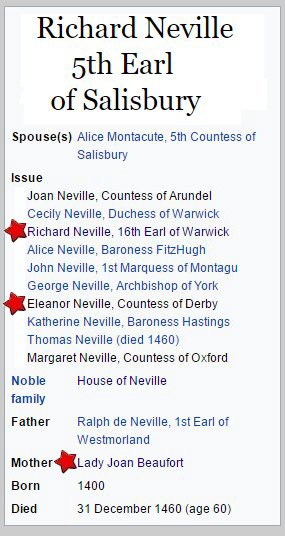

 |
| |
Think
about it. If Warwick won at Barnet, Stanley
could point to the men he had given Warwick in 1470
to unseat Edward. If Edward won, Stanley could
point to his 'regret' and 'change of heart'
by deciding to sit out the Battle of Barnet and then
Tewkesbury. Very clever.
Stanley's strategy worked like a charm.
Following Edward's comeback victory at Barnet
and the rout at Tewkesbury, Edward
forgave Lord Stanley for his earlier disloyalty on
the grounds that Stanley had stayed neutral the
second time around.
Lady
Eleanor's death in 1471 was a sad event which
nonetheless led to Margaret Beaufort's invitation to
marry. Stanley recalled how his marriage to
Eleanor had opened the door to his relationship with
the Yorks. Perhaps a similar marriage could
open other doors back to the Lancasters. Lord
Stanley, the undisputed master of moving forward by
sitting still, could not resist. His marriage
to Margaret would allow him to stay firmly in the
middle of any ensuing problems. Lord Stanley
was fairly brilliant in this way.
And what
about William Stanley? Stanley's younger
brother William had not only fought during the
Battle of Blore Heath, he would do so again in
several other 1460-1461 encounters. William
repeated this role during the 1469-1471 flare-up.
Seemingly by design, it fell to William to take the
heat off his older brother, the family leader.
William accepted it was his job to fly the family
colors, losing some, winning some, always staying
alive to fight another battle. William might
get attainted, but since Thomas held most of the
family's estates in his name, William's losses
ensured that his big brother never lost anything.
There
was amazing teamwork between the two brothers.
William was willing to take risks knowing in the end
that the House of Stanley always came out ahead.
This sublimation stood in stark contrast to the
destructive squabbling between the three York
brothers. George and Richard constantly argued
over who got which Neville girl and each attainted
estate by playing Edward against the other.
Edward, always the appeaser, did himself no favors
by indulging these two brats. Meanwhile,
William willingly accepted his role as the 'Designated
Loser' for the good of the family. Thomas
always made sure his younger brother was 'compensated'
in one way or another. As much as any family
in England, the Stanleys benefitted during these
turbulent times by playing both sides of the fence.
|
| |
|
Lord Hastings
Revisited
|
 |
|
| |
|
Thomas
Stanley had dodged a bullet in 1483. His close
call took place shortly after Richard had imprisoned
the Princes in the Tower. Their mother
Elizabeth Woodville had fled into sanctuary at
Westminster. Now there were repeated rumors of
plots and conspiracies being orchestrated by
Edward's widow.
Richard
was extremely paranoid that someone would take a
stand against his strong-arm tactics with the two
boys. His fears caused him to erupt on Friday,
June 13, 1483. William Hastings walked into
what he thought was a routine council meeting called
by Richard, Duke of Gloucester.
Hastings
was suddenly seized by armed men. Richard
began screaming at him, accusing the older man of
plotting with the Woodvilles behind Richard's back.
No trial by peers was offered. No proof was
offered. No witnesses were called. The
existence of the plot was upon Richard's say-so
alone.
Richard
condemned Hastings to death. When Hastings
left the chamber a few hours later, it was as a
prisoner being hustled out to execution. His
death on Tower Green was such a hasty affair that no
scaffold had been erected.
Lost in
the drama was a curious fact. Lord Hastings
was not the only council member arrested. In
fact, several of the noblemen in attendance were
arrested. One of them was Lord Stanley who was
roughed up pretty badly in the ensuing scuffle.
Stanley was briefly imprisoned, but later released.
Based on
what we know, who was more likely to be
treacherous... Hastings or Stanley? Lord
Hastings was the man who warned Richard to seize the
boys and take action against Elizabeth Woodville in
the first place. Lord Stanley was a known
snake in the grass. And yet Lord Hastings was
beheaded on the spot while Stanley was set free.
So why did Hastings die and Stanley live?
The
answer is very simple. Lord Stanley made it a
point to use his vast fortune to keep a large,
well-armed army at his disposal back in Cheshire.
Call it an 'insurance policy'. Richard
knew Stanley's son George, Lord Strange, could
quickly mobilize this army in northwest England.
In addition, brother William had his own army as
well. Supreme in the Midlands countryside
around Shrewsbury south of Lancaster, the Stanleys
had become the most powerful family in England.
And Richard knew it.
|
 |
There is
little doubt Richard III feared Lord Stanley more
than anyone. Sensing Richard's fear, in the
days to follow, Stanley played Richard like a
fiddle. Keeping his cards close to his vest,
Stanley kept Richard guessing.
On the
one hand, Lord Stanley's weird move to marry
Margaret Beaufort, the Lancaster matron, just added
to the confusion. On the other hand, despite
his odd choice of marital
partner, Stanley had never done a single thing to make
King Edward IV suspect Stanley's loyalty to the Yorks in any way
during the twelve years of peace.
After Edward's
death in 1483, Lord Stanley had been the first man
to congratulate Richard. Then came the master
stroke... after Richard had threatened Stanley's
life with false (??) accusations, Stanley forgave
Richard. "No harm done, lad."
Two
weeks later, guess who carried the great mace at
Richard's coronation?
Then,
just to further prove his loyalty to Richard,
Stanley actually fought at the side of
King Richard during Buckingham's ill-fated
Rebellion. Joining
Lord Stanley in the battle was his younger brother
William Stanley.
"See,
Richard, you have nothing to worry about. The
House of Stanley is firmly in your corner!"
Richard's fears were allayed, at least somewhat.
Now Richard tried to buy the Stanleys off. After the
rebellion was over,
Thomas and William Stanley were richly rewarded from
the forfeited estates of the dead rebels. Thomas
Stanley had performed so well he was appointed to
Buckingham’s position as Lord High Constable of
England. Sir William was made Chief Justice of
North Wales and was given land as well.
|
 |
| |
|
As
always, Lord Stanley had made the right move.
He had converted Richard's paranoia into vast new
estates and position.
There
has long been speculation why Stanley sided with
Richard in the Rebellion and not his own wife.
Here is one possible reason:
"Richard was with the Earl of Northumberland and
Thomas, Lord Stanley, when he got word of the
rebellion. Richard did not really trust
either man as in the past they seemed to support
Lancastrian causes in the past.
Northumberland (Henry Percy) had proved to be
difficult during the years when Richard was Lord
of the North. The Late King Edward had to send
Northumberland orders, as he would not obey
Richard.
The same could have been said about Stanley.
He spent most of the time in whichever camp
benefited him the most. Richard kept
him under close eye as trouble and Stanley was
always close at hand. Richard was
reminded of Stanley’s wife, as he had heard that
Henry Tudor was playing a major role in the
Buckingham rebellion. (Source)
In
the weeks to follow something deeply unsettling came
to light. After
the dust had cleared, Richard III made a remarkable
discovery... Thomas Stanley's wife Margaret Beaufort
had been largely responsible for organizing and
funding the operation. Now Richard was very
confused. Thomas Stanley had fought hard for
him and yet Stanley's wife Margaret Beaufort was a
key conspirator in the rebellion. Whose side
was Stanley on?
Lord
Stanley was asked to explain. Stanley replied
to Richard that his wife's affairs were unknown to
him. If Stanley had known, he would have told
her to knock it off. Besides, did Richard not
see how hard Stanley had worked to put down the
rebellion? What further proof of his
innocence... and ignorance of his wife's moves...
did Richard need?
Richard
was really confused. What should
he do about Margaret? Under
normal circumstances, Margaret would have been
executed or imprisoned. But Richard did
neither. With visions of that standing army in
Cheshire, Richard decided to take Stanley's word. Such was the strength of Thomas
Stanley that Richard let Margaret off with a wrist
slap rather than antagonize her powerful husband.
Lest we
forget, Richard did something unusual... Richard handed
all of Margaret's estate to Thomas. Lord
Stanley now owned his wife's entire estate.
However, there was a catch. Upon Stanley's
death, Margaret's estate would revert
to the crown.
| |
|
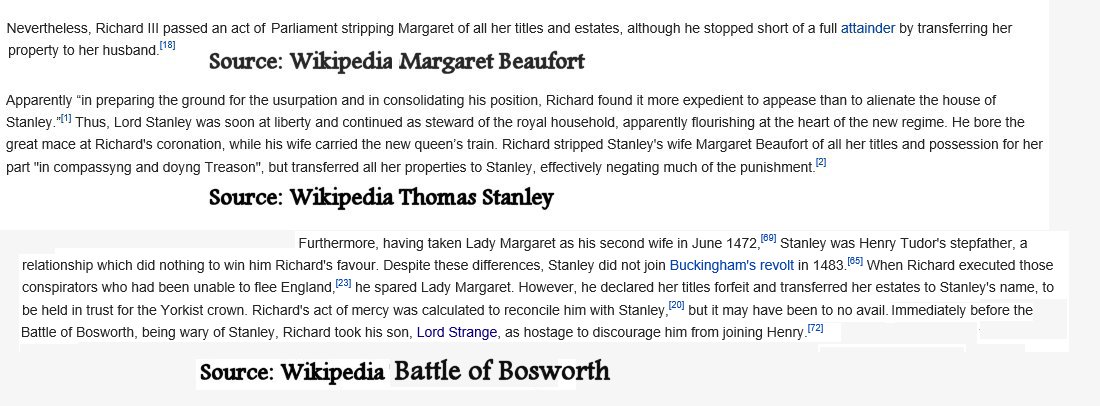
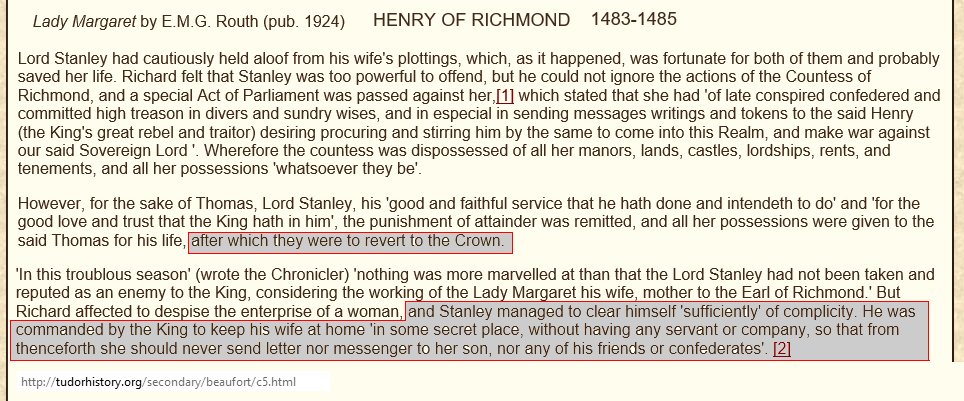
|
| |
|
Rick Archer's Note:
Doesn't this story strike the Reader as a bit
odd?
Here
is a woman, Margaret, who has just committed
treason and Richard has undeniable proof of her
complicity. Previously, Richard put Lord
Hastings to death for less evidence than he had
here. In addition, Richard has just
finished beheading Buckingham. But Richard
treats Margaret differently for the same crime.
Richard never even speaks to Margaret, the real
instigator. Instead he speaks to Thomas
Stanley and tells him all his wife has to do is
promise not to do it again, then go home and sit
in the corner. While she's at it, maybe
pray a little and repent.
The
thing to understand in my long saga is that I
originally set out to write a brief overview of
English history. Hence the title "Brevity
and Brexity". As it turned out, I
spent a month and a half researching and writing
this story. So much for Brevity.
I
invested my time because I began to see more
clearly how History is written. Things
happen, but since very few accounts exist,
everything becomes wide open to interpretation.
In particular, the 'Winner' gets their
version accepted as the undisputed 'Truth'
of what took place. The Winner picks
someone to write a favorable story or the Winner
makes sure that unfavorable documents
disappear... or both.
The
secret of interpreting History is to put oneself
in the place of the actor and imagine what must
have passed through their minds. On a
personal note, as one has surely guessed, Lord
Stanley definitely caught my eye.
The
story of 'Margaret's punishment'
seemed so absurd that I gave it a lot of
thought. My
problem is that write each story based on web sites
that usually just scratch the surface.
Based on what I read, I initially thought this estate-transfer/house
arrest solution was Richard's
idea. But then I began to wonder.
That is when it crossed my mind that maybe this
solution was Stanley's idea.
So here is my interpretation of how the scenario
might read if Stanley took control of the situation.
Richard:
"Lord Stanley, you were
invaluable to me in
putting down the rebellion. How do you suggest
I handle this matter of your treasonous wife??"
"Sire, I ask you to spare her. She is but
a silly woman who let her fever for her son
cloud her judgment. I suggest you place
her under my control. Strip Margaret of
her estate and give it to me. Without
money, she can do little damage.
I
will oversee the lands myself. And when I
die, let Margaret's estate revert to the crown.
I will order Margaret to stay close by, a form
of house arrest. She is not to leave my
home without supervision. You will have
nothing more to worry about, this I pledge."
In other
words, stripping Margaret of her estate may not have
been Richard's idea, but rather her husband's idea.
By betraying Margaret... for whatever reason...
during the Rebellion, suddenly Stanley had acquired
Margaret's vast estate for himself. And what
if something were to happen to Richard??
Gee, too bad, then after Richard was gone, Stanley
could petition the next king to either let him keep
it all or give it back to Margaret. Either
way, Stanley had made a shrewd bargain. Better
to keep the lands and titles in the family than give
it to Richard.
But how
would Margaret react? After all, Lord Stanley,
master manipulator, had gotten his wife declared a traitor and
placed in his care under house arrest, with all of
her lands and fortune forfeit unto him.
Margaret had to be incredulous.
Wouldn't
it be fascinating to be a fly on the wall when
Margaret learned the news? Let's fantasize how
the dialogue might go.
“On
the graves of my ancestors, I swear, Stanley,
you have robbed me! Did you betray me just to get my fortune?”
"Calm down, Margaret. I have not
betrayed you. I was stuck at the side
of the King when the fighting broke out.
He never let me out of his sight.
Thanks to all that flooding, I could already
see that Buckingham's uprising did not have
a ghost of a chance to succeed. There
were reports that his own men had deserted
him. I was not about to throw
everything we have worked for away on this
failed scheme. There's an old saying,
'Better to live and fight another day'.
So, yes, I fought for Richard and so did my
brother. What choice did I have?
Buckingham was a lost cause.
Now, as for the deal I struck, when the
discussion began, Richard was so angry he
was about to sever your head from your
shoulders. Then he discussed a certain
cold dungeon with unusually meager rations
and thin blankets. In addition, you
were about to be attainted. Richard
was completely within his right to remove
your entire estate. Who would you
rather have in control of your estate,
Richard or me?
But I talked him out of it. I not only
saved your life, I saved your estate.
Your holdings are quite safe with me.
All we have to do is remove Richard and your
son will be able to restore your lands to
you."
Please keep in mind that I have just made up
History. I have no idea whether this
conversation took place or what was said. But
if we look at history from Stanley's point of view,
my scenario makes sense.
If this
conversation did take place, was Stanley telling the
truth? Who can say with this guy? But
his argument was compelling enough for Margaret to
buy his story. Plus, what other choice did she
have? Stanley now owned all of Margaret's
lands.
If there
was to be a coming battle and Henry won, Margaret's
lands would be safe AND Stanley would be rewarded.
So Margaret's fears were allayed when she realized
it was completely in Stanley's interest to help
Henry win.
However,
if Richard won the coming battle, Stanley was in big
trouble... unless Stanley could find a way not
to oppose Richard. Stanley had to find
a way to help Henry and stay neutral at the same
time. Now how does someone do that? I
guess we will find out when the time comes.
It was
now 1485. Two
years had passed since Buckingham's Rebellion.
Henry Tudor was coming for Richard.
The support of Thomas and William Stanley were critical
to the king. Would Richard be able to count
on these men again like he had during the rebellion
of 1483? Richard was desperate to find out.
Richard was about to
discover exactly what he feared the most... Lord
Stanley was sitting on the fence.
|
Defections
|
| |
|
What a
shame Richard's immense talent had to go to waste.
If one can disregard Richard's ruthlessness, then he
should be admired for his courage and intelligence.
As a mere teenager, he helped his brother Edward
regain his crown. Richard's attack at the
Battle of Barnet won the day against far older and
more experienced opponents. Weeks later,
Richard's defense at Tewkesbury won the day by
thwarting the Duke of Somerset's surprise attack.
Ever
since Henry Tudor's escape during Buckingham's
Rebellion, Richard had known this showdown would come.
Well aware that Henry Tudor would be sailing soon,
Richard had been clever. Since Richard was
uncertain where Henry would land, he posted
his men in the epicenter of England. His men
were 100 miles from all the likely landing spots, a
three-day horse ride.
Richard's strategy was to let the local commander
keep Henry occupied long enough for Richard's
reinforcements to race to the spot. A landing
party would not have enough time to unload their
ships and gain a foothold on English soil.
Richard's counter-attack would destroy the
vulnerable invasion force.
|
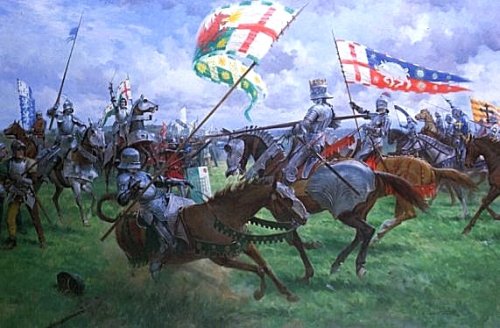 |
| |
|
Interestingly, German General Erwin Rommel expected
to use this same strategy when preparing his D-Day
defenses. Unsure where the Allies would land,
Rommel kept a crack Panzer tank unit on the
Belgium-French border so it could race to whatever
point the Allies landed and decimate the attack
while the men were still pinned down on the beach.
Rommel's
strategy may very well have worked except for one
thing.... Rommel needed Hitler's permission to
release the tanks. Unfortunately, Hitler had put a 'do not disturb' sign up for the night.
No one dared knock and the Panzer tanks never moved.
Let me
say this again... for all his faults, Richard was
not stupid. Richard knew full well that Jasper
would likely encourage Henry to land in Wales.
It made perfect sense. However Richard was not
going to bet the house and fully commit to one
landing spot. Jasper's spies would warn Henry
if something was amiss and Henry would land
elsewhere. So Richard did the next best
thing... he shored up his support by handing out
lands, titles, and offices to men who had shown
loyalty to him in the past. Finally Richard
felt secure because he had extensive control over
south Wales.
|
| |
|
Richard's strategy should have worked, but it didn't.
Early in August, Richard was alarmed to find that
Henry's forces were moving through Wales unopposed.
Richard turned white with fear and anger. Just
how exactly did this come to pass?
Mill Bay
had been chosen as a landing point because it was completely hidden from
view. No resistance was given by the cohort of
Richard's men stationed at Dale where Henry and his
men spent the first night. They completely
failed to keep the invader at bay by the bay.
In the
morning Henry marched to Haverfordwest, the county
town of Pembrokeshire. His men were received "with
the utmost goodwill of all". Welshman
Arnold Butler met Henry in Brittany and
announced that "the whole of Pembrokeshire is
prepared to serve him!"
Richard's lieutenant in South Wales, Sir Walter
Herbert, failed to move against Henry. Two of
Herbert's officers, Richard Griffith and Evan Morgan,
deserted to Henry with their men. The next man
to face Henry was Rhys ap Thomas, the leading figure
in West Wales.
Richard had appointed Rhys
Lieutenant in West Wales for his refusal to join
Buckingham's rebellion. Did Rhys ap Thomas
stop Henry? No, he defected to Henry's side
and brought with him many men.
So far,
Henry had been greeted warmly at every stop he made.
Henry was seen as the great Welsh champion.
The importance of Henry's Welsh blood and ancestry
should not be underestimated. Welsh support
would prove critical to Henry.
So far,
every single
man in Wales that Richard had rewarded for their loyalty
had welcomed the invasion force with hugs and kisses.
Richard
had just been given his first hint things weren't
exactly working out as planned.
|
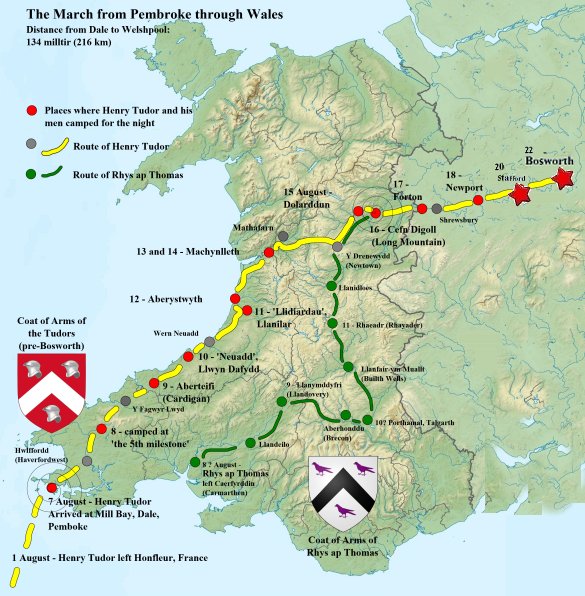 |
Geography
There is
a very cynical saying that War is God's way of
teaching people Geography. So let's use the
War of the Roses to learn a little bit about Great
Britain's geography.
Off the
top of your head, what do you suppose Wales and
Scotland have that England doesn't have?
C'mon, this shouldn't be too hard to guess.
(Hint: It's big.)
Next
question. What did the Romans leave behind
that the English found particularly useful?
Next
question. Here in America, what place is
called the Gateway to the West?
Next
question. What place in England is known as
the Gateway to the Midlands? (Hint: unless you
are from Great Britain, you are not expected to know
this answer.)
Next
question: Given what you know about the
Gateway to the West, what do you suppose the Gateway
to the West and the Gateway to the Midlands have in
common??
Last
question: What geographical feature doomed Margaret
of Anjou at the Battle of Tewkesbury? (Hint:
it's on this map.)
Quit
your bellyaching. Hey, I gave you a map!
Figure it out.
|
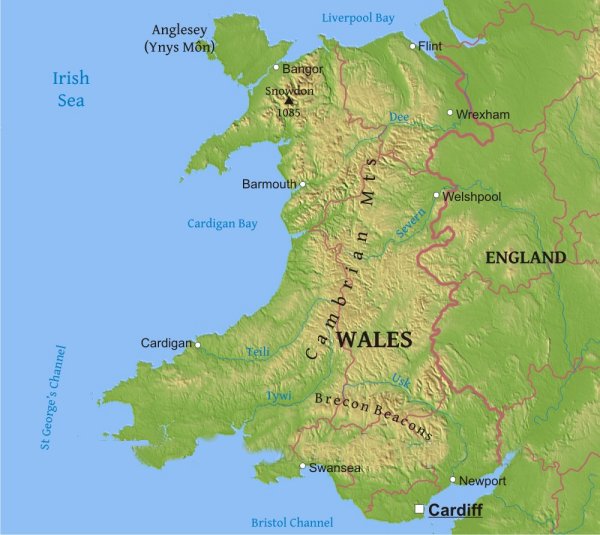 |
Over My Belly
So what
Big Thing do Wales
and Scotland have that England doesn't?
Both Wales and Scotland are extremely mountainous while England
is relatively flat. Over the centuries, the
Welsh and the Scots have used those mountains as
defensive barriers to keep the English out. As
we look at the map, we see the only routes into
Wales are valleys formed by the rivers... unless of course
someone cheats and attacks using the sea.
By now,
we also have a pretty good idea who won the looming battle.
This, of course, takes away
much of the suspense. But Henry and Richard
had no idea of the outcome. They were both on
pins and needles. Richard was upset that Wales
had welcomed Richard with open arms, but he was not
entirely surprised. After all, Wales was
Henry's turf.
Okay, so
Wales had not panned out, but Richard
had another ace up his sleeve. Pretty soon
Henry would be on Richard's turf. Let's see
what happens then.
Henry
had a lot on his mind. Richard's army was
bound to be much larger, better
equipped, and better prepared. Richard knew
the territory well and would surely stake out the
finest ground to mount his defense. As Henry's
army trudged north, they used an ancient Roman road
that cut through the mountains using a valley formed
by the Severn, England's longest river.
|
| |
|
Once
Henry's army left the mountains of Wales, they
continued along the Roman road until they came to Shrewsbury, the traditional gateway to the
English midlands. In a manner similar to
America's St. Louis, Shrewsbury was very important
because it had the only bridge across the mighty
Severn River for miles and miles. Henry was
about to learn the hard way that the English attitude
towards his invasion was much cooler than the rabid
Welsh.
Shrewsbury was Richard's ace in the
hole. It had two bailiffs, Roger
Knight and Thomas Mitton who had been in power for about
two decades. Both men had prospered under Richard
III, most notably from the failure of Buckingham’s
Rebellion. Mitton had not only received Buckingham’s castle, Shrewsbury’s tax bill was significantly reduced,
making Mitton very popular. Mitton fully expected to be rewarded for
standing up to Henry. Another castle perhaps??
Richard
had given Mitton the perfect excuse to deny entry. Richard
had scared the wits out of the countryside
people by warning that Henry's foreigners would rape
and pillage in revenge for what the Black Prince had
done to the French a hundred years earlier. The people of Shrewsbury had no desire
to see Henry's French mercenaries come in and
plunder their town. Therefore, when Henry
requested permission to march through the streets, Mitton made an odd reply – “over my belly!” – which
we can assume is another way of saying 'over my
dead body'.
|
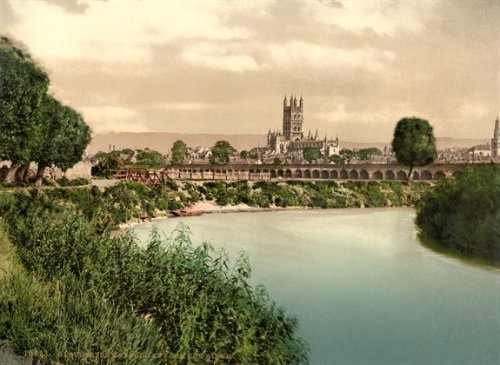 |
Henry
could not afford to go around the city thanks to the
ever-swollen Severn River. Nor
did he wish to engage in a fight. Henry was
engaged in a public relations battle almost as
fierce as the coming fight.
Richard
had painted a dark picture of Henry as a desperate
outlaw who had no money to pay his troops.
Richard said Henry had promised his men that they could murder
and take what they wanted in repayment. Henry could not afford to
attack these people of Shrewsbury lest rumors of his
aggressiveness spread.
So Henry
retreated. At a nearby village, he composed a
letter to the bailiffs, promising that his men would
simply march through Shrewsbury peacefully and cause
no damage or harm. He respected the oath of
loyalty to Richard III and did not expect any of the
townspeople to break it. The letter accomplished
little. Mitton still said no and repeated his
phrase 'over my belly!'
Henry was
in serious trouble. If he couldn't get past
Shrewsbury, his entire campaign would come to a
total stand-still. Then to his surprise, the gates came
open. Henry barely believed his eyes.
The
arrival of Rowland Warburton had made a
huge difference. Warburton persuaded the
bailiffs to let Henry pass. And who was
Rowland Warburton? He was a guy who lived at Blore Heath.
Blore
Heath... where have we heard that name before?
As it turned out, Shrewsbury was 20 miles south of Blore Heath, one of the famous battle sites during
the War of Roses.
|
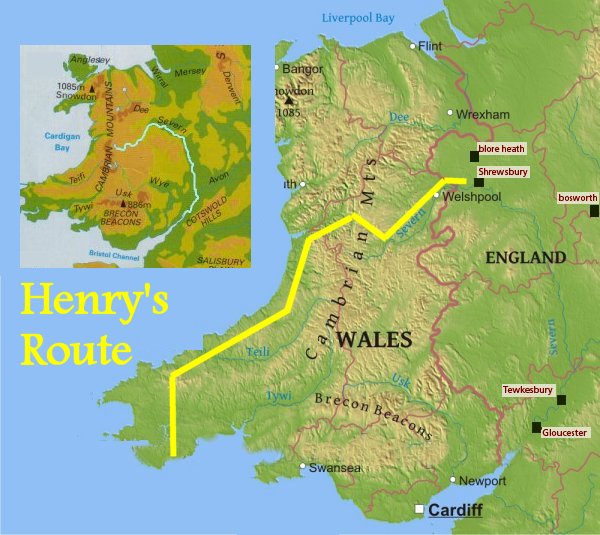 |
And who
exactly was Rowland Warburton? He worked for
Chief Justice of North Wales, a man who just
happened to live near Blore Heath. The Chief
Justice of North Wales had ordered the gates to the
town come open.
And who
exactly was the Chief Justice of North Wales?
None other than Sir William Stanley, Richard's
carefully-chosen appointee as Chief Justice of North Wales.
Yes, indeed, William Stanley was Richard III’s chief lieutenant
in this area.
Other than John Howard, the Duke of Norfolk, no
single man in the kingdom had received more land and
power than William Stanley. Richard was
counting on William Stanley to stop Henry at the
Severn and contain him so the king's army could come and finish the
invasion off. Surely Richard's
well-rewarded commander would hold the line.
Nope.
Henry received an invitation to visit William at his
manor. Henry was
served tea and crumpets with an offer of perhaps a friendly
cricket match out on the lawn. Rumors have it
that William and Henry had a pow-wow in the process.
Yes, the
English citizens were afraid of Henry and his
terrible reputation, but in this part of
the world, the Stanley name was all-powerful.
The Stanley name was impressive enough to sway
even John Mitton who no doubt saw his hopes for a
new castle go up in smoke.
Interestingly, John Mitton was a man who had a
well-known reputation for always keeping his
word, a very good thing to have in politics. As Henry crossed the bridge, John Mitton made a point to lay
down on the ground. To much fanfare and
hilarity, Henry politely stepped over the man's belly, thereby
allowing Mitton to
keep his oath. We now see why Mitton didn't
say 'over my dead body'. Smart man.
Henry was relieved to pass through, but shaken to
realize that his support among the non-Welsh
populace was not widespread. Indeed, the
lesson of Shrewsbury was repeated in next
town he marched through. Since the average
citizen did not recognize his claim to the throne,
Henry had little to celebrate. This campaign
was shaping up as another 'Buckingham Rebellion'...
a reckless, seat of the pants, make-it-up-as-you-go-along
operation observed by a lukewarm, apathetic
citizenry that preferred to sit this one out.
Henry
was very worried.
|
Loyalty and Betrayal
When the
news that Henry had crossed the Severn River reached
Richard, he knew that William Stanley had betrayed
him. Richard was consumed with bitterness at
trusting the man. Now Henry was only 50 miles
away. To hell with William Henry.
William Henry was a pipsqueak. It was his
brother Thomas Stanley that Richard was worried about.
Richard was surely doomed if Lord Stanley opposed
him. Lord Stanley had been invaluable in
putting down the Buckingham Rebellion. But
could Richard count on Stanley again??
One
month earlier, an unsettling event had taken place.
In July 1485, about three weeks before Henry Tudor
landed, Thomas Stanley had sought permission to
leave the court and return to his northern estate of
Lathom in Lancashire. Stanley said he was
going to visit
a relative. The
king was no fool; Richard
allowed Stanley to leave London but
asked that
George, Stanley's son and
heir, remain behind.
Richard
made his request very politely... 'Lord Stanley,
we need your son to stay behind to fill your place
on the Council'.
But
everyone understood that George Stanley, 25, was
being kept as a hostage to ensure Thomas Stanley's
continued loyalty.
Now as
Henry moved through the English countryside, Richard
had not seen Thomas Stanley in over a month.
Considering William Stanley had just betrayed him,
Richard must not have been feeling too sure about
Thomas Stanley either. Nevertheless, Richard reassured
himself that George, also known as Lord Strange (no,
I am not making this up),
remained in
his household to assure his father’s
good behavior.
Surely no father on earth would risk his son's life
to betray his king.
Let
us ask what might be going through Lord Stanley's
mind as the two armies grew closer. Thomas Stanley had a decision to make.
Lord
Stanley had gained a reputation of remaining neutral
and not supporting any particular side in a battle
until he was absolutely positive which side would
win. Even then, the chances of him involving his
army were, to an extent, unlikely. Though this
strategy does not seem to an honorable
one, it gained the Stanley family more friends than
enemies. Lord Stanley had shown he was
master of taking advantage of any sort of
situation.
Is it
possible to grow stronger by sitting idle??
Thanks in large part to Stanley's odd fence-straddle
strategy, Stanley had the largest private army in
England after the King himself. And why was
that? There had been 30 years of fighting.
All the great Houses of the land had been decimated
by the civil war... House of Neville, House of Beaufort,
House of Percy, House of Stafford, House of Howard,
and House of York.
Did you
notice the similarity to the Game of Thrones?
House Stark, House Arryn, House Harrenhal, House
Lannister, House Durrandon, House Gardener, House
Martell. But Game of Thrones had seven houses
and the War of the Roses only had six. Or did
I miss someone? Hmm. Maybe the Reader
can help me. Can you think of a Seventh House?
As it
turns out, yes, there were Seven Houses in the War
of the Roses, but one of the Houses had never known
serious losses... because it never fought.
The
House of Stanley was virtually intact since the
start of the Wars. Lord Stanley enjoyed huge popularity
at home because he never risked his men's lives
unnecessarily and he kept his homeland out of the
fighting unless it was obvious he could win with
little risk.
When it came to 'Loyalty', as leaders go, one
could imagine Lord Stanley enjoyed the most
popularity of any leader in the country.
Unlike Richard, Stanley's men stood firmly behind him
because they knew he was the smartest Lord of all.
With
leadership comes responsibility. Lord Stanley
had a choice between King Richard and a young man
who just happened to be the son of his wife.
One would imagine the temptation to support his wife
and his stepson would be strong. But Stanley
had other factors to consider. For example,
which of the two men, Richard or Henry, would be the
best leader for the country?
What is
interesting about Stanley is he might actually think
in terms larger than simply his own personal gain.
If it came down to what would benefit him
personally, no doubt the greatest gain would be to
have a stepson as king. On the other hand,
Stanley had never met Henry. His only
knowledge of the boy had come from his association
with the lad's mother. In this case, one has
to recall Stanley's curious decision to back Richard
over his wife during Buckingham's Rebellion, a
decision which baffled many.
Right
now the life of Stanley's son George was at stake.
Stanley was forced to deal with this implicit threat
to his son's life. There is a difference
between serving a man out of loyalty and serving a
man out of threat. Loyalty is difficult to give
when there is a sword pointed at one's child.
Compliance, perhaps, but not loyalty. This was not the first time
Richard had threatened Stanley. No doubt
Stanley still remembered the day two years
earlier when Richard had his men seize Stanley and accuse him of plotting against him
(the Hastings situation).
That was the kind of memory that does not tend to fade away.
So, yes,
Stanley obeyed Richard out of necessity, but it
would be difficult to imagine Stanley felt any
loyalty to Richard, especially not after seeing the
head of his colleague Lord Hastings roll without
need. As much as anyone in the kingdom,
Stanley had witnessed first-hand how Richard had
usurped the crown with cold-blooded assassinations
and lies about the legitimacy of Edward's children.
One can imagine Lord Stanley felt little respect for
King Richard.
If I may
offer my own observation, I doubt seriously Lord
Stanley was on the fence as the battle brewed.
I base my decision on several factors. The
main fact is that if Richard won, all of Margaret's
lands would stay with Richard upon Lord Stanley's
death. Stanley would rather keep those lands
in the family. Therefore it was very much to
Stanley's advantage to back Henry... but not show
his hand in the process.
•
There was a report that
suggested Lord Stanley was the man who
tipped off Henry there was a plot against him in
Brittany.
•
There was a report that
hinted Lord Stanley had helped convince Sir
James Blount, captain of the Hammes prison in
Calais, to
oppose Richard and set Lord Oxford free at Hammes prison. After
Blount changed sides, Lord Oxford escaped to join Henry Tudor in Paris.
Understandably, this upset
Richard no end. To begin with, the
Oxford incident was indicative of the growing lack of loyalty to
his
regime. But even more important was that Henry finally had
an experienced general to lead his army.
•
When Richard received reports early in August that
Henry Tudor had crossed the corner of North Wales
unmolested, he knew for a fact that William Stanley
had betrayed him. Indeed, by opening the door
at Shrewsbury, Sir William had effectively
cleared the path for Henry Tudor to continue his
invasion. Knowing the Stanley brothers' penchant
for teamwork, it is unlikely William would have
done so without his older brother's approval.
•
In the week prior, Lord Stanley
disobeyed a direct order from Richard to bring
men to join him on the battlefield. Instead Stanley
claimed 'illness'. Poor Stanley, he
was too unwell to answer his King’s summons.
This meant Stanley would not bivouac with
Richard's army. However, Stanley did
promise to meet Richard on the battlefield.
•
One week prior to
the battle, Lord Strange tried to escape from
Richard, but was caught. No doubt Lord
Strange knew his father’s intentions were to
back Henry. If that was the case, then
Strange must have known his own life was likely
forfeit. His actions suggest Strange was
scared for his life and wanted to save his own
neck.
Under pressure, Lord Strange admitted that both
he and Sir William had been plotting with Henry
Tudor. However, Lord Strange swore he
had no idea what his father intended to do.
Lord
Strange was probably telling the truth. No one
ever knew for sure what Lord Stanley was thinking.
My guess is that Lord Stanley had one more question
to ask before he made up his mind... what kind of king would Henry Tudor make?
Lord
Stanley had asked his brother William to conduct an
initial interview at Stafford. Apparently Henry
passed his first audition since he was granted a
follow-up interview with both William and his brother, Lord
Thomas Stanley. This took place at Thomas
Stanley's camp in Atherstone two days before the
big battle. Richard's army camped atop a large
hill near the town of Bosworth. Atherstone lay six miles
to the
southwest.
Oddly
enough, after the interview Henry still wasn't sure where he
stood. Legend has it that Lord Stanley
assured his stepson of eventual support. Of course,
we all know promises can be easily broken,
especially promises made by Lord Stanley. All
Henry knew was that neither man had committed to fight with
him. Henry's mother had warned him the Stanley brothers were rumored to
deliberately take opposite sides during a conflict.
That way one Stanley would always win no matter what
the outcome while the loser would immediately pledge
undying allegiance to the winner... until the next
battle of course. People
were still trying to figure out how it was possible
that the Stanleys had backed Richard during the
Buckingham Rebellion. Thomas Stanley had to
know his wife Margaret was involved with the rebels,
so whose side was Lord Stanley really on?
Buckingham's Rebellion had been
a perfect example of a situation where either way
the Stanleys would win. If the Rebellion
failed, the Stanleys had backed King Richard.
If the Rebellion succeeded, Lord Stanley would tell
Margaret Richard had been at his side and it was too
risky to show his hand. No doubt Margaret would
then put in a kind word with her nephew Buckingham
or her son Henry.
The
English had seen this before. They
called Lord Stanley a 'trimmer', someone who
adapts his positions to match prevailing
political trends for personal advancement. In
other words, a trimmer 'trims' his sails to take
advantage of both the wind and the 'win'.
A clever phrase indeed and quite apt in this case.
Henry
may have been kept in the dark, but Richard was
pretty sure that Lord Stanley's heart was with
Henry.
| |
|

|
| |
|
Rick Archer's Note: Here
again we have an odd situation being
reported from Richard's point of view.
All the websites said pretty much the
same thing, 'Richard kept George as
hostage.'
However, I felt
suspicious.
I began to wonder if
this was Stanley's idea,
not Richard's. If one looks at
this from Stanley's point of view, this
hostage situation gave Stanley a
face-saving reason to stay neutral.
Curious, I nosed
around to see if anyone else was
suspicious about Stanley's
detached attitude towards his hostage son George.
A man named Richard P. McArthur writing for the
Richard III Foundation
appeared to agree with me:
"Could the idea of using Lord Strange as hostage
been Stanley’s? Richard III seems to have
asked no one else for hostages. The gambit would
be excellent for inducing Richard to allow
Stanley to be out of range of Richard’s
immediate power. Richard could probably be
counted on to be very hesitant in punishing
Strange. The fact that his son was in
Richard’s hands would also serve Thomas Stanley
as an excuse to Tudor for a lot of
procrastination."
Mr. McArthur
suggested that Lord Stanley was
secretly pleased by the hostage situation.
After all, it gave him the perfect excuse to tell
Henry, Margaret, and Richard 'why' he would sit the
battle out... which is probably what Stanley
wanted to do all along. Why risk
making real enemies when one can merely
irritate them instead?
Was Stanley really willing to deliberately risk his
son's own life? It is chilling to believe he thought
up the hostage situation on his own as a clever excuse,
but I would not put it past him.
"Gee,
Henry, I want so badly to send my men out on the
field to face that monster Richard, but he
has my son!"
"Richard,
you can count on me. After all, I knelt
before you and pledged my oath. In
addition, of my own choosing, I offered
you my son as a firm sign of my good will!
You will see me bring my army to the field, I
promise."
Earlier I made this
point:
However, if
Richard won the coming battle,
Stanley was in big trouble...
unless Stanley could find a way not
to oppose Richard. Stanley
had to find a way to help Henry and
stay neutral at the same time.
Now how does someone do that? I
guess we will find out when the time
comes.
We just got our
answer... Stanley had used his own son
as collateral.
|
| |
|
Countdown to Battle
Like his brother, William Stanley also stayed
non-committal. Although his actions in Wales
and Shrewsbury had already labeled him a traitor,
William Stanley would not obligate himself to unite
his force with Henry's. On 22 August
William pitched his camp near Atherstone next to his
brother. This spot was some distance from both the main
bodies. Their post at Atherstone formed a
triangle of sorts with Richard's camp to their right
on the other side of a marsh and Henry's camp to
their left. Henry and Richard knew this
meant the Stanley brothers would not
publicly declare their support for either man.
On the
eve of the battle, Richard was angry. Lord
Stanley had 3,000 followers and his brother William
had another 2,000. Lord Stanley had promised
to fight with him. Well, this was put up or
shut up time. King Richard sent Stanley a
message that unless he moved his forces to align
with his, he would put Lord Strange, the hostage, to
death.
Lord Stanley sent a terse reply "that he might do
so at his pleasure."
Stanley had defied his order. Richard
immediately lost his temper and ordered Lord Strange
to be executed at the start of the battle tomorrow.
Then he calmed down and decided it would be wiser to
wait to see what Stanley did in the morning.
Richard sent Strange to a tent under heavy guard.
(Rick
Archer's Note: Stanley appeared to
be betting that Richard was a rational man.
He expected Richard would realize that to kill
the hostage too early would cost him his
leverage. But what kind of man has the
guts to make that kind of bet?)
Truth be
told, Richard was less troubled by Stanley's
waffling than Henry. After all, Richard would
have been content if the two Stanleys simply stayed
out of the battle whereas Henry was desperate for
their support. Richard’s army had larger
numbers and far more confidence.
Furthermore, Richard
did not even have to win. All Richard had to
do was avoid being killed. In addition to his
12,000 men, Richard had reinforcements waiting for
him in Nottingham
and Leicester. Richard could lose today and
fight another battle tomorrow. Not Henry.
This coming battle was his only shot. With
Richard sitting pretty up atop his hill, he smiled
in the knowledge that Henry must be terrified.
Richard
was correct.
Henry was indeed panic-stricken on the eve of the
battle.
If either
Lord Stanley or William Stanley backed Richard, it was
all over.
If Lord Stanley and William Stanley
decided to sit it out, then Richard still had the superior
forces and the experience.
Henry
believed his only chance of victory would come if
the Stanleys would fight on his side. But that
seemed unlikely. In his private interview
shortly before the battle, Henry attempted to win
them over, but he was apparently unsuccessful.
Meanwhile, he knew that Richard held Stanley's heir
hostage. How could Henry hope that Lord
Stanley would defy Richard in this circumstance?
Henry was in a near-hopeless position. Without
Stanley, his badly-outnumbered, ragtag army stood
little chance of victory. His men seemed just
as nervous as he was. Their loyalty to him was
tenuous at best. If the battle started poorly,
no doubt the weak of heart would flee on the spot
and save their own skins. The battle could be
over the moment it started.
At this
point, Henry despaired that it was hopeless.
Even Margaret is suddenly struck by just how long
the odds were. No doubt she was terrified of
losing her son on the battlefield.
Seeing her son so despondent, Margaret Beaufort
decided to intercede. Riding over to Lord
Stanley's camp, she confronted her husband and
begged him to fight.
"Husband, I implore you to fight at my son's side
tomorrow."
"You
overlook that this action will cost me the life
of my son and heir. I will not abandon my
son for yours."
"“Your
son will be honored as a man of courage, the first
to fall in Henry’s service,”
Stanley's reply was quite fascinating.
"Margaret, I do not find this comforting.
Think about what you have asked.
You have asked me to sacrifice my son so that your
son will live."
"But Henry has a divine right to rule!"
Stanley:
"If that is truly the case, then you should have
nothing to worry about."
|
|
The Ghosts of Richard Pay Him a Visit |
| |
|
|
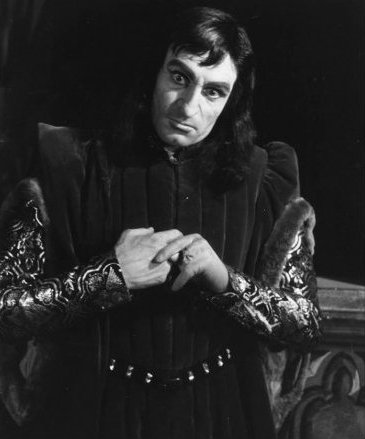 |
Richard
was feeling good about his chances when he went to
bed. However, William Shakespeare suggested
Richard was having nightmares.
If one
believes Shakespeare, Richard had murdered
enough victims to fill a cemetery.
Through
the centuries, Shakespeare’s
dark depiction of Richard has
remained unshaken.
No one who has seen Richard III has
any trouble visualizing Richard as a
deformed Machiavellian
who betrays his dead brother,
murders his nephews to gain his crown and poisons
his wife to pursue his voluptuous niece.
As a malicious, deceptive and bitter usurper who seizes
England’s throne by nefarious means,
Shakespeare’s
Richard revels in his own villainy.
In his famous “Now is the winter of our discontent”
speech, Richard
shamelessly proclaimed:
“I am determined to prove
myself a villain.”
|
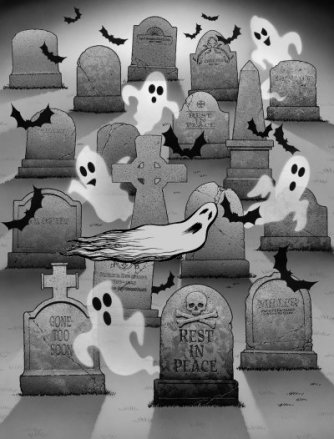 |
| |
|
The
problem for the audience is that Richard is so damn
interesting. Richard is an undeniably charming and complex
figure who sucks in the audience with his immoral logic
and dazzling wordplay. The audience
shakes its collective head in astonishment that
someone this shrewd had to resort to such foul means
to get what he wanted.
But then we stop liking
Richard thanks to a brilliant Shakespeare scene...
Richard's nightmare. In this nightmare,
Richard’s sins come back to haunt him – quite
literally!!
According to William
Shakespeare, on the eve of
battle, Richard was haunted by the memory of his
crimes. Shakespeare
has found a clever way to help us recall each of
Richard’s murder victims. The
specters of these victims appear one by one in a roll call of ghosts
who
visit Richard in his sleep.
They each point to Richard
and claim to have been murdered by
the king.
| |
 |
•
Prince Edward of
Westminster
•
King Henry VI
•
George, Duke of Clarence
•
Earl
Rivers (Anthony Woodville)
•
Richard Grey
•
Thomas Vaughan
•
Lord Hastings
•
The Princes in the Tower
•
Duke of Buckingham
•
Queen
Anne Neville
|
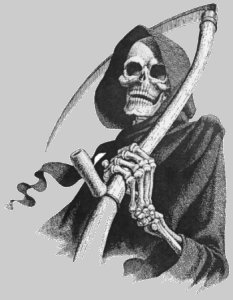 |
|
| |
The
king is visibly shaken
by the ghosts of his murder victims. One by one, each ghost
recalls what Richard has done to them and condemns
him to death on the battlefield. The
ghosts parade
past Richard and chant "Despair and die!"
Smug and
confident earlier in the night,
Richard is now struck by doubt.
Forgetting the glee he
formerly took in his wrongdoing, he suddenly lacks
conviction about the wisdom of his actions.
“O no, alas, I rather hate
myself for hateful deeds committed by myself.... I am a
villain.”
At one point, there were so many ghosts, the stage
barely has room to accommodate them all. There
was also a strange twist in the dream scene.
Shakespeare forced Richard to stand by and watch as
the ghosts leave to pay Henry Tudor a visit.
The ghosts offer
encouragement in the upcoming battle. Richard was
understandably quite shaken
when he awoke.
Shakespeare
believed what goes around comes around.
Shakespeare knew the audience would take
satisfaction in the thought that Richard's
evildoings would come back
to haunt him, first in his
dreams, then on the battlefield. At
heart, most people in Medieval England yearned for
justice and fair play. The rest took part in
the War of the Roses.
|

|
The Battle of Bosworth |
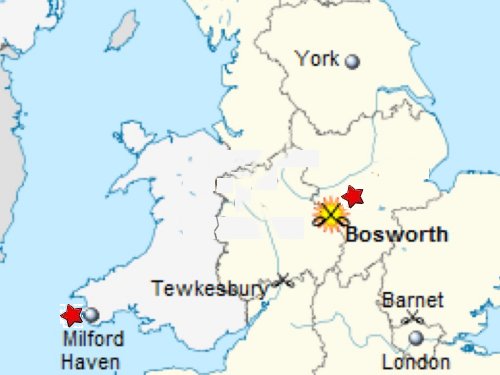 |


| |
|
Battle Positions
|
|
|
|
|
On the
morning of the battle, 22 August 1485, four armies
converged on a field south of Bosworth Market, 13
miles west of Leicester: Richard, numbering 12,000;
Henry, numbering 5,000; and two Stanley
armies, some 5,000 when combined.
Richard
had expected to have an even larger army. Richard
had called the lords of the realm to assemble under
his banner at Leicester on the 16th of August.
But many
of his vassals either failed to answer the royal summons
or conveniently got stuck in transit.
Nevertheless Richard was pleased to note his force
still greatly outnumbered his opponent. His
nightmares aside, Richard was quite confident of
victory as the battle began.
The
chief lords who did join their king were John
Howard, Duke of Norfolk, and Henry Percy, 4th Earl
of Northumberland.
John Howard
had been Richard's right hand man from the moment
Richard made his rise in 1483. Now here at
Bosworth, Howard was Richard's most trusted general. Norfolk commanded the Yorkist Vanguard to Richard's
right. The men under Richard's control had a deep, soupy marsh on
the
left to use as a defensive measure.
Henry Percy
was in the rear with 7,000 reserves. Richard had
a bad feeling about Percy. Richard had paid a
high price to win Percy's loyalty, but today this
man was worried about something.
Since Richard
had so many men, the field was not wide enough for
everyone to fight
at once. So he placed a considerable force in
reserve under Lord Northumberland. Just to be sure,
Richard placed a close watch on Percy when the
battle started. Richard didn't want Percy to
turn his own men on him. Richard was sick and
tired of people betraying him.
As
expected, the two Stanley armies moved into neutral
positions on a hill. They stood side by side
about half a mile apart.
|
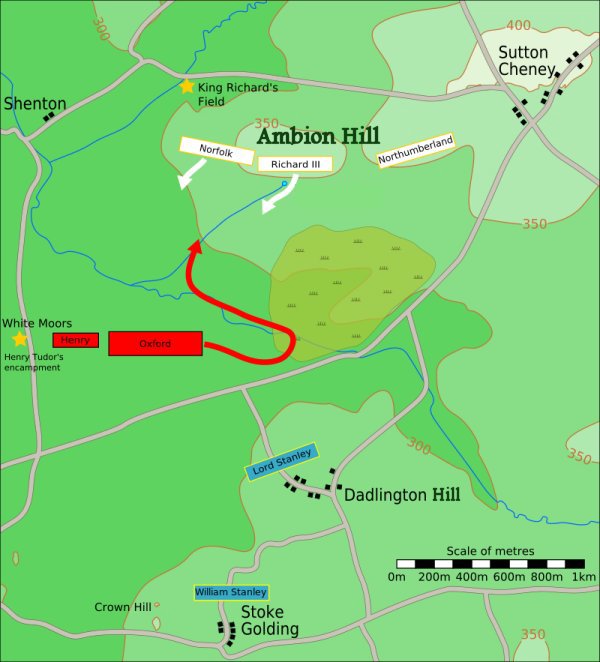 |
| |
|
Henry Tudor took the field with a
motley crew. Among his 5,000 men were roughly 1,000
French, 2,000 Welsh, 500 Scots, and 1,000 dispossessed Lancastrian exiles
plus a few York loyalists who
couldn't stand Richard. In other words,
Henry's army was comprised of everyone who hated the
Yorks plus everyone who hated the English... French, Welsh, and Scots.
Henry
was outnumbered 2 to 1. However, with half of
Richard's army held in reserve, the numbers were
roughly equal on the front line.
Henry was
well aware of his military shortcomings, so he put his friend John de Vere, Lord
Oxford, in charge of the planning. This was
Oxford's chance to redeem himself. Fourteen
years earlier, Oxford should have been the hero at the
1471 Battle of Barnet. Instead, Oxford had
lost
control of his men who decided to begin partying before the
battle was over. Amazingly, the vastly
superior Lancaster side lost the
battle. Warwick was killed and Edward IV regained
the throne. Given this shocking turn of
events, Lord Oxford's guilt must have been immense. Oxford
had disliked Yorkist King Edward, but he absolutely despised
King Richard. Oxford was burning to put this man
down once and for all.
Neither
Richard nor Henry moved to the front.
Henry, unsure of his fighting ability,
remained in back of Oxford's vanguard surrounded by
elite Welsh bodyguards. Richard
on the other hand was a warrior. He fully
intended to fight. However,
right now there were too many uncertainties... the Stanleys, Lord Northumberland, as well as Oxford's
initial strategy. Therefore Richard chose to stay up on the
hill where he could survey the situation.
Flanked by his own elite unit of mounted bodyguards,
Richard was content to let Norfolk take the lead.
The
battle unfolded when Oxford began advancing the Lancastrian
forces towards Ambion Hill in one body. His
right-wing was protected by the marsh. An exchange of
arrows and cannon fire followed. Richard had
more cannons, so Oxford decided to get closer to
Norfolk's men as the best protection from further
cannon shots.
|
| |
|
When
Richard saw Oxford advancing, he
ordered Norfolk to attack the enemy just after they
passed the marsh. Norfolk’s vanguard came down Ambion Hill
to
engage Oxford's force at the base. In the fierce melee that
followed, men hacked at each other in brutal
hand-to-hand combat using weapons such as the pole-axe,
hammer, battle axe, spear, mace, and long sword.
Norfolk's men were surprised when Oxford
suddenly moved his men into an
unusual V-shaped wedge. This wedge was a
favorite French offensive maneuver. During his
outlaw years, Oxford had
spent time fighting in France as a mercenary.
He
knew this formation well. In addition, his
cadre of French mercenaries was also quite familiar
with the technique. Hoping his opponent had
not studied recent French battle tactics, Oxford had
told these men in advance that he was planning to
use this maneuver.
Oxford placed two
banners in the ground, and encouraged his men to
form up between them in a V-shape. This created a solid
wedge of men similar to an arrow's point.
Norfolk had never seen this formation before. When Norfolk charged, he found
Oxford’s Wedge difficult to attack. Norfolk's
force was getting the worst of the melee, so Norfolk
risked his life trying to counter-attack. Bad
move. His risk failed and Norfolk was killed,
some say felled by Lord Oxford himself.
Richard had lost his best friend and finest ally.
|
 |
| |
|
Historian Chris Skidmore discusses Oxford's French
connection.
HENRY TUDOR'S SECRET WEAPON: THE FRENCH
With too few English men to fight in his army,
Tudor had been forced to recruit trained
mercenaries from Normandy to fight for him.
These French forces seem to have been experts in
military warfare, and were quickly able to
establish "by the king’s shot the lie of the
land and the order of his battle". The
Burgundian Chronicler Jean Molinet wrote how the
French troops, led by Philibert de Chandee -
whom Henry VII would later reward with the title
Earl of Bath - ordered for Tudor’s force to be
reassembled, and "in order to avoid the fire"
and instead to attack the right hand flank of
Richard’s vanguard, that seems to have caused
confusion in the royal army. Richard’s vanguard
was broken and soon dispersed and the French,
according to Molinet, "obtained the mastery of
his vanguard". A letter written by a French
soldier shortly after the battle, described how
Richard was heard crying “These French traitors
are today the cause of our realm’s ruin".
|
| |
|
Richard was aware that Norfolk had fallen. However, the
advantage of numbers was still with Richard and the Yorkists.
The problem for Richard was that Norfolk's battle lines
began to disintegrate without Norfolk's leadership. Richard ordered
Northumberland to bring up his reserve and join
Norfolk's hard-pressed men.
To
Richard's stupefaction, Lord Percy either did not
get the message or refused to participate.
Historians argue to this day whether this was
treachery or simply an inability of Percy to find
room to maneuver his force around Richard’s force or
around the marsh to the left. There are those
who suggest the Lord of Northumberland may have had
a pre-existing understanding with Lord Stanley (who
else?).
Percy's
men claimed unable to cross the marsh,
but Richard didn't believe a word of it.
He felt betrayed.
Given Richard's earlier suspicion, Richard concluded
'Treachery' was the more likely answer.
Whatever the reason, the reserve forces did not move
and Norfolk's line was about to collapse.
| |
Historian Chris Skidmore discusses the
reports of treason.
ABANDONED BY THE EARL OF
NORTHUMBERLAND
With the collapse of his vanguard,
Richard would have expected that his
rear-guard, led by Henry Percy, the earl
of Northumberland, to provide reinforcements.
Instead the earl did nothing. One
chronicler was insistent that "in the
place where the earl of Northumberland
was posted, with a large company of
reasonably good men, no engagement could
be discerned, and no battle blows given
or received". Northumberland, Jean
Molinet observed, should have "charged
the French" but instead "did nothing
except to flee, both he and his company,
and to abandon his King Richard" since
he had already agreed a secret pact with
Henry Tudor.
Northumberland was a northern lord whose
own power had diminished over the past
decade as a result of Richard’s rise to
power. He had nothing to lose and
everything to gain from abandoning his
king. Other reports from the battlefield
suggest that Northumberland may have not
only left Richard to his fate, but
actively turned against him and "left
his position and passed in front of the
king’s vanguard", at which point,
"turning his back on Earl Henry, he
began to fight fiercely against the
king’s van, and so did all the others
who had plighted their faith to Earl
Henry". If this were the case, it would
explain why Richard had been heard
"shouting again and again that he was
betrayed, and crying ‘Treason! Treason!
Treason!’"
|
| |
Things
were getting desperate. Oxford's men may have been out-numbered,
but they had more hate in them than his own men.
Plus they had the momentum thanks to that strange
wedge formation. The Wedge was pushing
Norfolk's men back towards Richard's men in the
rear. Something had to be done to bolster Norfolk’s flagging forces.
What was Richard to do? Norfolk's line
was floundering, Northumberland
stayed mysteriously rooted to the spot, and Stanley
continued to defy
his order. Realizing it was up to him to save
this battle, Richard mobilized his own force down
the hill to fill the breech.
Richard
watched in horror as the battle was in danger of getting away from him. Richard's eyes
automatically turned to the two Stanleys.
There they stood with their 5,000 men positioned on Dadlington Hill
less than a mile away. Richard was
infuriated. That damn Thomas Stanley!!
Why didn't he fight?
Incensed that Lord Stanley
still refused to participate, Richard
sent three messengers to Stanley with a curt and
quite frustrated demand... "Order your men to fight
now or watch your son die!"
15
minutes later the messengers were back.
Richard anxiously asked them what Stanley had said.
Lord Stanley's reply was so
unbelievable, it became instant military legend.
"Tell
Richard I have other sons."
Furious
at Stanley's defiance, Richard ordered his hostage, Lord Strange,
beheaded. However, in the heat and confusion of battle,
the order was not carried out... probably because no
one wanted to carry out the order. Whether
Richard won or lost, after the
battle, Lord Stanley would undoubtedly seek the
identity of the executioner and have his vengeance.
Since Richard was too busy to see if his order had
been carried out, Lord Strange was never touched.
Lord Stanley
never budged an inch throughout the battle.
|
| |
|
Richard's Charge
Henry
was feeling abandoned. Lord Stanley had
promised to help days earlier, but had yet to move.
This was bad news. Henry was still convinced
his army had no chance of victory against these
superior forces without Lord Stanley's help.
On the
other hand, he was encouraged by Oxford's
considerable success. Henry wasn't going to
give up without a fight. Seeing Richard's men
come down the hill about to attack Oxford, Henry
decided to advance his own men forward into the
battle to support Oxford's vulnerable right.
Henry moved his men to the right where there was an
opening between Oxford and the marsh.
Richard
could see that Henry was headed into the gap before
him. There were men fighting there, but
very few. No doubt Henry was moving to check the
advancement of the men Richard had recently sent
into battle. However, Henry had no idea
Richard was sitting right behind those men with his
own elite mounted guards.
|
 |
| |
|
Henry
was on foot with a relatively small force of men,
several hundred at best. Richard was
incredulous... Henry had no idea he had just exposed
himself to great danger. Richard tensed like a
panther ready to pounce upon an unsuspecting prey.
Richard
was certain he had just been given the chance to win outright
by killing Henry. This was the moment Richard
had been waiting for. He is said to have
uttered:
"God forbid I yield one step.
This is the day I will
die as a king or win."
With that, he ordered 200 men of his mounted
bodyguard
to charge.
The
horses came down the hill towards Henry at breakneck
speed. They penetrated through Richard's own
line, raced through the gap and took on Henry's
force directly.
As King Richard
and his mounted knights crashed into Henry’s
unit, their force was so great that Henry's men
barely withstood the initial onslaught.
|
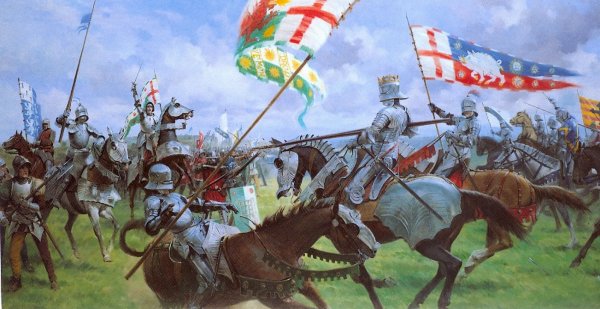 |
| |
 |
This was
an incredibly dramatic moment. In poker terms,
Richard was all in. He was risking everything
in a foolhardy attempt to take out Henry all by
himself. As
Shakespeare would put it, Richard had chosen to risk
his life on this cast of the die. Interesting
choice of words, yes??
Charging
recklessly at the head of his knights, Richard
reached Henry’s contingent first. Richard's lance struck
Sir William Brandon, Henry's
standard-bearer, in the
chest so hard that the lance broke in half. The powerful
thrust knocked Brandon
from his horse; the man was dead before he hit the
ground.
Riding
on, now Richard faced Sir John Cheyne, Henry’s
personal bodyguard. Cheyne was a huge man who was a renowned jousting champion.
Fearless, Richard unhorsed the giant using just the broken stub of his lance.
And then
it happened... Richard's horse was wounded.
In pain, the horse reared up and threw Richard to
the ground. Richard was down.
|
| |
|
 |
| |
|
Richard
was not hurt, but he was in great danger.
He was angry to see that Henry was still safe. Somehow Henry Tudor's Welshman had held firm against
the initial onslaught. They were still in
shock, but soon the Welsh bodyguards will begin to counter-attack.
Richard realized he had been far too impetuous in
his headlong charge. However, he still had time
to get away.
Henry's men had not regrouped sufficiently from the
wild charge. If Richard could find another
horse, he could flee and escape danger.
This was
the moment immortalized by William Shakespeare.
|
King
Richard:
A horse, a horse! My kingdom for a horse!
William Catesby (Richard's
councilor):
Withdraw, my lord! I'll help you to a horse.
King
Richard:
Slave! I have set my life upon a cast.
Now I will stand the hazard of the die.
Richard III, Act 5, scene 4,
7–10
|
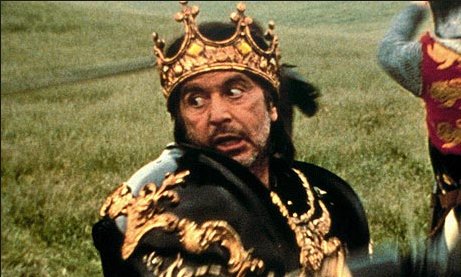 |
| |
|
After
Richard lost his horse, he bravely decided to stick
around. This was a bold move because now it was
Richard and his men who were out-numbered fighting
here behind enemy lines. Undeterred, Richard
rose and engaged several attackers by himself.
Observers of the action would later assert this was
Richard's finest moment. He fought off these
men single-handedly with great courage and skill.
In so doing, this bought Richard enough time for
help to arrive. Seeing their leader fall to
the ground, Richard's nearby men came to the rescue of
their leader. They regrouped around the king
to fight off Henry's men. This in turn gave
reinforcements coming from the marsh enough time to arrive.
Richard's foot soldiers had seen the mounted riders
race through the "Gap". Naturally they
had followed their leader who was fighting for his
life 300 yards downfield. Given time, the foot
soldiers had caught up to join the fight. This
was a major turning point.
Henry
was nearby and unsure what to do.
While Richard was an
undisputed warrior, Henry was
just the opposite. At
Bosworth, Henry waited on the sidelines and let others
do his dirty work for him. That
said,
to his credit, Henry did not
run. However, he was thinking about it.
Henry kept a horse nearby in case the battle was
lost. And right now it did not look good for
Henry.
Richard's one-man stand had evoked images of Henry
V, the great warrior king of Agincourt. His
maniacal fighting was infectious, evoking a passion
in the men which they had previously lacked.
Richard's men rallied around their indomitable
leader.
|
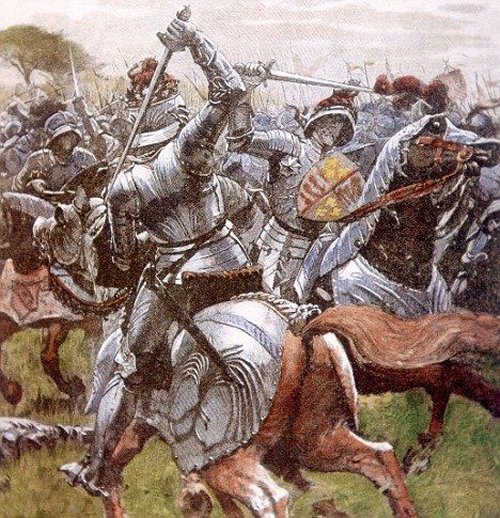 |
As for
Henry's forces, they sorely lacked leadership.
According to several sources, Henry did not even
swing his sword, but rather just stood there
cowering behind his Welsh guardsmen. Suddenly
out-numbered, Henry's meager force buckled.
Although Richard's wild charge had failed to reach
Henry, it had done a fine job of disorganizing
Henry's defense. The York foot soldiers
trailing the horsemen were on the verge of breaking
through the enemy line. Henry's men were
fighting for their lives.
Now that
the foot soldiers had joined the fight, it was just
a matter of time. Richard should have won
right here.
But he didn't.
|
| |
|
Instead
Richard was hit by a ferocious Sucker Punch.
When
Richard had made his mounted charge down the hill,
Stanley could see the horsemen making a determined
beeline for Henry's exposed right flank.
Realizing Henry was in serious trouble, Stanley
decided to intervene. He ordered his own men
to ride forward and cut off Richard's attack with a
surprise entry into the battle.
With Stanley's men coming in from behind with full
fury, Richard's men never knew what hit them.
It was a sneaky move, yet brilliant in its timing.
All's
fair in love and war...
Richard's men died swiftly, many of them with swords
in their backs. Others laid down their weapons
and surrendered. It was over.
Or
should we say it was over for everyone but Richard.
Unaware of Stanley's intervention, Richard was ‘fighting
manfully in the thickest press of his enemies.’
Richard
had been fighting so hard at the center, he had no
idea what was going on around him. However,
once his protective layer of men had been stripped
away, Richard suddenly became aware of the wolf pack
of men surrounding him.
With a
shudder, Richard saw their banner... these were
Stanley's men.
Seeing
that Richard was cornered, the wolves began to
approach. There
would be no escape. Richard had no choice but
to fight to his death.
|
 |
Richard's Final
Moments
(Rick Archer's Note: A woman named
Marilee Hanson wrote an eloquent passage about
the end of Richard's life. I was so
impressed that I prefer to give Ms. Hanson the
honor of finishing this part of the story.)
|
In the words
of Marilee Hanson:
Richard was wounded several times but
continually refused the advice of his few
companions to flee. He also refused
the offer of a horse. His heroism was
evident to all. In the end, Richard
could not prevail. Fighting alone,
Richard was virtually the last man standing.
Around him lay the bodies of his few
companions – Conyers, Brackenbury, Ratcliffe.
His crown was knocked from his head; his
head was struck so many times that his metal
helmet was beaten into the skull; even after
his death, his body continued to be beaten.
There is a legend that his crown landed in a
hawthorne bush; true or not, it was soon
enough in Henry Tudor’s hands – and not
because of any personal bravery on the part
of the first Tudor king.
It cannot be emphasized enough that Richard
III died valiantly in battle.
The battle lasted about two hours. Its
outcome – Henry’s triumph – was only made
possible by Stanley’s disgraceful betrayal
of his king. Had he waited a few
moments longer, Henry may have been
personally killed by Richard. That single
action inaugurated the Tudor dynasty – and
it was a shameful inauguration.
Richard III, who had fought so heroically
and suffered an awful death, continued to be
humiliated and abused. His body was
stripped of armor and underclothes.
Then his naked body was slung limply over a
horse with arms and legs dangling at the
sides. A halter was tossed around his
neck to symbolize his defeat. In this
shameful manner, Richard was taken to a
friary in Leicester where his body lay on
view for two days; it was naked from the
waist down except for a scant and cheap
black cloth.
|
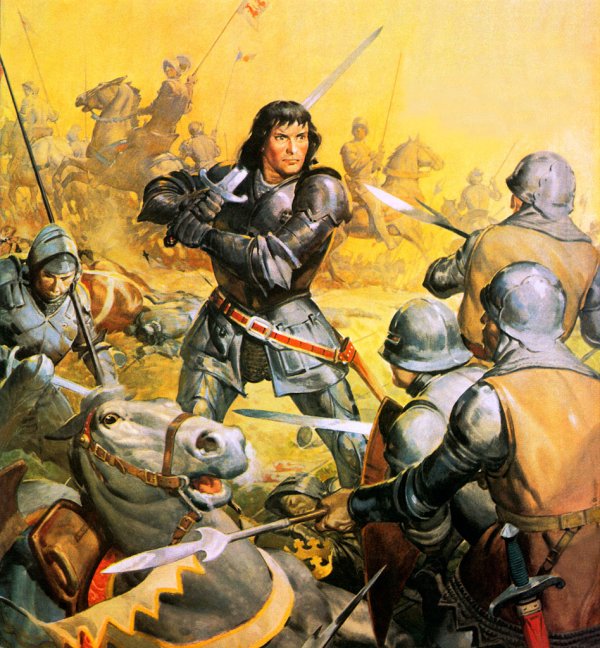 |
 |
Richard was buried at the friary with no
ceremony in a pauper's grave. The church no longer exists
– Henry’s son ordered the dissolution of the
monasteries in the 1530s. Richard’s grave
was opened and the body thrown out. Later,
the coffin was supposedly used as a horse
trough and cellar steps in a nearby manor.
Richard III remains the only English king
since 1066 to have no burial place. He
was also the last English king to die in
battle.
Henry Tudor had declared himself King Henry
VII after Lord Stanley placed Richard’s crown
upon his stepson’s head. His officers were
busy settling old scores, executing old foes
and rounding up the prisoners. In the end,
we can reasonably estimate that about 400
men – in total – died that day. Few wanted to talk about the actual fighting
after the battle. Those two hours
ended in betrayal and death for one king and
started one of the most celebrated dynasties
in English history.
On a personal note…. I
do want to stress that Henry Tudor did not
participate in the fighting – and, in fact,
he kept a horse nearby so he could flee if
the battle was lost. In other words,
Henry planned to ‘turn tail and run’, as the
cliché goes.
It might seem odd that a king who supposedly
won his crown in battle was actually quite
cowardly on the battlefield, and didn’t
participate – but it is the truth. Richard
III only lost because Lord Stanley
disgracefully betrayed his king. And he did
so after Richard had already forgiven him
numerous offenses (many bordering on
treason), and had treated him kindly. Henry
may have claimed a crown that day, but he
claimed no glory.
If you wish, you may visit the Richard
III Society site for the other side
of the story.
|
|
Kill Shot
After
Richard had been knocked off his horse, he wandered
the battlefield looking for Henry. He killed every man coming into his
way with fatalistic rage. Then Richard spotted
Henry a hundred yards away. Henry was clearly
visible beneath his banner. Richard sniffed
with disgust at Henry hiding behind the Welsh
bodyguards
battling to keep him alive. Full of scorn,
Richard decided to finish the issue himself.
Full of battle fury, Richard drew his
battle axe and moved stealthily towards Henry.
Although Richard was in the absolute thick of the
battle, he still wore his crown. Knowing full
well this made him a marked man, to his credit,
Richard refused to take it off.
Suddenly
a large group of men appeared out of nowhere to
block his path.
Richard was confused. He had nearly reached
Henry when this
sudden press of new attackers forced him to abandon
his path. Richard realized that he and his knights were
being driven back into the
marshy ground by a much-superior force.
With
Richard did not know was that William Stanley had
been watching the battle from his armchair seat on
the side of the battlefield.
Seeing the great peril that Henry was in, William
Stanley had launched his men into action on the
Tudor side.
Stanley's rescue almost didn't make it. In addition
to Richard's approach, there were other fighters on
the verge of breaking past Henry's tiring
bodyguards. Stanley's men arrived just in the
nick of time. Now Henry's imminent demise changed in
the blink of an eyelash as Stanley's men descended
with brutal effectiveness.
|
| |
Richard's men never knew what hit
them.
Shortly
after Stanley's men charged into the flank of
Richard’s household knights, Richard realized he was
surrounded. Where did these new men come from?
They were not here a moment ago. Then Richard
saw their banner and froze. These were
Stanley's men. Richard knew he was doomed.
Screaming “Treason!”, Richard hacked left and
right with his battle axe. So did his
remaining coterie.
Outnumbered, Richard's group fought valiantly but
were cut down one by one.
Now it
was just Richard. As the wolf pack approached,
Richard prepared to die a soldier's death. The
blows came from every direction. An arrowhead
was found embedded in his spine. It was this wound,
inflicted by an enemy archer at close range, that
most likely brought the battling King to his knees.
Richard
suffered 10 deep wounds. The kill
shot was a blow deep into the back of Richard's head by a
halberd. The blow was so strong it cleaved a
giant hole into his skull and left chips of his
metal helmet buried in his brain. This deep
gash would serve as a gruesome testament to the horror of
Richard's last fight.
|
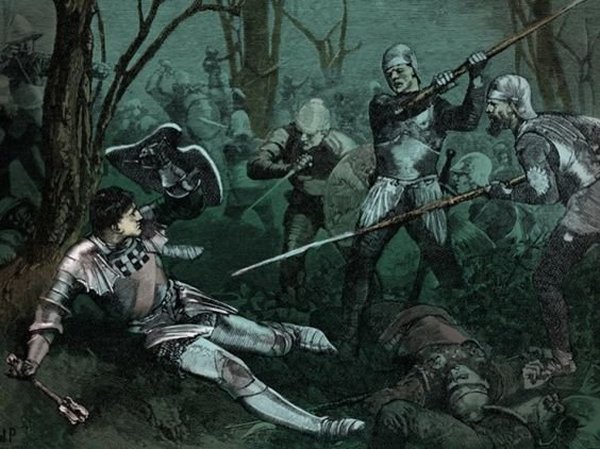 |
| |
|
Richard
was the final Plantagenet King of England. He
was also the last English king to die in battle.
Every
observer, sympathetic or otherwise, agreed that Richard
had
fought bravely to the end.
John Rous,
a man who compared Richard
to the Antichrist, admitted, “If
I may say the truth to his credit, though small in
body and feeble of limb, Richard
bore himself like a gallant knight and acted with
distinction as his own champion until his last
breath.”
|
|
|
|
Shortly
after Richard's death, Lord Stanley appeared at the
site. As Stanley stood there viewing Richard's
lifeless body, a courtier named Reginald Bray
noticed Richard's crown had fallen into a nearby
hawthorn bush.
Stanley
asked Bray to hand the crown to him. Then
Stanley turned towards Henry and placed the crown on
his son-in-law's head. Then Stanley stepped
back and took a knee. Everyone in attendance
grasped the solemnity of the moment and did the
same.
Lord Stanley
saluted him as king, while the soldiers shouted for
'King Henry!'
There on the battlefield, Henry Tudor was crowned as Henry VII.
To the
winners and traitors go the spoils. Henry Percy, Earl of
Northumberland, the man who withheld 7,000 men from
Richard, was taken prisoner. He did not
suffer for long. Henry Tudor, now King Henry
VII, soon released
the last Percy heir
from the Tower of London.
Henry appointed him Lord Warden of the East
and Middle Marches, thereby
generously rewarding Percy's treachery and perhaps
pointing to a possible secret deal made by Percy and
Lord Stanley beforehand.
Henry
also rewarded
Thomas Stanley, his “right
dearly beloved father”. Henry made Stanley the Earl of Derby
on 27 October 1485. The following year Henry confirmed
Stanley as Lord High Constable of England and
High Steward of the Duchy of Lancaster, besides
granting him other estates and offices. In 1486
Stanley also stood as godfather to Henry’s eldest
son, Arthur, Prince of Wales.
Lord
Stanley had elevated fence-sitting to an art form.
One can only wonder how his son Lord Strange felt towards his
father for offering him up as a lowly pawn.
John Howard,
Duke of Norfolk, was virtually the only person who did not desert Richard that day.
Howard was rewarded for his loyalty with a arrow
through his face after his helmet was pulled off during the battle.
Curiously, Shakespeare wrote in his play that
Norfolk had been warned the night to be very
careful. This warning was attached as a note
to his tent.
'Jack of Norfolk be not too bold for Dickon, thy
master, is bought and sold'
'Dickon',
of course, is slang for Richard. Legend has it
that Northumberland had been bought off by Lord
Stanley prior to battle. If so, Treachery
indeed.
|
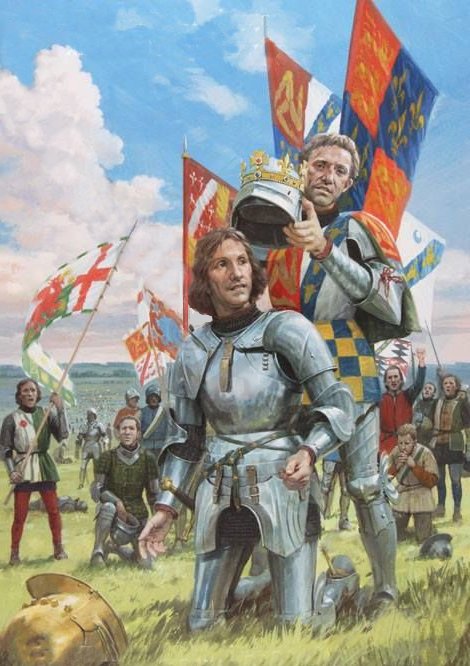 |
| |
|
King Henry VII
|
| |
|
Henry
Tudor became king of England at the age of
twenty-eight. His
mother Margaret burst into
a flood of tears at his coronation.
Henry VII did indeed marry Elizabeth of York, a
union which put a welcome end to the War of the
Roses. During Henry's reign, playing
cards were invented. The portrait of
Elizabeth has appeared eight times on every pack of
cards for the last 600 years.
Although
Henry was not a particularly popular king, he did
have his virtues. For one thing, Henry proved
to be an able administrator. He was also
extremely frugal, 'miserly', a trait which restored England to
financial security.
One of
Henry's wisest moves was to forbid nobles to retain
their own armies. After observing how his
step-father Thomas Stanley had held both Richard and
himself hostage to his power, Henry learned his
lesson. From now on, a small number of
attendants was acceptable, but Henry did not want
any lord to have more power than the king.
Edward IV had attempted the same maneuver, but had
not gotten very far. Henry did much better.
He was aided by a simple fact... as king, he owned
most of the gunpowder in the country. Henry simply blew up the castle of any
recalcitrant baron. It was a very effective policy.
In general the English nobility was already in
decline thanks to the decimation during the Wars of
the Roses. Under Henry, the power of the
nobility fell even further while the King grew in
power.
It is
said that Henry lacked the majesty and charisma of
his son Henry VIII and his famous granddaughter
Elizabeth I. But maybe charisma was not
important during those years. Henry was better
known as a plodder. His attention to detail, hard work, dedication, and discipline was exactly what
England needed.
Henry
VII was succeeded by his son, the tyrannical and
bloodstained Henry VIII. Henry VIII is
probably the best-known king in English history, but
for all the wrong reasons. Henry VIII was
famous for marrying six wives and executing two of
them. His problems with the Catholic Church
would lead to much bloodshed and heartache in years
to come. Henry VIII gave us
Bloody Mary, the fanatic
Queen who burned Protestants at the stake in her
Catholic zeal.
On the
other hand, Henry VIII also gave us Elizabeth I by
Anne Boleyn.
Elizabeth
was said to be wily and
highly astute.
She had to be! Elizabeth survived an
appalling childhood and adolescence to emerge as the
ablest of the Tudors.
Elizabeth nimbly
survived the many
assassination attempts made on her life.
Coming to power as a
Protestant at a time when the Catholic Church was fighting
to retain religious supremacy in England, Pope Pius V issued
a proclamation giving any Catholic the green light to rise
up and assassinate her.
Elizabeth’s life was in
constant danger after that. There was the Barge Incident,
the Ridolfi Plot, the Throgmorton Plot, and of course the
infamous Babington Plot, the one that would cost Mary, Queen
of Scots, her life.
In December 1583, Elizabeth wrote to the French Ambassador:
“There
are more than two hundred men of all ages who, at the
instigation of the Jesuits, conspire to kill me.”
Queen Elizabeth was not
exaggerating. However, she escaped
every single attempt on her life unscathed. It seems
evident that Elizabeth I shared many qualities with her
grandfather, Henry VII, the first Tudor king. Both were
shaped by perilous upbringings to become cautious,
careful rulers who trusted their own instincts over their
advisors. This distrust served them in good stead.
Elizabeth went on to lead
England for 45 years. Elizabeth was a
remarkable woman who was noted for her learning and wisdom.
She
was popular with the people of England and had a knack for
selecting capable advisors. Unlike many rulers, the
welfare of her people was her main objective.
Elizabeth oversaw the
expansion of England's sea power. The Spanish Armada was
decisively defeated in 1588 and Raleigh's first colony in
Virginia was founded. With Shakespeare at the
height of his popularity, prosperity at home, and dominance
in foreign relations,
the
Elizabethan Era
became a celebrated time in
English
history. When my friends and
I visit the Texas Renaissance
Festival every fall, we are reenacting the
classic 16th
century of England.
Alas, Elizabeth chose never
to marry, so she was the
last of
the Tudor monarchs.
With no offspring to take her place, Elizabeth
gave tacit approval to the appointment of James, son of
Mary, Queen of Scots, to take her place. With Elizabeth's
death, the House of Tudor (1485-1603) came to an end.
The new King James took the
throne largely because James was about
the only man left with a drop of royal blood. Oddly
enough, Elizabeth had executed the young
man's mother, Mary, Queen of Scots.
Then she turned around and made Mary's son the next English
king. Weird? No kidding. That is why I love English history so much.
English history is so deliciously
perverse and unpredictable.
|
 |
Elizabeth
Woodville Revisited
There is
an excellent chance that the real Elizabeth
Woodville wasn't nearly as nice and decent as the
woman portrayed in the White Queen.
There are hints she was a schemer in her own right.
However, that side of her got short-shrift in the TV
series. We are all so much at the mercy of how
the script writers wish to portray each character.
Ostensibly the White Queen
was a tale about an unusually pretty girl who waylaid a
King by the roadside. After Elizabeth used her magic ways to
capture Edward's fickle heart, she was in for a wild
ride. Such a
scandal! For a king to marry a widow (i.e. not a virgin),
a commoner once married to the enemy, a woman 5
years older than the King, this was unheard of.
For this coup alone, Elizabeth Woodville would go
down in history as a woman best known for marrying
well above her station and brilliantly capitalizing
on it.
The
legacy of Elizabeth Woodville is quite impressive.
Considered an 'unsuitable woman' for the throne, she gave birth to
twelve
children!! Together Edward and Elizabeth had 3 boys and
7 girls (5 of whom lived to adulthood).
Unfortunately, Elizabeth Woodville would suffer much
heartache in the process. Sad to
say, three of her five sons were likely murdered by Richard
III. One died young and one by her first
husband survived.
The
match brought his Queen and her family right into
the thick of the Wars of the Roses.
Over the next twenty-four
years, Elizabeth would experience five changes in
leadership, ten children, five uprisings, god
knows how many battles, two missing Princes and a
slew of dead relatives. Despite intense
heartache, in the end, Elizabeth had the satisfaction
of knowing her namesake daughter would become
the next Queen of England. Every
monarch that has sat on the throne from Henry VIII
onwards has been her descendant.
|
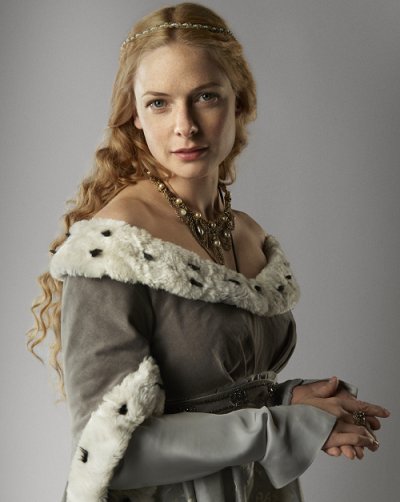 |
On a
personal note, the main reason I wrote this long
story about the War of the Roses was
to learn more about Lord Stanley.
Quite frankly, I doubt there would have been a Tudor
Dynasty without Lord Stanley. I also doubt
very many people know who he was.
And yet
look how remarkable Stanley was!! In a story
dominated by fearsome warlords such as the Duke of
York, the Earl of Warwick, George Plantagenet, the
Duke of Birmingham, Margaret of Anjou, Edmund
Beaufort, Henry Percy, Richard III, there was one
man - Lord Stanley - who stayed completely unscathed
for the entire 32 years.
I
certainly had no idea how important Stanley was
until I saw the White Queen series on
television.
But the
funny thing is, although the show was supposedly
about Elizabeth, somewhere along the line Margaret
Beaufort stole the show. And in many ways Lord Stanley
stole the show from her.
To me,
Lord Stanley was by far the most interesting
character in the entire series. Lord Stanley
was responsible for the most remarkable quote I
think I have ever heard.
In the tenth
and final episode, when Stanley replied to Richard,
"I have other sons", I practically fell out
of my chair.
Who on
earth takes chances like this with his son's head on the line? At the time, I told
myself if I ever got the chance to learn more about
this strange man named Lord Stanley, I would do so.
Even though I spent over seven long weeks researching the
story, I am so glad I followed through with my
initial curiosity.
I have
long been intrigued with the Game of Thrones.
However, as twisted as this series has been, I
always told myself that this was fiction and nothing
this crazy could ever happen in real life. And
then I discovered the War of the Roses!
The War
of the Roses has seen a plethora of family feuding,
incest, crimes of passion, tragedy and acts
of cruelty that would stretch the imaginations of
even today’s most far-fetched soap opera writers.
Although Shakespeare's interest settled upon
Richard III, my interest fixated upon Lord
Stanley, the shrewdest of them all.
I am
more used to men like Warwick, or Richard of York,
or Margaret of Anjou, or Edward of York... men who
use war and power to further their interests.
Unless Lord Stanley did murder the Princes in the
Tower (unlikely according to the experts), I don't
remember Lord Stanley dropping a single drop of
blood outside of battle. Stanley gained his
power strictly through one daring chess move after
another.
Unlike the ruthless Richard III or serial traitor
Lord Warwick, Lord Stanley grew rich by clever
marriage and clever politics. Unlike the
others who died horrible deaths in pursuit of the
throne, Stanley advanced because he was perfectly
happy being the power behind the throne. He
raked in titles, lands, riches, and accolades
without aspiring to have his face on the money.
Or should we say both faces on either
side of the coin?
It was so perfectly fitting that
Lord Stanley, despite his earlier absence
at Bosworth,
was conveniently on hand to pick up Richard’s fallen
crown and place it on the head of the new king,
Henry VII.
Lord Stanley died at his estate of Lathom House in
Lancashire on 20 July
1504. Considering all the
dramatic chances he took throughout the Wars
of the Roses, Stanley was
fortunate to have died naturally at home, instead of
on a battlefield or on the scaffold.
It
had taken great skill not just to stay alive,
but to have enriched himself and his family in the
process. Expediency
was his watchword.
No
monarch however powerful
could ever completely rely on his loyalty or
support. Lord Stanley’s allegiances were
ever ready to shift in the winds of change,
his sails
always ready to altered and adjusted if the
situation demanded it.
At its heart,
the War of the Roses is a story about treachery and
double cross. Time after time,
people are always worse than
one can ever imagine
them being. Or so History would apparently teach
us. The War of the Roses showed
us what happens to people whose morals fall to
pieces when their ambition places them too close the
throne. As they say, power corrupts. And
so does ambition.
We watched
carefully as one shark after bit the dust.
Warwick, Margaret of Anjou, George, Edmund Beaufort,
Richard, Anne Neville, Isabel Neville, Edward of
Westminster, and all those French kings.
Elizabeth trusted no one, but she was helpless to
protect her children. Richard bestowed lands,
titles, honors right and left and look how much
loyalty that bought him. Margaret Beaufort
played the
angles and prayed till she was blue in the face, but
in the end found herself was helpless to win the
battle for her boy. Ultimately it wasn't
Margaret, but rather Stanley who put Henry VII on
the throne. Stanley played the game the best.
There is
a board game known as Diplomacy that I
have played over the years. By coincidence, it
has spots for seven players. I have observed
that the winner is typically the one who irritates
the fewest people in the early stages of the game
and who backstabs an ally at a critical juncture
late in the game. I personally am not fond of
backstabbing, so I don't win very often. But I
know how it's done.
More
than any character I have ever studied, Thomas
Stanley has produced a master class in how to
navigate one's way through tricky, dangerous situations with
head intact. His knack for treachery is a lesson for
the ages.
|
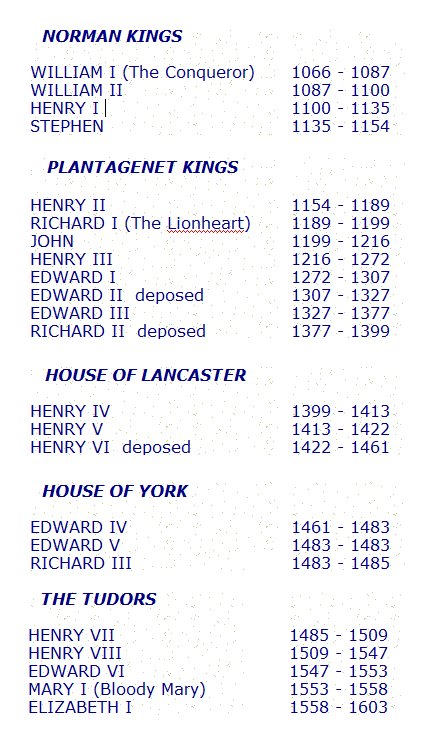
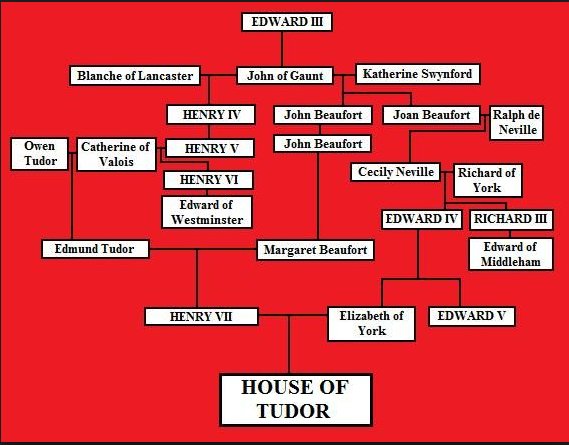
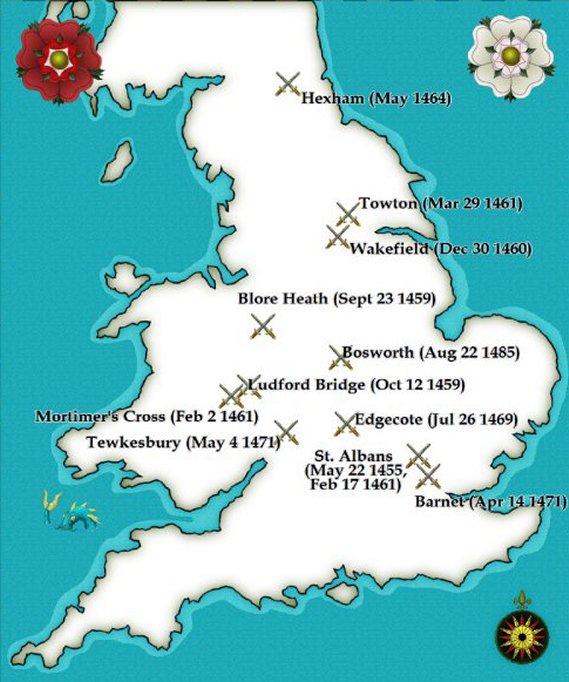 |
| |
The Discovery of Richard's
Grave
|
| |
Sometimes there are stories that are just
too good to be true... but then they turn out to be
true after all.
The
odds of finding the remains of Richard III
hiding for six centuries under a Leicester
parking lot were incredibly remote.
But that is exactly what happened.
When I first heard the story that Richard's
bones had been unearthed under a car park, I
assumed they had been excavating in the area
in preparation for putting up a new
building.
I was wrong. It turned out that they
were deliberately digging in this area for
this reason. This was
the idea of a woman named Philippa Langley,
a Scottish screenwriter and historian who
devoted several years to getting this
project underway.
Ms. Langley is the President of the Scottish
branch of the Richard III Society.
She attributes the discovery to a feeling
she had when first visiting the northern end
of the Social Services car park where the
king was later found. She had gone to
Leicester for the purpose of finding out
more about Richard for a screenplay she was
writing.
According to Ms. Langley, "The first time
I stood in that car park, the strangest
feeling just washed over me. I thought: 'I
am standing on Richard's grave.'"
With that kind of supernatural power,
perhaps
Ms. Langley is the descendant of Elizabeth
Woodville. She was greatly aided by Dr. John
Ashdown-Hill, the same gentleman whose ideas
contributed to the story of Edmund Tudor's
dubious parentage.
According to Wikipedia, in 2003 Ashdown-Hill
was asked by colleagues in Belgium to seek
the mitochondrial DNA sequence shared by
Richard III of England and his brothers and
sisters. He spent a year tracing an
all-female line of descent from Richard
III’s eldest sister, Anne, to Joy Ibsen, a
woman living in Canada.
In 2004 Ashdown-Hill was commissioned by the
BBC to research a story that Richard III’s
remains had been thrown into the River Soar.
He concluded that the story was untrue.
In 2009 Philippa Langley invited
Ashdown-Hill to lead a study day for the
Scottish Branch of the Richard III Society,
as a result of which the Looking for
Richard Project was founded.
In August 2012, after three years of hard
work persuading the authorities in
Leicester, the search for the lost remains
of Richard III began with the excavation of
the Social Services Department car park.
Is this unbelievable or what?
On the very first day of the dig - 25 August
2012 - bones were found in the area predicted
by John Ashdown-Hill and by Philippa
Langley. People gasped when they saw
the skeleton. A very pronounced curve
in the spine was immediately visible when
the body was first uncovered. The
first thing that crossed their minds was
this might very well be the 'hunchback'
referred to by Shakespeare. When
Shakespeare wrote of Richard III as a "bunchback'd
toad," he didn't have the benefit of
actually seeing the king, who had died in
the previous century.
It turns out that Richard had adolescent
onset scoliosis, a
curvature of the spine. In other
words, the deformity wasn’t present at
birth, but developed after the age of ten.
This lends strong support to the story that
George, Richard's older brother, pushed him
down a flight of steps during a fight
between the two boys. The resulting
injury likely triggered the onset.
Two weeks later, on 12 September 12 2012,
these skeletal remains were confirmed as
belonging to Richard III.
DNA research
proved that the DNA of the bones matched the
sequence from Richard III's descendants that
Ashdown-Hill had discovered back in 2004.
Ms. Langley and Dr. Ashdown-Hill were
awarded an MBE in the 2015 Queen's Birthday
Honours for "services to historical
research and the exhumation and
identification of Richard III".
Personally, I think the recovery of
Richard's remains is one of the greatest
accomplishments imaginable. I
congratulate them!
Incidentally, Richard's genetic tests have
revealed a break in the royal male line,
potentially undermining the legitimacy of
the entire House of Plantagenet.
Uh oh...
When scientists revealed last year that an
adulterous affair had apparently broken the
male line in Richard III’s family tree, they
promised to investigate further. At
the moment, no fingers have been pointed.
But no doubt they will be.
This finding, of course, is highly ironic.
We may remember that Richard based his right
to the throne based on the alleged illegitimacy of
his brother Edward's children.
One of
Richard III's most unnatural crimes,
according to Tudor propaganda, was his accusation that his own mother, Cecily
Neville, was an adulteress.
This, of course, went back to that crazy
Blaybourne accusation. Back in 1469,
both Warwick and George
began
to spread rumors that King
Edward was a bastard.
People were asked to believe that
Edward's true father was not
Richard, Duke of York, but
rather some obscure archer named Blaybourne.
In 1483, while arguing over his own right to
be king, Richard brought the subject up
again, claiming he was legitimate, but that
his brother Edward was not.
And now in 2015, the DNA tests called Richard's own legitimacy
into question.
Ah, poor, maligned Richard III, will you
ever rest in peace??
|
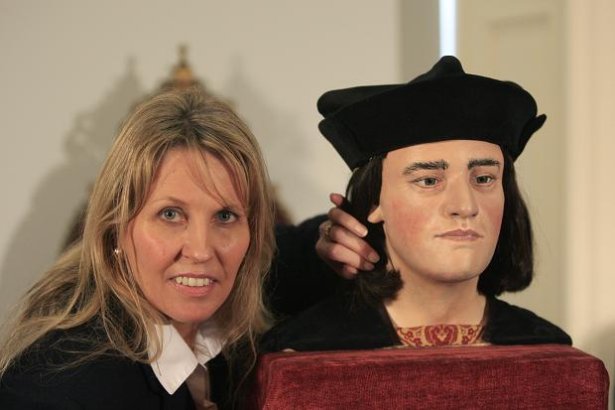
Philippa Langley

Dr. John Ashdown-Hill
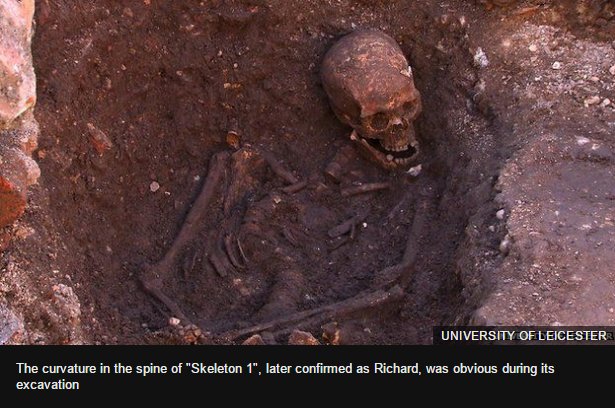
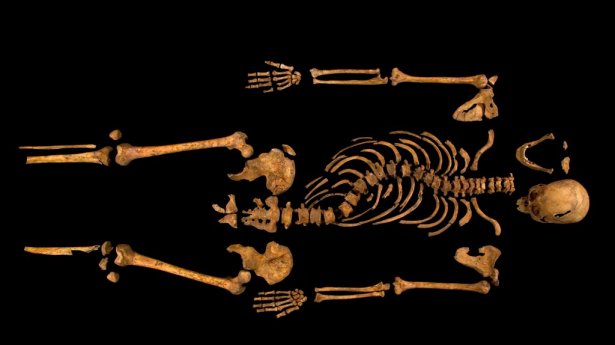
 |
| |
The
Battle Over Richard III’s
Bones…And His Reputation
By
Linda Rodriguez McRobbie
SMITHSONIAN.COM
FEBRUARY 8, 2013
Richard III may have died an unloved king,
humiliated in death, tossed naked into a tiny grave
and battered by history. But with two British cities
trying to claim the last Plantagenet king’s remains
500 years after his death, maybe his reputation is
finally turning a corner.
The discovery of his remains last fall (and the
confirmation of the results this week) was the
culmination of a four-year search instigated by
Phillipa Langley of the Richard III Society.
Both the search and the discovery were
unprecedented: “We don’t normally lose our kings,”
says Langley.
But it’s perhaps not too surprising that Richard’s
bones were misplaced. Richard gained and lost the
crown of England during the tumultuous Wars of the
Roses period (1455-1487). It is a notoriously
difficult period to keep straight: The country
lurched from civil war to civil war in a series of
wrestling matches between two branches of the
Plantagenet house, the Yorks and the Lancasters.
Richard was the Duke of Gloucester and a York; his
brother, Edward IV, had taken the throne from the
Lancastrian king, Henry VI. When Edward died in
1483, he left Richard in charge as regent to his
12-year-old son, to be Edward V. But in June 1483,
just before the boy’s intended coronation, Richard
snatched the crown off his nephew’s head by claiming
that the child was illegitimate. The boy and his
younger brother were both packed off to the Tower of
London—and were never seen again.
In the meantime, Richard III had his own usurpers to
deal with. The Lancasters were out of the picture,
but there was another upstart claimant on the scene,
Henry Tudor. Two years and two months after he was
anointed king, Richard faced a faction of Tudors at
the Battle of Bosworth on August 22, 1485. He lost
and was killed, only 32 years old. The Wars of the
Roses were over, the Plantagenet house was swept
aside, and the Tudors were on the throne. Richard’s
battered body was brought back to nearby Leicester,
where it was handed over to the Franciscan friars
and quickly dumped into a small grave at the
Greyfriars Church.
Given that they could barely keep a king on the
throne in all this, keeping track of him after he
was dead was probably even more difficult—especially
since the new regime didn’t want to keep track of
him. Henry Tudor, now Henry VII, feared that
Richard’s burial site would become a rallying point
for anti-Tudorists, so its location was kept quiet.
When Henry VIII created the Anglican Church in the
mid 16th-century, breaking off from the Vatican,
England’s missions were dissolved; the friary was
taken apart stone by stone and Richard’s grave was
lost with it. Rumors even spread that his bones were
dug up and thrown into a river.
Richard would have been forgotten, if not for
the Bard himself. William Shakespeare, who always
turned to history for a good plot, turned Richard
III into one of the most sinister villains ever in
his The Tragedy of Richard III.
It wasn’t hard: Richard III already had a bad
reputation, especially according to the Tudor
historians. His ignominious end and hurried burial
was thought fitting for a villain who allegedly
murdered his two young nephews to steal the crown;
killed his wife to marry his niece; had his own
brother drowned in a barrel of wine; and murdered
all and sundry who dared challenge him.
In Richard III, Shakespeare further embellished the
tale, doing nothing for Richard’s reputation. He
opens his play by having Richard III himself claim
that he was so ugly, dogs barked at him, and
declaring: “And therefore, since I cannot prove a
lover… I am determined to be a villain.”
Before
the first act is over, he has killed his brother and
Henry VI, and goes on to murder the two young
princes. Shakespeare also turned Richard’s
scoliosis-curved spine into a hunchback, furnishing
him with a limp that he might not have had and a
withered arm that he definitely didn’t have, just to
reinforce the point. Of course, Shakespeare’s
depiction of Richard III is about as historically
accurate as any period film Hollywood ever
produced—dramatized to a point just past
recognition.
Indeed, Richard III remains a controversial figure
to this day. Many say he was a victim of the
Henry Tudor propaganda machine. Henry’s own
claim to the throne was so tenuous that he spent his
reign in a state of permanent anxiety. Henry
believed the dissolution of Richard's reputation was
necessary. This explains the rise of the Ricardians,
history lovers who seek to rescue
the much-maligned king from Tudor
lies. Richard's defenders claim Tudor's
propaganda machine utilized the most brilliant and
malignant minds of the day in order to justify the
new regime by declaring Richard a usurper.
The
Richard III Society was founded in 1924
to “strip away the spin, the unfair innuendo, Tudor
artistic shaping and the lazy acquiescence of later
ages, and get at the truth”. According to this
organization, Richard didn’t kill his nephews, or
his brother or Henry VI, and he didn’t kill his
wife— that’s all the stuff that historians in the
pay of the Tudors wanted everyone to believe.
Moreover, according to the Society, wise Richard III
instituted a number of important legal reforms,
including the system of bail and, rather ironically,
the presumption of innocence before guilt; he was
also a great champion of the printing press.
So finding his bones, for the Richard III Society,
was in part about reclaiming the king's reputation
from history’s rubbish pile. Philippa Langley, armed
with “intuition” that his remains weren’t destroyed
and historical research, determined that what was
now a parking lot owned by the Leicester Council was
in fact the site of the lost church and grave. In
August 2012, digging began—with permission and help
from Leicester—and a cross-disciplinary team of
experts from the University of Leicester spent days
painstakingly excavating the area.
What they found, in just three weeks, was the body
of a man they believed to be Richard III. And on
February 4, the university confirmed that the
skeleton was indeed the last Plantagenet king. Not
only did he fit the physical description depicted in
historical sources—the famously curved spine, the
product of the onset of scoliosis at age 10; slim,
almost feminine—but his DNA matched that of two
descendants of the king as well.
Their findings also confirmed that Richard III was
killed rather gruesomely—he was felled by one of two
vicious blows to the head, including one from a
sword that nearly sliced the back of his skull off.
The team found 10 wounds to his body in total,
including a “humiliation” stab wound to his right
buttock and several to his trunk that were likely
inflicted after his death; there was also evidence
that his hands had been bound.
(Rick
Archer's Note: The article goes
on to discuss a pitched battle between the city
of Leicester and the city of York over who gets
custody of Richard's remains when they are
reburied. Incidentally, Leicester won the
struggle.
Richard's body was
re-interred at Leicester Cathedral on 22nd March
2015. Click
here if you wish to read more about the
dispute.)
It is
easy to dismiss the fight over his remains as two
cities wrestling over tourists. Leicester has
already debuted a hastily put-together exhibition on
the king and the discovery. But the debate has
tumbled into a minefield of regional
loyalties—though this is ancient history, it can
feel very current. As Professor Lin Foxhall, head of
University of Leicester’s archeology department,
notes, “You get these old guys here who are still
fighting the Wars of the Roses.”
The Richard III Society’s Phillipa Langley is
staying out of the debate about where Richard’s
remains should go—though she can understand why
Leicester and York both want him. “They’re not
fighting over the bones of a child killer—for them
he was an honorable man,” Langley says. “This guy
did so much for us that people don’t know about.
They’re actually fighting for someone who the real
man wants to be known, that’s why they want him.”
Others, however, are more skeptical about this
whitewashed version of Richard and about what impact
the discovery will have on his reputation.
“What
possible difference is the discovery and
identification of this skeleton going to make to
anything? … Hardly changes our view of Richard or
his reign, let alone anything else,” grumbled
Neville Morley, a University of Bristol classics
professor, on his blog.
“Bah, and humbug.” Peter Lay, editor for
History Today, wrote in an op-ed for
The Guardian on Monday declaring that the
claim that the discovery rewrites history is
overblown, and that the jury is still out on
Richard’s real character—at the very least, he
probably did kill the princes. And historian Mary
Beard prompted a fierce 140-character debate on
Twitter this week after she tweeted, “Great fun & a
mystery solved that we've found Richard 3. But does
it have any HISTORICAL significance?”
Langley, however, is still confident that this
discovery will have an impact. “I think there’s
going to be a major shift in how Richard is viewed,”
she says. “It’s very satisfying, it’s been a long
time coming.”
(Original
Story)
|
| |
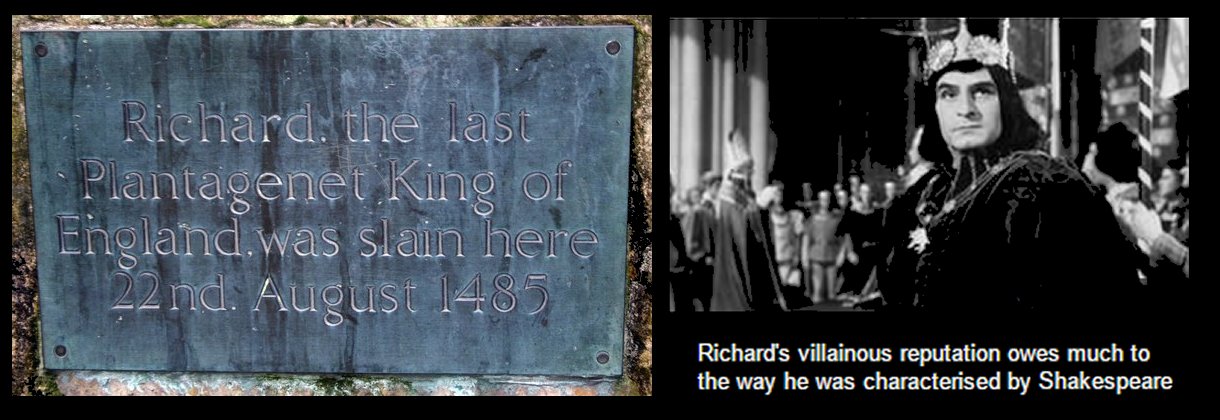 |
And Now We
Come to the End: The Fog of War
|
| |
Rick Archer's Note,
February 2017:
During
the Christmas break in 2016, I decided to devote one
week to get a general feel for the history of
England. I wrote a light-hearted story that
poked fun at the legend of Robin Hood and Richard
the Lionheart, the man I was said to be named for.
Then one
day while researching my Richard, I stumbled across
another Richard... yes, Richard III. I came
across the Smithsonian article I have reprinted
above. My hat goes off to Linda Rodriguez
McRobbie who wrote a very succinct summary of the
Richard III history, the controversy surrounding his
name, and the discovery of his bones.
The
moment I read this line... "Of
course, Shakespeare’s depiction of Richard III is
about as historically accurate as any period film
Hollywood ever produced—dramatized to a point just
past recognition"...
I was hooked. Ms. McRobbie could just as
easily been talking about Richard the Lionheart, a
fictionalized hero if there ever was one.
Could there just as easily be a fictionalized
villain named Richard as well?
My dear readers
might find this hard to believe, but I had never
heard of Richard III before. It is my
understanding that every English schoolboy and
schoolgirl find themselves immersed in the War of
Roses at some point, but my history lessons
concentrated more on the Alamo and the Battle of San
Jacinto. That is why I enjoy travel so much
because it gives me a chance to explore worlds I
never knew about before.
After
reading the Smithsonian article, my one-week
adventure turned into a two month journey through
the History of England.
And what
exactly have I learned?
One
thing I learned is the more I know, the less I know.
This was a humbling discovery to be sure. As
an example, at one point I was convinced that Lord
Stanley, the devious one, could very well have been
the one who murdered the Princes in the Tower.
I was
very curious why no one but me thought this way.
After all, I am brilliant, yes? (just
kidding). So I emailed Mr. Gareth Streeter,
one of the best writers I had come across.
On Tue, Feb 7, 2017 at 9:23 PM,
Rick Archer <rick@ssqq.com> wrote:
Mr. Streeter,
My name is Rick Archer here in Houston,
Texas, of all places. I will be visiting the
UK in June so I thought I would get a
head-start on the history.
I have been immersed in the War of the Roses
for two months. I find myself most
fixated on Lord Stanley.
I agree with you that Margaret Beaufort is
not likely to be a 'sinister child killer'.
But Lord Stanley seems just as cold-blooded
as Richard III.
I have yet to find a source that points the
finger at Lord Stanley, but I have a sneaky
feeling I am missing something. Surely
Stanley could find a henchman or pay a guard
to do the deed. However, since I am
unfamiliar with how tight the security was
in the Tower, maybe this idea is out of the
question.
Would you be willing to shed some light on
the matter? Why does Lord Stanley keep
getting overlooked? He would have much
to gain with a grateful stepson (Henry) on
the throne.
Mr.
Streeter was kind enough to reply.
From:
Royal History Geeks
Sent: Friday, February 10, 2017 6:11
AM
To: Rick Archer
Subject: Re: Did Lord Stanley murder
the Princes in the Tower?
Hi Rick,
Thanks for your email.
You're not alone in pointing the finger at
Lord Stanley. Historical fiction writers
such as Philippa Greggory have implicated
him, although as an accomplice to Margaret
Beaufort.
Have you read the Croyland Chronicle (c.
1486) and the account of Dominic Mancini
(the only contemporary account)?
Collectively these give us a fair bit of
info about how the Princes were drawn
further deeper into the tower and all but
Richard's closest and most trusted servants
were dismissed and denied access to them.
It is this that is at the heart of the
compelling - although circumstantial -
evidence that the poor lads could only have
been killed on Richard's orders or at the
very least, he would soon have found out
about it. To me, it seems strange that if
Stanley had done the deed, that Richard
would not have been able to trace it back to
him. Exposing the killer would have done
Richard a favour - he could make it clear
that the boys were dead but also that he was
blameless. Such a scenario would probably
have meant the Tudors never came to power.
I hope you enjoy your visit to the UK!
Gareth
Croyland Chronicle? Dominic
Mancini? Who are these guys?
This was
the moment I realized the more I know, the less I
know.
The game
of getting it right when it comes to History is a
lot more difficult than I realized.
Let me
share a funny story. Once upon a time, I was
watching a Houston Rockets basketball game with a
friend. During the game, a player who was
rarely used was put in at the end of the game.
He missed one shot after another and made several
mistakes. I severely criticized the athlete to my
friend. Too slow, can't shoot, can't play
defense! I was so sure of myself.
By
chance, a couple months later I found myself
guarding this man in a pickup basketball game at a
city gym. It was, as they say, a quirk of
fate. I was surprised to see the man wasn't
much taller or bigger than me. For a moment
there, I thought I could hang with this guy.
Nope.
This
gentleman went around me so fast I never even took a
step. He got to the rim and dunked the ball!!
Then he came back, slapped me on the butt and
smiled. Then he did it again. It was
almost like he 'knew' that I had disrespected
him. I would never criticize this man again
nor would I ever criticize another pro athlete for
the rest of my life. This man had taught me a
very valuable lesson... don't go shooting your mouth
off when you don't know what you are talking about.
With
that lesson in mind, I am well aware that various
comments I have made in my long saga may very well
be misinformed. I am hardly an expert, but I
do enjoy writing about history. Therefore, let
it be known my main purpose is not to convince
anyone I am right, but rather to amuse and inform.
Let me add one more thing - I have not made anything
up. I simply share what I read; you have my
word on that.
Now I
would like to discuss the Fog of War.
During the 1471 Battle of Barnet, fog... yes, fog as
in mist, murk, cloud, haze... played a huge part in
the outcome of the battle. However, more often
Fog of War represents 'confusion' during
battle.
Medieval battles were notorious for confusion
because visibility and communication were often
limited.
I
contend that there might be a third meaning for Fog
of War. During my research on the Battle of
Bosworth, I found several delightful
inconsistencies. Let me share them with you.
I think you will enjoy them.
Example One of the
Fog of War: The 'Over My Belly'
Contradiction.
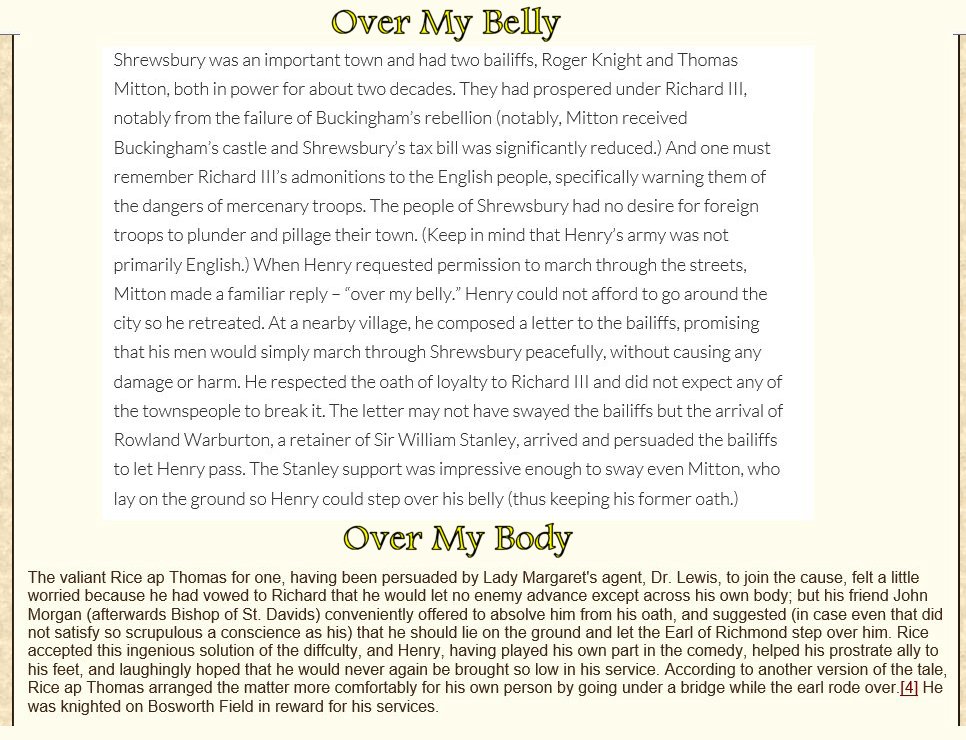
So,
which story do I believe? Which one is
correct? After flipping back and forth
between websites, I decided they very easily could
both be correct. Perhaps this was a phrase
that had common usage back in those days.
It is
pretty amazing all the phrases we have in our
language that we take for granted. And yet we
have so little understanding of where they come
from. The phrase 'Lose One's Head' has
come to mean 'not thinking straight' or 'lose
one's temper'. Obviously this phrase had a
somewhat different meaning during the War of the
Roses.
Back in
Nineties there was a well-known email that made the
rounds titled 'Life in the 1500s'. This
email explained the origin of many common phrases of
today. My favorite explanation was 'Raining
Cats and Dogs'.
We have all heard of thatch roofs, well, that's
all they were. Thick straw, piled high,
with no wood underneath. These roofs were
the only place for the little animals to get
warm. So all the pets; dogs, cats and
other small animals (mice, rats, bugs) lived in
the roof. When it rained it became
slippery so sometimes the animals would slip and
fall off the roof. Or they got so wet they
deserted the roof to find drier places.
Thus the saying, "it's raining cats and dogs."
Truth or
nonsense? Sounds plausible, but my bullshit
detector suggests someone very easily could be 'pulling
my leg'. Hmm, I wonder where that phrase
come from? If someone can answer that, I will
let them walk over my belly.
| |
The
Mysteries of the Battle of Bosworth
|
| |
Example Two of the
Fog of War: The Mysteries of the Battle of
Bosworth
My
problem with History is these darn historians keep
changing the storyline. For example, earlier I
explained how disappointed I was to learn that
Richard the Lionhearted, for whom I was named, was
one of the worst kings in English history.
That was a bit of a shock considering I had seen
movies and read books as a little boy that suggested
otherwise. I am still in therapy.
Moreover, that was not my only rude awakening.
There have been many. For example, Sam Houston
was the victor at the Battle of San Jacinto which
avenged the Alamo and gave Texas its independence
from Mexico. My hometown of Houston was named
for the guy. Sam's a big hero, right?
That is what I was taught in Eighth Grade Texas
History. So imagine my discomfort when yet
another childhood hero was knocked from his horse.
Guess
how I felt when I saw the 2004 'Alamo'
movie with Dennis Quaid portraying good old Sam as a
drunk and a coward? Rumor has it Houston spent
most of his time avoiding a fight because he was
badly out-numbered. Finally Houston's own men
had to bully him into fighting. Theoretically
the Texans won the battle because the Mexicans were
lulled to sleep by Houston's constant evasions.
Santa Ana himself was said be sound asleep when the
battle started thanks to a mulatto prostitute known
as the San Antone Rose who kept him up all night in
his tent. So kudos to Sam Houston for his
strategic evasions, but the real victory credit goes
to Ms. Rose.
About
two months into my research on the War of Roses, I
made a new friend... Ambion Hill.
Ambion Hill was my reference point for all the
stories about the military movements during
Richard's last battle at Bosworth. But I kept
getting confused by the different battle reports.
I could not figure out why the various stories
contradicted each other. Then I solved the
mystery.
Take a
look at these two maps and see if you can find any
discrepancies.

| |
|
On the surface, the two maps have much in
common. Both the White map and the
Green map show Henry's army advancing
northeast in some sort of curve from the
southwest. The Green Map places
Richard a bit more northerly, but there is
enough similarity to see the initial
skirmish had either an East-West or
Southwest by Northeast alignment. So
far, no problem. One can adjust.
However things get more curious when I add
the Color Key to the White Map. This
helps us understand what that
giant blue
blob
is up at the top
of the White Map.
Are you starting to catch on that something
is off here? The White Map has the
Stanleys in the North, the Green Map has the
Stanleys in the South.
|
 |
| |
But wait!!
I'm not finished yet!
"Debate has raged
for centuries over the exact location..."
No truer words have ever been spoken.
Here is a third map of the battle.
Ambion Hill is our one constant,
but the alignment of the four armies has
rotated yet again. Now Richard is in
the south.
One thing all three maps have in common is
that each map has William Stanley positioned
on the 50 yard line prepared to intercept
Richard's mad charge at the critical time.
So how much does this map confusion matter?
On the surface, probably not much.
Either way, Richard III is still dead.
Now I have question. Can you guess
which map is the correct one??
Obviously someone made a mistake. And
if one person can make a mistake, someone
else can make a mistake too. As it
turns out, this map confusion is masking a
much deeper problem.
Prepare to be amused!!
As it turns out, all three maps are
completely wrong. Not one of them is
even remotely correct. Not even close.
Let's find out why.
|
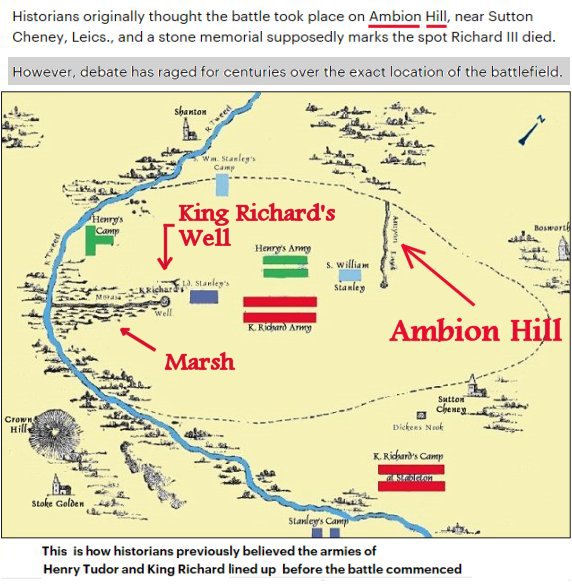 |
| |
|
Let us
begin by reading this Wikipedia description of the
Battle of Bosworth. I have highlighted the
important parts.
In their
interpretations of the vague mentions of the battle
in the old text,
historians placed areas near the
foot of Ambion Hill
as
likely
regions where the two armies clashed,
and thought up
possible scenarios of
the engagement. [98][99][100]
In their recreations of
the battle, Henry started by moving his army towards
Ambion Hill where Richard and his men stood. As
Henry's army advanced past the marsh at the
southwestern foot of the hill, Richard sent a
message to Stanley, threatening to execute his son,
Lord Strange, if Stanley did not join the attack on
Henry immediately. Stanley replied that he had other
sons. Incensed, Richard gave the order to behead
Strange but his officers temporised, saying that
battle was imminent, and it would be more convenient
to carry out the execution afterwards.[101] Henry
had also sent messengers to Stanley asking him to
declare his allegiance. The reply was evasive—the
Stanleys would "naturally" come, after Henry had
given orders to his army and arranged them for
battle. Henry had no choice but to confront
Richard's forces alone.[38]
Historical sources regarding the actual
battle at Bosworth are
scanty
at best. No
one who actually fought at the battle recorded
the battle;
typically, the chroniclers from London recorded
great events but
they were far from the action in 1485.
Also, the
supporters of Richard III did not want to remember
their defeat – and unlikely to write about in the charged political climate. Henry’s supporters were
concerned with more immediate matters after the
battle – namely, beginning the rule of a very
inexperienced monarch who had not been to England
in fifteen years.
Vague...
likely...
possible...
scanty...
No one recorded the battle...
far from the action in 1485
Do these
words inspire confidence? Not hardly.
Don't blame the well-meaning scholar who wrote this
article. He or she is basically saying:
"Sorry,
Wikipedia visitors, but I don't have a clue what
really happened. All I can do is depend on
a lot of hogwash passed down from 500 years ago
that was written by people who weren't even at
the battle site in the first place."
I think
we can safely assume there were no sportswriters in
the stands for this battle. There were no
photographs to rely on, no drawings, no post-game
interviews, no newspapers, no next-day talk shows,
no magazine follow-ups, nothing. Sure, rumors
were started, but how reliable were they? The
first serious account of the battle was not even
written until 18 years had passed!
This is
what I mean about the Fog of War... a
lot of details get lost or they get deliberately
altered. I also believe key details are made
up or embellished by someone's imagination to suit
their purposes.
(I
apologize in advance if my next comment offends
anyone, but what if the same thing is true for the
Bible? But that's another story.)
Wikipedia goes on to make the same point I do:
The multitude of different accounts, mostly
based on second- or third-hand information, has
proved an obstacle to historians as they try to
reconstruct the battle. Their common
complaint is that, except for its outcome, very
few details of the battle are found in the
chronicles. According to historian Michael
Hicks, the Battle of Bosworth is one of the
worst-recorded clashes of the Wars of the Roses.
The only
thing everyone seems to agree on is that there are
more theories than there are facts. In
his book about Richard III, Charles Ross said that "There
are almost as many different accounts of the battle
as there are historians".
What is
very interesting about the discovery of Richard's
remains over in Leicester is that someone got at
least some of the story right. The details of
the disposal of Richard's body were obviously
accurate enough to lead the archeologists straight
to Richard's grave.
That
said, although they got Richard's burial site
correct, they really blew it on another key fact.
This next one is a whopper, so make sure to have
your computer seat belt on.
| |
| |
The 500th
Anniversary of the Battle of Bosworth
|
| |
As a warm-up exercise up for our next story,
first I have a job for you.
Find Waldo!
Now I want you to identify the Word
next to Waldo.
Once you have the 'Word', try to
remember it.
Now
please proceed
further.
|
 |
| |
|
Back in the Seventies, someone noticed the
500th anniversary of the 1485 Battle of
Bosworth was just around the corner.
Bosworth has been described as
“one of England’s four great decisive
battles of the last 1,000 years,” by the
UK Battlefields Trust
(Hastings, Battle of Britain, and Naseby are
the others).
The chairman of the Battlefields Trust
spoke up, "We face public spending cuts
but these places are a potentially a huge
revenue earner. Normandy alone has 10
times more battlefield centres than there
are in the whole of the UK."
The Leicestershire County Council got the
hint. They thought it would be a good
idea for tourism and commemorative purposes
to build a vacation complex dedicated to the
history of this important event. Now
solidly behind this
plan, in 1973, they purchased a large,
expensive tract of land next to Ambion Hill,
the location of the Battle.
An expert was hired to
help create a museum. He would be
responsible for descriptions of the battle
that would accompany the exhibits at the
Battlefield Visitors Center. Murals,
models, sketches, sculptures and monuments
were authorized.
Large-scale
infrastructure projects were undertaken.
New roads were built, old roads were widened
and improved. A hotel was built.
Plans were made for a special train to bring
tourists over from Leicester, the nearest
city.
A bike trail was
built. A long walkway was built that
stretched all the way to Leicester 20
kilometers away (12 miles). A water
park was built. A forest park was
built. A zoo was built. An
antique center was built. A canal was
improved for boat rides.
It was a huge, very
expensive, very ambitious project that took
about ten years in the making. But
Leicestershire got it done.
It was now 1985.
Considering the buzz surrounding this
project, people whispered this could be
bigger than Stonehenge. The
entire country was poised to visit the area
for the celebration.
Large-scale
reenactments of the battle involving
costumes, horses, weapons and hundreds of
volunteers were scheduled. A large,
open-air stage was built for plays like
Shakespeare's Henry V,
Henry VI, and of course
Richard III.
This was going to be
such a big deal!! The entire town
would greet the visitors in medieval
costume. Battles! Jousting!
Archery contests! Executions! (well,
maybe a few fake ones).
But then something
weird happened. On August 8th, two
weeks before the big event, an article
written by a man named Colin Richmond
appeared in History Today.
Richmond's article
stated unequivocally that the Battle of
Bosworth did not take place where they said
it did.
As one might gather,
the article created a giant uproar.
The Guardian covered the
story. The London Times
covered the story. The entire country
was in a tizzy debating the story.
How was it possible to
get the wrong battlefield?
Think about the
members on the Council. How do you
suppose they felt? Ten years of
effort, millions of dollars of investments
to make this area the perfect place to visit
and now on the eve of this giant event, the
whole shebang could go up in smoke.
If this Richmond
bloke was right, the Battle could just
as easily have taken place in another
county!
5 miles away? 10 miles away?
20 miles? Blimey, they might
rename the Battle! If so, this
entire Bosworth Vacation Paradise is
down the drain.
This was intolerable.
This bad news threatened to devastate
attendance at the upcoming gala celebration.
A decision was made. Someone's head
needed to go on the block.
With visions of
canceled hotel rooms, someone suggested the
best way to guarantee full attendance would
be to have a genuine execution after all.
Plus they were mad enough to do it.
How about using Colin
Richmond? Gee, what a great idea!
|
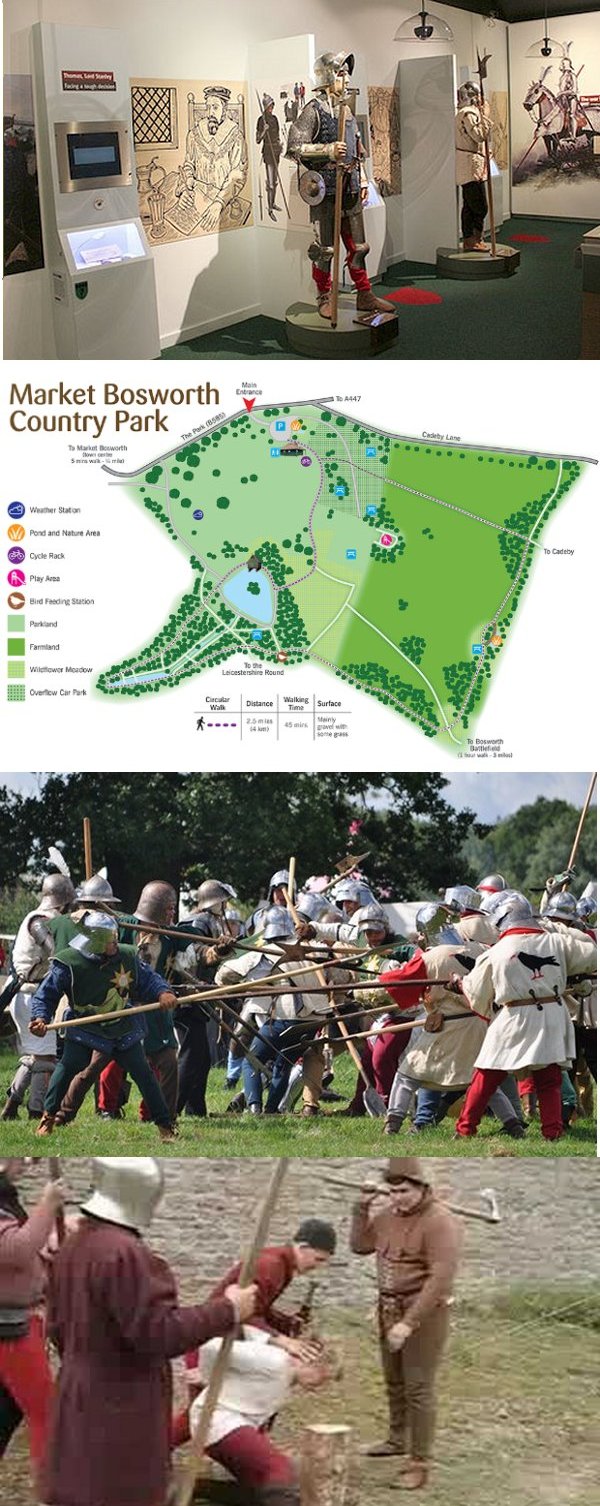 |
| |
The
Bosworth Battlefield Disappears!!
|
| |
Example Three of the
Fog of War:
The Startling Disappearance of
the Bosworth Battlefield
How absolutely embarrassing!!
Just about the time England was ready to
commemorate one of the four most important
battles in history, no one could figure out
where the damn battle actually took place.
This was all Dr. Richmond's fault. Off
with his head!
Fortunately for Dr. Richmond, at the last
minute they decided not to execute him after
all. Richmond got lucky when Princess
Diana agreed to come to the 500th
anniversary celebration. Much to the
relief of the organizers, Diana's superstar
presence guaranteed the crowds showed up
after all (incidentally, I hope everyone
knows I am teasing here).
But that did not mean this controversy was
going to be swept under the carpet.
Far from it.
Let's see if we can understand how five
centuries of English scholars managed to
misplace an entire battlefield.
Oddly enough, the town of Market Bosworth
had virtually nothing to do with the famous
battle. Instead, Ambion Hill (or 'Ambien
Hill' if you prefer) would play a
pivotal role in this mystery.
As one may have noticed, every description
of the Battle of Bosworth uses Ambion
Hill as a starting point. So
let's have a closer look at Ambion Hill.
Ambion Hill is located two miles south of
Market Bosworth. It is said to rise
all of 350 feet high. By comparison,
the massive Houston Astrodome in my home
town rises 218 feet. But don't get
excited... the land around it is about 300
feet high. In other words, the hill is
about 50 feet high.
|
 |
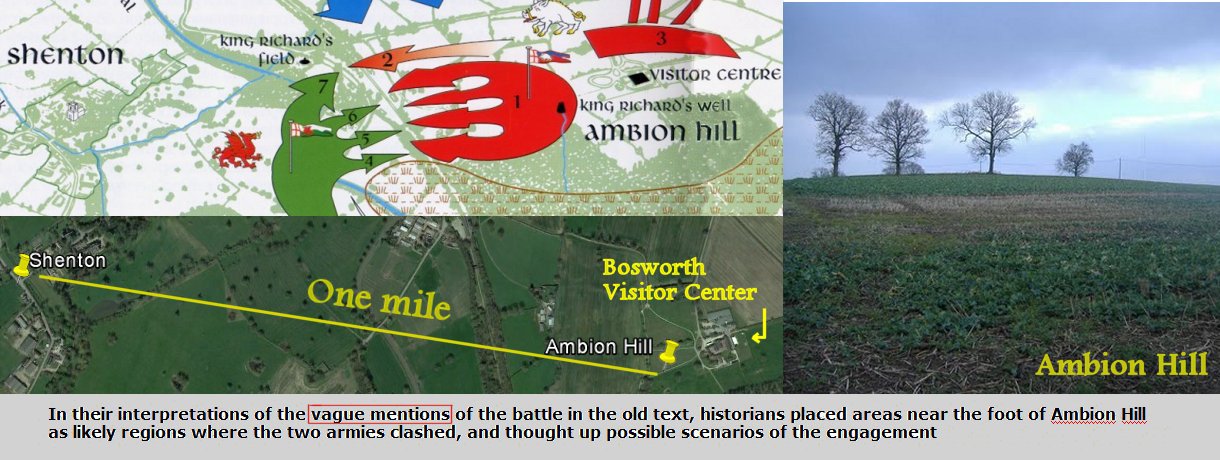
|
Notice
the phrase "VAGUE MENTIONS".
Ambion
Hill is not very high and not very remarkable.
In fact, I have a suggestion: ignore Ambion Hill.
Even
though countless battle descriptions and maps have
made a huge fuss over this hill, as it turns out,
not one drop of blood was spilled at Ambion Hill
during the Battle of Bosworth.
And why
was that?
Oh my
gosh, it turns out the battle took place somewhere
else!! How could this be??
Yes,
believe it or not, it turned out that Colin Richmond
was right. The historians had pegged the wrong
spot as the original battle site.
Ambion
Hill was a fraud, a pretender.
Poor
Ambion Hill.
Its
place in English history was illegitimate.
Join the
crowd.
|
 |
| |
|
So now I
have confirmed that the location of the battlefield
was lost. But don't get upset, this has
happened before. The best example is the
Trojan War. Many scholars assumed that both
Troy and the Trojan War were figments of Homer's
imagination to help write best-sellers, sort of like
modern day historical fiction writers who stretch
things a bit and use mythology to advance their
plots.
As it
turned out, the site of the Trojan War was located
in Western Turkey. It was by German
archeologist Henrich Schleimann in 1871 (story).
So much for all those smug, highly-educated scholars
who claimed the place didn't even exist.
As for
the Battle of Bosworth, some might say this mix-up
was even more embarrassing. They had invested
millions of dollars in the wrong spot. This
was supposed to be hallowed ground, not some
ordinary spot for some dog to do its business.
All those stone markers suddenly had lost their
meaning.
Considering the importance of Bosworth, this would
be akin to misplacing Gettysburg here in the States.
Or worse, losing the Alamo, the Texas answer to
Sparta's Thermopylae.
So what
went wrong?? Well, the Fog of War.
What else?
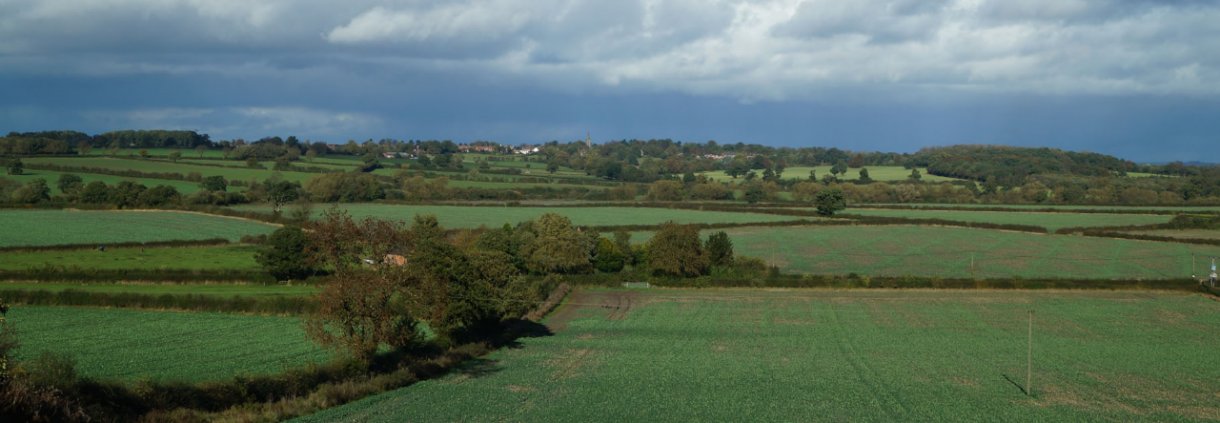
The main
culprit was the terrain. This part of England
is flat. Very flat. There are virtually
no landmarks of note. Forgive me if I am
wrong, but I think I read somewhere that there are
only two hills in the entire region. Surely I
am mistaken, but this picture of the area around
Ambion Hill suggests it could be true. The
landscape is so unremarkable it could be true.
Let's just say the absence of any distinguishing
topographical clues would help explain why the
battlefield began to disappear over time. Any
one of those fields in the picture could be the
battle site.
After
the battle, no one bothered to write anything down.
Why bother? After all, the people who lived
there knew where the battlefield was. Besides,
very few people in this rural area could read or
write. These were the medieval times when
illiteracy was rampant. Therefore, we can
assume that local reports were scarce. Five
years passed. Ten years passed. Fifteen
years passed. Three more years passed.
Finally in 1503, eighteen years after the battle, a
guy named Polydore Vergil was hired by Henry to
write the history of his reign.
Vergil
(c. 1470-1555) was an Italian humanist scholar,
historian, priest and diplomat who spent most of his
life in England. Vergil has been dubbed the "Father
of English History". The Richard III
Society has a different name for him... "Public
Enemy #1".
Just in
case my fellow Texans have not caught on yet, there
are many people over in England who love to argue
over anything to do with 'Richard the Third' or
'Henry Tudor'. They will argue over
Shakespeare's play. They will argue over just
how deformed Richard was (for the record, he
suffered from scoliosis). They will argue over
who killed the Princes in the Tower. They will
argue over where his recently discovered bones
should be re-interred.
Seriously, the animosity in England reminds me of
ancient Civil War tensions that rear their ugly head
here in America from time to time. If you ever
visit England, just be aware that any mention of
Vergil's so-called hatchet job on Richard still
raises everyone's blood pressure.
Vergil
was hired by Henry Tudor to write a favorable
account of his life. According to some, Vergil
had a clear understanding of who was writing his
paycheck. He is said to have slanted the facts
against Richard.
Indeed,
the Richard III Society really
dislikes Polydore. They are bitter because
there was no one to defend Richard's reputation, so
Vergil had a field day. The Richard III
Society not only accuses Vergil of
destroying documents that contradict any positive
point of view of Richard, the Society claims there
are numerous errors in Vergil’s account of the
reigns of Edward IV and Richard III.
To begin
with, they say Vergil is the guy who started those
mean rumors about Richard having a withered arm.
Even worse, Vergil was the first person to 'document'
the ugly rumors that Richard was responsible for the
murder of his nephews.
Vergil's
statements refer to Richard as spiteful, malicious,
fraudulent, graceless, wicked, mischievous, frantic
and mad. Virgil claimed Richard's villainy
caused his defeat at Bosworth because all his men
deserted him, forcing him to fight alone. Plus
he smelled bad (actually I made that one up).
|
| |
|
Vergil's
work gave Henry what he wanted – an account
depicting the crimes, faults and unpopularity that
defamed King Richard III for time immemorial.
With his so-called History of England,
the cards were stacked against the unfortunate
Richard III.
Indeed,
Shakespeare's Tragedy of Richard III,
the play that makes Richard a villain, is largely
based on Vergil's work.
However,
keep in mind that Vergil has his supporters too.
There are a lot of people who think Polydore Vergil
is wonderful. One doesn't get named the 'Father
of English History' without a considerable fan
club.
Personally speaking, I don't want to get in the
middle of this. All I care about is to find
out what happened to poor Ambion Hill.
Vergil
is the man credited with naming the fight the
Battle of Bosworth. Market Bosworth
is a tiny hamlet of 2,000 people located about 2
miles north of Ambion Hill.
Unfortunately Vergil never bothered to visit the
Bosworth location when he wrote his description.
That explains why his details of the physical
lay-out are few and far between.
As it
turns out, it is the 'marsh' mentioned
by Vergil and a 'hill' that set the
history detectives looking for some marsh-hill
combination south of Bosworth. Vergil didn't
give them much to go by, did he?
|
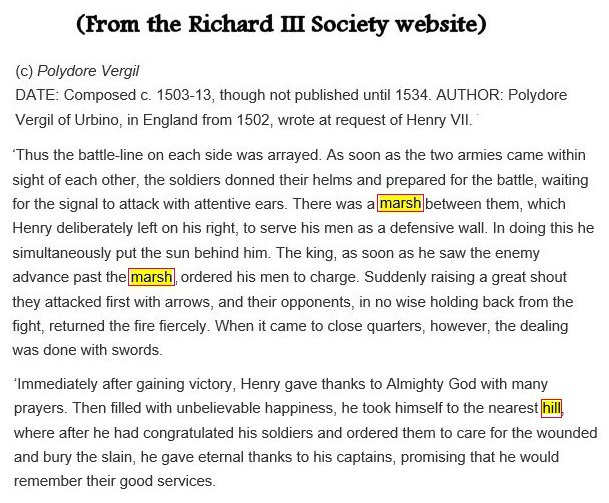 |
| |
Raphael Holinshed (1529–1580) was an English
chronicler. His work, commonly known as
Holinshed's Chronicles, became instrumental
in placing the battlefield's location.
Holinshed based his 1571 description of the Bosworth
Battle on Vergil's work. However, since
Holinshead lived only six miles from the battle
site, his writing gives hints that he may have
actually visited the site. Holinshead added
more details about both the marsh and the hill.
Holinshed
had two key phrases:
"Betweene both armies there was a great marsh
then (but at this present, by reason of diches
cast, it is growne to be firme ground."
What,
the marsh has disappeared? Uh oh. That
makes the 'hill' reference twice as
important.
"King Richard pitched his field on a hill
called Anne Beame, refreshed his soldiers and
took his rest."
Note
that if we break the word 'Beame' into two
syllables, we get 'Anne Be Ame', then say it
fast, it sounds like 'Ambion'.
|
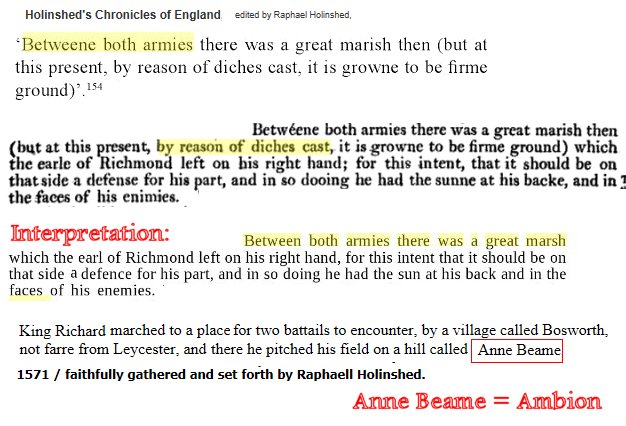 |
| |
|
Holinshead can therefore be credited with bringing
Ambion Hill into the picture. So what if there
was no marsh? After all, Holinshead said it
dried up. Voila! That would explain why
there was no marsh around Ambion Hill to any
Johnny-come-latelies.
This is
a modern picture of the town of Market Bosworth.
As one can see, the terrain south of the town is
remarkably flat.
In 1785,
an amateur historian named John Robinson became the
first to state that 'The Ambien' was 'the
supposed place of the engagement'.
Since
Ambion Hill was the main hill south of Market
Bosworth, no one objected too strenuously. As
if someone actually cared?
After
all, the Holinshead Chronicle had specifically
stated Richard camped on Ambion Hill. The
first big bump south of the town sounded like as
good a spot as any. Sure, why not?
William
Hutton (1723-1815) owned a profitable Birmingham
paper warehouse. His great fortune allowed him
time to write historical treatises AND get them
published widely.
Hutton’s
famous book "The Battle of Bosworth"
was published in 1788. Hutton was the man who
drew this map. Notice that Ambion Hill figures
prominently in the battlefield.
There
are those who suggest Hutton took these words too
seriously:
"King Richard pitched his field on a hill
called Anne Beame, refreshed his soldiers and
took his rest."
Hutton
may have been guilty of poor logic. Just
because Richard camped there did not
mean he also fought there.
Although
this book was widely criticized at the time, over
time Hutton’s work became the account upon which
most theories were based. For example, Hutton
claimed he placed the position of the famous marsh
on the northwest slope of Ambion Hill because he had
once personally trodden in it. Hutton placed
the marsh near the spring known as "King
Richard’s Well".
A return
visit in the following years failed to find any
trace of the marsh. Nevertheless, Hutton
continued to insist that what he had previously
found was "that marsh".
According to modern writer Paul Trevor Hale, Hutton
appears not to have known that the marshland in the
area had been reclaimed during the enclosure of
Dadlington and Stoke Golding in the 1580s.
Here is
the key point: Since no one really cared
enough to write a book of their own in protest, as
time passed, Hutton's book grew in importance as an
authoritative work. It became influential in
causing the hill to be accepted as the site of the
battle.
In the
absence of an alternative site, over time people
took it for granted that Ambion Hill was 'The
Place where Richard III died'.
|
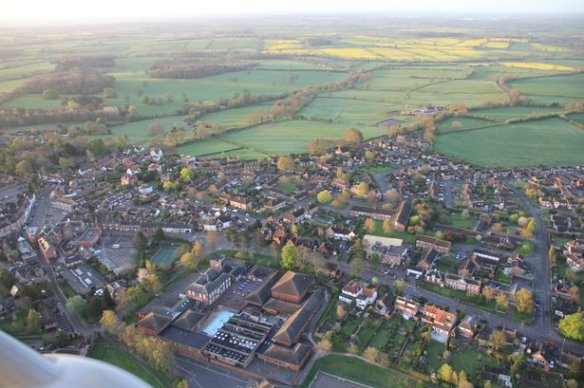
 |
| |
|
Rick Archer's Note: A gentleman by
the name of Paul Trevor Vale has written a detailed
account of how the Battlefield became the focus of
great controversy here in modern times. The
following information is excerpted from his
excellent article. I highly recommend that
anyone interested in this story read Mr. Vale's
complete account.
The
Continuing Battle of Bosworth Field
Written by Paul Trevor Vale
Original Story
In 1973, the
Leicestershire County Council purchased the
piece of land known as Ambien Farm, located on
and around Ambien Hill, near the village of
Sutton Cheney. The Council began to develop a
Bosworth Field Battlefield Centre. The Council
hired a historian to work out the battle
positions and tactics of the various
participants. Heraldic standards were
being made to mark the positions of the armies
on the morning of that fateful day: August 22,
1485.
Regarding the Differing Views of Dr. Daniel
Williams and Dr. Colin Richmond
Shortly after the project was underway, the
original historian withdrew, for reasons never
stated. He was
replaced by Dr. Daniel
Williams, lecturer in history at Leicester
University. Walkways were laid out around Ambien
Hill; the old farmhouse was converted into an
exhibition hall, book shop and snack bar; and a
car park was provided. Dr. Williams published a
24-page booklet giving his analysis. The Council
set out the flags and maps to match Dr.
Williams’ theories, and opened the Battlefield
Centre to the public.
Since 1973, many have expressed doubts about the
validity of the site. To mark the 500th
anniversary of the battle, Dr. Colin Richmond
published an article in the August 1985 edition
of History Today.
Dr. Richmond
claimed that Dr. Williams was wrong, and that
the battle was actually fought elsewhere.
Dr. Richmond’s
account was controversial enough to make the
front pages of both The Times and the Guardian
newspapers on July 27, 1985. What had previously
been private academic discussions became heated
public debate.
Richmond’s argument was that the battle was not
fought to the west of Ambien Hill, and that
William Stanley did not intervene decisively
from a position to the north. Williams placed
both Stanleys to the north, illogical from any
aspect. Richmond held the exact opposite: that
William Stanley came up from a southwesterly
direction to swing the day in Henry’s favour;
and that the main battle took place on the plain
to the south of Ambien Hill, between the Hill
and the village of Dadlington. He also advanced
the theory that Northumberland, one of Richard
III’s chief commanders, was a traitor. Richmond
seemed to think this would come as no surprise
to students of the battle. However, the revised
positioning of the battle site may prove
Richmond’s work to be a statement that tradition
does Northumberland an injustice. Unfortunately,
Richmond apparently tried to be controversial.
He made comments such as: "The manner of
[Richard’s] death may account for the sympathy
he otherwise unaccountably evokes" [emphasis
added]. This naturally angered pro-Ricardian
scholars; many of them attacked the article as a
whole, thereby discarding some interesting and
salient points.
Naturally, Dr.
Williams led the attack by defending his own
position. He wrote to The London Times
that "Dr. Richmond makes it clear that he
does not like the Battlefield Centre, but his
comment and observations seem to be carrying
pique a little too far."
In closing, Dr. Williams
stated that "There is a good deal more to be
said, but what is here supports my feeling that
the Silly Season has started somewhat early."
What makes Dr. Williams think he is right? Some
of his theories are dubious, to say the least.
Quoting the Croyland Chronicle, which states
that King Richard’s army ‘was encamped at the
Abbey of Mirival at a distance of about 8 miles
from that town (Leicester),’ Dr. Williams
concludes that, "Allowing for approximations
this would place Richard’s Camp at about 9 miles
from Leicester and about 5 miles from Merevale
Abbey, which is at almost exactly the position
of Ambien Hill". These estimated figures are
highly convenient if one’s goal is to place the
site on Ambien Hill. However, at a lecture given
on August 31, 1985, Williams stated that Ambien
is 6 miles from Merevale and 10 miles from
Leicester. Regarding the campsite of Henry
Tudor, self styled Earl of Richmond, Williams
said: "Henry and his Army arrived at the final
resting place before the Battle, their camp at
Whitemoores. The camp itself…must have been…to
the west of the intersection of Watling Street
and the road to Shenton". According to his
notes, the source for this assumption is a
"local but ancient tradition". Is this the same
tradition which had the inhabitants of Stoke
Golding watching the battle from their church
tower, that Williams dismissed in The Times
article? With Dr. Williams, it would seem that
even before dawn on the day of the battle,
August 22, 1485, we are back in the realm of
"common faith hath it..."!
It is worthwhile reiterating why Dr. Williams
wrote his account, and asking some questions.
Williams was hired to write about a battle that
took place on and around Ambien Hill: the land
now owned by the Leicester County Council.
Did the original historian withdraw
because he could not make the evidence and facts
fit this site?
Does Dr. Williams defend his theories so
often, and so vehemently, because of the vested
interest now involved in the site?
The August 11, 1985 Sunday Telegraph
called it "The Big Business of Bosworth".
Defending Colin
Richmond’s views, the Reverend Anthony Bardesley,
Vicar of Stoke Golding and Dadlington, stated
that the farmers of Dadlington were the first to
be approached by the Council with a view to
buying their land for a battlefield centre, but
they had refused to sell. Odd behaviour for a
council that "knew" the battle took place across
the valley on Ambien Hill.
(Rick
Archer's Note: I have enclosed only
one-third of Mr. Vale's original article. He
goes on to make many more valid points why the
location of Ambion Hill was absurd. Again, I
encourage the readers to visit his
web page.
For our
purposes, Mr. Vale has explained how the modern
battle lines formed. It seems that for
the purposes of tourism and heritage, with the 500th
anniversary looming, the time had come to
commemorate the famous battle. Apparently due to the
Fog of War, the idea that Ambion Hill was the
location of the battle had more or less become
accepted as fact.
So the
Leicestershire Council bought an expensive tract of
land around Ambion Hill and set about building a
Visitor's Center complete with stories and drawings
of the battle. They hired Dr. Daniel Williams
from the University of Leicester to document the
battle for their exhibits. Somewhere along the
way, Dr. Williams also became curator of the museum.
Dr.
Williams passed away in 1998. Now I have no
idea what sort of man Dr. Williams was, but even if
he was as grouchy as he was portrayed to be, I still
feel sorry for him. His obituary says he was a
popular professor at the University of Leicester.
His passion was research on the later Middle Ages.
Clearly the proximity of Leicester to the area where
the famous battle was fought help spur his
commitment to the history of the locality, and
especially its associations with Richard III.
Dr. Williams was the historical adviser who worked
with Leicestershire County Council's team to locate
and develop as a tourist attraction the site of the
Battle of Bosworth. His account of the battle site
has been reprinted many times since its publication
in 1973. A new, fuller edition was published in
1996, with a characteristically lively text and
illustrations drawn from contemporary and later
sources.
However,
Williams' obituary made no mention of what had to be
bitter heartache for the man to have his work
constantly questioned. No doubt much of his
identity and reputation was wrapped up in the
validity of his work. It must have hurt him
deeply to discover the same people who had hired him
in the first place - the Leicestershire Council -
had begun making discrete inquiries about buying
land further to the south near Dadlington... "Odd
behaviour for a council that 'knew'
the battle took place across the valley on Ambien
Hill."
|
| |
Re-Discovery
of the Battle Site
|
As we
learned from Paul Vale, Leicestershire County
Council set up the battlefield visitor centre at
what was Ambion Hill Farm, in 1974. The
Council depended on the work of Leicester University
historian Daniel Williams to establish the location
and to interpret the battle for its murals inside
the Visitor Center.
This is
a photograph from the Bosworth Visitor Center.
It appears to be a large scale model of the
battlefield. Notice the men charging
downwards... no doubt charging down from Ambion
Hill!! Very ironic.
After
the Council had gone to considerable cost and
trouble to establish this state of the art tourist
destination, the critics had a field day.
Indeed, throughout the Seventies, local
historians challenged the Ambion Hill location for
the battle, but to no avail.
Then
came 1985. On the eve of the 500th
anniversary, historian Colin Richmond dropped his
bombshell. He had uncovered a document which
said the battle had taken place at Dadlington Field.
Richmond’s article threw a real damper over the
celebrations. Talk about a party pooper!! For
the first time in 500 years, people began to notice
that Dadlington possessed the only other hill
besides Ambion in the entire county. Uh oh.
|
 |
| |
|
The
supporters of the traditional site at Ambion Hill
would not go down without a fight. Two months
later after Colin Richmond's 1985 article appeared,
Daniel Williams, curator of the battlefield center,
dismissed Richmond’s claims vehemently.
For one
thing, where was the marsh?? Dadlington was
dry as a bone. If the glove don't fit, you
gotta acquit. If the marsh ain't there, won't
be no Renaissance Faire.
However,
now that the cat was out of the bag, people were
very worried that Colin Richmond was right.
Indeed, as debate grew heated, Ambion Hill was being
compared to Stoke Golding's Crown Hill. Was it
possible they had the wrong hill all along?
One
thing that bothered people was the conspicuous
absence of artifacts at the base of Ambion Hill.
Why can't we find an arrowhead, a spear tip or a
cannon ball or two??
Of
course there weren't any artifacts at Crown Hill
either, but they did have bones. It seems
there was a burial site for victims of the Bosworth
Battle next to Crown Hill.
This
fact was very upsetting. As we know, typically
bodies are buried next to the battle site. For
example, there are 10,000 graves located 300 yards
from Omaha Beach, site of the bloodiest D-Day
battle. If everyone died at Ambion Hill, then
why cart the bodies two miles away to Crown Hill?
Wouldn't it be easier just to bury them in soft soil
of the alleged marsh that was said to exist next to
Ambion Hill?
Five
years after Colin Richmond had opened the debate, in
1990, Peter Foss published a book that presented
powerful arguments in favor of the Dadlington area.
People were particularly impressed with his maps.
Mr. Foss had drawn several superior maps of the
battlefield to support his new theories of the
location. His book was so persuasive that
public opinion now swung heavily in favor of
Dadlington.
|
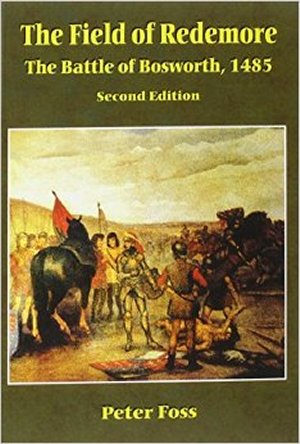 |
| |
|
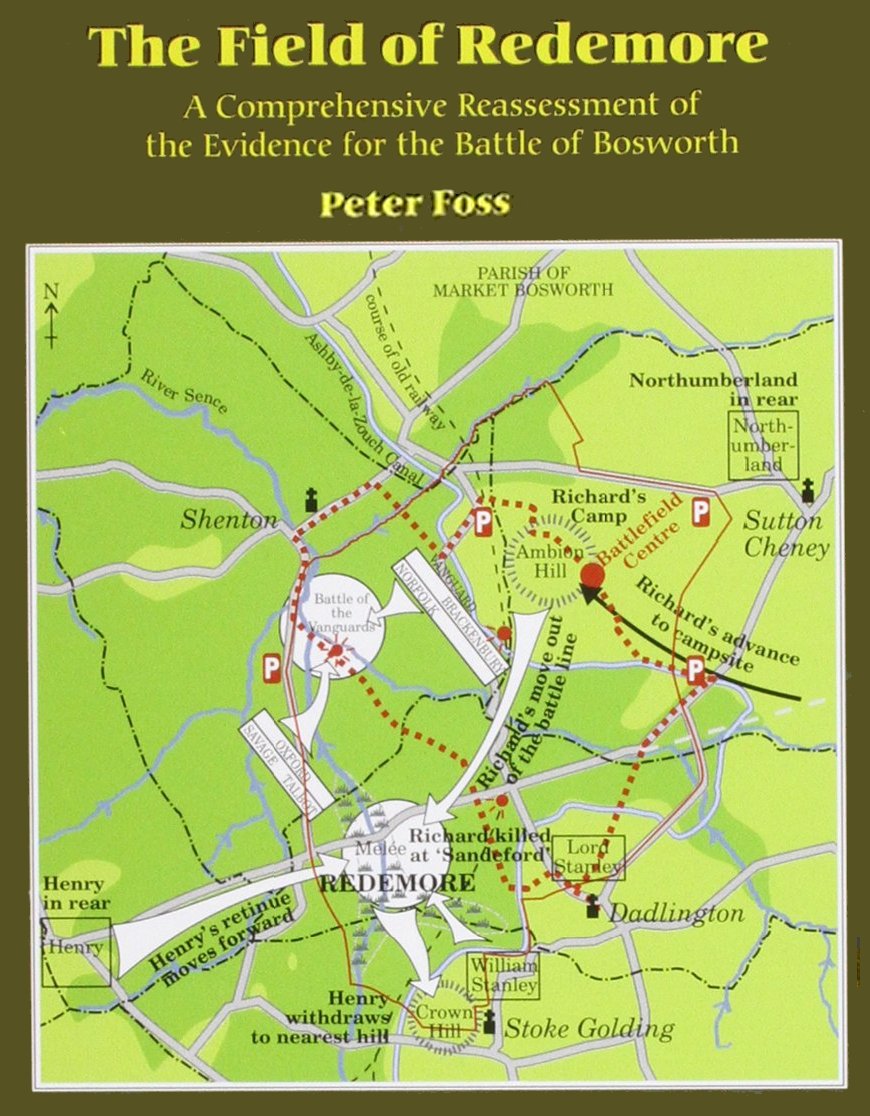 |
| |
|
According to
Peter Foss, the Ambion
Hill theory was a piece of 18th-century nonsense
proposed by a Birmingham paper manufacturer and
amateur antiquary, William Hutton.
“He was no good as an
antiquary, a dilettante really,”
said Foss.
But Hutton was widely
believed, even though his idea contradicted both
near-contemporary accounts and simple logic.
After all, it hardly seems likely that Henry
would have gained the crown by charging uphill.
Nevertheless, the people in
charge of constructing the Bosworth memorial seeming
bought his story as well.
|
| |
|
Foss
discovered in local records that ‘Redmor’
lay ‘in the fields of Dadlington’, a key factor
that reinforced Richmond’s argument.
Peter
Foss was not satisfied with discrediting Ambion
Hill, but was determined to locate the exact site.
Foss combined his expert knowledge of local
topography, geology plus a close reading of the
original sources to write The Field of
Redemore.
This
book, first published in 1990, was very influential
in swinging the tide in favor of several farms in
the vicinity of Dadlington as the more likely
location of the battle. Even though the exact
spot had yet to be pinpointed, in 1995 the English
Heritage was convinced enough to include the fields
around Dadlington in its Register of Historic
Battlefields.
Unfortunately, there were still some die-hards on
the Council who refused to accept the theory.
Their continuing stubborn attitude resulted in many
heated debates. Consequently, over
the
next decade, pressure mounted to begin a full-scale
investigation.
Finally
the Council threw in the towel. They
commissioned an expensive,
large scale
project to find the true location of the
battlefield. In 2004, a landscape archeologist
named Glenn Foard was hired to solve the mystery.
|
 |
| |
The Battlefield Trust Project
|
Silver badge and lead
shot pinpoint site of Battle of Bosworth
Written by
Maev Kennedy
The Guardian
Friday, 19 February 2010
A thumbnail-sized silver
gilt boar, still snarling ferociously after 500
years, and a little heap of battered lead balls have
pinpointed the much disputed site of the Battle of
Bosworth, and even the spot where Richard III was
cut down by Tudor swords, becoming the last English
king to die in battle.
Archaeologists made the
announcement today close to the site where Henry
Tudor was crowned Henry VII with the crown that had
tumbled from the dying Richard's head. The
archaeologists believe the boar badge, his personal
emblem, was worn by someone who died at his side.
The crucial evidence,
including badges of supporters of both kings, sword
mounts, coins, and 28 lumps of roundshot, turned up
in fields straddling Fen Lane in the Leicestershire
parish of Upton. No historian had previously
investigated the location, which is nearly two miles
south-west of what had traditionally been regarded
as the centre of the battle.
"It took us five years to locate it, but there it
is, the Battle of Bosworth," said Glenn Foard, an
expert on battlefield archaeology, who led the hunt.
A major
find was the silver boar
badge, the emblem of King Richard III.
It was found on the edge of a field called
Fen Hole.
Dr.
Foard: "The most important
find by far is the
silver-gilt boar, which was Richard III’s own badge,
given in large numbers to his supporters.
But this
one is special, because it is silver-gilt. It was
almost certainly worn by a knight in King Richard’s
own retinue who rode with the King to his death in
his last desperate cavalry charge. It was found
right next to the site of Fen
Hole - a small medieval marsh -
and the King was killed when his horse became stuck
in a mire."
In medieval times,
Fen Hole was a marsh that played a crucial role in
the battle by protecting the flank of Henry Tudor's
much smaller army. Finding
this marsh proved pivotal in discovering the actual
location of the battlefield.
Farmer Alf Oliver was
astonished at the revelation, outside all the
parishes which have vied for centuries to claim the
honour, in his fields straddling Fenn Lane.
The lane was once a Roman road linking Leicester and
Atherstone, the towns from which Richard and Henry
approached the battle.
One of the crucial finds,
the largest of the roundshot nicknamed
'the holy grapefruit' by the archaeologists, was found just
behind one of Oliver's barns. The
shot not only maps the arc of the battle, it proves
that artillery was used by both sides in greater
numbers than previously thought.
Frank Baldwin, chairman of the
Battlefields Trust charity,
was beyond elated to see the
project come to fruition.
"The discovery
of the actual site of the battle
is just as important
to us as Heinrich
Schliemann discovering Troy."
|
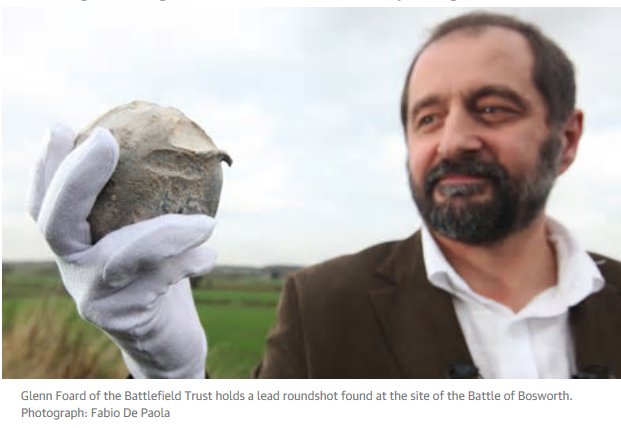

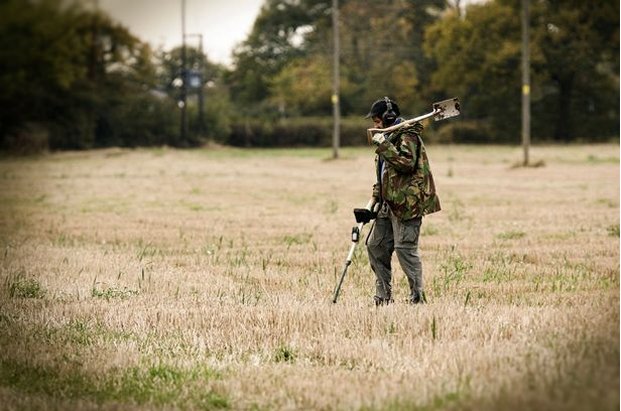 |
Give
credit to Colin Richmond for rocking the boat back
in 1985. Without
Richmond’s
earth-shattering History Today
article, it seems unlikely that this battlefield
would have never been found. Even then, it had
taken 25 more years to finally solve the mystery.
Give
further credit to Peter Foss, who participated in
the painstaking work with keen interest. It
was his
genius that had created the attitude shift necessary
to lead to this survey.
“I
never doubted my original theory about where the
correct site is. I have a great knowledge
of the area and it all made sense.
When I carried out my research they had none of
the technology they have today but my work was
very, very sound and I am delighted if it is now
recognized as being right.”
In 2004
that the Heritage Lottery Fund, the
Battlefields
Trust and Leicester County Council together secured
funding for an archaeological project led by
Glenn Foard to locate the battlefield site.
The
survey proved to be very expensive. At a cost
of 1.3 million pounds (1.6 million dollars), metal
detectors were employed, topographical surveys were
made and sophisticated soil analysis was conducted.
Even
then, it took four years to get results. No
doubt the slow progress caused much hand-wringing
and worry.
Starting
in 2005, teams of men armed with metal detectors
fanned out systematically across
farm fields. Part of the problem was that the
battlefield turned out to be further west than
originally predicted by Peter Ross.
The
initial breakthrough came on March
1st, 2009. That is when a small lead ball, 30mm in diameter, was
discovered further west of Dadlington. Once
the first ball was found, it unlocked a treasure
trove nearby.
By December
2010, 33 lead projectiles had been uncovered, a
greater number than from all other archaeological
surveys on battlefields of the 15th century
combined. What an amazing find this had been.
|
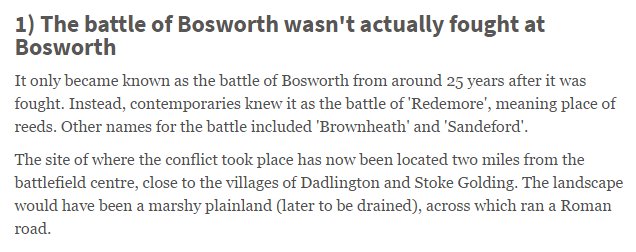
 |
| |
 |
| |
Dr. Glenn
Foard's Story of the Search
|
| |
|
The
discovery took a lot longer than Dr. Foard could
have ever imagined. It had taken four long,
frustrating years to locate the correct spot.
Part of the problem was that winter and rainy season
limited the search to little over half of each year.
Dr.
Foard understood that without the convincing work of
Peter Foss, this survey would never have been
undertaken in the first place. As one writer
had put it, "The decision to hire Glenn Foard to
conduct the search
appears to vindicate the
theories of local historian Peter Foss, who has been
arguing the case since the 1980s – although not
everyone in this rather bitchy subculture wishes to
admit it."
Mr. Foss
had every right to be pleased. The decision to
finally undertake a scientific survey of the area -
an extremely costly undertaking - indicated that
public opinion had swung heavily in favor. He
believed that the Dadlington area, not Ambion Hill,
was where the battle took place. Now all they
had to do was find the darn thing.
Unfortunately, in a perverse twist, Mr. Foss had
done his work too well. Unbeknownst to him (or
anyone else), his prediction was off by about a
mile. Around Dadlington, there was one spot
after another with ancient names such as 'Redemore'
(place of the reeds) and 'Fennagh'
that hinted the marsh - long since dried up - might
have been located nearby. These marsh-related
names practically begged the researchers to have a
look.
The team
led by Dr. Glenn Foard was understandably drawn to
these fields around Dadlington, but they were to be
disappointed time and time again.
This
search turned out to be a major community effort.
On a sunny day, there might be several teams of
volunteers - college students, retirees, civic
clubs, church groups - scouring giant fields
centimeter by centimeter for hours on end.
However, they never found anything!!
Frustrated, sometimes another team did the same
area. These Google Earth images barely begin
to convey the vast amount of territory the search
teams had to cover inch by inch. This
was a needle in a haystack job.
In his
book, A Battlefield Rediscovered, Dr.
Foard explained the Foss hypothesis was
all-powerful. Assuming that the dried-up marsh
areas near Dadlington were certain to offer the
answer, the ground was turned upside down, but to no
avail.
Stage One
"Throughout the investigation of the case
presented by Peter Foss, the idea that the
battle had been fought in Dadlington township
appeared so strong that it distorted
perceptions, particularly of the data for the
distribution of wetland.
As a result, our search for peat deposits and
battlefield archeology had been extended widely
across Dadlington, even to the eastern side of
the town, which lay far away from the
concentration of places that had 'fen names'.
When we found Fen Meadow closer to
Dadlington, we really thought we'd nailed it.
However soil surveys showed that the marsh had
dried up in Roman times. We were heartsick
at the time.
Stage
Two
Yet, as we cast the net ever wider, new
options began to appear. The discovery of
the peat deposit at Fen Hole in 2007
lifted our hopes and shifted attention westward.
The evidence for wetland, heath, and moor was
reviewed and the possibility that the
battlefield lay beyond the western edge of
Dadlington was considered."
Glenn Foard
For a
variety of reasons, the westward search stopped at
the eastern side of Lychgate Fish Farm, a lake in
the lowlands. That had been their agreed-upon
cut-off point for the moment. Little did they
know that the battlefield site lay just beyond!
Frustrated that the wider search net had not panned
out, Foard's team returned to the Foss hypothesis.
They decided to ask for a second opinion on the
Fen Meadow possibility. Still, an
important idea had been sown in the back of Dr.
Foard's mind. It might still be Fen Hole...
the back side was unexplored.
In the summer of 2008, I stood on Crown Hill
with my colleague Richard Holmes. We had
spent the day touring the various locations that
had already been investigated.
Looking across the low-lying ground to the north
and west which had provided the focus for our
tour today, Richard asked a simple but
perceptive question.
"Glenn, if you forget all the caveats, what is
your gut feeling as to where the battlefield
lies?"
My mind flashed directly to an earlier thought.
It must lie west of Fen Hole somewhere
near the Roman Road.
Stage Three
Winter came and we had to stop. In the
following year, 2009, we received confirmation
that the wetland in Fen Meadow had been
gone long before the 15th century. It had
likely been drained by Roman ditches long before
the battle took place. Dead end!!
After three years of extensive work testing the
Foss hypothesis, the lack of convincing battle
archeology forced us to finally reject the Foss
interpretation.
This allowed Fen Hole to supplant Fen
Meadow as the likely candidate for 'The Marsh'.
So we moved further west.
That is when we hit pay dirt in 2009.
Glenn Foard
The
discovery, when it eventually came, was a bit
surreal because the successful team was surrounded
by other search parties studying four wrong
locations. This odd sight was further
testimony to the painful needle in a haystack
approach necessary to locate the wandering
battlefield.
The new
battle site belonged to farmer Alf Oliver
at Fenn Lane Farm. Mr. Oliver had never
imagined his farm was 'The One'. All
the best guesses lay well
beyond his farm. So when the researchers came
calling, he had assumed they were wasting their
time. Mr. Oliver admitted he was
astonished at the artifact
discoveries in his fields straddling Fen Lane.
After
four years of rotten luck, Dr. Foard said it was
about time they got lucky. They barely missed
adding another year!
“For more than a year we had hints we were close
to the action but it was only in the last week
of planned field work, in the last possible
area, that the critical evidence was found.”
As
improbable as this long search had been, there was a
silver lining - the battlefield was perfectly
preserved. Due to the hidden location, no
looting had ever taken place. Now the
archaeologists had a field day (small joke)
exploring what had to feel to them like a veritable
gold mine.
The
items discovered so far include artillery shot,
handgun shot and fragments of swords, bridle
fittings, spurs... plus three coins almost certainly
lost by combatants during the battle.
As we
know, it was the silver boar of Richard III that
provided the definitive clue that this farm was the
correct location. The boar was very small,
no bigger than a
thumbnail. It was muddy and
battered, but still
snarling in rage after 500 years.
The tiny
1.5-inch boar was found by Carl Dawson, a retired
university lecturer and one of the many volunteers
who helped scan hundreds of miles in the area with
metal detectors.
Dawson
had found the boar
on the edge of a field called Fen Hole.
In other words, Carl Dawson
had not just found an invaluable artifact, he had
discovered the all-important marsh which in
medieval times played a crucial role in the battle,
protecting the flank of Henry Tudor's much smaller
army.
Although
this
marsh was drained centuries ago,
Alf Oliver said it still gets boggy
in that spot during the
very wet summers.
One can
imagine that somewhere in that ABCDEF complex is the
spot where King Richard met his death.
Another
one of the crucial finds, a large cannonball
nicknamed 'the holy grapefruit', was found
behind one of Oliver’s barns.
It turns out that the road to Alf Oliver's farms has
an interesting name. It is known as 'Fenn
Lane'.
This road
goes way back to antiquity. Fenn
Lane was
the Roman road linking
Leicester and Atherstone.
Leicester and Atherstone
were the towns from which Richard and Henry
approached the eventual
battle site.
The only
roads back in those days were Roman roads... and
there weren't very many of them. Considering
all the various marshes providing major obstacles to
wagons and artillery, the armies would not cross the
fields for fear of 'bogging down' into the
muddy areas. Therefore common sense dictates
that both armies came straight down this road for
the big bash.
In other
words, there was considerable irony in the discovery
that this farm straddled the Roman road. Why
didn't anyone think of researching this long road
first?
Furthermore, if researchers were looking for a 'Marsh',
wouldn't logic suggest starting with sites along a
road named 'Marsh Road'? Unfortunately,
there were no roads named 'Marsh Road'.
But there was a Fenn Lane. And
there was a Fen Hole.
Do you
know what a 'Fen' is??
Fen: a low and marshy or
frequently flooded area of land. "a
flooded fen"
synonyms: marsh, marshland, salt marsh, fenland,
wetland, bog, peat bog, swamp, swampland
• flat low-lying areas of eastern England,
formerly marshland but largely drained for
agriculture since the 17th century.
In hindsight, this road was a perfectly logical
place for the armies to meet. They discovered
the battle took place on Fen (Marsh)
Lane, the ONLY major road of the day right where it
crossed Fen (Marsh) Hole.
Of
course there were a million extenuating factors that
I have no knowledge of. Nevertheless, one can
imagine, this was a giant 'Duh, why didn't I
think of that?' moment for the frustrated
searchers.
At some
point, the history books will have to be rewritten.
Given this new knowledge, it becomes clear as day
what took place in 1485. Henry camped at
Atherstone on the night prior to the battle.
That is when Henry had his audience with the
non-committal Lord Stanley. The next morning,
Henry marched five miles down the road.
Richard came off of Ambion Hill and marched two
miles down to the road to meet Henry. They
lined up their cannons and their men, then started
the battle.
According to the
proclamation which the new King Henry VII issued
after the battle, Richard was killed at “Sandeford
in the county of Leicester”.
However,
it has never
been clear where Sandeford was, although chroniclers
describe features such as a marsh that lay between
the two armies.
The coup de grâce was the unearthing of
that
small silver gilt badge of a boar. This had
been Richard III’s
insignia.
Perhaps
when the re-writing begins, 'Fen Hole' will
be renamed 'Sandeford'.
Here, then, was
definitive proof that Colin Richmond and Peter Foss had
been right all along. Bosworth had not been fought at Ambion
Hill, but rather on a plain 1.2 miles west of Dadlington.
The
revelations arose from an overlooked trough of
rolling countryside two miles from the previously
most widely accepted battlefield, below Ambion Hill.
Once they found the right spot, a bevy of
archaeologists unveiled 22 primitive pistol bullets
and cannonballs, alongside soil surveys and data
from metal detection over 2.7 square miles.
In
particular, this 1485 battle heralded a major change
in weaponry from previous encounters in the Wars of
the Roses.
One can
assume the pictures of stalwart yeomen with bows and
arrows are outdated by this find. No doubt
pictures of gunmen will need to be added to the
walls of the Bosworth Center.
"We
are seeing here the origins of firepower which
led to the British empire spanning the globe.
Only two bullets have been found in 27 years' of
work at Towton (Britain's bloodiest-ever battle,
1461). We are sure that we will dig up plenty
more here." Glenn Foard
The large scale of the ammunition haul has
long-reaching implications for history. The
Battle of Bosworth's significance is thereby
elevated from merely a national landmark to
international importance.
These
artillery findings signal the exact date of an
unanticipated technological shift from archery to
gunfire. From here on, as they say,
warfare would never be the same.
|
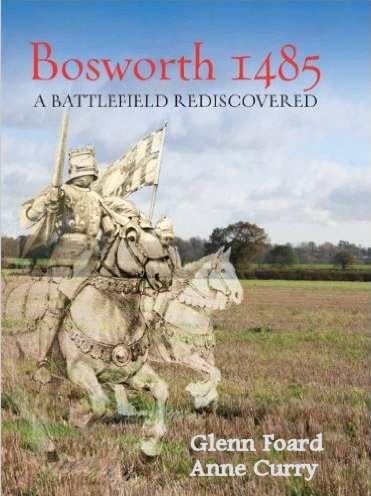

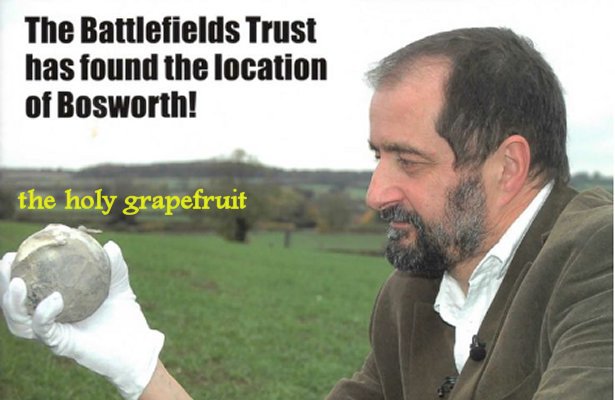

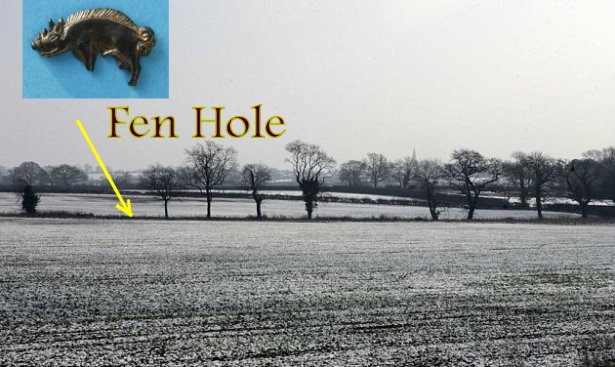
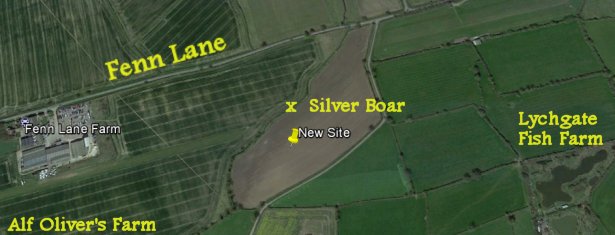
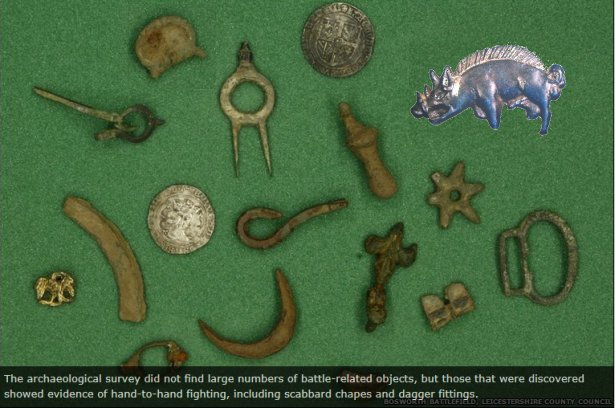

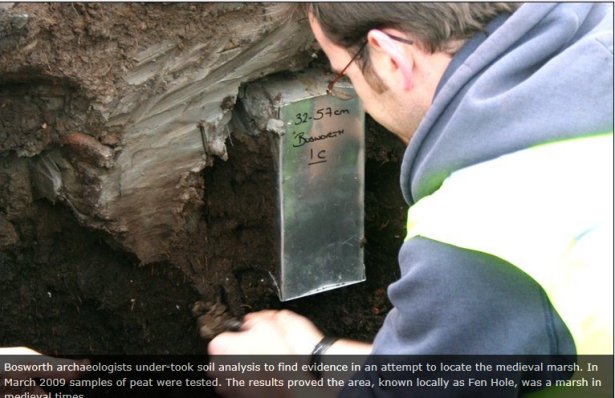
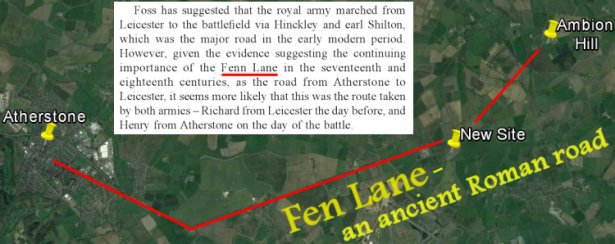
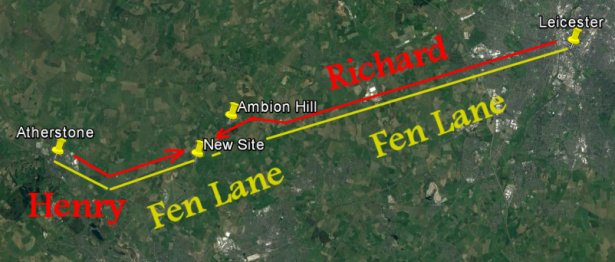
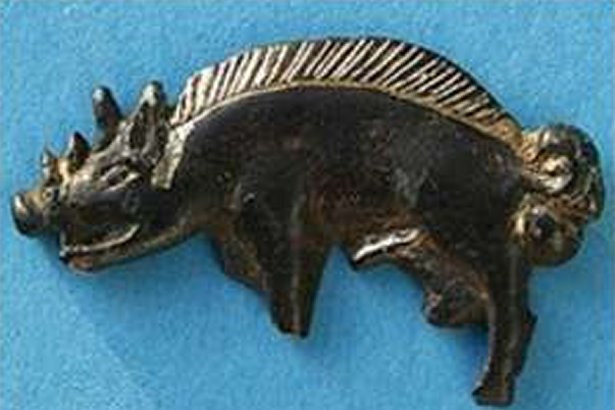
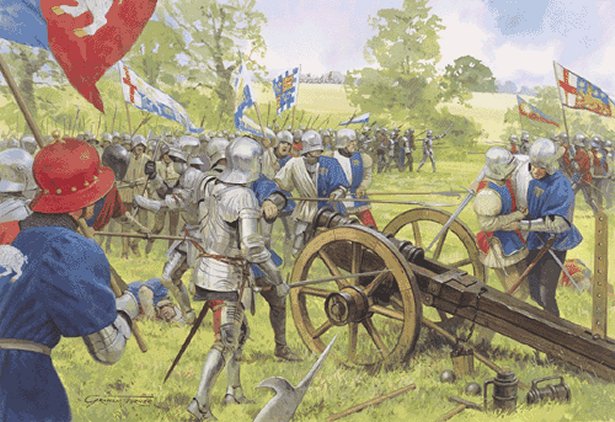 |
| |
|
|
The Story of
Crown Hill
in
Stoke
Golding
|
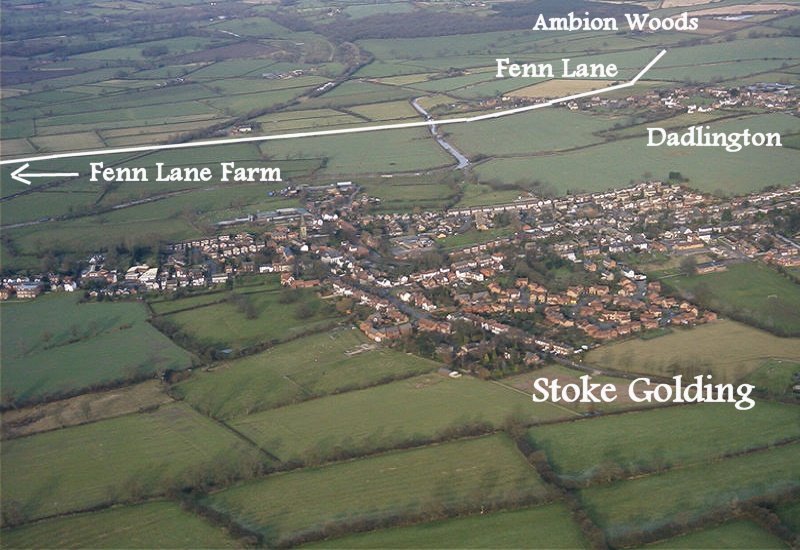 |
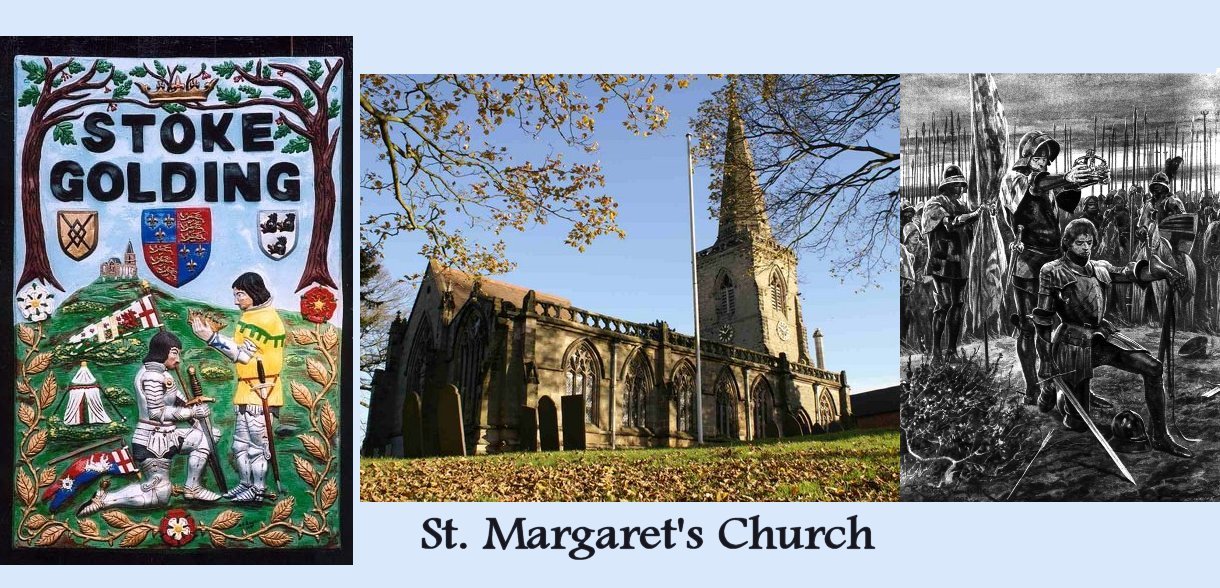 |
In the
Game of Thrones, there are winners and
losers. The same goes for the War
of the Roses.
By
marrying Elizabeth of York, Henry Tudor took the Red
Rose of Lancaster and the White Rose of York and
created the Tudor Rose, a powerful symbol that
portrayed the unification of the warring Houses into
one kingdom. Very clever.
As I
said earlier, the discovery of the correct battle
site will require a major rewrite of the history
books as more facts become clear. For example,
there is the tale of Richard's mighty army dashing
down Ambion Hill, a charge that should have struck
terror into Henry's army. What underdog army
is stupid enough to fight at the base of a hill?
Then
there is that very pretty myth where Thomas Lord
Stanley finally made it to the battlefield, saw
Richard’s battle crown on a bush, picked it up and
placed it on Henry’s head. Then the whole field
knelt to their new king with great reverence.
Very impressive.
The idea
of Henry being crowned by the dominant warlord
Stanley with cheering men and Richard's crumpled
body nearby does create a striking picture.
However, I have a suggestion: forget this image.
This is just one of the many
stories that will need to be rewritten.
The more
likely account suggests Henry was crowned
'King' on Crown Hill in Stoke Golding, a small
hamlet located a scant mile east of the Fenn Lane
battlefield.
So why is it called 'Crown Hill'?
Common sense suggests it was renamed 'Crown Hill'
because Henry was crowned there.
I searched long and hard for a picture of
Crown Hill. I am still looking. The only
picture I could find was taken from a canal boat
taken one
morning from nearby Ashby Canal. (Bosworth, Dadlington, and Stoke Golding are all connected by
30-mile Ashby Canal which is wide enough for small
riverboats to transit.)
This
riverboat picture of St. Margaret's Church suggests
that the town of Stoke Golding is elevated on a
sprawling rise that
I can only assume is 'Crown Hill'. I
was looking for a bump on the horizon, but Crown
Hill is probably more like an wide, flat, elevated
plateau.
If I am
wrong about this, forgive me. As they say, I
am doing the best I can to solve all mysteries
sitting at my computer in Houston, Texas.
In a
way, I can understand the problem that Polydore
Vergil faced when he was writing the history of the
Battle of Bosworth from some library in London.
It was Vergil who gave the Battle of Bosworth its
name because on a map, Market Bosworth was the
closest town to Ambion Hill.
Given
that Market Bosworth is two miles north of Ambion
Hill and Stoke Golding is two miles south of Ambion
Hill, one has to wonder if the Battle of Bosworth
will ever be renamed. Given that Stoke
Golding is one mile from Fenn Lane Farm and and
Bosworth is 3.5 miles, Stoke Golding would seem to
have a better claim to the name than Bosworth.
Plus
Stoke Golding has Crown Hill. What does Market
Bosworth have? Henry Tudor never put one foot
in Market Bosworth during the battle.
Stoke
Golding claims to be the "Birthplace of the Tudor
Dynasty". As we can see from the sign, Stoke
Golding has already started laying claim to
Revisionist History. Will future English
schoolchildren read about the Battle of Stoke
Golding? Or will it be the Battle of Crown
Hill? Has a major battle ever been renamed? One can only wonder.
Glenn
Foard now believes the story of Henry being crowned
in Stoke Golding is the correct one.
"Our
discovery suggests that the Crown Hill story is
probably right, that Henry VII placed the crown
on his head there after one of his soldiers
found it in a thorn bush. We will never know,
but it would have been the obvious place."
Traditionally Stoke Golding is known as the village
where King Henry VII was crowned after the Battle of
Bosworth. It has also recently been
established that the battle took place much closer
to the village than previously thought.
During
the battle, the villagers of Stoke Golding climbed
to the top of the tower of St. Margaret's Church to
watch the battle in the distance. One can
still see the grooves on the window sills where the
archers sharpened their arrows on the night before
the battle.
Henry
Tudor was victorious over Richard III at the Battle
of Bosworth, which took place in the former
marshland known as the Redemore
between Stoke Golding, Dadlington, Shenton and
Sutton Cheney.
After
the battle, Henry's entourage retired to hilly
ground near the village of Stoke Golding, no doubt
to celebrate.
As the
legend goes, Sir Reginald Bray, one of Henry Tudor's
knights, had found Richard's crown in a hawthorn
bush and brought it to the new king. Lord
Stanley then took it upon himself to create the
impromptu coronation using an old table and chair
from a local farmhouse.
Soon
after, this area became known as Crown Hill
and Crownhill Field.
Following its moment in history, Stoke Golding
returned to being a sleepy, farming village.
As the Industrial Revolution crept across England,
small industries grew up including the making of
socks, stockings and shoes. Goods were brought
to the village by the Ashby Canal or the railway
which connected the village to Nuneaton, Coalville
and the North.
Unfortunately, most of the industry has now gone,
although a small trading estate still remains
alongside three pubs, a Post Office, a general shop
and a small marina on the Ashby Canal.
One
would imagine the Stoke Golding chamber of commerce
is visualizing ways to capitalize on its proximity
to Fenn Lane Farm at this very moment. For
example, the village sign proudly shows the two
hawthorn bushes on Crown Hill where Richard III's
crown was said to have been found following his
death. Market Bosworth better watch out.
Incidentally, that boat ride along Ashby Canal looks
like a lot of fun!! That is where you
would find me.
If you
are interested in a visit, I suggest you read this
delightful blog written by a day visitor to the
area:
Saga Run to Battle
At the
end of the day, they stop at the George and
Dragon pub in Stoke Golding for a pint of
ale. You'll find me there too!
As one
gentleman put it, there
are few pubs called the White Boar, after Richard’s
emblem, but dozens of Blue Boars, the emblem of
Henry’s triumphant general, the Earl of Oxford.
Pub signs, like history,
are written by the victors.
|
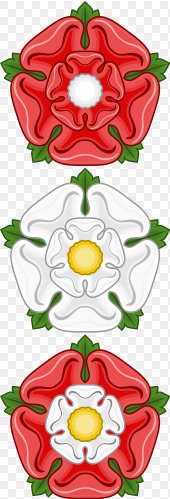

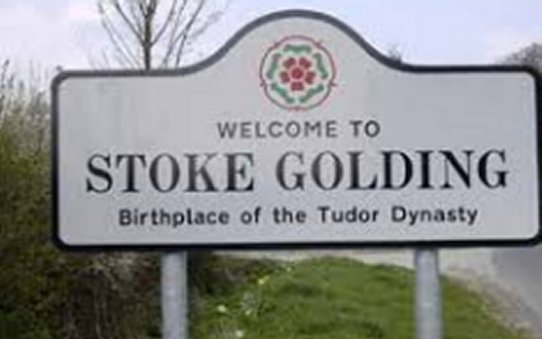

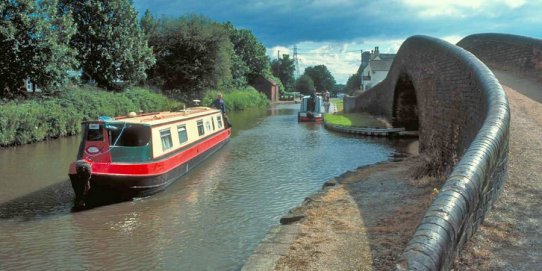
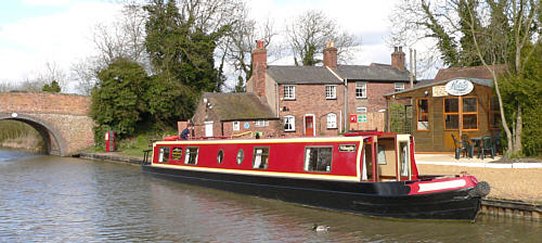 |
The Re-Interment
of Richard III
|
| |
|
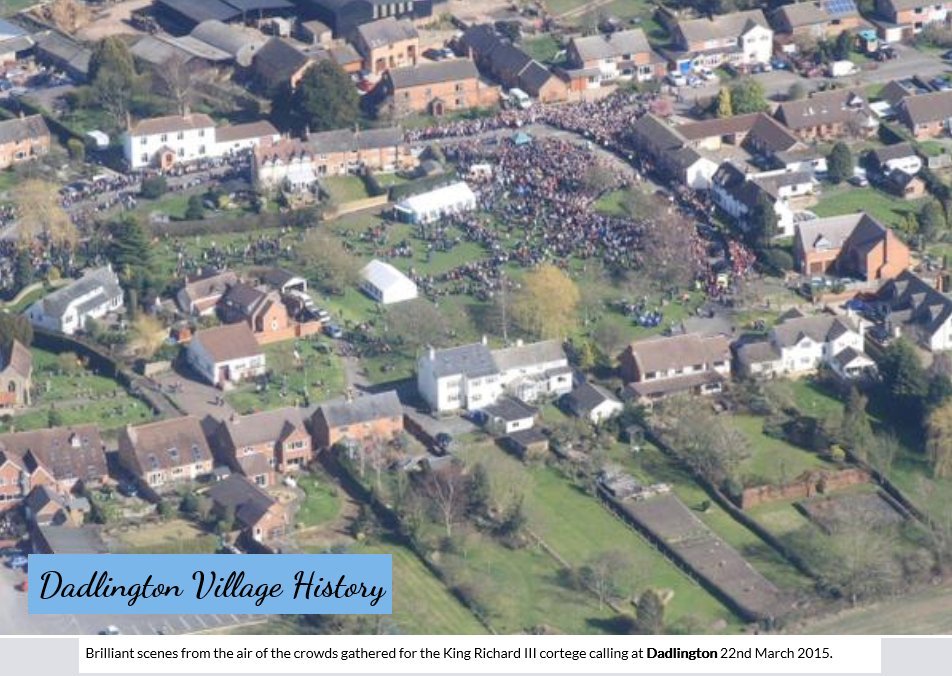 |
This
crowd is watching the funeral cortege of Richard III
as it passes through their town on March 26, 2015.
There is a chance the public's
perception of Richard may be changing.
A mock trial of Richard III, charged with the
murder of the Princes in the Tower, was held in a
full St James’ Church, Dadlington.
The jury (made up of the whole audience) found
the King innocent of all charges.
Unfortunately, I do not know if this report is true
or not.
The
story was
said to be reported in The
Guardian, but I was unable to
find it.
|
| |
|
On March
26, 2015, the remains of Richard III were reburied
in a formal ceremony that stretched from the
battlefield at Fenn Lane Farm to Dadlington and
Stoke Golding all the way back to Leicester.
Although
I wrote earlier about the 2012 discovery of
Richard's body in Leicester, I was unaware at the
time that there had been a 2015 service to rebury
the King's remains. Our story would not be
complete without some mention.
The
ceremony began at noon that day. A hearse
carrying Richard's remains embarked from Leicester
on a 30 mile roundtrip through the English
countryside. Along the way, the procession
made stops at Fenn Lane Farm, Dadlington,
Sutton-Cheney, the 'original battlefield' at
Ambion Hill, Market Bosworth, and four other towns
before returning to Leicester at 6 pm.
At that
point, there was a service held for Richard and then
his coffin was placed into its final resting place.
Philippa
Langley was the woman who spearheaded the campaign
to find the king. As we recall, Ms. Langley
was walking through an empty parking lot in
Leicester when she felt a chill and had a
premonition that she was standing on Richard’s
grave.
Ms. Langley as well as her comrade John Ashdown-Hill
were on hand to witness the ceremony in the church.
Speaking afterwards, Ms. Langley said:
"I
was thinking about all those years ago when I
put the Looking for Richard project
together and its ethos, its aim to give Richard
III what he didn't get when he died in the field
of battle. I was thinking 'Today
it is a job well done'. It really is a
privilege. We are
laying Richard to rest with full dignity and honour."
Historian Dr. John Ashdown-Hill said:
"It
was good to get the sort of reverence for
Richard that he didn't really get in 1485.
Philippa and I and the Looking for Richard
team had been saying all along this is what we
wanted for him."
As for
my personal feelings, I am far
too removed from the details to pass judgment on
Richard's alleged crimes, but I admit I feel a sense
of sympathy for him. Perhaps if I knew more I
would feel differently.
What I
am certain of is that it was shameful the
way Richard's body was mutilated.
Not only
was Richard's dead body struck many times while he
was on the ground, his naked body was thrown over a
horse and carried to Leicester. There his body
lay on a table for days with only a small cloth to
cover his private area while onlookers streamed
past. The worst indignity of all was throwing
his body into a grave without even a coffin.
One has
to assume Richard was hated like a monster for his
enemies to treat him so callously. The
picture tells the story.
I am very glad Richard
received a proper burial. I was touched by the
respect shown by the British people for the reburial
of their fallen King.
I will now share the
rest of this story in photographs.
|
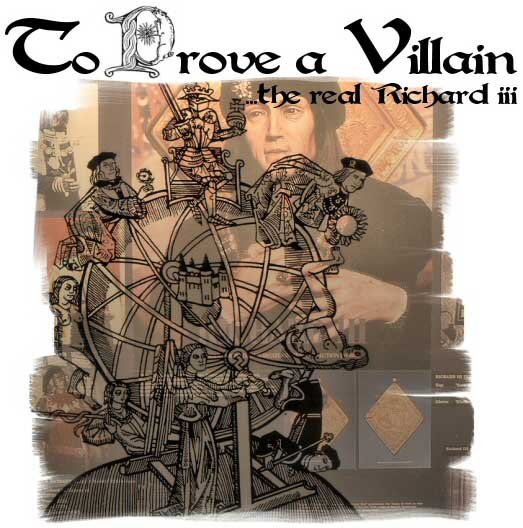
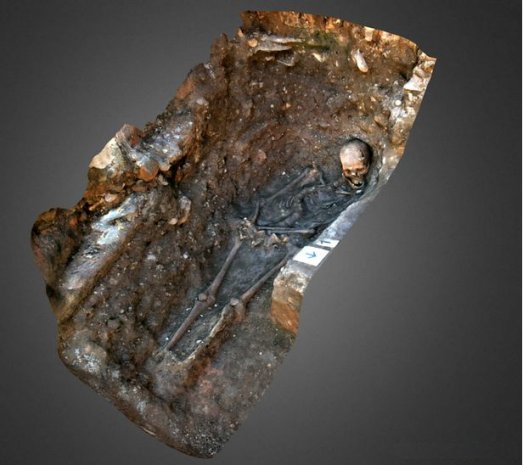 |
 |
 |
| |
|
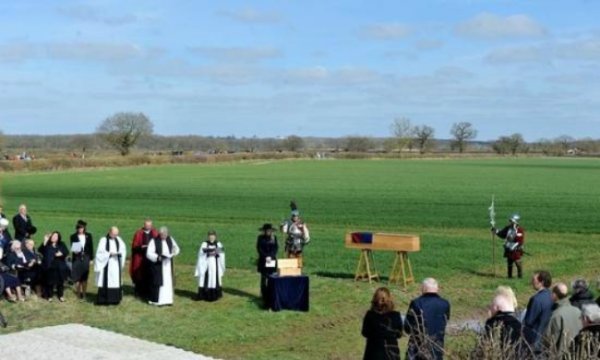 |
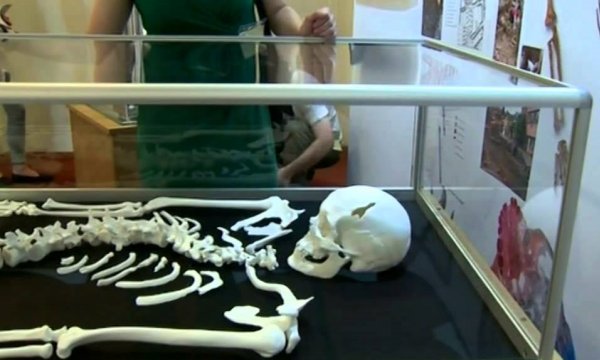 |
| |
|
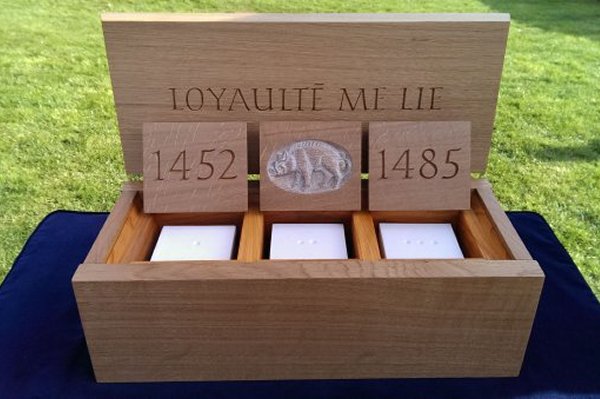 |
 |
| |
|
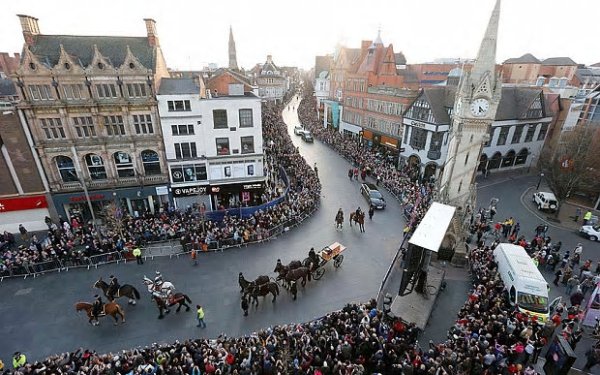 |
 |
 |
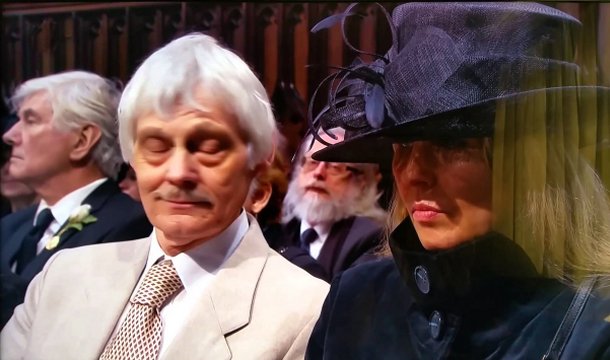 |
 |
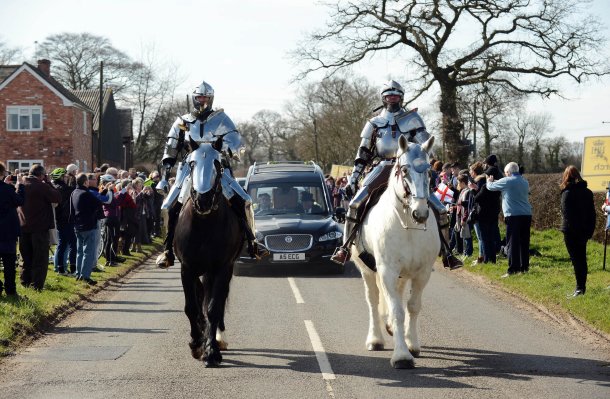 |
Elizabeth of York was the eldest daughter of Queen
Elizabeth Woodville. If her mother was the
White Queen, then by reason the younger Elizabeth
would be the White Princess (incidentally, there is
an April 2017 mini-series on the Starz cable channel
titled the White Princess).
As we
know, Elizabeth of York would marry Henry Tudor and
help found the Tudor dynasty. In fact, the
infamous Henry VIII was her son and the famous Queen
Elizabeth was her granddaughter.
We have
read biographies of one wicked person after another.
Therefore the description of Elizabeth of York as a
decent, talented woman stands in pleasant contrast
to all the darker personalities we have met.
Here is a brief excerpt from an article about
Elizabeth by Alison Weir.
(Note: Alison
Weir is Britain’s bestselling female historian,
and the author of 20 books. She has written
biographies of Mary, Queen of Scots, Elizabeth I
and Henry VIII’s six wives.)
Elizabeth of York
She may not have sought the limelight as much as
some of her contemporaries, but Elizabeth of
York, mother of Henry VIII, was a Tudor of rare
talent.
Elizabeth of York played an important role in
the Wars of the Roses and the early Tudor story.
Born in 1466, she was the eldest daughter of the
Yorkist king Edward IV, sister of the princes in
the Tower, and niece of Richard III, who had her
and her siblings declared bastards so that he
could claim the throne.
The probable murder of her brothers in the Tower
of London in 1483 meant that, in the eyes of
many, Elizabeth was the rightful queen of
England. Richard III himself contemplated
marrying her, but in 1485 Henry Tudor, who
claimed to be the heir to the House of Lancaster
and had sworn to marry Elizabeth, came from
France with an army and defeated Richard at the
battle of Bosworth. Thus was founded the Tudor
dynasty. The marriage of King Henry VII and
Elizabeth of York was hugely popular, for the
union of the white rose of York and the red rose
of Lancaster was seen as bringing peace after
years of dynastic war.
Elizabeth was intelligent and beautiful. A
Venetian report described her as “a very
handsome woman of great ability, and in conduct
very able,” beloved for her abundant “charity
and humanity”. The humanist scholar Erasmus
described her in one word: “brilliant”.
In 1613 Sir Francis Bacon asserted that
Elizabeth was “beautiful, gentle and fruitful”.
As time passed, her husband Henry Tudor clearly
grew to love, trust and respect Elizabeth, and
they seem to have become emotionally close.
There survives good evidence that she loved him,
and a moving account of how they comforted each
other when their eldest son, Arthur, died.
Elizabeth performed her queenly role to
perfection, understanding exactly what was
required of her, and conforming seemingly
effortlessly to the late medieval ideal of
queenship, which constrained her to a role that
was essentially decorous, symbolic and dynastic.
She was beautiful, devout, fertile and kind –
the traditional good queen.
Alison Weir
|
 |
There,
isn't that sweet? Finally, a positive opinion
about one of our star players.
So I
have a question. Would your opinion of fair
Elizabeth change in any way if I told you she
engaged in voluntary incest with her uncle Richard
III?
The
final episode of the White Queen
mini-series had a naked Elizabeth clearly enjoying a
consensual romantic tryst with Richard III.
Elizabeth Aida Feola reviewed
Episode 10 of the White Queen
series. Ms. Feola had this to say about
Elizabeth's dalliance with creepy Uncle Dick:
The show capitalizes on a budding romance
between Elizabeth of York and Richard III,
started before Richard's wife Anne has died.
Richard says that there is no actual love
between them but we quickly see that this is not
true, as Elizabeth tells Richard, “I’m in love
with you,” and they start kissing.
He loses his temper and throws her out of court
when Anne dies, because her presence has caused
rumors to circulate that the king has murdered
his wife to make way for his niece, which hurts
his honor.
|
 |
| |
|
The origin of this story is from the reign of
James I, based on a letter which is now long
gone, so we do not know exactly what was said
and how much of it was up to interpretation.
Because we don’t know what it said, we are left
to guess.
If the standard of evidence we require
becomes none that say it’s not true, we can make
any statement we wish and stir up doubt.
For example, I can say that when Richard III was
a baby, his father dropped him and that’s what
caused his spine to curve. It’s something
I made up, but since you can’t say beyond a
shadow of a doubt that it didn’t happen, it
quickly becomes accepted as truth.
In five years, students coming into college
courses will ask their professors about how
Richard was dropped as a baby. Enough years go
by, and it’s accepted as fact.
Let me be very clear here- this liaison is not
based on any evidence we actually have. This
relationship is supposed to be romantic, but
it’s disturbing. The papal dispensations which
were granted so that cousins can marry are
twisted to include uncles and nieces, as if this
could have been a viable option. It wasn’t.
Since the pope did not always grant
dispensations to cousins, and I can’t imagine
any pope supporting the marriage of two so
closely related.
This reaches its climax when Elizabeth of York
sneaks out of her mother’s house to Richard’s
tent, to have sex with him. She returns and her
mother smiles at her, as if she were pleased
that they were now lovers. I have only one
reaction to this: EW. It’s disgusting.
Oedipus has nothing on this story.
|
|
| |
|
For the
record, I am not a prude by any stretch of the
imagination. And yet I found myself feeling
unbearably squeamish as I watched this lovely young
woman screw her uncle's brains out. No
reticence, no mixed feelings, no guilt, no
second-thoughts.
As I
watched this beauty writhing in passion underneath
the arms of her uncle, it crossed my mind that this
man was accused of murdering the girl's two
brothers. It was this man who took her brother
Edward's rightful place on the throne. It was
this man who had declared her a bastard child and
had slandered the reputation of both her father and
her mother. Plus Richard was her uncle.
Based on her mother's famous fertility, Elizabeth
was risking getting pregnant with this incestuous
liaison. This was very dangerous game she was
playing.
So did
this tempestuous Mambo #5 really take place or did
someone make this up?
The vast
majority of the web sites that choose to comment all
cast strong doubt on the likelihood of this
relationship taking place. If you wish to have
a detailed explanation of the doubt, I recommend an
excellent
article written by Olga Hughes.
Here is
a direct quote from Ms. Hughes' article:
To gratify an incestuous passion… While we
have seen several entirely imaginary depictions
of romantic love between uncle and niece in
fiction recently, the one thing we can almost
positively rule out is sexual intercourse.
If you
prefer a more succinct explanation of doubt, our
friend historian John Ashdown-Hill listed this 'relationship'
as the third myth in his article '6
myths about Richard III'.
If I had
to place a bet, I would put my money on Myth #3
before Mambo #5.
|
 |
While it
is true that good, decent folks are hard to find
anywhere in the vicinity of the events in the White
Queen, I would like to say I was deeply offended by
the sex scene between Richard and Elizabeth.
If it had been Burton and Taylor, fine, I can accept
adultery, but incest is a much more serious matter.
This scene crossed so many social taboos I don't
even know where to begin.
Elizabeth Aida Feola made this comment:
If the standard of evidence we require
becomes none that say it’s not true,
we can
make any statement we wish and stir up doubt.
For example, I can say that when Richard III was
a baby, his father dropped him and that’s what
caused his spine to curve. It’s something
I made up, but since you can’t say beyond a
shadow of a doubt that it didn’t happen, it
quickly becomes accepted as truth.
In five
years, students coming into college courses will
ask their professors about how Richard was
dropped as a baby. Enough years go by, and it’s
accepted as fact.
I happen to completely agree with Ms. Feola's
comment. In fact, I was so impressed with it
that I made up a fib in her honor.
Earlier
when I wrote about the scoliosis of Richard III, I
added this statement:
It turns out that Richard had adolescent onset
scoliosis, a curvature of the spine. In
other words, the deformity wasn’t present at
birth, but developed after the age of ten.
This lends strong support to the story that
George,
Richard's older brother, pushed him down a
flight of steps during a fight between the two
boys. The resulting injury likely
triggered the onset.
There is no
story about George and Richard having a fight. I
made it up. Nor is there any story about how
Richard was dropped as a baby. Elizabeth Feola
made it up. But both scenarios are not only
quite believable, I imagine someone will read my
statement and actually buy it... and quite possibly
as years go by, it will be accepted as fact.
I can
just see it now. Some high school kid writing
about Richard III for his term paper will quote
me...
"Richard
Archer, in his ground-breaking Internet article
'Brexity and Brevity', stated that when
Richard III was 10, he was pushed down a flight
of stairs by George, his older brother. Mr.
Archer goes on to state that this injury caused
the onset of adolescent scoliosis.
As we know, it was this scoliosis that caused
Shakespeare to humiliate Richard for the ages
with his so-called hunchback..."
So here is my question: Did you catch it back
when I fibbed? Did you raise an eyebrow?
I hate to criticize my wonderful readers, but I
seriously doubt anyone thought twice about it.
I know for a fact I would not have caught a
throwaway comment like that. It is very
plausible that George was a bully. It is also
very plausible that someone dropped Richard as a
baby. Heck, one time I dropped my own daughter
on her head when she a baby! (She made it to
graduate school, so I guess she's okay, but
still...)
I personally believe that
many of the people who watched the sex scene
between Elizabeth and her uncle left the show
believing that incident really took place.
That offends me because I don't think it
happened and I don't think those kind of lies
have any business being portrayed as historical
fact.
Please read the following Internet exchange.
It details a conversation where one person is just
as confused about the Elizabeth-Richard relationship
as I was.

As one
can guess, this is an exchange between a person who
is taking the time to actually check out allegations
that trouble her with a more knowledgeable friend.
How many people do that? Right now the
majority of the human race is overwhelmed with so
many Internet choices that we have all become numb.
Fact-finding is a huge chore. For one thing,
who are we supposed to believe? It took me two
hours... TWO HOURS... to read up on the story of
incest between Richard and Elizabeth. I am
retired, so I have that kind of time. But the
majority of people do not have that kind of free
time (or the inclination) to check things out.
It is
one thing to make a goofy statement that Richard got
dropped on his head as a boy, but it is another
thing entirely to write a TV scene where millions up
TV viewers watch the future Queen of England commit
incest with her villainous uncle.
This
upsets me because there are a lot of people out
there who do not question a damn thing they read or
see on TV.
Enough
years go by, and it’s accepted as fact...
When
writing about history, why can't people do their
best to tell the truth?
I
believe making stuff up can cause irreparable
damage. You don't believe me?
William
Hutton (1723-1815)
famous book "The Battle of Bosworth"
was published in 1788. Although
this book was widely criticized at the time, over
time Hutton’s work became the account upon which
most theories were based.
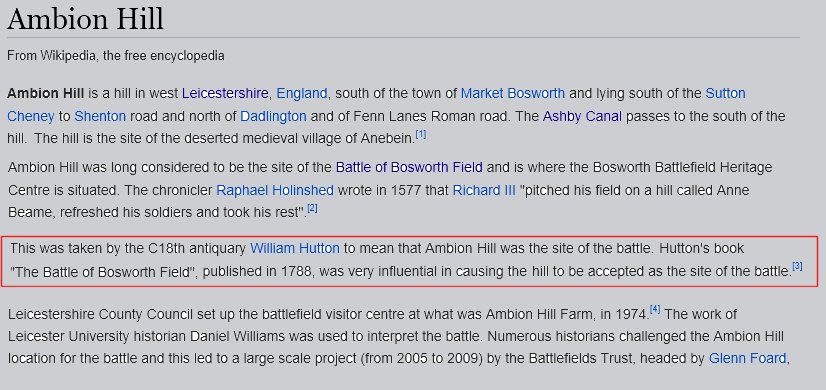
Enough
years go by, and it’s accepted as fact...
"except that it involved... Elizabeth of York,
who as the Queen of Henry VII was an important
figure in English history."
We
can make any statement we wish and stir up
doubt.
Did
you know that Donald Trump believed his
celebrity status gave him the right to touch
the private area of any woman he found
desirable without asking permission?
Did you know the rumors about Barack Obama
being a secret Muslim are true?
Did you know that Barack Obama was born in
Zimbabwe, not Kenya as previously thought?
Did you know that Hilary Clinton worked her
way through law school as a call girl?
Did you know that Bill Clinton secretly
executed dozens of witnesses to his many
affairs?
Did you know that Benjamin Franklin
participated in French sex orgies?
Did you know that Abraham Lincoln had sex
with a freed slave in the Oval Office?
Did you know that Abraham Lincoln was
secretly a vampire hunter?
Did you know that Thomas Jefferson fathered
several children with a slave girl?
Did you know that Franklin Delano Roosevelt
and Winston Churchill had a homosexual
relationship?
Did you know that Eleanor Roosevelt was a
lesbian?
Did you know that George Washington owned a
plantation full of slaves?
Did you know that Frank Sinatra and John
Kennedy had a three-way with Marilyn Monroe?
Did you know that at least one of these
statements is actually true?
For the record, I take
no pleasure in repeating these rumors. I have
never met any of these people, so what gives me the
right to say these things? After all, I don't
have the slightest idea as to the validity of these
rumors. But why should I feel guilty?
People pass ugly rumors like these on all the time
and never think twice.
We
can make any statement we wish and stir up
doubt.
As it stands, some people who write historical
fiction think they can say anything they want with
impunity. I say that is wrong.
Although
I believe that
historical fiction has a duty to be factually
accurate, there are many who disagree with me.
The Internet is filled with authors (who shall go
nameless) who claim that historical novelists have
the right to use "poetic license".
To some
extent, I agree, especially where dialogue is
concerned. For example, I created dialogue at
certain points in my article as an effective way to
make a point. In particular, I found this to
be a useful technique when writing about the
absurdity of Owen Tudor, the servant who bedded a
Queen.
But
there has to be limits. Just because it is 'legal'
doesn't make it right or ethical. I am good
with 'speculation'. However, I am not
good when people assert things to be true... such as
the incest between important historical figures.
By the
way, 'Did you know
that Franklin Delano Roosevelt and Winston Churchill
had a homosexual relationship?'...
I made that rumor up just now. I could just as
easily discussed the time that Richard Nixon
molested his nubile teenage daughter Julie in her
White House bedroom. I made that one up as
well.
What is
stopping me from writing historical fiction about
Winston Churchill (a man I admire, incidentally) and
using 'poetic license'?
Winston Churchill came aboard the American heavy
cruiser USS Augusta where Roosevelt and his
staff were waiting. On first meeting, Churchill
and Roosevelt were silent for a moment until
Churchill said 'At long last, Mr. President', to
which Roosevelt replied 'Glad to have you
aboard, Mr. Churchill'.
The two men hit it off immediately. With
so much to discuss, they retreated to
wood-paneled library where they could speak in
secrecy. Talking late into the night, a
rapport developed that involved two men burdened
with saving the Western civilization from a
monster.
Perhaps it was the bourbon, perhaps it was the
pressure, but at this point Roosevelt placed his
hand over Churchill's. 'It is getting late,
Prime Minister, let us retire to bed.'
'Where do you wish for me to sleep, Mr.
President?'
'Will my bed be acceptable, Winston? That
way we can continue our conversation much
further into the night...'
'Yes, Franklin, I concur. We have so much
to talk about...'
Before some school kid quotes me on that paragraph,
let me reassure everyone that I have no knowledge
that any such event ever took place. But let
me also add it was really easy to write that
paragraph. Isn't 'poetic license' fun?
I
contend that my imaginary story about Churchill and
FDR is NO DIFFERENT than the story about incest
between Richard and Elizabeth.
The only
thing stopping me from writing historical fiction
lies is integrity and discretion. Without
those qualities, in the hands of an unethical hack,
'Poetic license' becomes an excuse to slander
an otherwise remarkable historical figures!
An
intelligent writer should be able to have their cake
and eat it too. Lawyers have a term... 'admissibility'.
This term deals with the rules regarding admission
of evidence. The same should hold for
historical fiction.
Take,
for example, this issue regarding incest between
Elizabeth and her uncle. There is little proof
that it took place. Nevertheless, someone took
it upon themselves to portray on screen that this
forbidden hookup took place. I can attest the
shock and disgust has yet to wear off in my brain.
Now I am intelligent enough out to check it out and
so are you... but there are many people who
swallowed the scene hook, line, and sinker.
Whatever
happened to taste? A more delicate way to
introduce this idea would be to have a debate.
Let two characters close to the situation argue and
speculate as to what might be going on between
Elizabeth and Richard. This way they can raise
the 'possibility' without necessarily
condemning. I think writers and portrayers of
historical fiction have an obligation to inform
their readers in some way or another when they
decide to stretch things a little too far. Try
using some 'discretion'.
There
are some who say that 'gossip' is the most
powerful force on earth after gravity and the atom.
Others say a lie makes it halfway around the world
before truth can put it pants on. I could tell
half the people on earth that they are too gullible
and they would believe me. It all needs to
stop. There is too much false information in
the world to begin with for unethical writers to
spread even more.
In
particular, as for Elizabeth of York, unless the
writer and director had undeniable proof, whoever
decided to slander the Queen of England should be
ashamed of themselves.
I have a
suggestion. From now on, anyone convicted of
spreading false historical fiction shall have their
names slandered upon their passing. That way,
if there turns out to be an afterlife, they can see
what it feels like having their own reputation
smeared.
Poetic
justice for poetic license.
|
What's
Next for the Bosworth Battlefield?
|
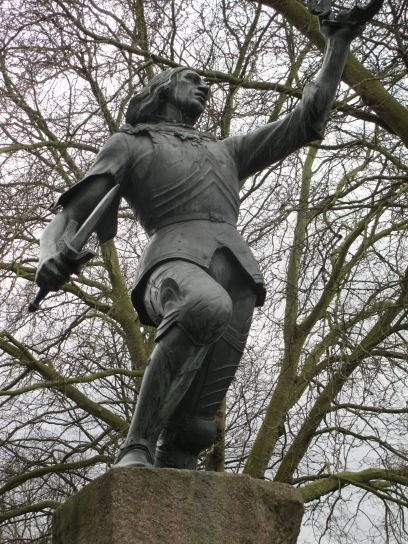 |
Well,
thank goodness there are some people with inquiring
minds. Thanks to the efforts of those who
challenged the brainwashed thinking of the men who
placed the battle site at Ambion Hill, they finally
got it right. I imagine the
success of Dr. Foard in locating the correct
battlefield at Fenn
Lane Farm had a direct effect on Philippa Langley's decision to pursue her 'Looking
for Richard' project. The dual
discoveries of the correct battlefield and the
correct burial site make for one of the most
remarkable stories I have ever come across. So
now the question
is: What happens next??
England is
behind the times in showing proper
acknowledgment to its historic battlefields.
American
battlefields are carefully preserved and
properly displayed, yet
England's
great battlefields are hardly covered at all.
Routine old cottages have statutory
protection, where the places
were the nation’s history was decided
are
good spots
for new highways.
Britain
is covered with such sites, yet they are largely
ignored. Although there
is a
promised government bill on this issue,
it has not
materialized. There are
only two other battle centres in England
comparable to Bosworth: Hastings (1066) and
Shrewsbury (1403).
I found
a curious anecdote regarding Leicestershire Council anxieties
during the search.
One
theory was that the battle might have been
fought much farther away,
even as far as Warwickshire. Mr.
White, councilor in charge of building the
centre, was particularly relieved.
“My leader said: ‘Whitey,
if it turns out to be in
Warwickshire, you’re sacked.’”
Now after four years of
considerable uncertainty, with the discovery of
Fenn Lane, they have resigned themselves to a
rewrite of interpretative signboards and
modification of their exhibits. Otherwise, they
are putting a brave face on the situation. “You
wouldn’t want a centre slap-bang in the middle
of a battlefield,” said curator Richard Knox.
“It would ruin the archaeology and the ambience
of it.”
|
| |
|
Before we continue, a long time ago I asked you to
find Waldo and memorize a word. Do you
remember what that word was?
|
| |
|
As Dr.
Glenn Foard kept edging further and further to the
west, one can imagine the fear preying
on the minds of the people who depend on the
Bosworth Battlefield for a living. There was
an air of resignation in these people. Back in
2009, it was a foregone conclusion that Ambion Hill
was not the real battlefield. Now the question
was just how far away the correct battlefield would
be.
It was
clear that Dr. Foard was going to find this
battlefield eventually. But every time Foard
moved one farm further to the west, the increasing
distance began to grate on the nerves of the
Bosworth Battlefield dependents.
|
|
|
|
|
|
 |
Finally
Dr. Foard struck pay dirt at Fenn Lane Farm.
Talk about lucky!
It
wasn't exactly 'close' to Ambion Hill, but at least
it was within viewing distance. The Leicester County Council
had dodged a
huge bullet.
The news could have been
so
much worse.
There
seem to be plans to keep the Visitor Center where it is and
let people stroll to the new location of the battle.
In the long run, the
weird publicity
might even prove
good for business.
The
Leicestershire County Council
is negotiating with landowners to gain full public
access to the area.
In fact,
the Bosworth Battlefield Heritage Centre told
the BBC that the new site is "within
walking distance" of the Bosworth
Visitor Center.
'Walking
distance'?
Were these people serious?
Did they really believe 'Walk' was the
solution to their problem?
|
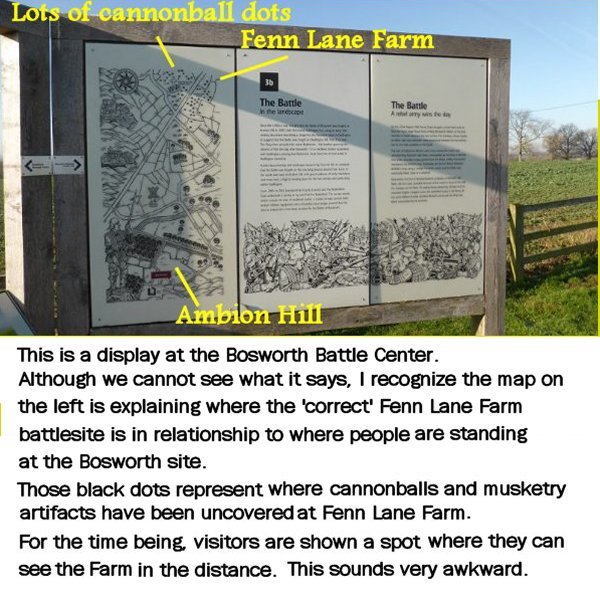 |
|
|
|
|
|
|
I loved
this quote:
Officials are planning to rewrite the
interpretative signboards and modify part of the
exhibition. Otherwise, they are putting a brave
face on the situation.
“You wouldn’t want a
centre slap-bang in the middle of a
battlefield,” said curator Richard Knox. “It
would ruin the archaeology and the ambience of
it.”
Mr. Know was referring to 'interpretive
signboards' such as this one. This is a
photograph taken of a sign that is part of the
Bosworth Battlefield walkway. As one can see,
people are encouraged to walk for one hour around a
one and a half mile trail to look at signs tell the
story of the battle.
Mr. Knox
is surely in a bad spot. Can you
imagine how utterly embarrassing it is to represent
a battlefield that doesn't exist?? Once
upon a time they wanted to be the next Stonehenge.
Now they just want to stay relevant. Never before has such a weird
challenge presented itself.
In a
way, I feel for the Bosworth people such as Mr. Knox. They have
created all these wonderful explanation signs, but
now they are faced with the fact that much of it is
wrong.
For
example, there are pictures of Richard
charging down the hill. That is nonsense.
We now know the battle was fought on a plain.
There are pictures of Richard dying in a marsh at
the foot of the hill. Complete fiction.
There was no hill.
Their elaborate 1.5 mile
Walking Trail
is obsolete. It must seem very unfair, but
harsh reality dictates that the History of the
battle
will have to be re-written. However, that's
the easy part.
The hard part is that the Walking Trail
will need to move to the new site.
|
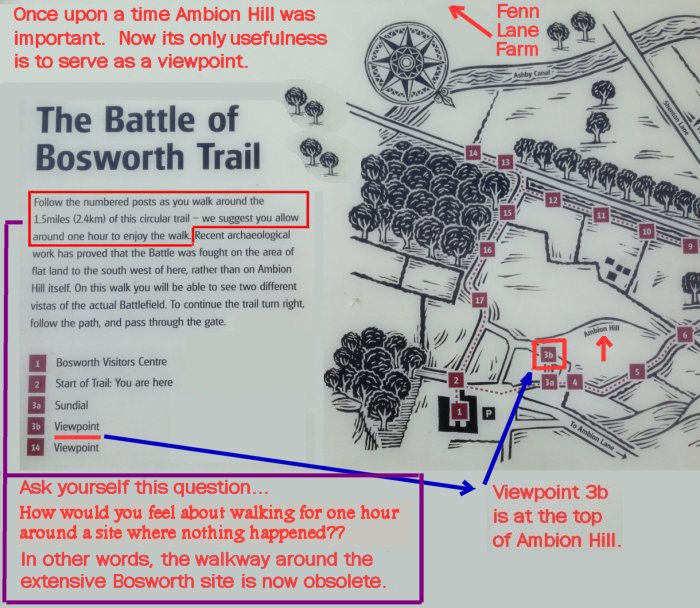 |
If the Walking Trail moves to
the new site, now we are looking at three
walks... one walk to get from the old site
to the new site, a long walk around the new
site, and then another walk back to the old
site. That sounds like a lot of
walking.
Now Mr. Knox is correct about one thing...
no one wants the Visitor Center in the
middle of the battle field.
However, there is a concept known as 'Reasonable
Distance'.
Based on my experience, 'Reasonable
Distance' is about 100 yards for
American tourists who believe the length of
a football field is God's idea of a healthy
walk. Their absolute upper limit is
300 yards. Anything further than that
is out of the question.
So what makes me an authority?? Throughout my
article, I have freely admitted I know little about
English history. However, if there is one
thing I am an authority on, that is walking.
My wife and I walk all the time on our
cruise trips. I love history and I
have found the most fun way to learn history
is to travel and visit other countries.
Unfortunately, not much is learned from a
bus. My wife Marla and I have learned
it is much better to Walk.
That way we can take pictures, study maps,
ask questions, and read whatever literature
is available.
Our cruise trip to England and the British
Isles will be our 40th cruise trip. After 40
cruise trips, I have learned that the average
vacationer does not like to walk. In fact, the
less they walk, the happier they are.
|
 |
|
|
|
|
You
might be curious what this picture represents.
That is
a picture of Cozumel, Mexico, the most successful tourist
trap in the Western hemisphere. The entire
scheme is absolutely brilliant. Every day 6 to 8 cruise ships dock at 3 different piers.
20,000-40,000 passengers have no choice but to enter
a maze-like village of shops and bars. Yes,
there is an exit, but the only way to find it is to
ask for help. I have found that is when no one
seems to remember how to speak comprehensible
English.
Most
people don't bother asking for help. They
wander around aimlessly assuming they will find the
exit sooner or later. For some reason, they
can't seem to find a way out of the village.
Pretty
soon they get hot, thirsty and hungry. They
are getting really tired of looking for the way out.
They have wasted over an hour and now time is
running out. So they give up and buy a bunch
of tee-shirts just to prove they visited Mexico.
Then they hit the nearest bar and get smashed on
margaritas and chips.
Drunk
out of their minds, these people can still get back
to their ship because their ship is bigger than most
football stadiums. A convenient horn blast
tells the bartenders when to shove people out of the
bar. Fortunately, the tourists don't have far
to go.
The
village is
less than 300 yards from each cruise ship. And you
know what? Every trip I take to Cozumel,
someone has the nerve to complain the walk was way too
far.
300
yards is the absolute limit. I kid you not.
|
 |
| |
|
 |
The
Distance from Ambion Hill to Fenn Lane Farm
So I imagine you are beginning to wonder
what the walking distance might be from
Ambion Hill to Fenn Lane Farm.
Funny you should ask.
Through the magic of Google Earth, I
measured the distance.
Let's see how far it is.
|
 |
|
|
|
|
The
answer is four miles.
If the
Bosworth Battlefield Heritage Centre
thinks the general public is willing to walk a
four-mile round trip, they are out of their minds.
This is
much too far for the elderly and this is much too
far for children. Even for young adults and
middle-aged people, four miles is still much too far
if they have their family with them.
For that
matter, what about time constraints? An
athletic pace gets this done in 45 minutes.
Normal people closer to an hour. Round trip
becomes 90 minutes to two hours. Budget
another hour to walk around the new Fenn Lane Farm
Walking Trail.
How many
vacationers have the luxury of investing two to
three hours in a round trip hike from the incorrect
battlefield to the correct battlefield, then back
again?? My guess is they would whisper
the unthinkable... 'Why not put the museum and
the parking lot where it belongs at Fenn Lane Farm??'
Obviously the English are made of hardier stuff than
your average Caribbean cruiser, but I daresay at the
minimum they
will back off from this walking strategy soon enough.
I
predict the future Battle of Bosworth experience
will come complete with shuttles or even a mini-train.
Make it a Disney ride and let people have some fun
out of it. How about a roller coaster.
Or a two-mile zip line?
Or better yet, maybe they will ferry people back and
forth on the Ashby Canal. The cruise people
would like that.
|
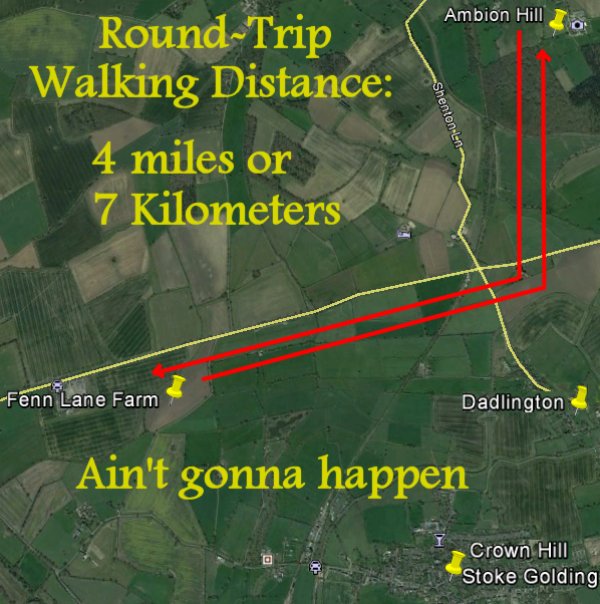 |
The Reputation of Richard III
|
| |
|
On the Negative
Side...
Rick
Archer's Note: I don't know much about
English politics, but I gather that The
Guardian likes to be controversial.
This magazine/newspaper had some pretty mean things
to say about the Royalty... and Richard as well.
Britain mourns a
Monster
– Because he was a King.
Richard III’s burial was absurd!
Polly Toynbee
The Guardian
|
 |
Surely it’s time
to make King Richard pay his dues. We’re often told
the royals are good for the country because they
raise our international profile and encourage
tourism – so we should be wringing every penny out
of Richard III. We’re
missing a trick here. Several tricks in fact.
For starters, we’re not even burying him during
tourist season. After 500
years, surely he can wait another month or two.
Or
better yet, why rebury him
just once?
Why not make it a regular event, like the changing
of the guard? If it is true
the Royals improve tourism, then let's put Richard
to good use. Dig
Richard up at the start of each month,
hide the
individual bones at random beauty spots around the
countryside, and turn it into a
giant treasure hunt for
tourists. Follow the
clues on an accompanying app; see if you can locate
his skull. Congratulations! It
was hidden in a bin behind Oblivion at Alton Towers.
Now track down his elbow. Then his pelvis.
First to find six
bones receives 20% off their B&B bill and a
family-size jar of Marmite.
Pinch yourself
hard, very hard. This must be anti-royalist
satire? No, we’re
wide awake as the nation mourns its most reviled
monster of a king. Depicted
as a deformed hunchback, murderer of his own
nephews, and a sinister, evil usurper,
little has transpired over the past 500 years to
make anyone change their mind. Never was adulation of monarchy
taken to such transcendently absurd heights.
It’s comical, but
tragic too, as a reminder of the indignity the
British accept in their accustomed role as subjects,
not citizens. Here are church, royalty and army
revering a child-killing, wife-slaughtering tyrant
who would be on trial if he weren’t 500 years dead.
This is the madness of monarchy, where these bones
are honoured for their divine royalty, whether by
accident of birth or by brutal seizure of the crown.
Richard, whose death ended the tribal Wars of the
Roses, is a good symbol of the “bloodline” fantasy.
Who knows how many of our kings
were even born legitimate? Our island story is one of royal usurpage and
regicide, with imported French, Dutch and German
monarchs who didn’t speak a word
of English.
The puzzle is
that this fantasy of anointed genes persists
today.
|
|
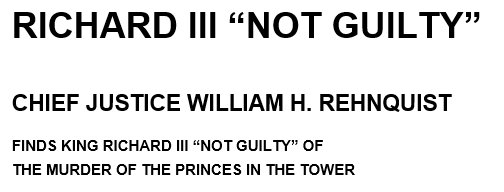 |
Rick
Archer's Note: William Rehnquist was
once Chief Justice of the United States Supreme
Court. They probably could not have found a
more prestigious man to preside over the mock trial
of Richard the Third. (link)A
three-judge panel chaired by William Rehnquist
found King Richard III not guilty of the murder of
his nephews, the famous “Princes in the Tower.”
“The
Trial of Richard III” took place before an
overflow crowd as part of the Rehnquist’s four-day visit to the Indiana
University School of Law in Bloomington. The
trial featured appellate-style briefs and arguments
by students and graduates of the Law School.
The date was October 26, 1996.
|
Richard III
was represented by John Walda, also a graduate of
the Law School, a partner in the Fort Wayne,
Indiana, law firm of Barrett & McNagny, and
President of the Indiana University Board of
Trustees.
The defense sought to cast
doubt on the prosecution’s evidence and to show that
others, such as Henry VII who killed Richard III on
Bosworth field, had a better motive and opportunity
to commit the crime.
In addition, Walda
noted that the case took place in the eyes of “500
years of pretrial publicity”.
“Relying
on William Shakespeare’s plays as to any element
of the state’s case is a little like relying on
Oliver Stone’s movie to prove the Kennedy
assassination. At least Stone was alive to
witness the events!”
(John Walda)
|
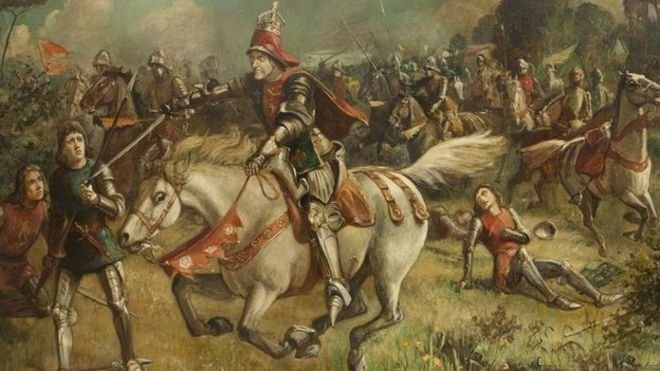 |
| |
|
Delivering his opinion at the conclusion of the mock
trial, Chief Justice William Rehnquist found that
there was too much “ambiguity as to when the murders
took place” to convict Richard III. “There is a
sufficient lapse of time even considering the
evidence most favorable to the State as to put it
beyond the time when Richard III was in control of
things and into the time when Henry VII was in
control of things,” the Chief Justice said.
The
Chief Justice also found that the “contemporary
accounts,” which tend to incriminate Richard III,
“are not worth much in a trial of this sort . . .
because they are not made with first hand knowledge;
they are kind of rumor on rumor . . . .”
|
| |
|
The three judge panel ruled Richard III not
guilty in a split decision. Joining Judge
Rehnquist in the not guilty verdict was moot
court judge, law school professor, Susan
Hoffman Williams.
The third judge, Indiana state Chief Justice
Randall Shepard, dissented with a guilty
verdict.
Shepard found that “as a matter of
historical judgment,” many of the
contemporary writers had “access to actual
participants in the drama of the time.”
Chief Justice Shepard also noted that “the
defense has had 500 years to find evidence,
actual evidence, as opposed to speculation,
that somebody other than Richard III was
responsible for these deaths and by and
large there isn’t any.”
As a result, Chief Justice Shepard said,
“This leads me to
the conclusion that Richard the Third is
guilty of murder.
Guilty, guilty,
guilty.”
|
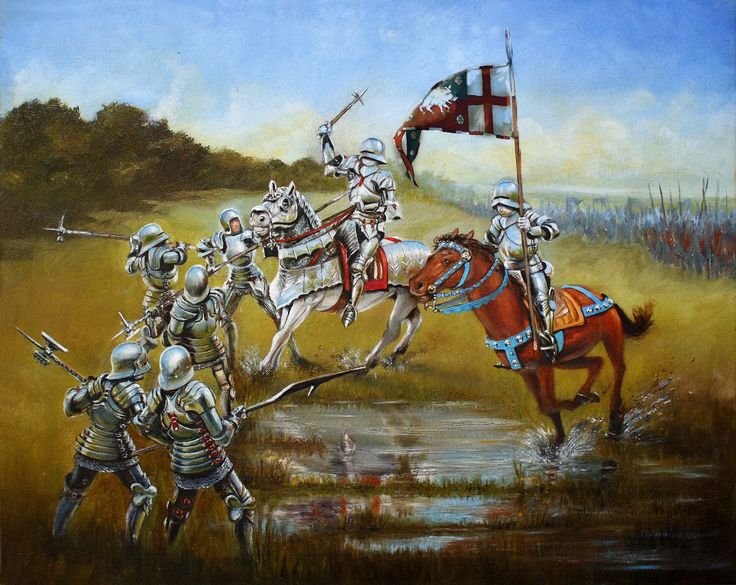 |
|
|
On the Open-Minded
Side...
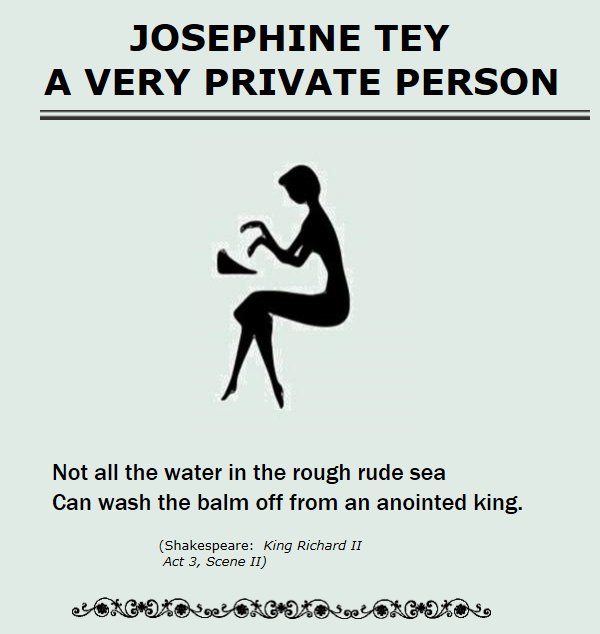 |
Rick
Archer's Note: Josephine Tey was the
pseudonym used by Elizabeth MacKintosh (1896–1952),
a Scottish author best known for her mystery novels.
Ms.
Tey's hero is Scotland Yard Inspector
Alan Grant, a sharp sleuth in the tradition of
Sherlock Holmes. Grant had his finest hour in
The Daughter of Time, written in 1951.
The
story begins with Grant laid up in hospital with an
injured spine. Bored out of his mind, Grant
becomes intrigued with the mystery of the
disappearance of the princes in the tower,
supposedly murdered by their wicked Uncle, King
Richard III. Curious about the monstrous crouchback of Tudor myth
and Shakespearean literature, Grant
decides to solve the mystery.
Not once
does he leave his bed. Instead, Grant has his
friends bring him reference books and contemporary
documents so that he can puzzle out the clues.
Working deliberately, he
determines whether King Richard III of England
murdered his nephews, the Princes in the Tower.
Grant comes to the firm conclusion that King Richard
was totally innocent of the death of the Princes.
The
fight against injustice was a prominent theme in
Josephine Tey's works. Here in modern times,
there is a sentiment that perhaps Richard got a bad
rap. What we do not know is where that
sentiment came from. Give Josephine Tey the
credit.
When Ms.
Tey's book came out, it flew straight in the face of
powerful public sentiment against Richard. All
by herself, Ms. Tey was able to reverse five
centuries of unanimous public censure.
After
her book appeared, not everyone agreed with her...
but they thought about it! The
greatest testimony to the brilliance of this work is
that for the very first time many eyes were now open
to the possibility that Richard might actually be
innocent.
In 1990, Daughter of Time
was selected by the British Crime Writers'
Association as the greatest mystery novel of all
time. It stands at #4 by the Mystery Writers
of America.
It was a
remarkable novel because it made an entire country
re-examine its previous attitude.
It is
said that the publication of this mind-bending book led to the
formation of The Richard III Society. Thanks
in large part to The Daughter of Time,
much scholarly debate has been done since in an
effort to present a more balanced account of Richard, the last Plantaganet king.
I would
like to add that without this book, questions about
the battlefield location and Richard's burial site
would probably never have been asked.
|
Rick
Archer's Note:
We have
come to the end of our saga. What a long
strange trip it has been.
At the
outset, I promised Brevity, but I failed miserably.
Oh well, let's face it, I got hooked.
According to that map, there were 15 major battles
fought during the 32 year Wars of the Roses
(1455-1487). Of those 15 battles, I wrote an
account of 8. Looking on the bright side, I could have written
about all 15 of the Battles. So I guess I did
show some restraint.
During
my research, I found a soul mate. Her name is
Jo Walton. Ms. Walton is an award-winning science
fiction writer who is also Josephine Tey's biggest
fan.
Here is
what Ms. Walton said about The Daughter of
Time:
This is a book about research. It’s the story
of chasing Richard through secondary sources and
primary sources and putting together the clues to
discover who really killed the Princes in the Tower.
Grant doesn’t get out of bed; a subordinate, a
friend, the nurses and a research assistant bring
him books and information.
He starts from a portrait of Richard and works
outwards from there. It’s either a very faithful
example of how writers do research or I learned how
to do research from reading this (I genuinely
wouldn’t care to guess which.)
The book isn’t perfect. There’s far too much of Grant’s
uncanny ability to read character from faces - which
one could argue makes it fantasy. There’s also far
too much of the Velikovskyan style of argument that
goes “The facts are A. Somebody did B. How could
anybody possibly do B when faced with A? We must
therefore have the facts wrong.”
I find no difficulty imagining people who do B.
Maybe I just have a wider imagination, or maybe I
get out more.
I have not independently investigated the argument
that Richard didn’t kill the Princes in the Tower.
It’s not my period of history. I’ve heard people
argue that Tey is cheating and leaving things out. I
honestly couldn’t say.
I find Tey’s Richard and Shakespeare’s Richard to be
interesting fictional characters, and the same goes
for John M. Ford’s Richard, who did kill the princes
in the tower but only because they were vampires…
and I think the relationship of all three of these
constructs to the bones they dug up in Leicester is
symbolic rather than actual.
But you cannot help thinking about it when you read
The Daughter of Time because
the real subject of this book is how a lot of
received history is sheer bunk.
At the very least, it causes the reader to
interrogate history instead of accepting it!
|
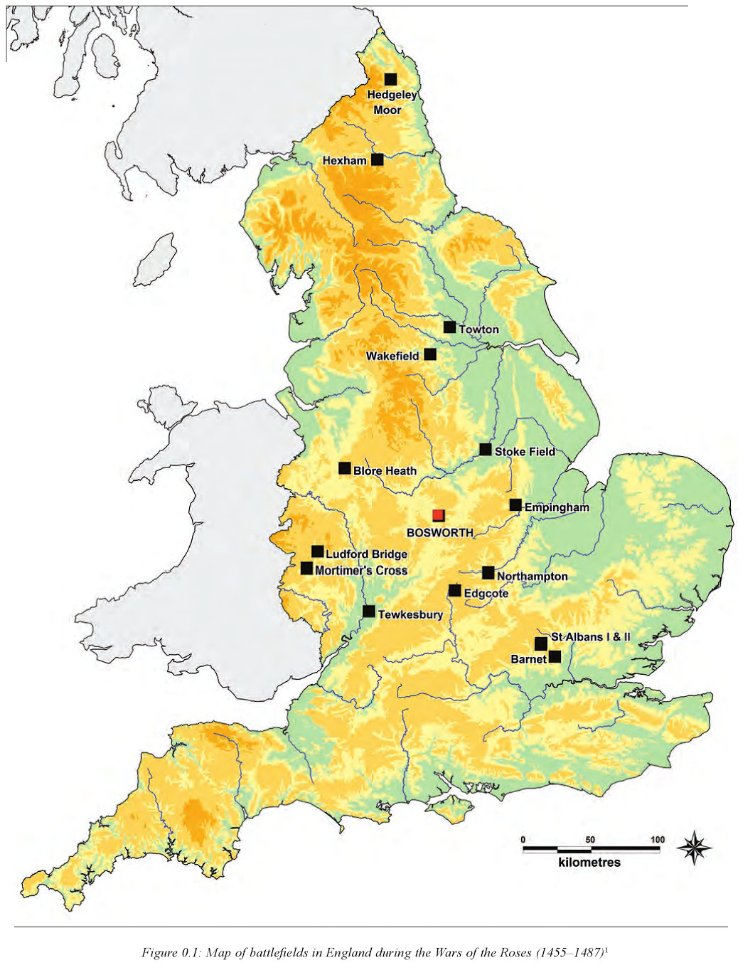
|
|
|
|
"At the very least, it causes the reader to
interrogate history instead of accepting it..."
(Jo Walton)
|
|
|
|
Sometimes other people say things that I wish I had said.
Jo Walton's comment is at the top of my list.
Elizabeth Aida Feola's comment is up there too:
"We
can make any statement we wish and stir up
doubt. In five years, students coming into
college courses will ask their professors about
how Richard was dropped as a baby. Enough years
go by, and it’s accepted as fact."
| |
|
John
Walda, the man who represented Richard III in the
mock trial presided over by Judge Rehnquist, also
made a comment that I wish I had said.
Mr. Walda noted that the
mock trial took place in the eyes of
“500 years of pretrial publicity”.
“Relying on William Shakespeare’s
plays as to any element of the state’s case is a
little like relying on Oliver Stone’s movie to prove
the Kennedy assassination. At least Oliver
Stone was alive to witness the events!”
For my younger readers, Mr. Walda is
referring to JFK, one of the
most controversial movies of all time.
John F. Kennedy's assassination remains
the great unsolved American mystery.
The anger came because Oliver Stone did a
masterful job of selling a rather
implausible
explanation. Mr. Stone was taken to
task for twisting the facts.
I do not know what was the truth, but I will
admit to feeling goosebumps while I watched
the conclusion.
|
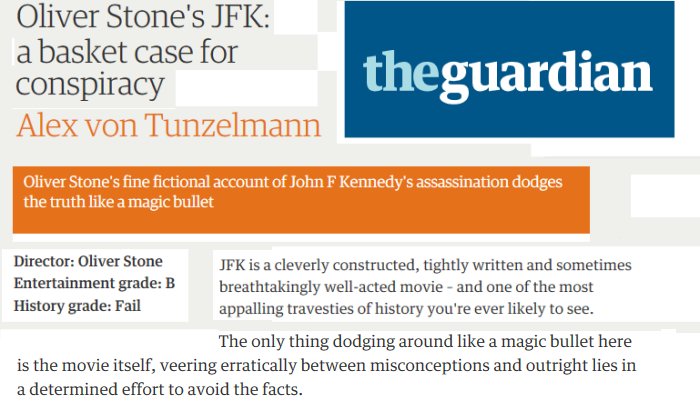 |
| |
|
At the
time of its release, the JFK movie
opened up a bitter fight, probably just as heated as
the argument over Josephine Tey's Daughter of
Time when it was released back in 1951.
If we stop and think about it, the controversy
surrounding the murder of John Kennedy is similar in
many ways to the controversy surrounding the murder
of the Princes in the Tower.
People
accused Oliver Stone of manipulating the facts,
which is why lawyer John Walda compared the
JFK movie to Shakespeare's Richard III
in the first place. Both works of art
were accused of spreading false information and
distorting the truth.
I am
ready to say the same thing about White Queen.
I resent this series for distorting the truth.
Recently
I took Marla, my wife, out to dinner. She
smiled and asked me to tell me a little bit about
what I had writing lately.
I
replied that I had been writing about the War
of the Roses.
Marla:
"You mean that TV show we watched last year with
that awful woman the Red Queen?"
I
grinned. "Yeah, that's it, Margaret Beaufort."
As a bit
of background, Marla could not stand the Margaret
Beaufort character. During the ten-week
series, Margaret was convinced it was God's Will for
her son Henry to become king. Strident, whining,
holier-than-thou, anytime Margaret wanted something,
she would fall to her knees and pray, then beg God
to show her a sign. Instantly the sun would
come out from behind a cloud and Margaret would go
nuts. She would throw herself to the ground
and begin crying with ecstasy. "Oh, thank you,
God, thank you! Thank you for answering my
prayers!"
Marla
absolutely could not stand the woman. She
hissed every time Margaret appeared. Nor did I
blame her. Amanda Hale's performance as the
Red Queen was wildly over the top.
That
said, I have a secret to share (psst... don't
tell Marla!). Personally, I enjoyed
watching Amanda Hale. What an amazing actress!
I didn't like her character in the White Queen
series, but I appreciated the job Ms. Hale did.
|
|
|
|
Marla: "Wasn't Margaret Beaufort the one who
murdered the Princes in the Tower?"
Rick: "Yes, but after the research I have done,
it seems unlikely that Margaret was behind the
disappearance of the two boys."
Marla: "You're kidding? I remember
Margaret's husband strongly suggesting those two
boys be eliminated. If so, her own son
Henry would have two less people in front of him
in line for the crown."
Rick: "I know, that's what the show led us to
believe. I was just as surprised as you
were when I learned differently. But some
priest had the two boys declared illegitimate.
That's how Richard was able to made king without
much of a fuss. If the boys were
illegitimate for Richard, then they would be
illegitimate for Henry as well. The TV
show got it all wrong. Margaret did not
murder those boys."
Marla: "I watched that entire show convinced
that pious Margaret was not only a murderer, but
the biggest hypocrite to ever walk the planet.
Why would the White Queen lie
about the facts so boldly?"
Rick: "There are reviewers who claim the
White Queen is methadone for
Game of Thrones junkies.
It doesn't
actually get you high, but it keeps you
watching the tube while you're
waiting for the new season.
Making up whoppers is good for ratings.
My guess is the TV writers don't believe
White Queen is sensational enough.
They decided it
would improve the script to make Margaret the
murderer. That way they could let
Elizabeth, the White Queen, create an epic storm
to retaliate against Margaret by ruining Henry's
rebellion. Why let the truth get in the
way of a good story? Hollywood has been
doing this for a long time, but Shakespeare did
it first."
Marla: "Why not just tell the truth? The
story was compelling enough without having to
resort to fiction."
Rick: "I could not agree more. I do
not think it is ethical to destroy Margaret
Beaufort's reputation just make the TV show more
compelling, but that small point doesn't seem to
stop people."
|
 |
And now
it is time for Rick's Soapbox.
There
are a dozen different news sources on TV that slant
each story in the direction they believe their
target audience wishes to receive the news.
Flip the channel and you will receive a totally
different interpretation of each news story.
But why bother flipping the channel? If
a person sticks to one news source, they can spend
the rest of their lives being fed a biased,
one-sided reality that will never deviate from their
preferred political mindset.
If there
is one thing I learned in researching the story of
Richard III, it is that people lie. There are
some people... media, script writers, bloggers,
historical fiction writers, you name it... who lie
or twist the facts all the time if they think it
will be to their benefit.
Personally, I have no idea whether Richard III was
innocent or not. But I do know he was the
victim of the worst smear campaign in history.
I have no whether Elizabeth slept with her uncle or
not. But I can't help feeling like she was
unnecessarily smeared.
I
contend that just because we have the power to pass
on dubious rumors does not make it right. Is
Reality really that boring? Personally, I
think the War of the Roses is the craziest story I
have ever come across and yet people feel the need
to embellish it with incest. Why don't we stop
writing historical fiction and try writing
historical truth instead?
As my
final word, today
we are
immersed in times dominated by
Fake News
and Alternative Facts. Facebook has become
riddled with falsehoods. People can say
anything they want on Twitter with complete
impunity... and people will believe it because they
want to. The same goes for the Internet.
|
|
|
|
The
effortlessly-transmitted disease of gullibility is
pandemic. The only cure known to man is a
built-in bullshit detector. Buy one on Amazon.
However, if you can't afford one, try developing a
home-made version instead. It is called 'skepticism'.
If
you read or hear something that doesn't feel
right, be sure to check it out first before
passing it on. Nothing irritates me more
than people who preach their own reality without
bothering to question the source or the sense of
it.
In the words of Jo Walton... do not
simply accept what you read or hear, interrogate it!
Question
everything. Otherwise one day you will
discover you have been wandering around with
blinders on.
As for
me, the next thing I am going to do is order a copy
of The Daughter of Time for my Kindle.
I absolutely cannot wait!!
Thank
you for reading,
Rick Archer
February 2017
|
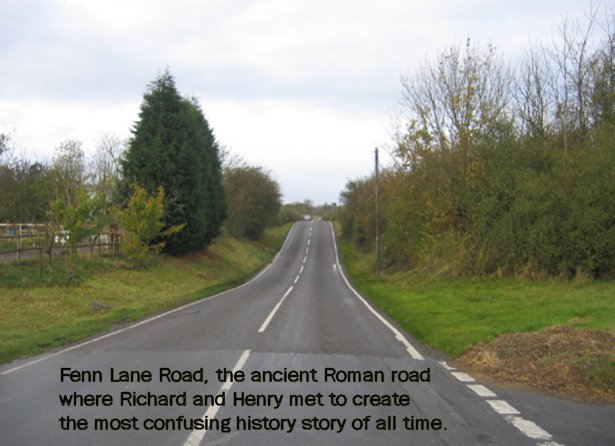 |
|
|

















